Shin Chuan Computer SC600PDT-BWG Portable Data Terminal User Manual SC600 SC620 FCC comment rev070410
Shin Chuan Computer Co., Ltd. Portable Data Terminal SC600 SC620 FCC comment rev070410
Contents
- 1. User manual 1 rev2
- 2. User manual 2 rev2
- 3. Revised manual 1 of 2
- 4. Revised manual 2 of 2
Revised manual 2 of 2
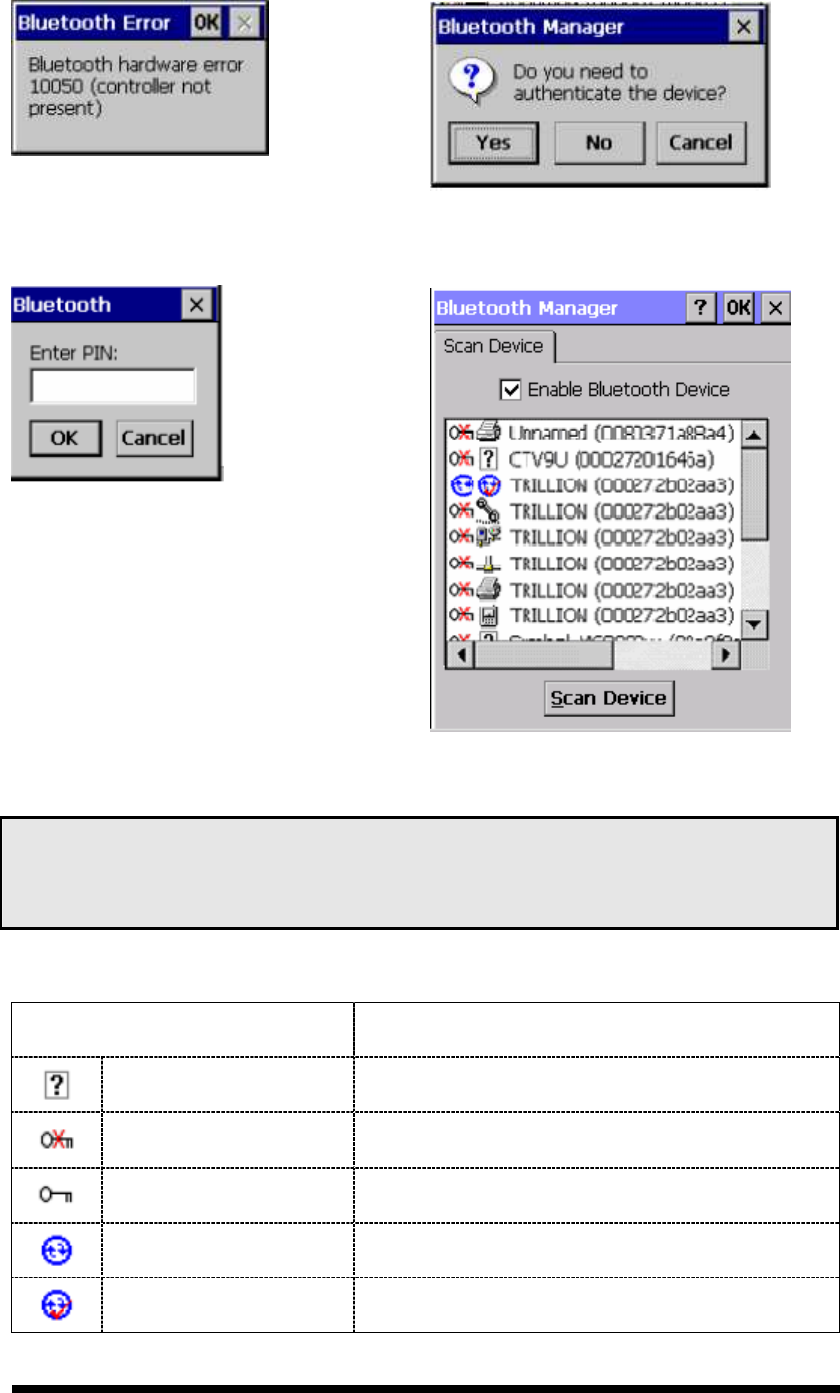
3-25
Figure 3-27 Bluetooth Error Windows Figure 3-28 Bluetooth Manager Windows
Figure 3-29 Bluetooth Enter PIN Windows Figure 3-30 Bluetooth Manager Windows
Note:
If the device to which the mobile computer is bonding does not appear in the list,
ensure it is turned on, in discoverable mode, and within range (30 feet / 10 meters) of the
mobile computer.
Table 3-21 Bluetooth Icon
Icon Description
Unknown device icon Device is not defined
Locked icon Device is locked and cannot be bonded to.
Not locked icon Device is not locked and can be bonded to.
Bluetooth device icon Bluetooth device
Bonded device icon Bonded Bluetooth device
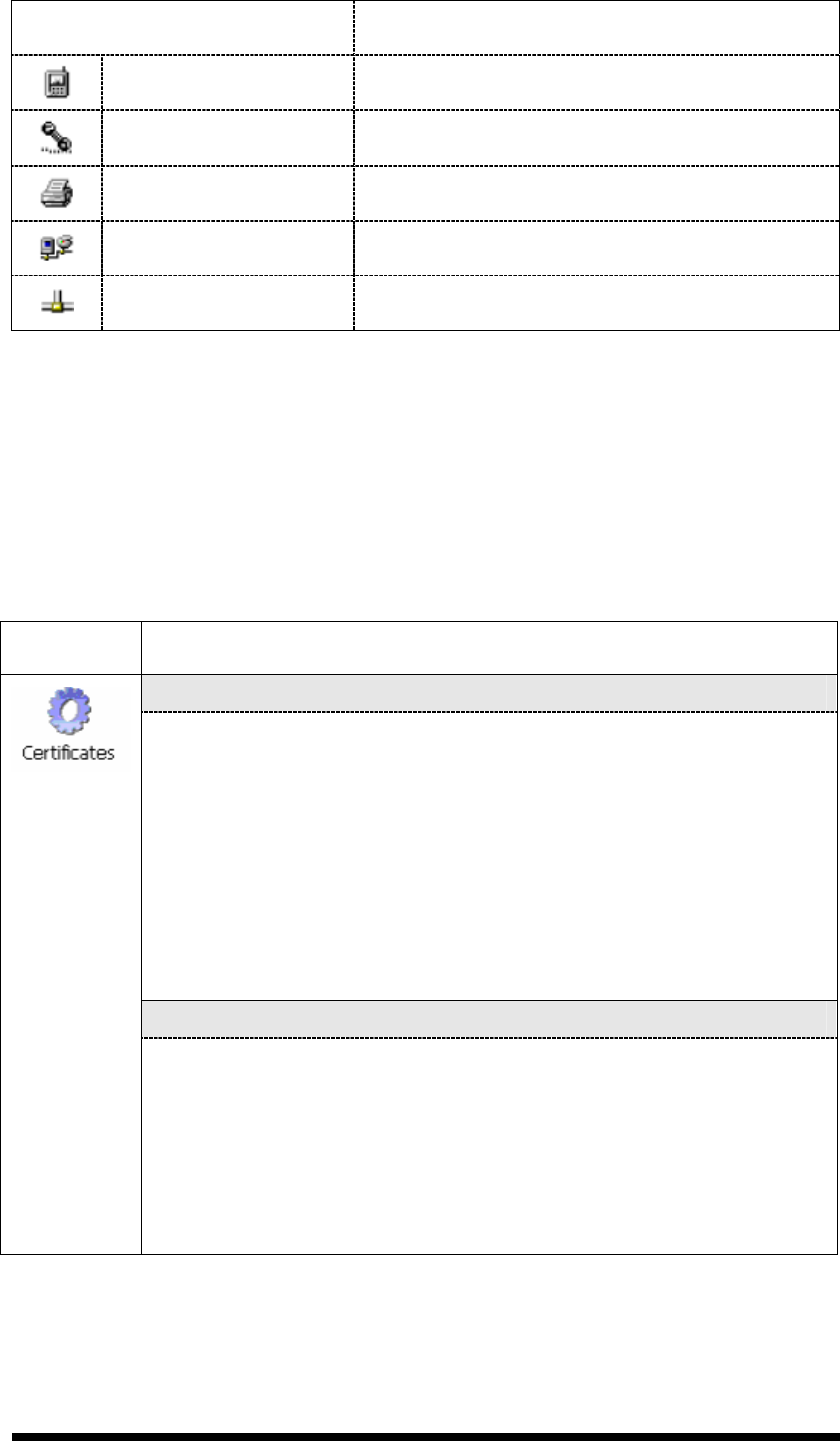
3-26
Icon Description
Mobile device icon Device is a mobile device
Phone icon Device is a phone.
Printer icon Device is a printer
Network icon Device is a network.
Linked icon Device is linked.
3.2.4 Certificates
Certificates are used by some applications for establishing trust and for secure
communications.
Certificates are signed and issued by certificate authorities and are valid for a
prescribed period of time. Windows CE manages multiple certificate stores.
Table 3-22 Certificates
ICON
ITEM & FUNCTION
“Store” Tab ( Figure 3-31) :
In the Stores tab, select the certificate store you wish to view or
modify from the drop-down list (Figure 3-32).
The “Trusted Authorities “store lists the top-level certificates
for authorities you trust.( Figure 3-33 , Figure 3-34)
The “My Certificates “store contains your personal certificates,
which you use to identify yourself.
Intermediate certificate authorities that help establish a chain of
trust are stored in the “Other Authorities” store.
“Store” Tab :
To add a certificate or associated private key to the selected
store, select “Import” (Figure 3-35).
To view more details of the selected certificate, such as the
expanded name or expiration date, choose “View”.
To delete the selected certificate from the store, choose
“Remove”.
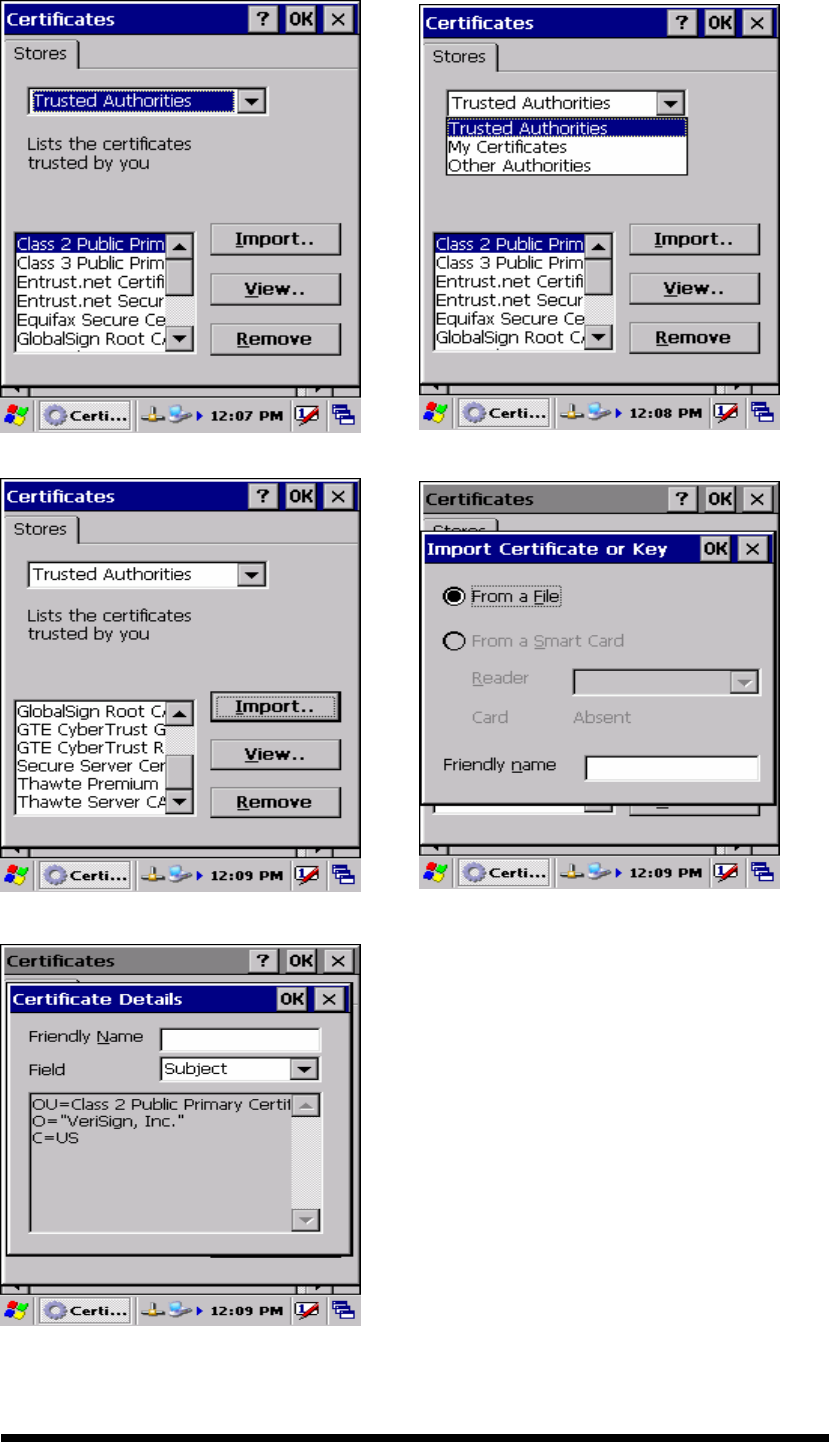
3-27
Figure 3-31 Certificates Figure 3-32 Certificates
Figure 3-33 Certificates
Figure 3-34 Certificates
Figure 3-35 Certificates
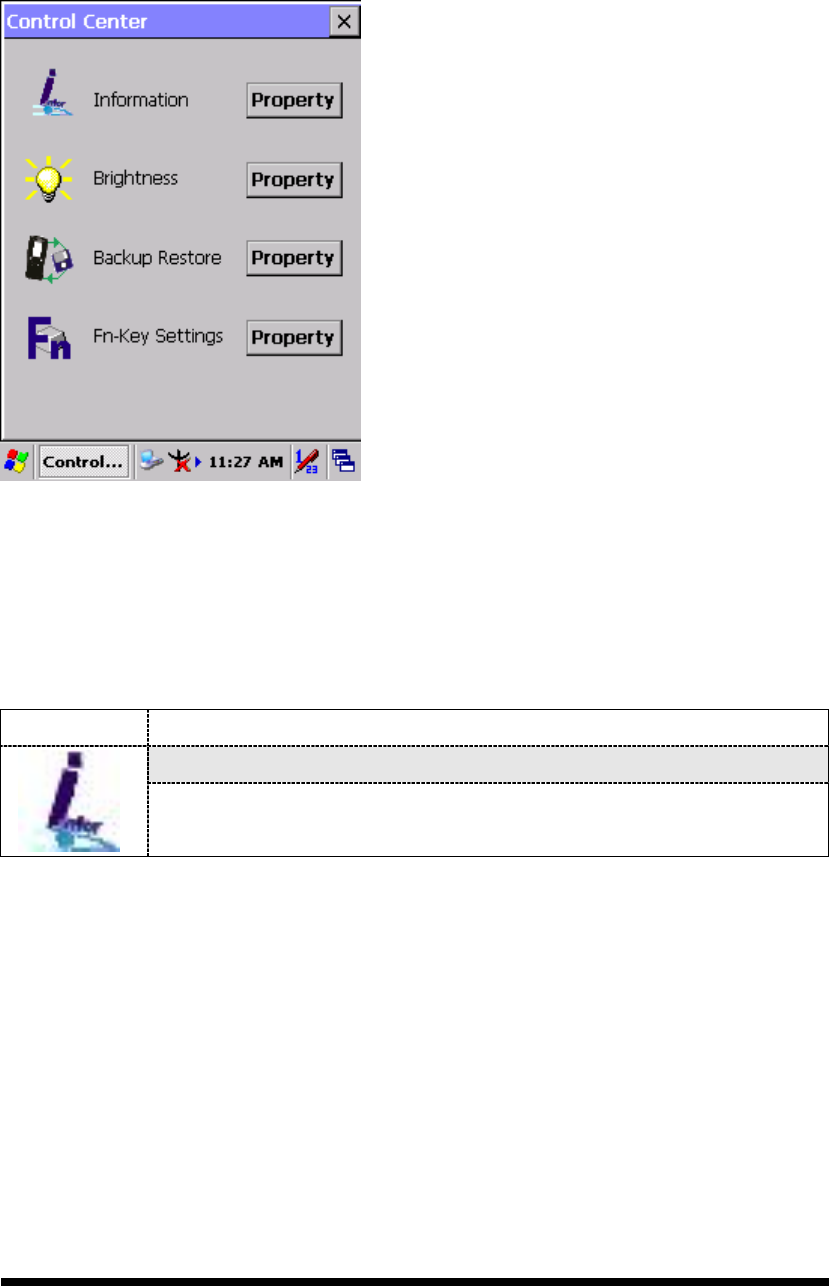
3-28
3.2.5 Control Center
The Control Center includes four AP, listed the following ......
Figure 3-36 Control Center
3.2.5.1 Information
Table 3-23 Information
ICON ITEM & FUNCTION
“Information” Tab :
Provide Software version, MAC address, Bluetooth ID, Serial
No. and Configuration No.
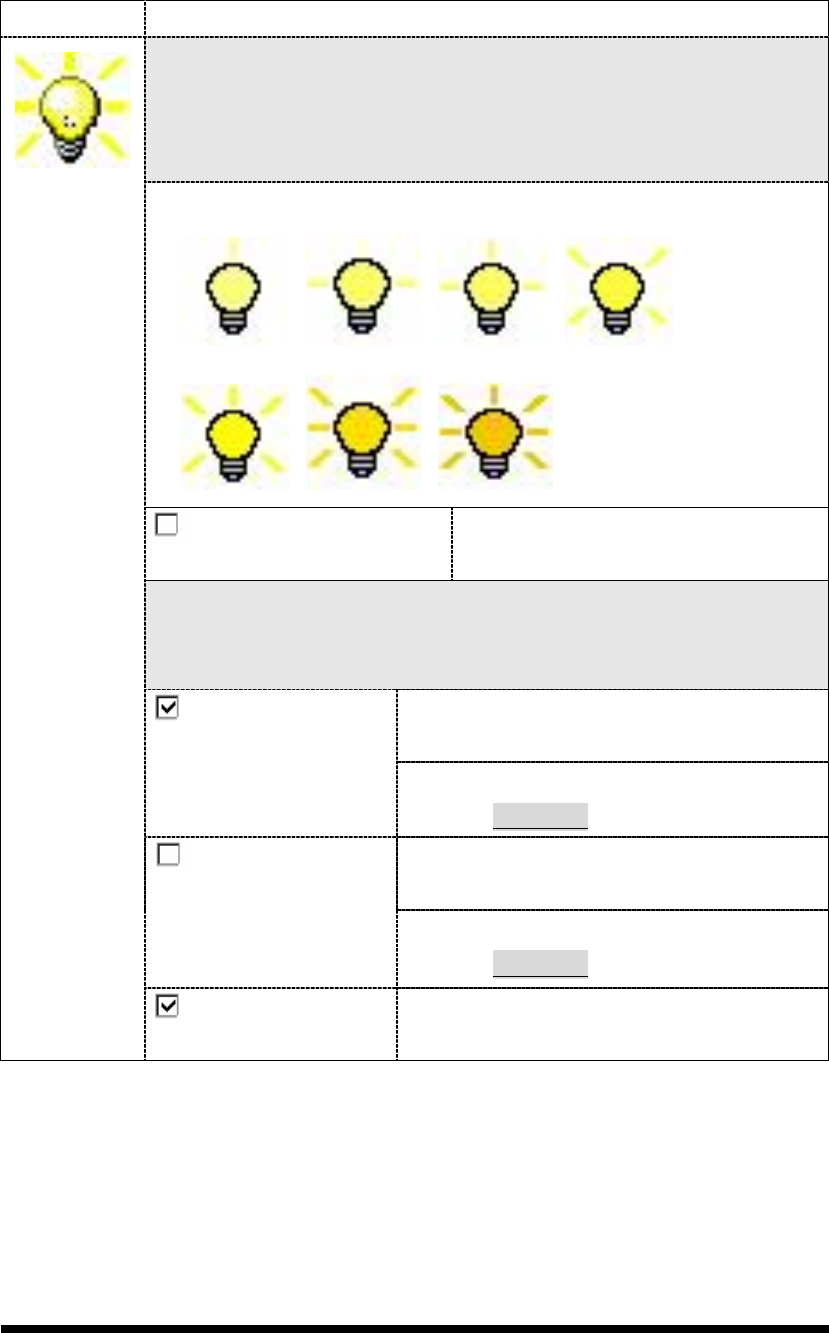
3-29
3.2.5.2 Brightness
Table 3-24 Brightness
ICON ITEM & FUNCTION
LCD Brightness
Tune the LCD brightness by tapping right-arrow & left-arrow. Can
also tune the LCD brightness by pressing right-direction key or
left-direction key of keypad.
Amounts 7 steps: Every step have corresponding picture of self.
1. 2. 3. 4.
5. 6. 7.
Enable Keypad
Brightness
Open keypad brightness or not.
Backlight Timeout
Save battery life by automatically turning off the backlight when not
used.
The table must disable when its item is not
marked.
Battery Power, turn
off backlight after
The table has 15 seconds, 30 seconds, 1
minute, 2 minutes and 5 minutes.
The table must disable when its item is not
marked.
AC Power, turn off
backlight after
The table has 15 seconds, 30 seconds, 1
minute, 2 minutes and 5 minutes.
Dim backlight after
20 seconds of idleness.
Save battery life functionally of idleness
mode, open it or not.
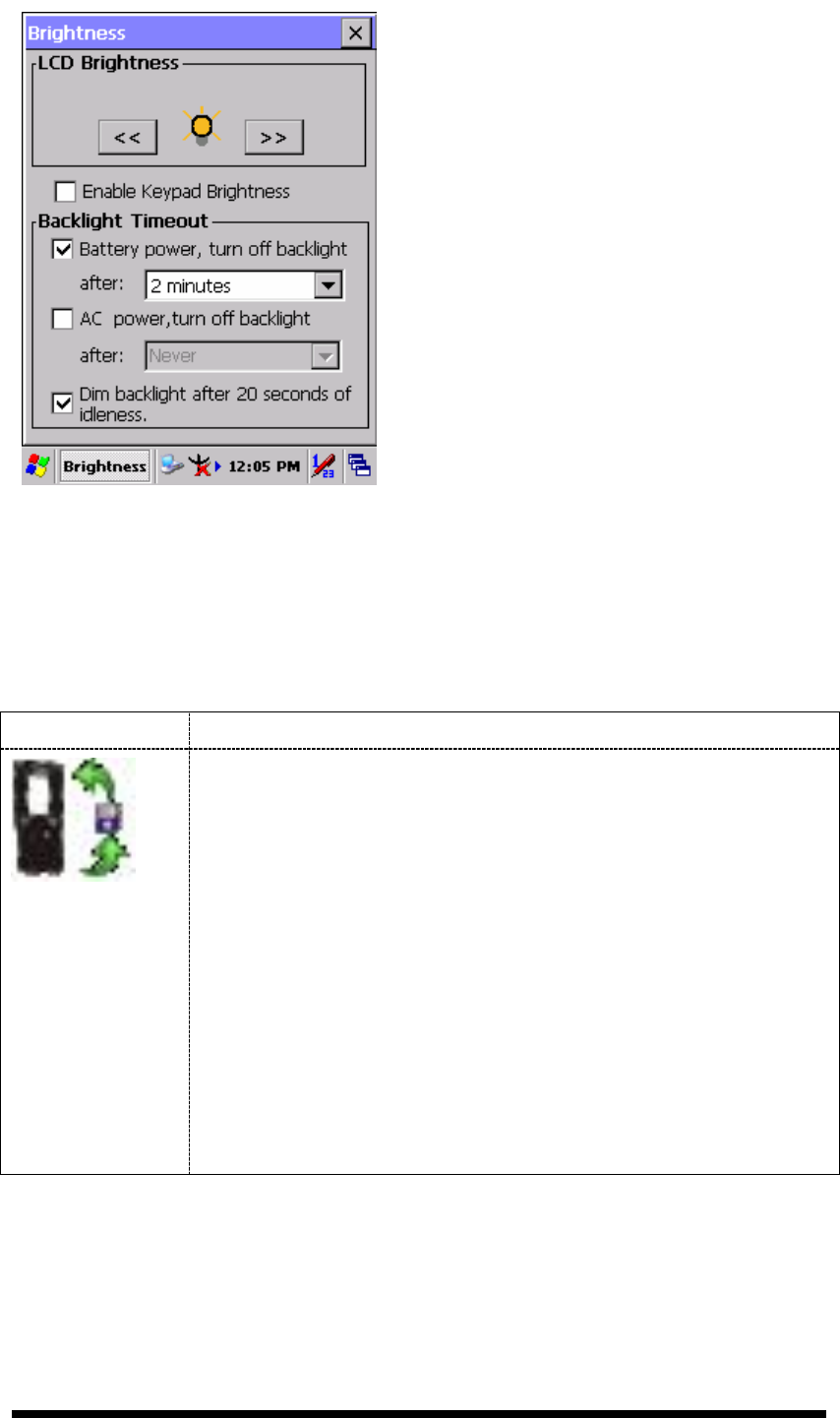
3-30
Figure 3-37 Brightness
3.2.5.3 Backup Restore
Table 3-25 Backup Restore
ICON ITEM & FUNCTION
1. You can backup/restore system to/from flash disk or inserted
memory card. (A. Disk on Chip, B. CF Card, C. SD Card)
( Figure 3-38)
2.
When you launch this AP, it must check backup file in DOC
first. And if you select other storage, it will check again.
3. Then if it has the file, appeared its date behind “Last backup
date:”; if not, disable “Restore Now” Button.
4. When you press the Backup/Restore Button will be a warning
dialog pop up. ( Figure 3-39)
5. When system backup/restoring finished will be a message
dialog will pop up. (A. Backup: Figure 3-40, B. Restore: Figure
3-41)
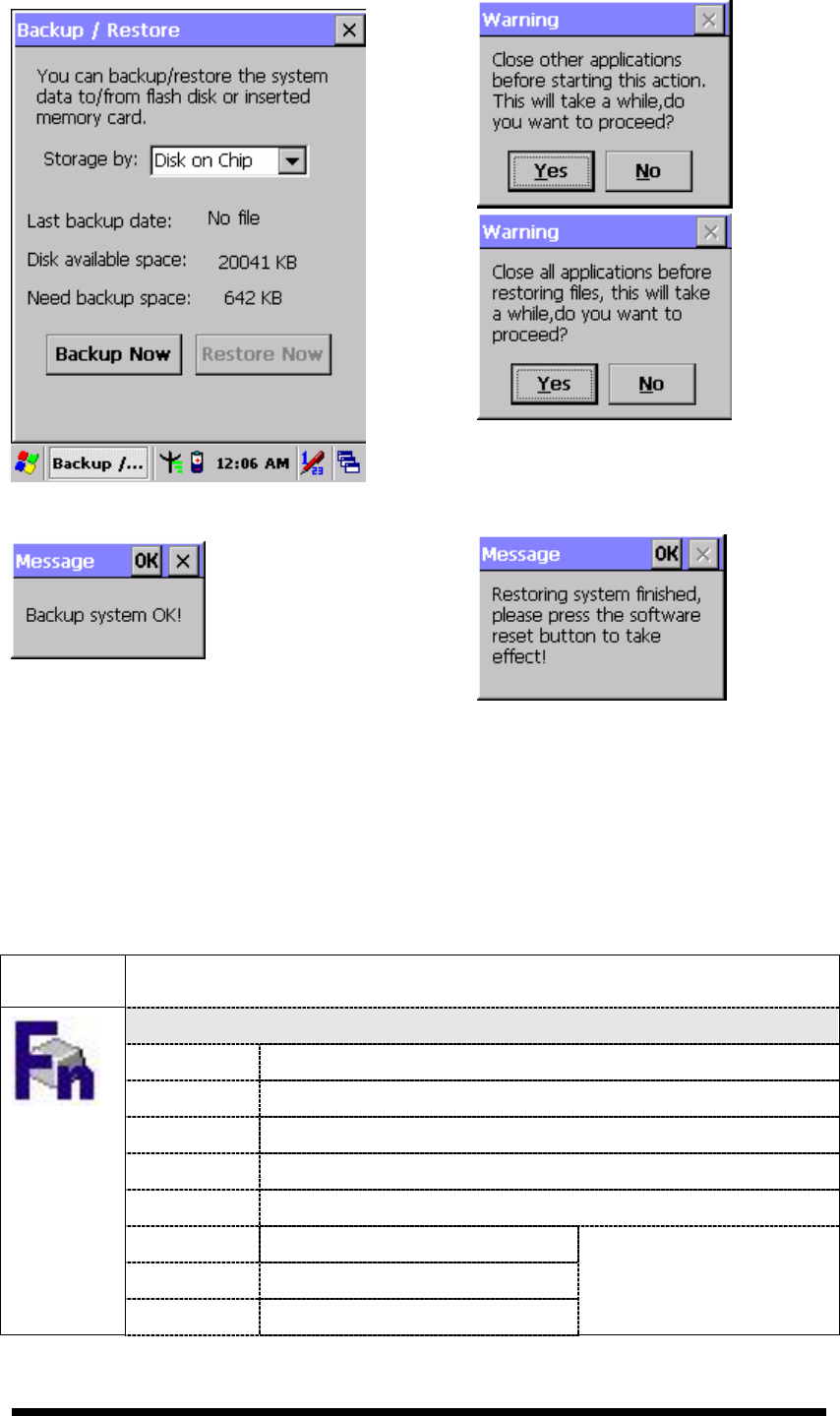
3-31
Figure 3-38 Backup Restore
Figure 3-39 Backup & Restore Start
Figure 3-40 Backup OK
Figure 3-41 Restore OK
3.2.5.4 Fn-key Settings
Table 3-26 Fn-Key
ICON
ITEM & FUNCTION
Fn-Key Setting (Figure 3-42)
Fn Key The Application Program of default setting
F1 Internet Explorer
F2 Microsoft WordPad
F3 Inbox
F4 My Computer
F5 Barcode Settings
F6 Media Player
F7 Calculator
Only for SC620
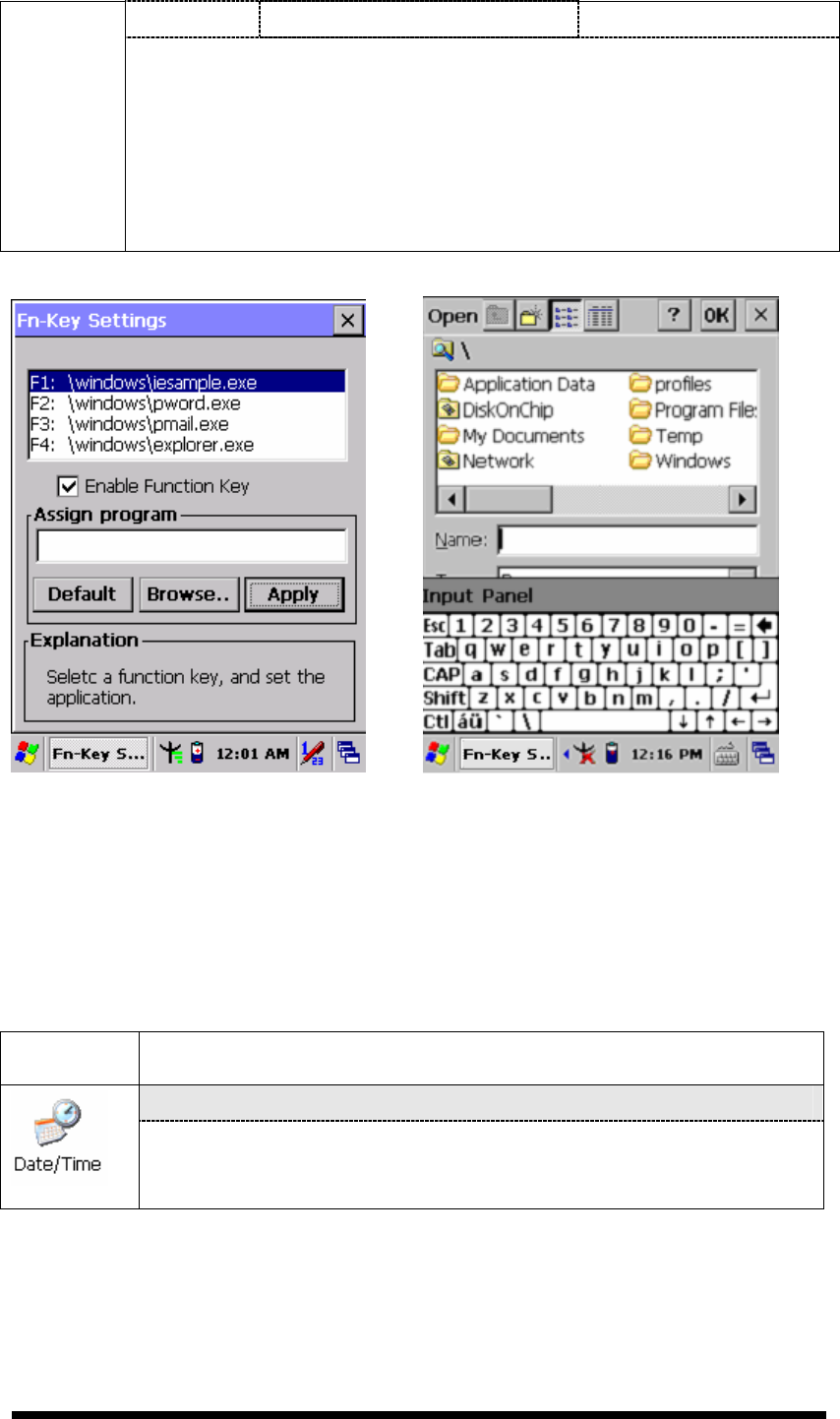
3-32
F8 Information
To assign your favorite application program to Hot Keys.
Choose one of Hot Keys from pull-down list.(Figure 3-43)
To tap “Browse…” inside “Assign program” applet.
Select one application program you want from program list, then,
choose “OK”. (Figure 3-43)
To tap “Default” to return back to default setting. (Figure 3-42)
Figure 3-42 Fn-Key Settings Figure 3-43 Fn-Key Settings
3.2.6 Date/Time
Table 3-27 Date/Time
ICON
ITEM & FUNCTION
“Date/Time” Tab :( Figure 2-14)
Please see the detail information of 2.5.1 Setting Time and
Date on P.2-21
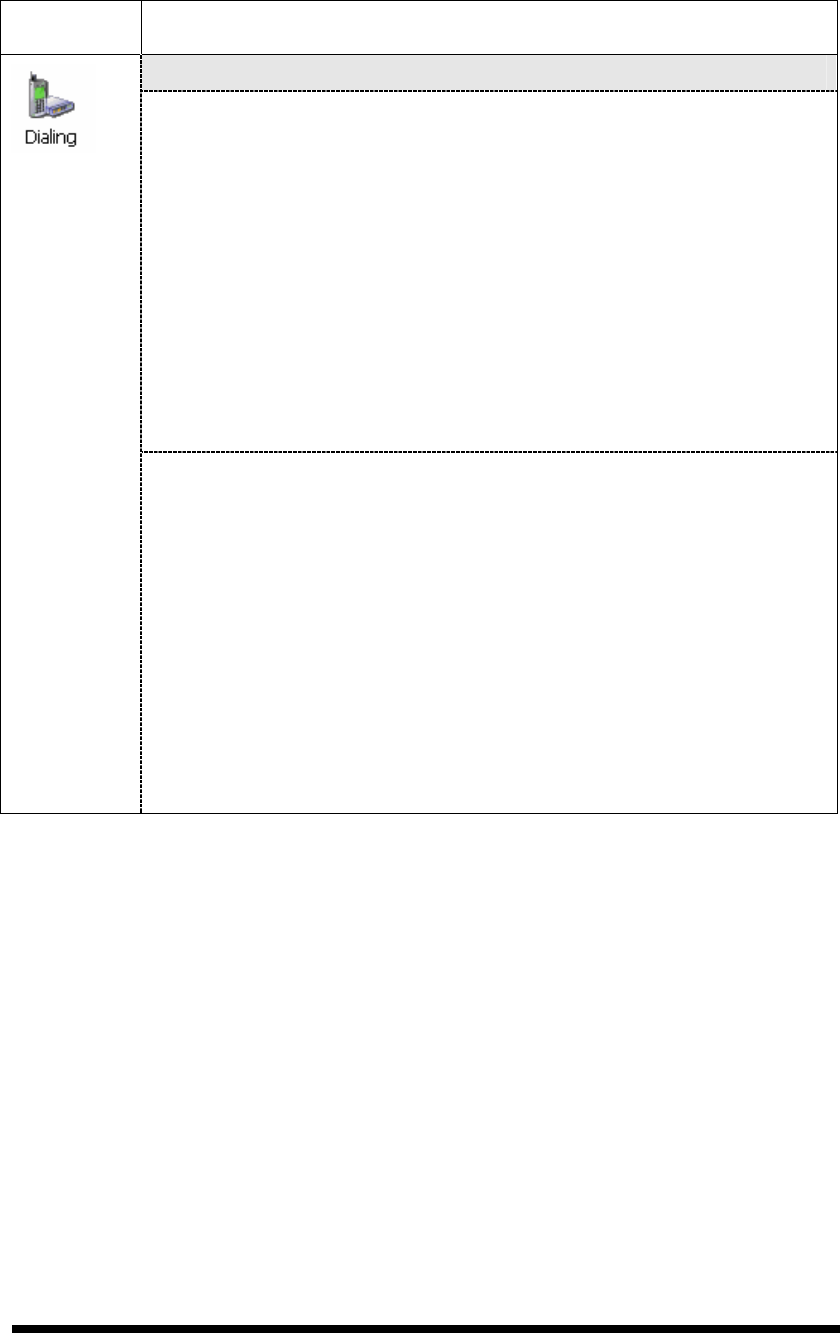
3-33
3.2.7 Dialing Properties
Table 3-28 Dialing properties
ICON
ITEM & FUNCTION
“Dialing Properties” Tab :( Figure 3-44)
In the When dialing from list, select the “Location” where you
want to change settings.(Figure 3-45)
To create a new location, select “New”. Enter the name of the
location, and then select “OK”.(Figure 3-46)
Enter or edit the area code and local country code as needed.
In Dial using, select “Tone dialing” or “Pulse dialing”. Most
phone lines are tone.
To automatically disable call waiting, select “□
□□
□ Disable call
waiting by dialing”, select the appropriate number sequence in
the list, or enter a new sequence.
Editing dialing patterns (Figure 3-47)
Using the codes listed in the topic; revise the dialing patterns as
needed.
Notes:
If you need to use character other than the ones listed here,
use manual dialing.
Hyphens and spaces in dialing strings are ignored.
Some modems may not respond to the following characters,
even though your device lets you add them to the dial
string.
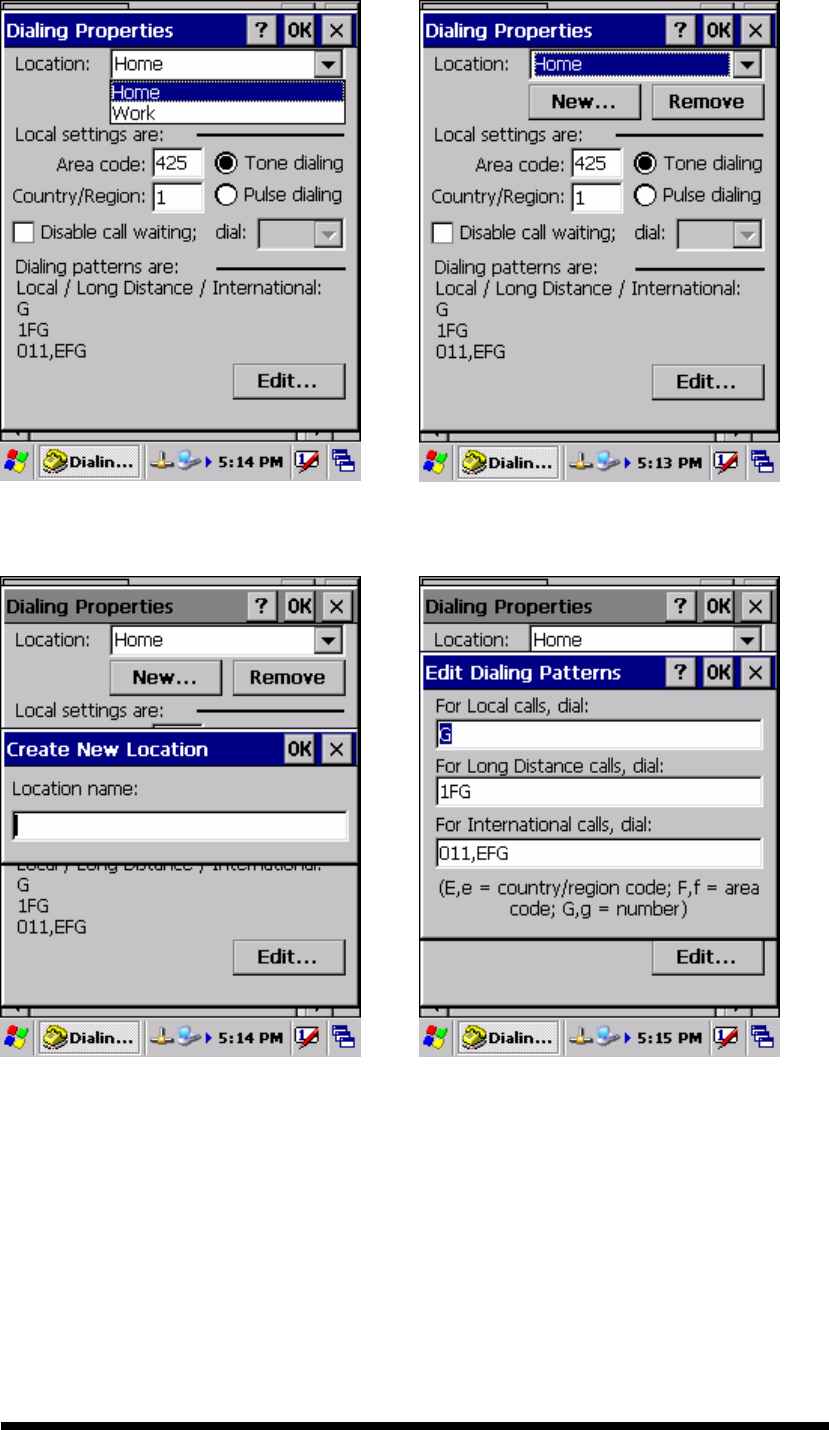
3-34
Figure 3-44 Dialing Properties Figure 3-45 Dialing Properties
Figure 3-46 Dialing Properties Figure 3-47 Dialing Properties
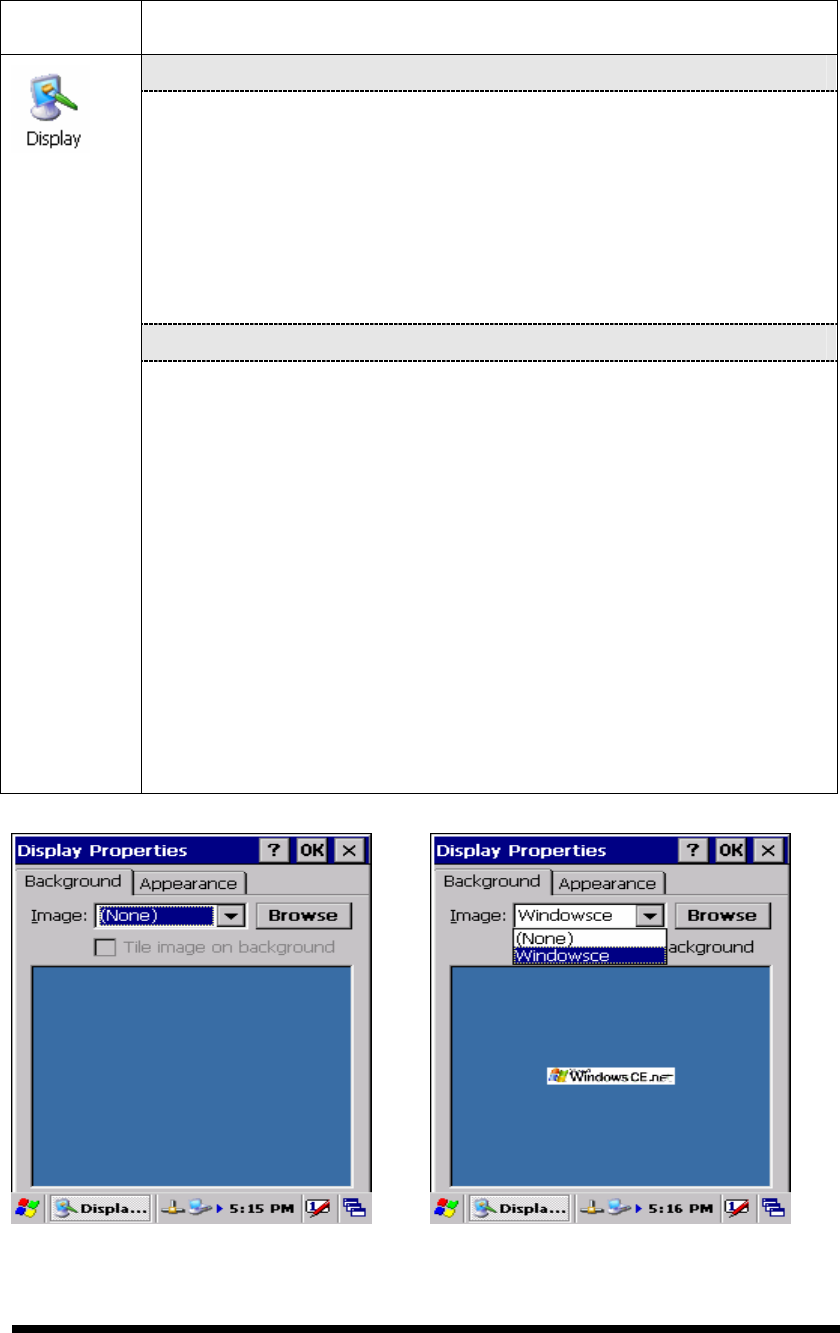
3-35
3.2.8 Display Properties
Table 3-29 Display properties
ICON
ITEM & FUNCTION
“Background” Tab :( Figure 3-48)
From the “Image” list, select an image you want as the
background of the desktop.(Figure 3-49)
To locate an image in another folder, select “Browse”.(Figure
3-50)
To have the image cover the entire background, select “ □
□□
□Tile
image on background”
“Appearance” Tab(Figure 3-51)
Change the color scheme :( Figure 3-52)
From the” Scheme” list, select a scheme.
View your choice in the preview box. If you like the scheme,
select “Apply”.
Create a custom color scheme:
From the “Item” list, select a display item.
From the “Basic colors” list, select a color, and select “OK”.
View your color selection(s) in the Preview box.
To save the scheme, select “Save”.
In the “Save this color scheme as” box, enter a name for the
scheme, and select “OK”.
Select “Apply”.
Figure 3-48 Display properties Figure 3-49 Display properties
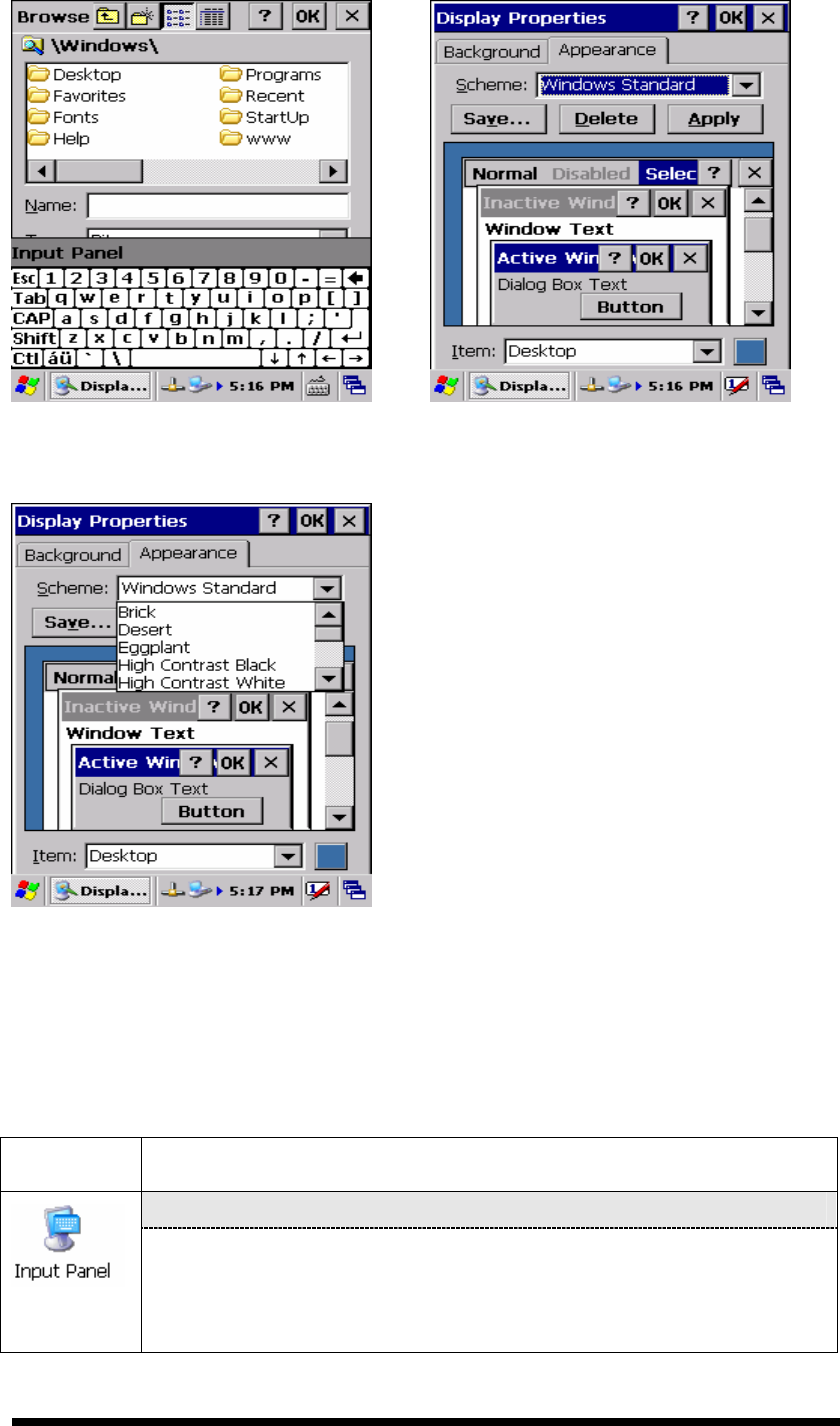
3-36
Figure 3-50 Display properties Figure 3-51 Display properties
Figure 3-52 Display properties
3.2.9 Input Panel
Table 3-30 Display properties
ICON
ITEM & FUNCTION
“Input panel” Tab :( Figure 3-53)
Select the input method you want to change.
To change the Soft Keyboard Options , tap “Option” (Figure
3-54) .
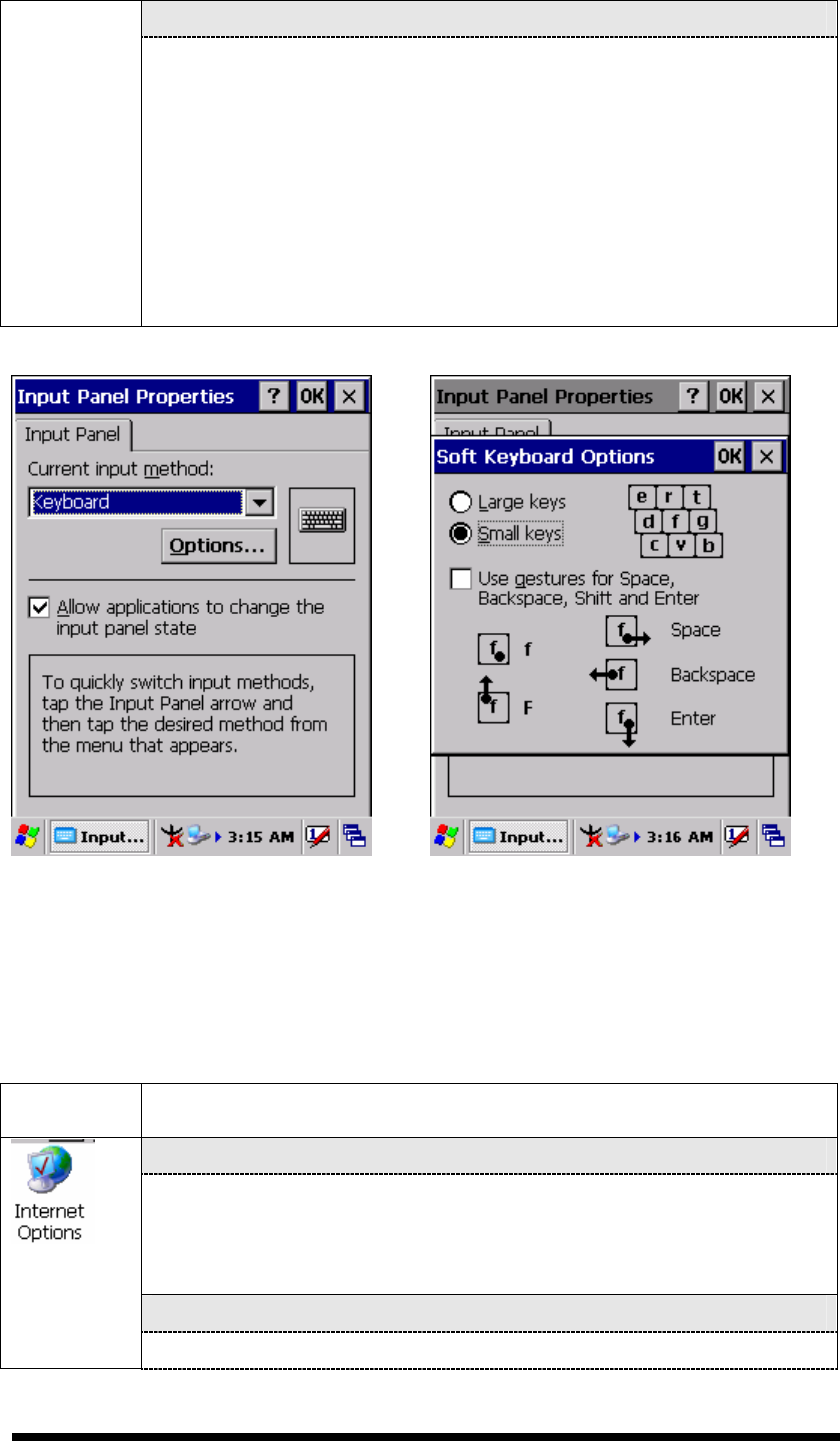
3-37
“Options” Tab :
Change the soft keyboard options as desired, selecting from:
Large or small keys
Using gestures for space, black-space shift, and enter.
To exit the soft keyboard Options, press “OK” on the control
bar, or press the <Enter> key on the keypad.
To exit the Input Panel, press “OK” on the control bar, or press
the <Enter> key on the keypad.
.
Figure 3-53 Input Panel Properties Figure 3-54 Input Panel Properties
3.2.10 Internet Options
Table 3-31 Internet Options
ICON
ITEM & FUNCTION
“General” Tab :( Figure 3-55)
Type in the URL of desired start page and the desired search
engine. You also change the Cache Size, clear the Cache and
Clear the History..
“Connection” Tab :( Figure 3-56)
Modify the network access setting as desired.
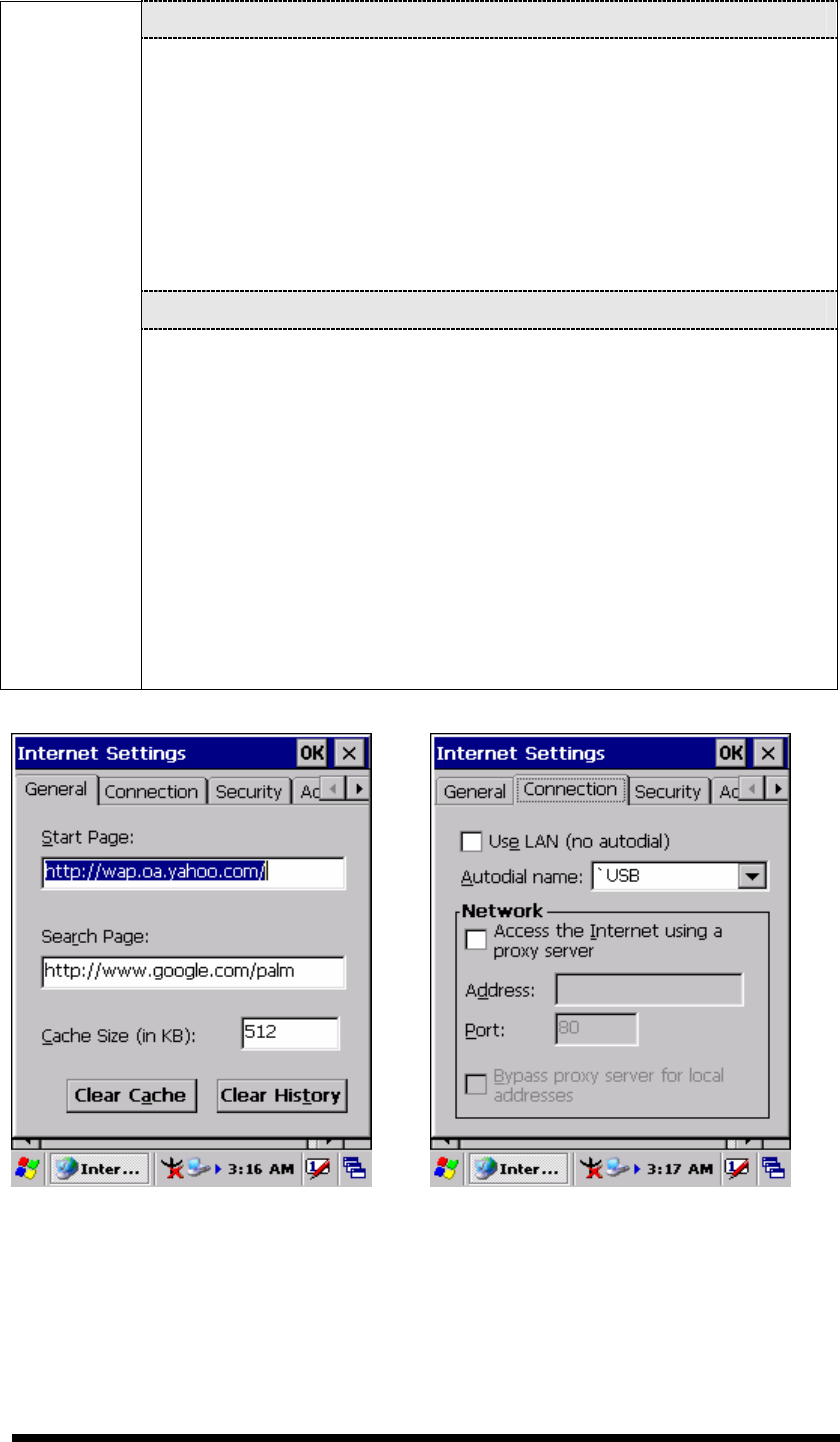
3-38
“Security” Tab (Figure 3-57)
Modify the security settings as desired. You can enable any of
the following by tapping the checkbox:
Allow cookies
Allow TLS 1.0 security
Allow SSL 2.0 security
Allow SSL 3.0 security
Warm when switching across secure and insecure areas.
“Advanced” Tab (Figure 3-58)
Modify the security settings as desired. You can enable any of
the following by tapping the checkbox:
Display Image in pages
Play sounds in pages
Enable scripting
Display a notification about every script error
Underline links-
○
Never
○
Always
○
Hover
Figure 3-55 Internet Settings Figure 3-56 Internet Settings
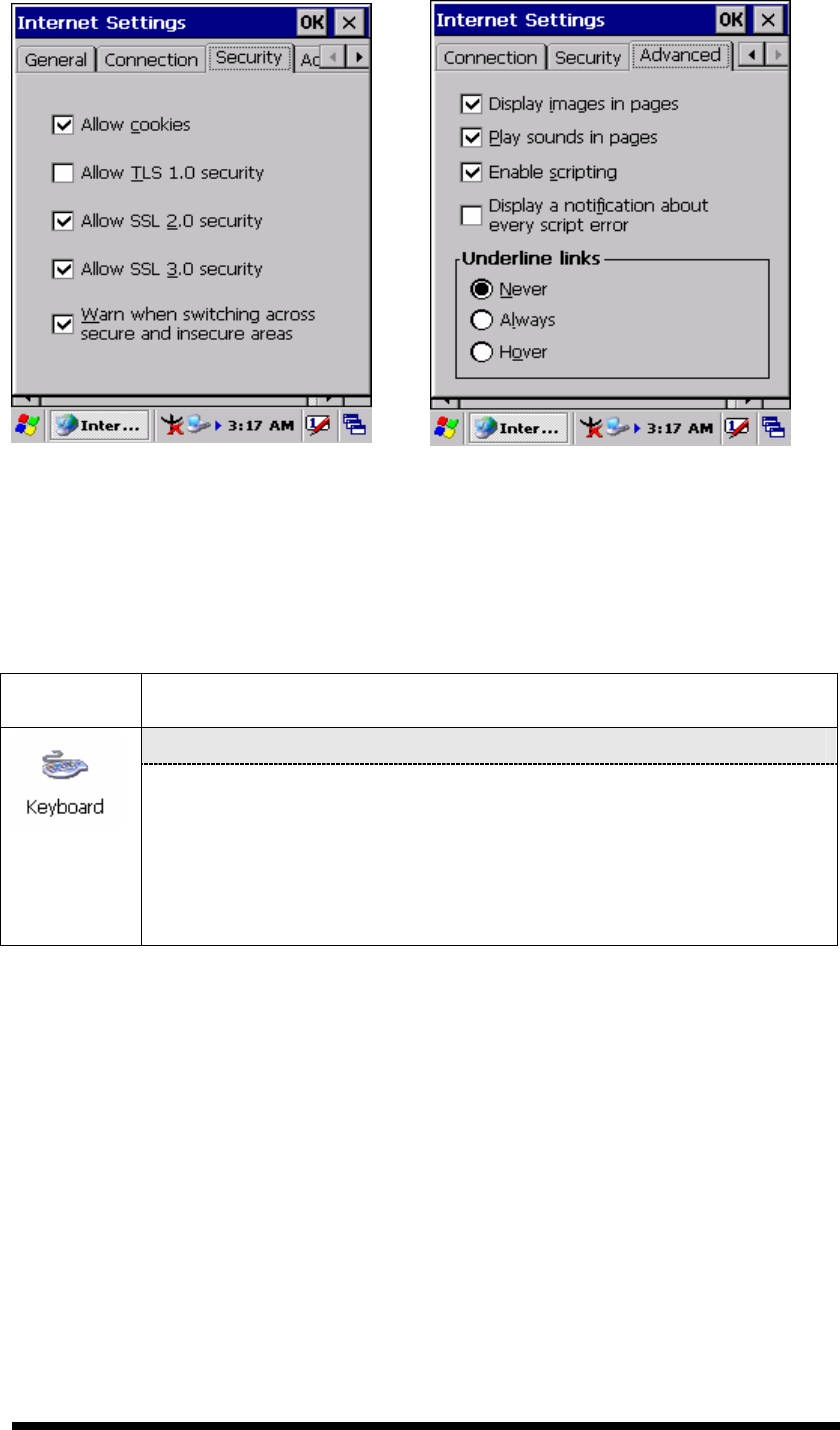
3-39
Figure 3-57 Internet Settings
Figure 3-58 Internet Settings
3.2.11 Keyboard
Table 3-32 Keyboard
ICON
ITEM & FUNCTION
“Repeat” Tab :( Figure 3-59)
To change the amount of time between depressions before
repetition starts, adjust the Repeat delay slider
To change the repeat rate, adjust the Repeat rate slider.
Test your new setting.
Tap “ OK” to exit the “Keyboard” Tab.
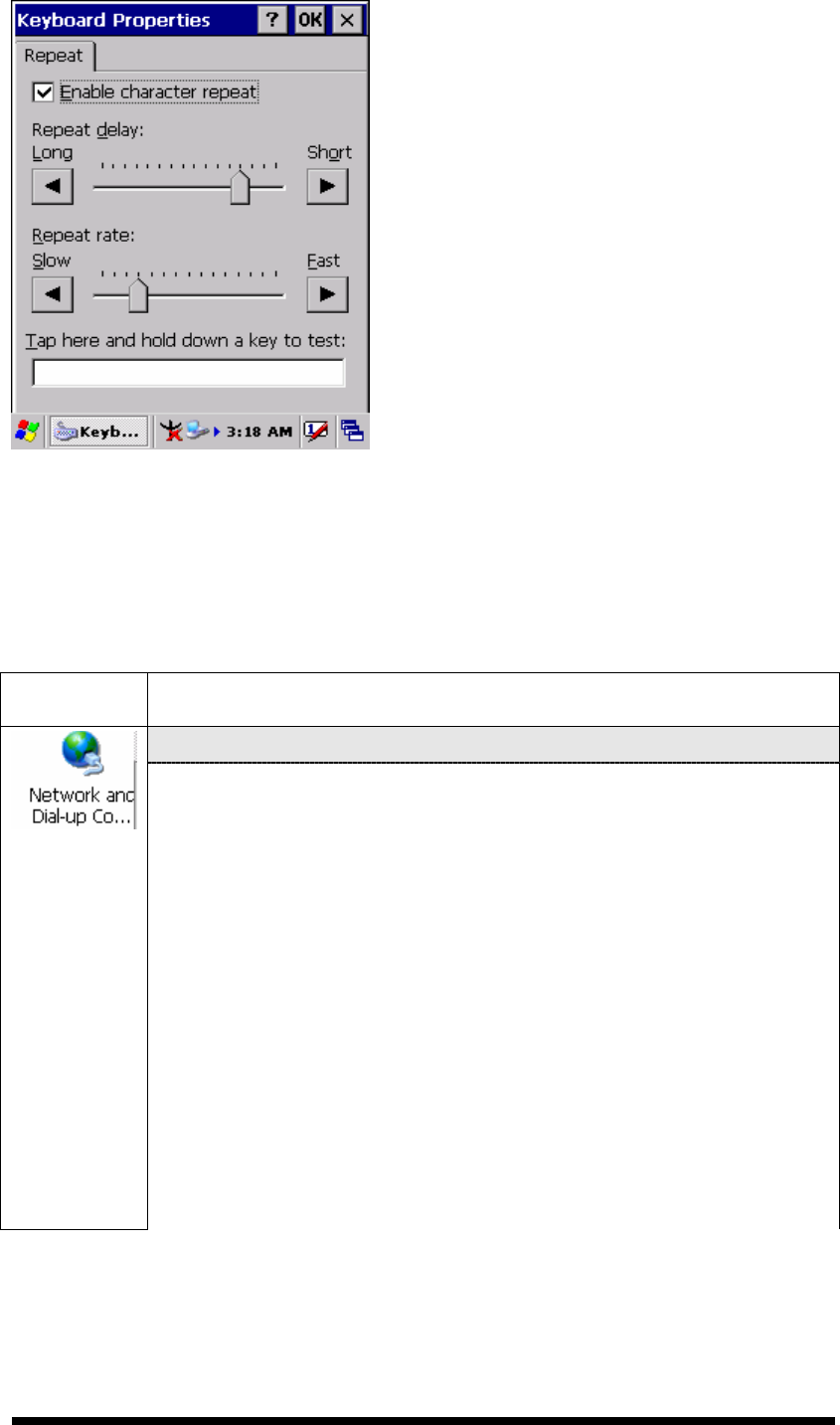
3-40
Figure 3-59 Keyboard Properties
3.2.12 Network and Dial-up Connections
Table 3-33 Network and Dial-up Connections
ICON
ITEM & FUNCTION
“Connection” Tab :
To create a “Dial-up Connection”:
Double-tap the “Make New connection”.
In the “Make New Connection” dialog box, enter a name for
the connection.
Select “Dial-Up Connection”.
Select the “Next” button.
Select the modem you want use.
Select “Configure”
Under “Connection Reference”, use the default settings
provided. If you can’t connect using these settings, see your
ISP or network administrator for specific information. If you
want to always enter a phone number before connecting,
Select “Manual Dial”. Select “OK”.

3-41
Select “TCP/IP Settings”. In the “General” tab, ensure “Use
Server-assigned IP address” is selected. In the “Name
Servers” tab, ensure “Use Server-assigned addresses” is
selected, and select “OK”. If you are unable to connect with
these default settings, see your ISP or network administrator
for specific TCP/IP information.
Select the “Next” button and type the telephone number.
Select the “Finish” button.
The connection you just created appears as an icon in the “Network
and Dial-up Connections” folder.
Set up a point-to-Point Protocol(PPP) account with an ISP and
obtain the following information:
Access telephone number
User name
Password
Once you have established an account, create a new connection on
your device. When creating this connection, you should be able to use
all of the default TCP/IP settings provided in the Make New
Connection Wizard. If you can’t connect using the default settings,
contact your ISP or access your ISP’s Web site for specific TCP/IP
information as well as primary and secondary DNS address.
Modify connection setting
Select Start > Settings > Network and Dialup Connections
Select the icon for connection settings you want to modify.
Select File > Properties, or double- tap the appropriate icon.
Select desired options. There may be additional settings that
depend on the connection. To modify, select the icon and
select the icon and select Advanced Settings… from the
menu.
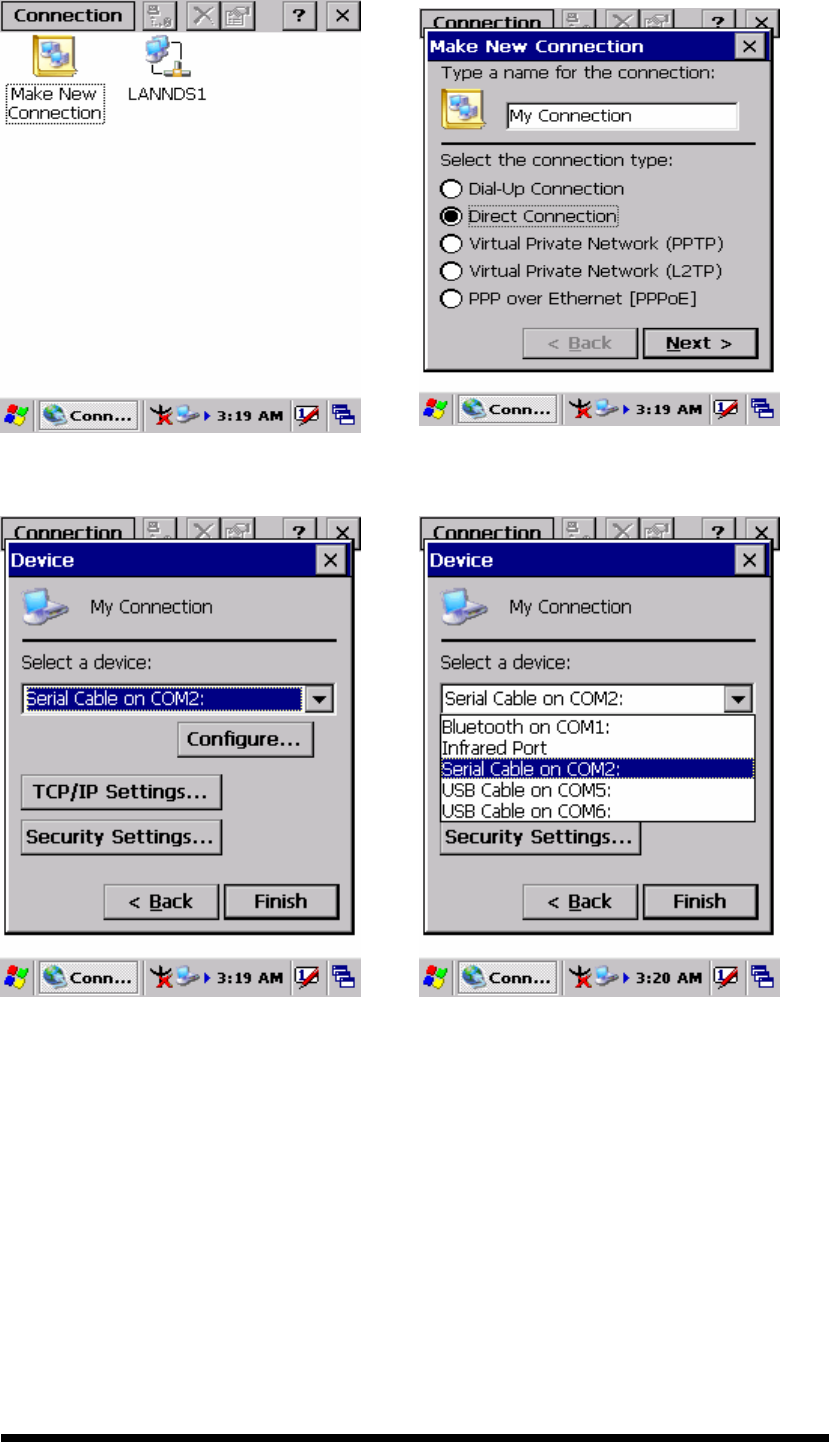
3-42
Figure 3-60 Network and Dial-up Connections
Figure 3-61 Network and Dial-up Connections
Figure 3-62 Network and Dial-up Connections
Figure 3-63 Network and Dial-up Connections
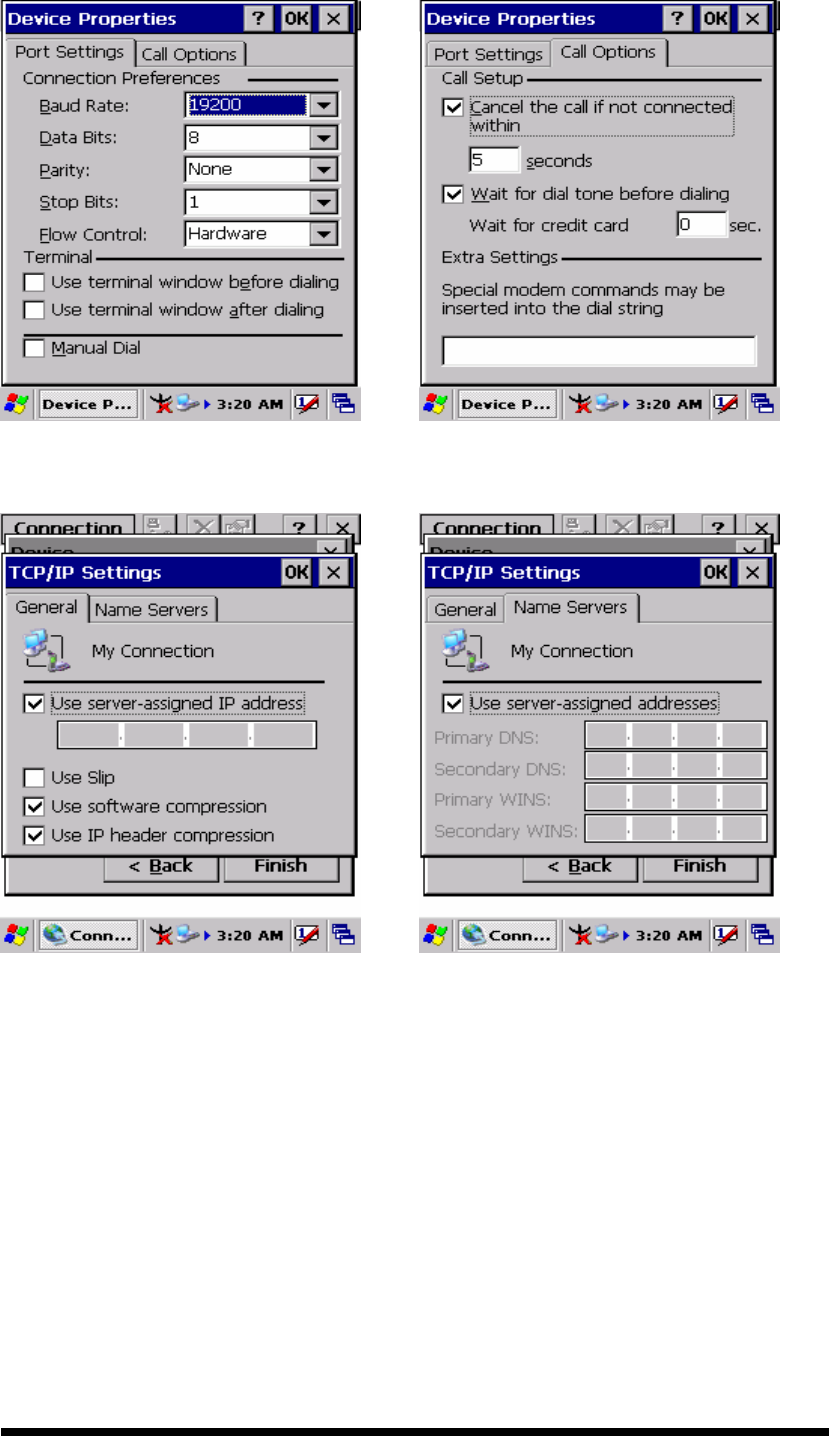
3-43
Figure 3-64 Network and Dial-up Connections
Figure 3-65 Network and Dial-up Connections
Figure 3-66 Network and Dial-up Connections
Figure 3-67 Network and Dial-up Connections
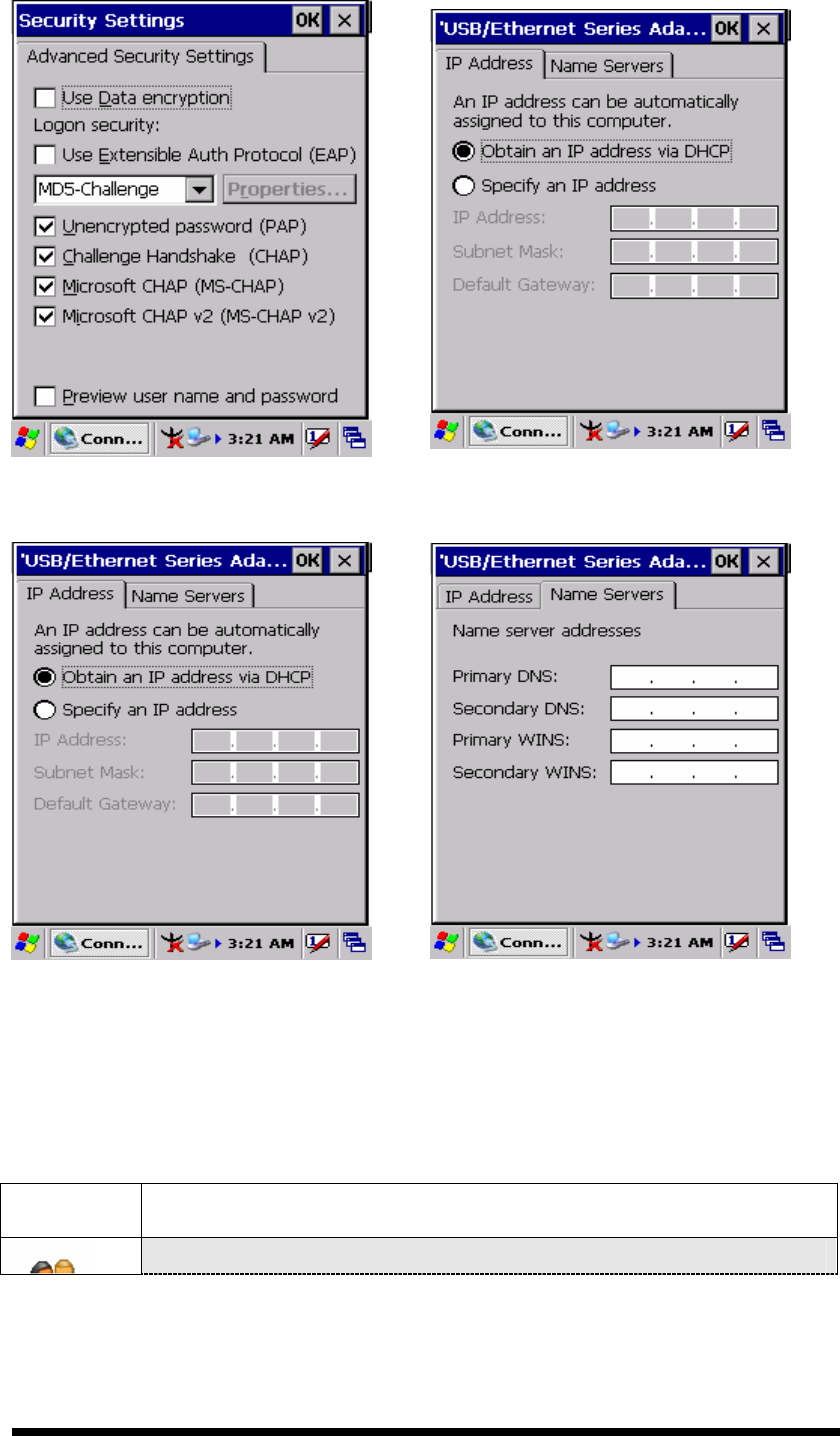
3-44
Figure 3-68 Network and Dial-up Connections
Figure 3-69 Network and Dial-up Connections
Figure 3-70 Network and Dial-up Connections
Figure 3-71 Network and Dial-up Connections
3.2.13 Owner
Table 3-35 Owner
ICON
ITEM & FUNCTION
“Identification” Tab : (Figure 3-72)
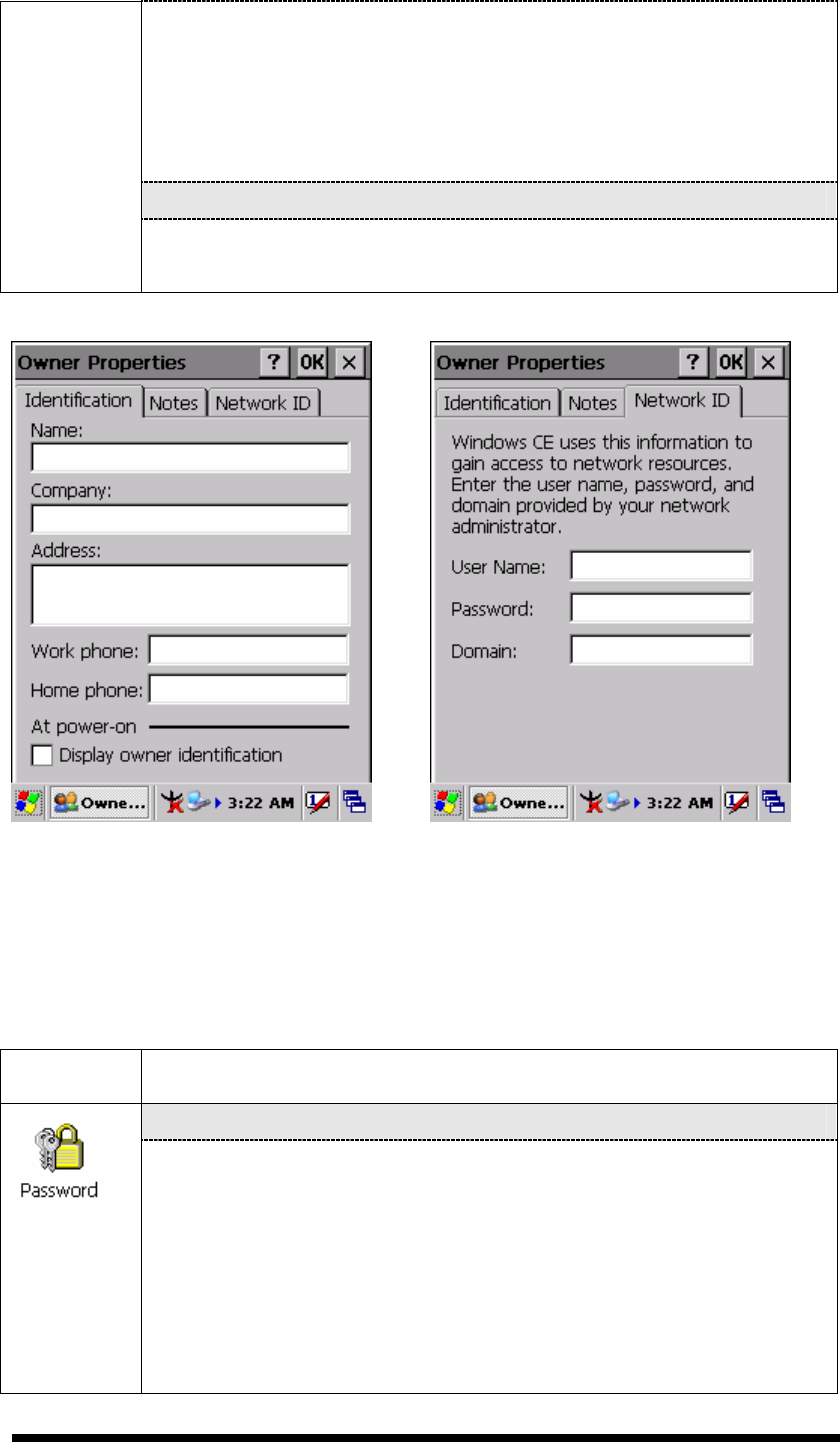
3-45
Fill in or edit the data as desired.
To have this information displayed when you start your device,
select “Display Owner Identification” at Power On.
To set up identification for remote networks, see Setting up
identification for remote networks.
“Network ID” Tab: (Figure 3-73)
Enter the user name, password, and domain name you use to log
on to remote network.
Figure 3-72 Owner Properties Figure 3-73 Owner Properties
3.2.14 Password
Table 3-36 Password
ICON
ITEM & FUNCTION
“Password Setting” Tab : (Figure 3-74)
Enter the password
In the “Confirm password “box, enter the password again.
To require the password on startup, select “Enable password
protection at power- on“. and/or select “Enable password
protection for screen saver”
To exit the Password control panel, press “OK” from the
control bar, or press the <Enter> key on the keypad.
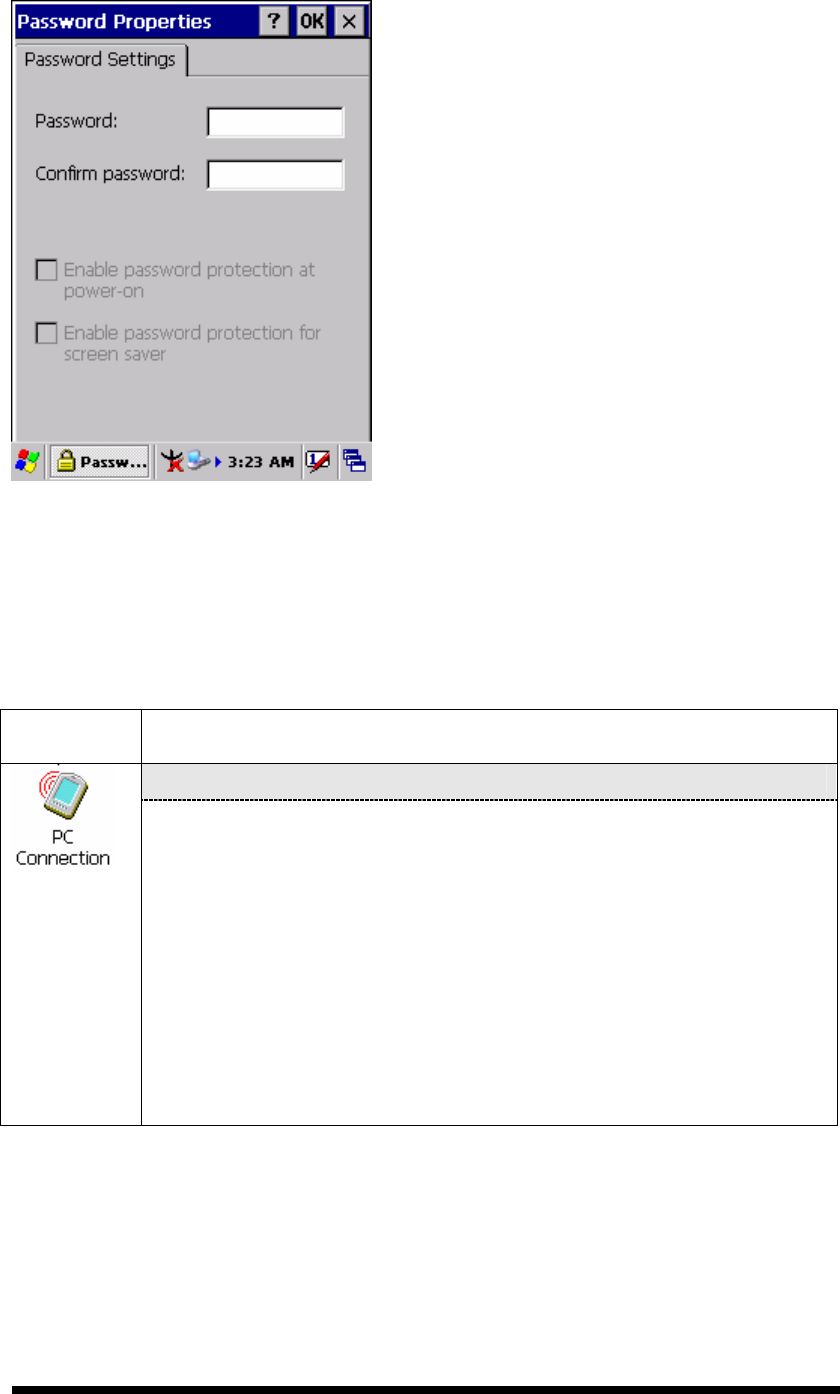
3-46
Figure 3-74 Password Properties
3.2.15 PC Connection
Table 3-37 PC Connection
ICON
ITEM & FUNCTION
“PC Connection” Tab : (Figure 3-75)
Select the first checkbox to enable direct connections to the
desktop computer. (Figure 3-75)
Tap the “Change Connection…” button to modify the
connection method from USB or Serial. (Figure 3-76)
To exit the “Change Connection” dialog, press “OK” from the
control bar, or press the <Enter> key on the keypad.
To exit the “PC Connection” properties control panel, press
“OK” from the control bar, or press the <Enter> key on the
keypad.
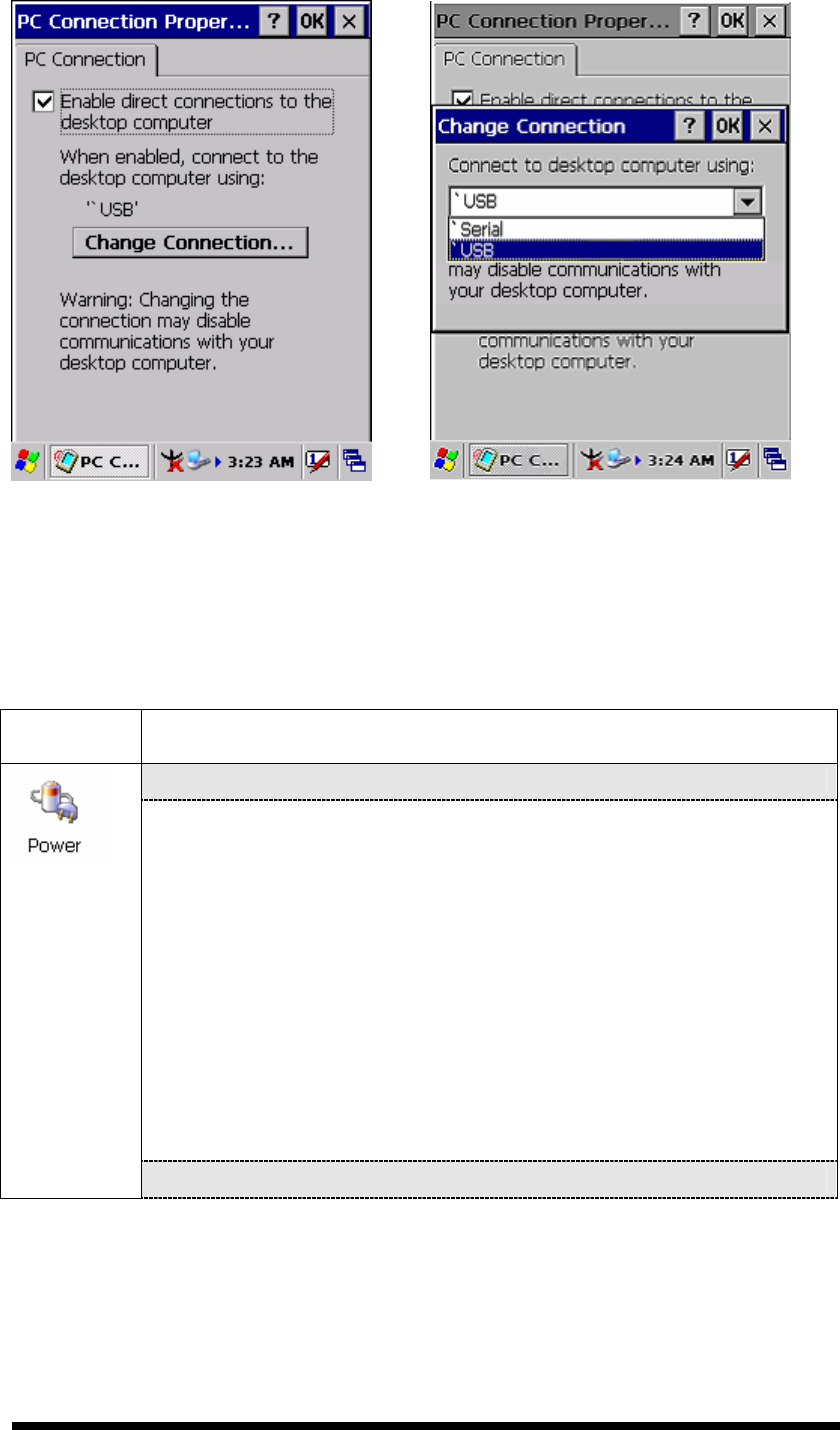
3-47
Figure 3-75 PC Connection Figure 3-76 PC Connection
3.2.16 Power
Table 3-38 Power
ICON
ITEM & FUNCTION
“Battery” Tab : (Figure 3-77)
Provide change level indicators for Main battery and Backup
battery.
Provide remaining power capacity of main battery.
If a “Main Batteries very Low” warning message shows, the
remaining battery life is around 30 minutes to SC600 shuts
down. ( Figure 3-81)
The PDT will shutdown during the main batteries capacity is
around 0%
To exit Battery control panel, press “OK” from the command
bar, or press <Enter> key on keypad.
“ Schemes” Tab: (Figure 3-78)
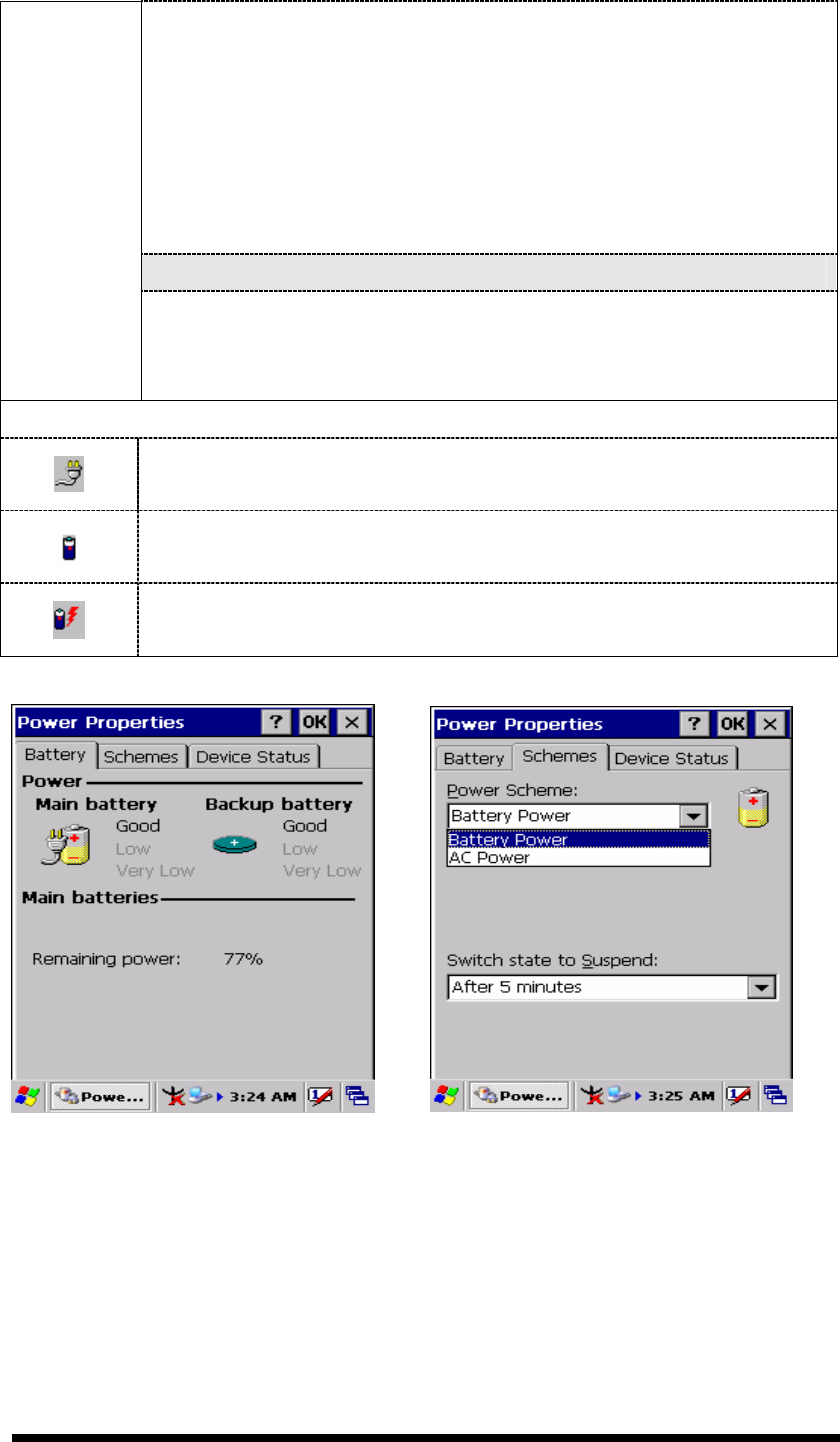
3-48
The Scheme Tab allows you to determine the time to switch
state to Suspend mode when using either Battery Power or AC
Power.
Select Battery Power or AC Power as the power scheme from
the pull-down list.( Figure 3-78)
Select the time to suspend mode from the pull-down list.
( Figure 3-79)
“Device Status” Tab: ( Figure 3-80)
Provide power level of device – The power level ranges from
“ High(D0)” which means the device is at the highest power level to
“Off(D4)” which means the device is at the lowest power level.
Note:
This ICON inside the Task Bar shows that AC adapter provides power
to the PDT
The ICON inside the Task Bar shows that Main Batteries provides the
power to the PDT.
The ICON inside the Task Bar shows that AC adapter provides the
power to the PDT and is charging the main batteries..
Figure 3-77 Power Figure 3-78 Power
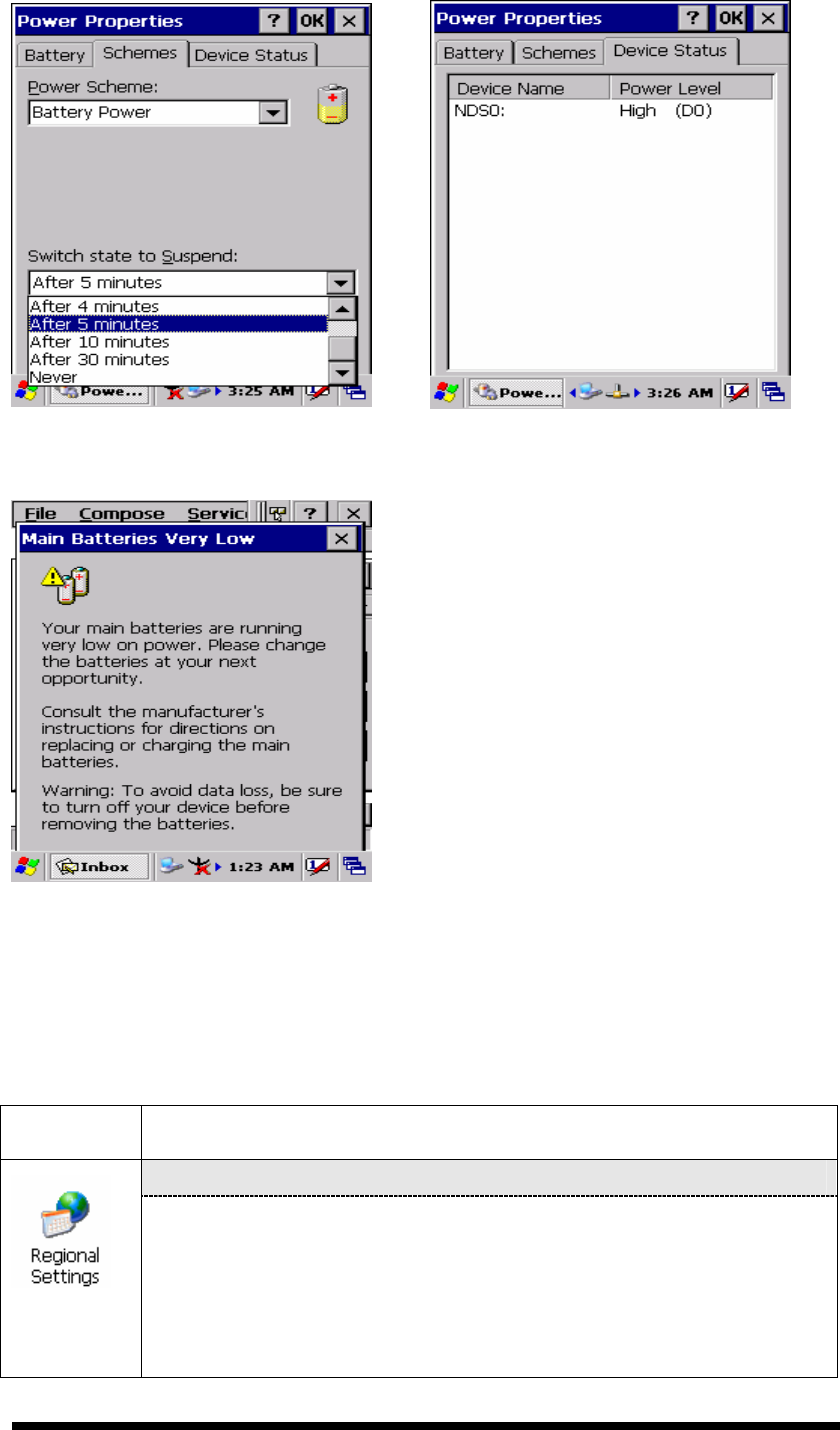
3-49
Figure 3-79 Power Figure 3-80 Power
Figure 3-81 Power
3.2.17 Regional Settings
Table 3-39 Regional Settings
ICON
ITEM & FUNCTION
“Region” Tab : (Figure 3-82)
Select the desired location/language.
Review the Appearance samples in the bottom half of the
screen.
Select the Tab at the top for any settings you wish to change,
Options to modify include Number, Currency, Time, and Date.
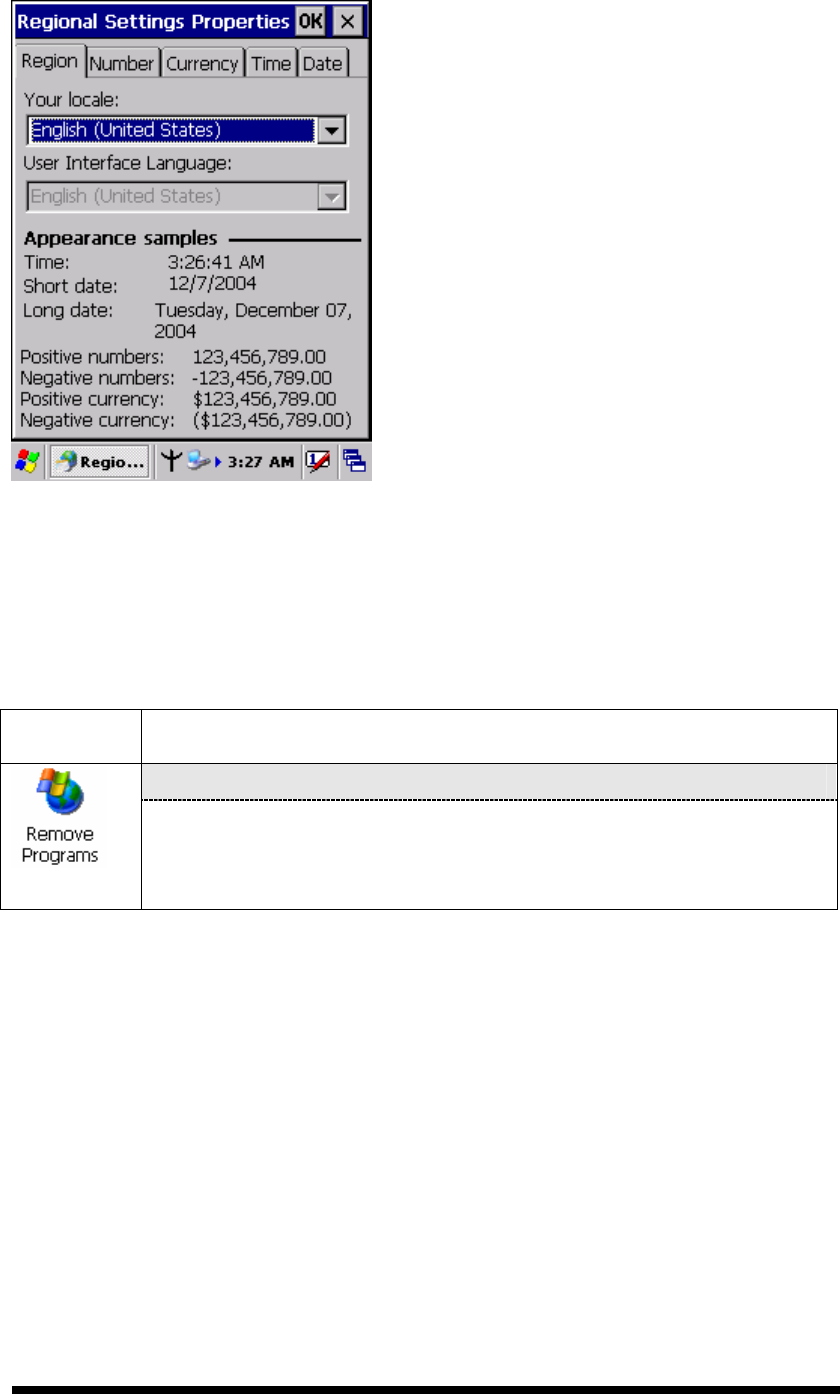
3-50
Figure 3-82 Regional Settings
3.2.18 Remove Programs
Table 3-40 Remove Programs
ICON
ITEM & FUNCTION
“Remove Programs” Tab :
Only user installed programs can be removed.
Select the program you wish to remove from the list and press
“remove” button.
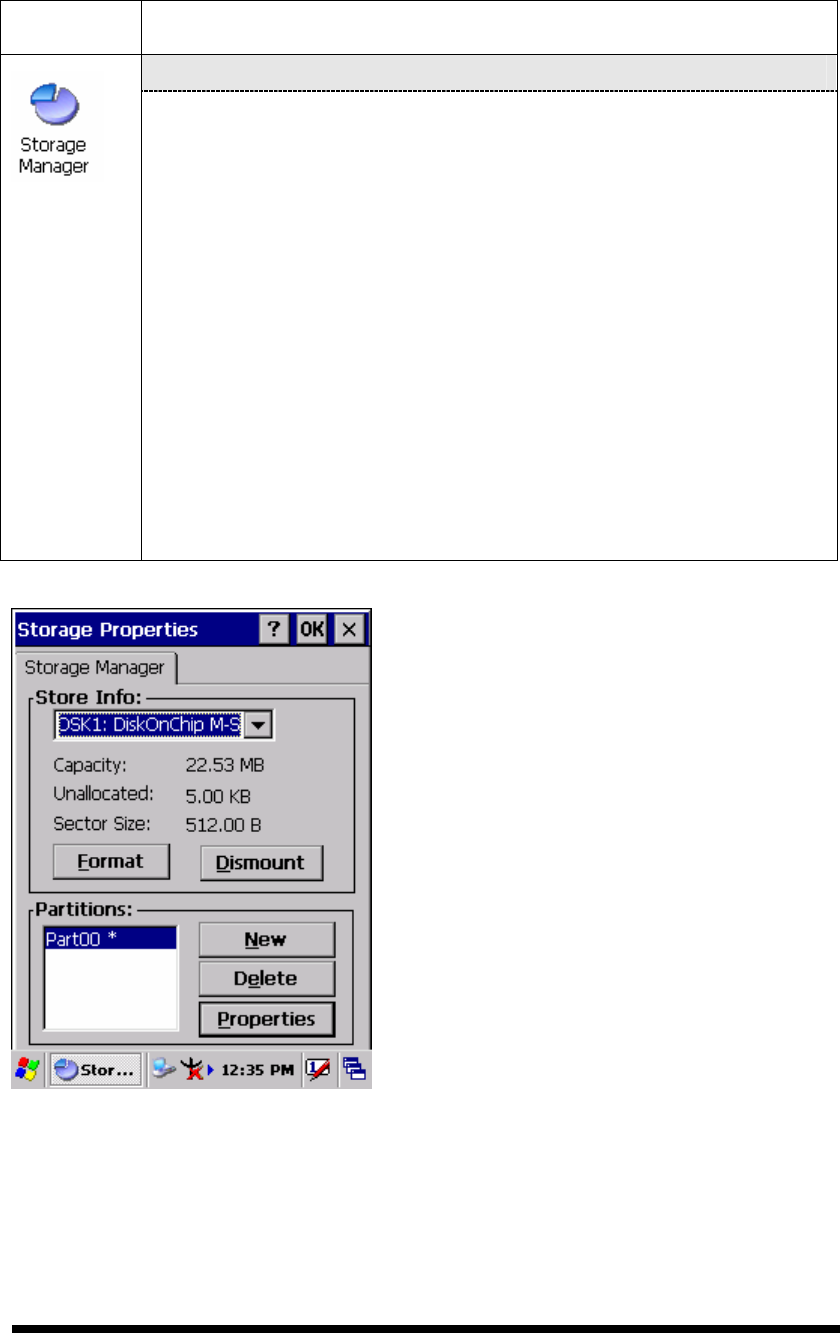
3-51
3.2.19 Storage Manager
Table 3-41 Storage Manager
ICON
ITEM & FUNCTION
“Storage Manager” Tab : (Figure 3-83)
To change Storage properties control panel default settings:
Insert. Compact Flash(CF) or Secure digital (SD) storage card into
the unit.
Select Start > Settings > Control Panel > Storage Properties
From the “Storage Info” pull-down list, select the desired
storage device.
You can also format, dismount, and create partitions on storage
devices using this control panel.
To save and exit the Storage Properties control panel, press
“OK” from the control bar, or press the <Enter> key on the
keypad.
Caution: Dismounting or formatting the DiskOnChip will
erase all files and program stored in Flash Memory
Figure 3-83 Storage Manager
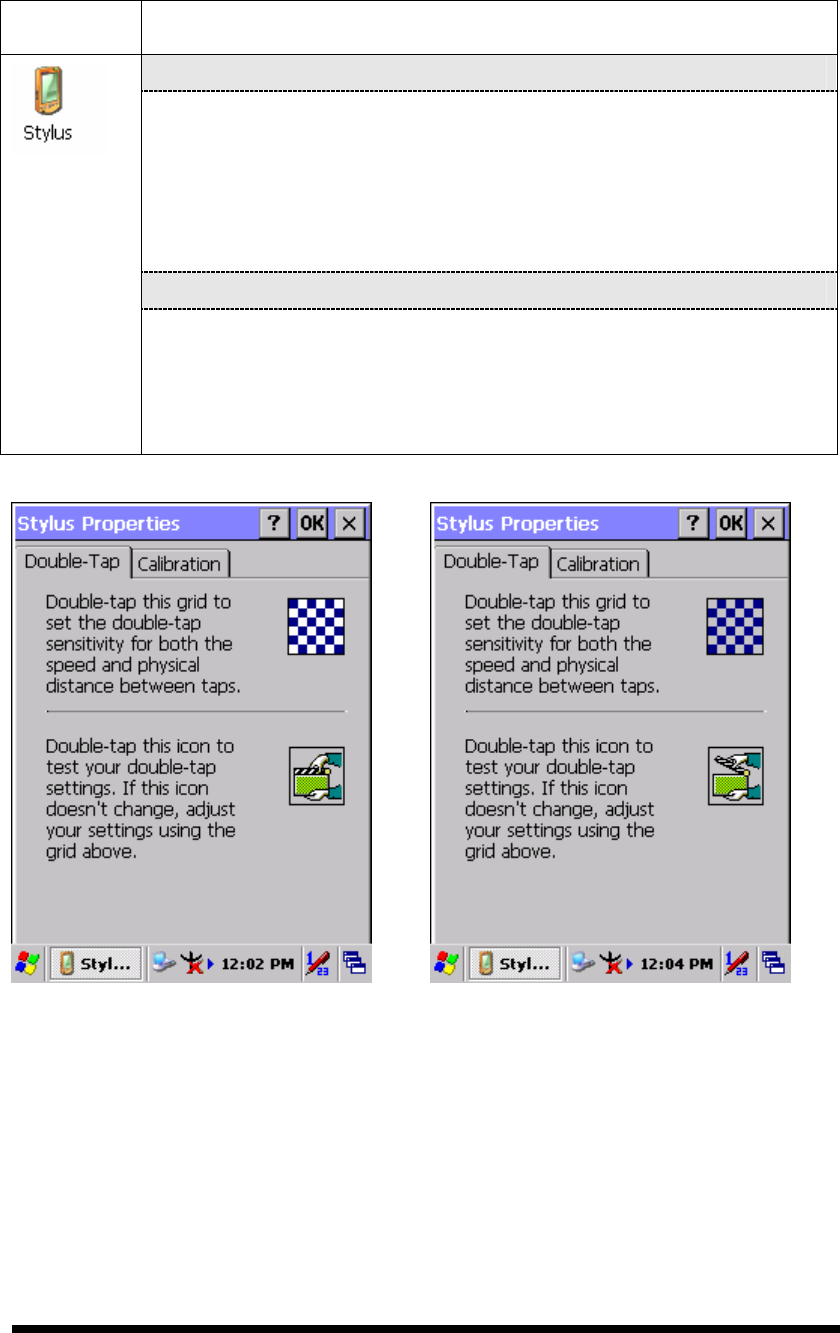
3-52
3.2.20 Stylus
Table 3-42 Stylus
ICON
ITEM & FUNCTION
“Double-Tap” Tab : (Figure 3-84,Figure 3-85)
Double-tap the checkerboard grip at a comfortable speed.
Double-tap clapboard to test your settings
The function is OK if the figures are changed from Figure 3-84
to Figure 3-85.
To tap “OK” to exit the Stylus Properties.
“
Calibration”: (Figure 3-86, Figure 3-87)
In the Welcome Wizard, you tapped a target with the stylus to set
the amount of pressure needed for the screen to respond to your
stylus taps.
Please also see 2.4.3 Calibration of the touch Screen
Figure 3-84 Stylus Properties Figure 3-85 Stylus Properties
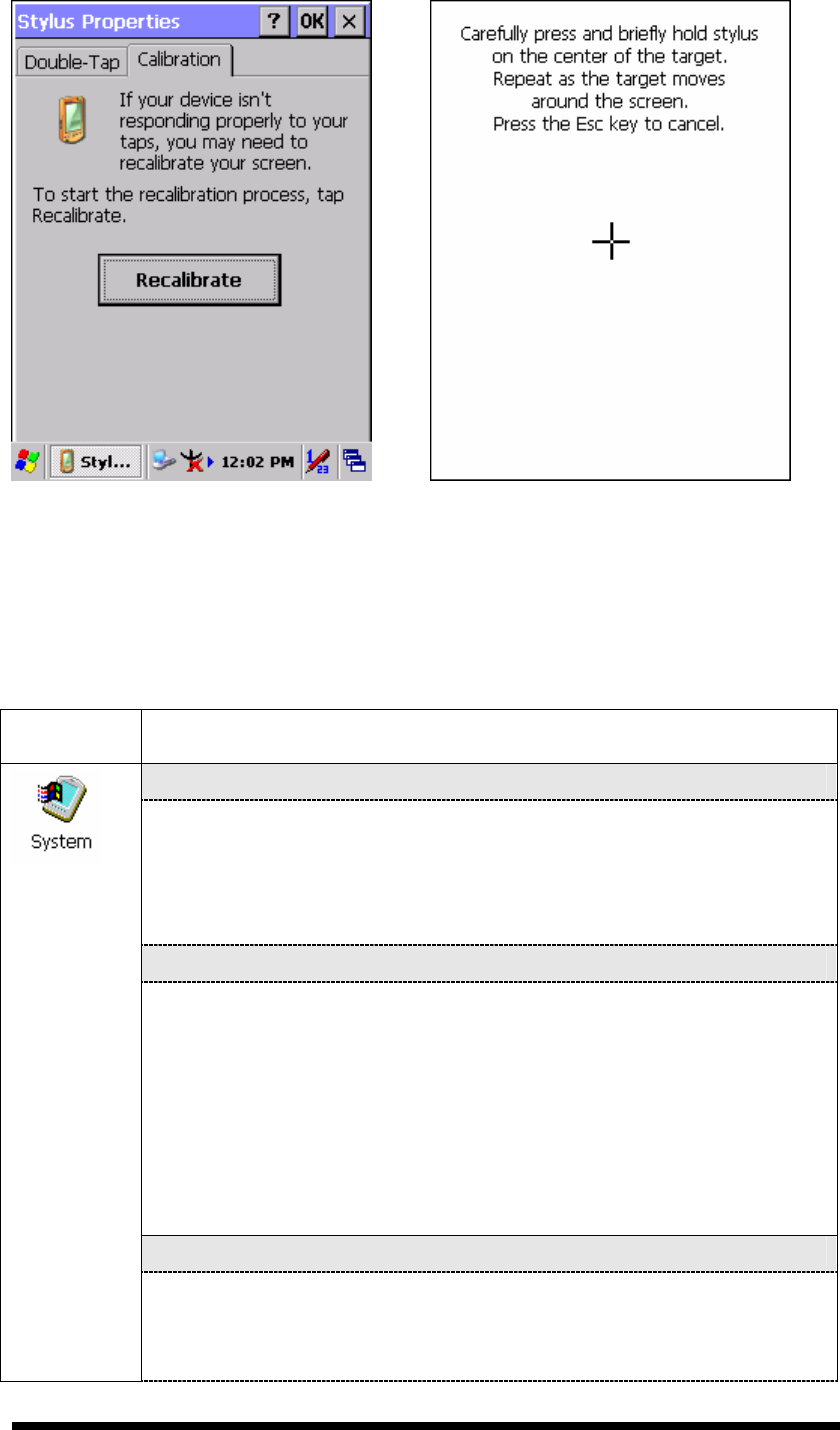
3-53
Figure 3-86 Stylus Properties Figure 3-87 Stylus Properties
3.2.21 System
Table 3-43 System
ICON
ITEM & FUNCTION
“General” Tab : (Figure 3-88)
To show:
Firmware information
Information about Processor type, Memory size, Expansion
card
“
Memory”: (Figure 3-89)
Move the slider to adjust memory allocation. Default storage
memory is normally is normally set to about 8MB with the
reminder assigned to Program memory.
Press the “OK” key on the Keypad.
Note: the difference is occupied by OS between the RAM size in
Information properties and total memory size of storage memory
and program memory
“Device Name” Tab : (Figure 3-90)
Your device uses this information to identify itself to other
computers.
The input panel will open to facilitate data entry.
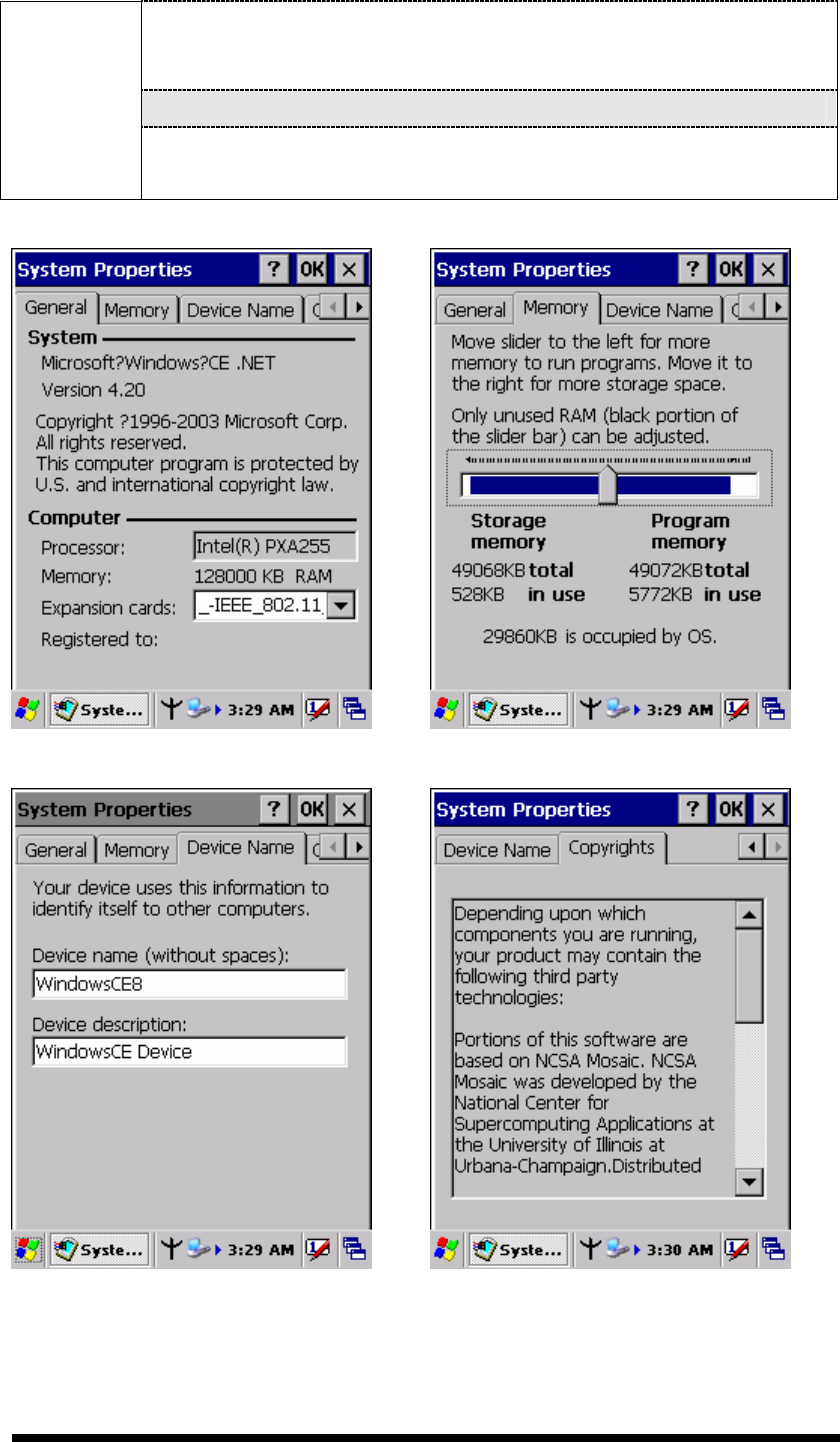
3-54
To close the Device Name, press the “OK” button, or press the
<Enter> key on keypad.
“
Copyrights” Tab: (Figure3-91)
Refer to this tab for specific copyright data. As a user, you are
responsible to read this statement.
Figure 3-88 System Properties Figure 3-89 System Properties
Figure 3-90 System Properties Figure 3-91 System Properties
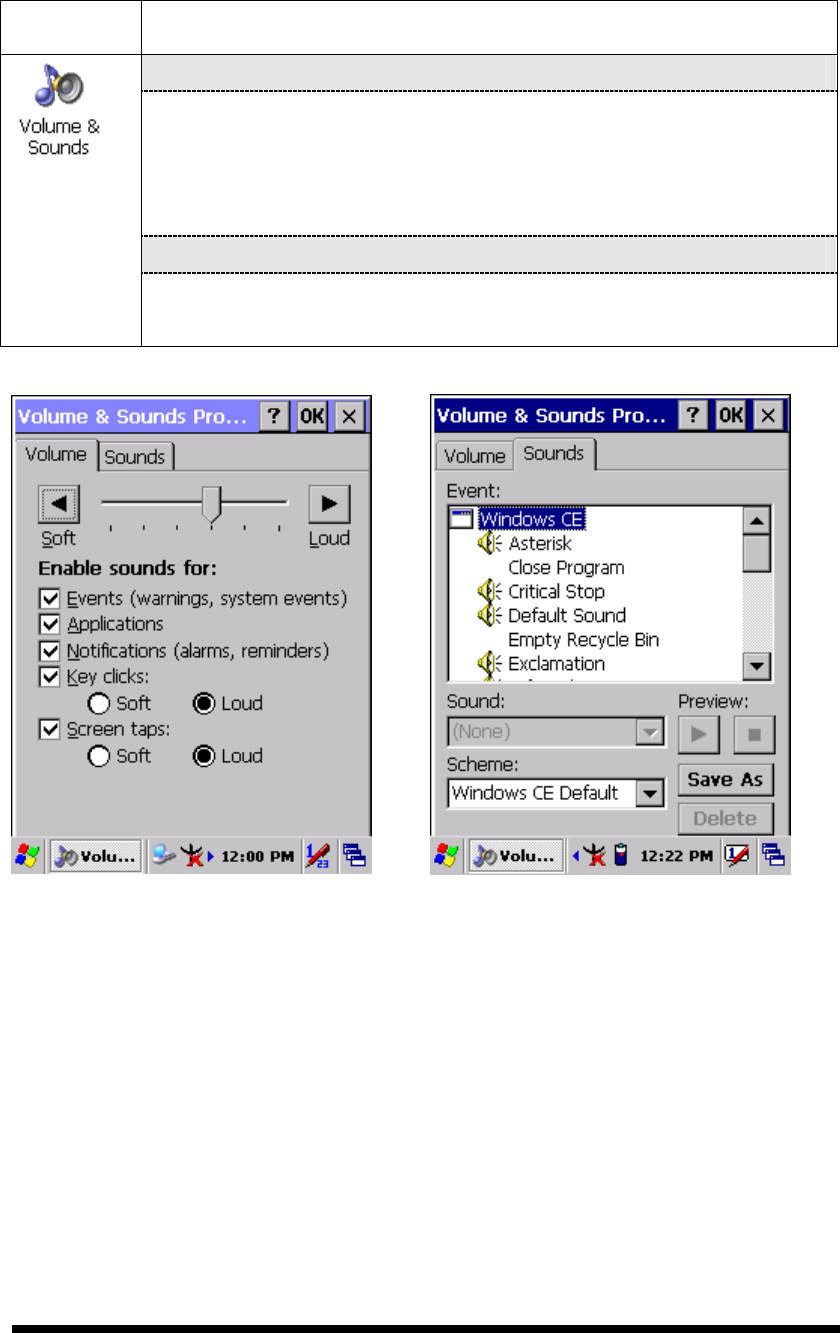
3-55
3.2.22 Volume & Sounds Properties
Table 3-44 Volume & Sound
ICON
ITEM & FUNCTION
“Volume” Tab : (Figure 3-92)
The factory default for Volume is the forth level. You can adjust
the volume to your environment and comfort.
Set the volume by adjusting the slider from Soft to Loud,
or press Right or Left edge of Navigation keys
“
Sounds ” Tab: (Figure3-93)
Enable the desired sounds for key clicks, screen taps,
notifications, and applications.
Figure 3-92 Volume & Sound Figure 3-93 Volume & Sound

3-56
3.3 Taskbar and Start Menu
Table 3-45 Taskbar and Start menu
ICON
ITEM & FUNCTION
“General” Tab :
In this tab, You can change the position of the Taskbar and Start
menu
Is always on top or not
Auto hide or not
Show Clock or not
“
Advanced ” Tab:
Taskbar and
Start Menu
Tap the “Clear” button to remove the contents of the Documents
Menu.
Enable “□
□□
□ Expand Control Panel”
””
” to list all icons of
Control Panel from top to bottom.

4-1
Chapter 4. Communication
4.1 Installing & Setting Up Microsoft ActiveSync
4.1.1 Installing Microsoft ActiveSync on the Host PC
Microsoft ActiveSync is a file transfer tool to synchronize the files on a PC with the
files on your PDT.
To install Microsoft ActiveSync, complete the following steps on the PC:
1. Go to the Microsoft Windows CE.NET website and download the latest current
version of ActiveSync:
http://www.microsoft.com/mobile/pockeypc/downloads/ .
2. Install the latest version of Microsoft ActiveSync on the host PC.
3. Open ActiveSync.
4. Select File > Communication Settings from AtiveSync’s menu bar.
5. Go to “Using ActiveSync” on page 4-1 to continue using ActiveSync.
4.1.2 Connecting PDT to Host PC
1. You can use either the USB/Serial (RS232) port of Single Dock or a USB/Serial
(RS232) cable to connect the PDT to the Host PC.
To use the dock, you must first insert the PDT into the slot, making sure that the
unit is firmly seated the dock.
To use the cable, connect the USB/Serial cable to the PDT.
2. Connect the USB/Serial dock or cable to the Host PC’s serial port or USB port.
3. Connect the dock or PDT to the power adapter and power source.
4.2 Using ActiveSync
Use ActiveSync to transfer and synchronize files between the PDT and the Host PC.
4.2.1 Setting up a Partnership
During the Microsoft ActiveSync installation, you were prompted to create a
partnership with your mobile device. When you set up a partnership, you select
synchronization and file conversation settings, which are contained in a file on your
desktop computer. This file enables your desktop computer to recognize your device.
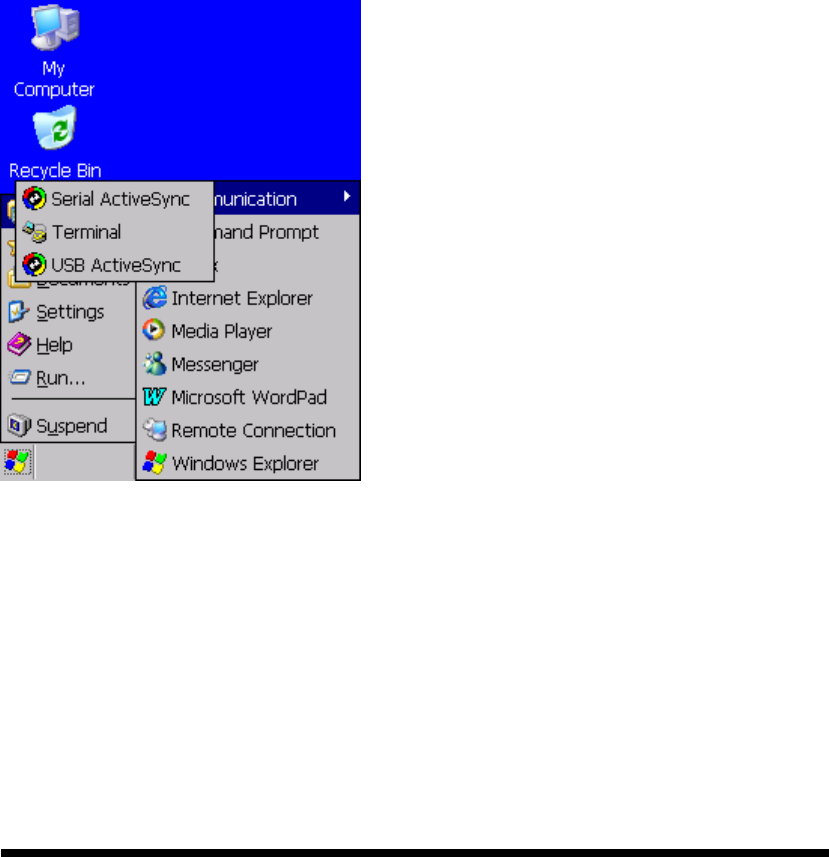
4-2
Only devices that have a partnership with a desktop computer can synchronize
information between the two computers.
For more information on partnerships, please refer to your Microsoft ActiveSync
documentation or help file.
Transferring Files:
To transfer files, complete the following steps on the host PC:
Select Start> Programs >Communication > (Serial, or USB) Activesync.
Double-click on the selected ActiveSync icon
After you have established a connection with PDT, tap the “Explore” button at
the top of the ActiveSync window (or select Explore from the File menu).
Navigate to the target directory on your PDT and copy the desired file by using
the Copy/paste method or dragging and dropping the desired file(s) into the
folder.
Figure 4-1 Communication
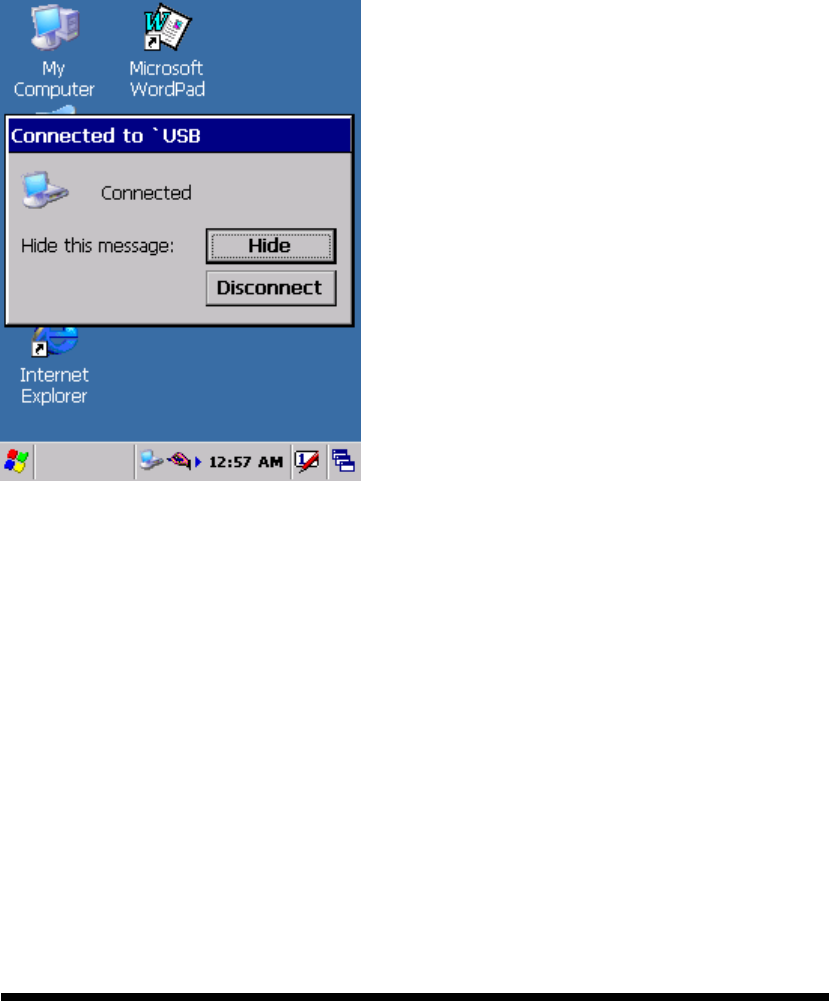
4-3
4.2.2 ActiveSync File Synchronization
ActiveSync files synchronization requires an ActiveSync partnership between the
PDT and the Host PC. Refer to “Setting up a Partnership”, above:
Select the files in the synchronization configuration for the PDT partnership.
Select Tools > Options from the ActiveSync command bar to configure the
synchronization options.
Place the file to be synchronized in the Synchronization folder created you’re
My Documents directory. Defaults to the desktop. During the ActiveSync
connection, all files in the Synchronization folder will be synchronized to the
\My Documents directory on the PDT.
Figure 4-2 Connected
4.3 Networking
Please see the 3.2.14 Owner, Table 3-33 Owner on page 3-45 for setting up the
network ID. And see the 2.5.6 Setting Up Wireless LAN RF to setup the 802.11b
Wireless LAN for RF connecting.

5-1
Chapter 5. Software Applications
5.1 Introduction
The PDT includes Calculator, Inbox,…..
You can switch to any software program by tapping the Start Menu.
5.2 Software Applications
5.2.1 Calculator
It can process the basic numeric calculation with “+”, “-“ “*” and “/“.
Procedure:
Tap numeric number
Tap one operator “+”, “-“, “*” or “/”
Then, tap another numeric number
Tap another operator or numeric number if needed
Tap “=” to get result
Button Function:
“MC” – Clear memory
“MS” – Store the displayed numeric number to memory
“MR” – Read the newest stored numeric number
“M+” – Add stored numeric number into the displayed numeric number.
“Backspace” – Same as “ backspace” key
“CE” –
Clear current keying numeric number. Same as “ Delete” key
“C” – Clear the current calculation. Same as “ESC” key.
5.2.2 Inbox
Use Inbox to send and receive e-mail messages in the following ways:
Synchronize e-mail messages with Microsoft Exchange or Outlook on the
Host Computer.
Send and receive e-mail messages by connecting directly to an e-mail server
through an Internet server provider (ISP) or a network.

5-2
To setup “Inbox”:
Select Start> Programs> Inbox to open it.
Select Service> Options from the command bar. Drag the dialog to show the
right edge to configure e-mail.
Select “Add…” (Note 1)
In the “Service Type” list, select POP3 Mail or IMAP4 Mail. (POP3 is the
most common mail protocol for ISPs).Enter a unique name for e-mail service
in the “Service name” field. This name cannot be changed later.
Select “OK”.
The Mail Service Setup wizard appears after you add a service. If you are
adjusting the setting of an existing service, select Service> Options, select the
service you are using, and then Properties. In the Service Definition dialog
box, complete the following entries as needed:
Connection: Select the name of the connection you created to connect to
the mail server. If you are receiving e-mail through a network(Ethernet)
connection, select Network Connection. If you want Inbox to use your
current connection, select (none). If you have not created a connection,
select Create new connection. Double-tap the “Make new Connection”
icon, and follow the instructions in wizard. When finished, select Inbox
in the Taskbar and continue setting up Inbox.
POP3 Host(POP3 only): Enter the name of the mail server you use to
receive and send messages.
Server(IMPA4 only): Enter the name of he mail server you use to
receive and send messages.
User ID: Enter the user name or mailbox ID assigned to you.
Password: Enter the password you use to access this mail account. If
you do not want to be prompted to enter the password each time you
connect, select “Save password”.
Domain(Windows NT): Enter your Windows NT domain name. This
name is required only when connecting to networks, such as a corporate
network, that use Windows NT domain security. This is not required for
most ISP accounts. If you have trouble connecting, try clearing this box.
SMTP Host: If your mail service uses a separate server for SMTP, enter
the name in the box. If you’re setting up a POP3 Mail service with an
ISP, the ISP must use an SMTP mail gateway.
Return Address: By default, the return address is set to
username@POP3host or username@Servername. Depending on the
service you are using. If this is not your e-mail address, enter the correct

5-3
address in the box.
Set general preferences:
If you are adjusting the setting of an existing service, select Service> Options,
select the service you are using, select Properties, and then select Next. In the
General Preferences dialog box, choose any of the following setting settings, all
of which are optional:
Disconnect service after actions are performed: Select to automatically
disconnect from the server upon completion of all pending actions. This
option minimizes connect time and cost.
Check for new messages every: select the time interval(in minutes) at
which you want the device to check for new mail. If this option is turned off,
you must check for new mail manually by selecting Services>
Send/Receive Mail.
Display a message box when new mail arrives (POP3 only): Select to be
informed that new mail has arrived.
Display a message box when new mail arrives (IMAP4 only): Select to be
informed that new mail has arrived.
Send using MIME format (POP3 only): Select to send messages with
extended characters.
Only display messages from last 3 days: Select how many day’s messages
you want downloaded.
Set inbox preferences
If you are adjusting the settings of an existing service, select Services> Options,
select the service you are using, select Properties, and then select New twice. In
the Inbox Preferences dialog box, choose any of the following options:
Get message headers only: Select to save storage space and time by
downloading only headers. You can download a full copy of the message
later by selecting the message and then Services> Get Full Copy.
Include <number> lines: Select to set the message length (approximate
number of lines) that you want to download.
Get Full Copy of messages: Select to receive a full copy of all messages. In
addition to the message body, any options you select in When getting full
copy will be downloaded. Selecting this option increases the amount of time
needed to download messages.
Only synchronize folder hierarchy under Inbox (IMAP4 only): Select to
speed download time by preventing the complete downloaded of the folder
list every time you connect.
Get meeting requests (POP3 only): Select to download and store copies of

5-4
meeting requests when getting full copies of messages. This setting applies
whether you have chosen to download full copies of messages by default, or
you selectively download full copies of messages by opening the message
and selecting Services> Get Full Copy Limitations apply.
Get file attachments (POP3 only): Select to download and save message
attachments when getting full copies of messages. This option may use
significant RAM and slow download time. This setting applies whether you
have chosen to download full copies of messages by default, or if you
selectively download full copies of messages and selecting Services> Get
Full Copy.
Get file attachments and meeting requests (IMAP4 only): Select to
download and store meeting requests and message attachments when getting
full copies of messages. This setting applies you have chosen to download
full copies of messages by default, or if you selectively download full
copies of messages by opening the message and selecting Services> Get
Full Copy Limitations apply.
Only if small than (IMAP4 only):
Select to restrict the size of the attachments
you download. Set to 10K if you want to receive meeting requests only.
Include the original message in a reply:
Select Services> Options> Compose tab.
Under Reply, select Include Body. This setting will place a copy of the
original message beneath your response text.
To indent the original message, select Indent.
To add leading characters (such as>) to the original message lines, select
Add leading character, and enter the character you want.
Save copies of sent messages:
By default, sent messages are not saved on your device.
Select Services> Options> Compose tab.
Select Keep copy of sent mail in Sent folder.
Set the action to follow deleting, moving, or responding to a message:
Select Services> Options > Read tab.
Select desired options.
Delete a message:
Select the message and select File> Delete. Messages are moved to Deleted
(local) folder and deleted according to the option you have selected in Services>
Options> Delete tab:
On connect/disconnect: Deletes messages when you connect or disconnect

5-5
from your mail service or exit Inbox.
Immediately: Deletes messages as soon as you select File> Delete.
Manual:
Deletes messages when you select File> Empty Deleted (local)
Note: If you are working offline, messages that have been deleted from the device the
next time you connect.
Empty the Deleted (local) folder:
Select File> Empty Deleted (local). This permanently deletes messages in
the Deleted (local) folder.
To check or adjust the current settings for deleting messages, select
Services> Options> Delete tab.
Move or copy a message:
Caution: When you move a message that you have received through POP3 or
synchronization to a folder you created on your device, the copy of the message on
the server is deleted. This prevents duplicate copies of messages. Although the
complete message is moved, message attachments will be deleted if you have not
selected the option to download attachments. Once the message is moved, you will be
able to access the message only from your device.
Select the message
Select File> Move To or File> Copy To.
Select the destination folder. If you are working offline, the message will be
moved or copied from the server the next time you connect.
Folder-
Create a folder:
Select File> Folder> New Folder
Type a name for the folder.
Delete a folder:
Select the folder you want to delete
Select File> Delete
Designate a folder as offline:
Only IMAP4 folders can be designated as offline. All IMAP4 default folders,
such as Inbox, are automatically designated as offline. Messages in offline
folders can be viewed when you are disconnected from your mail server. If a
folder is not designated as offline, you will be able to read and respond to
messages in that folder only when connected to the server.
To designate a folder as offline, select the folder and then select Service >
Offline Folder.

5-6
Rename a folder:
Select the folder you want to rename.
Select File> Folder> Rename Folder.
Type the new name for the folder.
Notes:
Default folders, such as Inbox, can’t be renamed.
Folders you create for IMAP4 mail servers can’t be renamed.
Synchronize folders while connected:
When you synchronize folders, the contents of your device folders and mail
server folders are compared and updated. New mail messages are downloaded,
and messages in your device Outbox folder are sent. The synchronization
behavior depends on how you connect to your mail server.
When you connect to a POP3 server, the Inbox and Outbox folders on
your device are synchronized with the corresponding folders on the mail
server. To synchronize after the initial connection, select Services>
Send/Receive Mail.
When you connect to an IMAP4 server, Inbox, Outbox, and all folders
marked as offline are synchronized. To synchronize all folders after the
initial connection, select Services> Synchronize Folders. To
synchronize just the selected folder and the Outbox folder, select
Services> Send/Receive Mail.
Compose and send a message:
In list view, select Compose> New Message
Enter the address of one or more recipients, separating them with a
semicolon. If the recipient is listed in the Address Book, enter a few
letters of the recipient’s name and select Compose> Check Name. If
there is only one match, the e-mail address is inserted. If there is more
than one match, select the correct address from the Choose E-mail
Recipients dialog box. If there is no match then add a new e-mail address
through Choose E-mail Recipients.
To attach a file, select File> attachments> Add Attachment.
Select File> Send. If you are working offline, the message is moved to
the Outbox folder and will be sent the next time you connect.
Tip: to see more header information, select the triangle in the lower-right corner of
the header area. Select the triangle again to collapse the header area.
Save a message:
Select File> Save to save the message you are composing or editing.

5-7
The message is not sent and is saved in the inbox folder of the active service.
Reply to or forward a message:
Open the message, and then select Compose> Reply to Sender, Reply to
All, or Forward.
Enter your response.
Select File> Send.
Tips:
Selections in the Options dialog box determine whether the original text is
included.
To see more header information, select the inverted triangle in the lower-right
corner of the header area. Select the triangle again to collapse the header area.
Check Inbox status:
In list view, select Compose> Status. You can view details such as the
number of messages to be sent, deleted, and copied, and the number of
attachments to be downloaded.
Download message from the server:
When you download messages, you need to create two connections: a remote
connection and a mail server connection. The remote connection connects you
and your ISP or network. The mail server connection downloads messages from
your mail server to Inbox on your device. When you select Services> Connect in
Inbox, Inbox starts a remote connection using the connection you specified when
setting up the current mail service. If you are already connected through a remote
connection other than the one you specified in the service, you will be asked if
you want to use the current connection. If you choose not to, you will need to
disconnect from the current connection before you can check for new messages.
Select the Services menu and make sure that the service you want to use
is selected (the selected service has a bullet next to it.)
Select Services> Connect. The messages on your device and mail
server are synchronized: new messages are downloaded to the device
Inbox folder, messages in the device Outbox folder are sent, and
messages that have been deleted on the server are removed from the
device Inbox. Double-tap a message list to open it.
If you read a message and decide that you need the full copy, select
File> Get Full Copy while in the message window or Services> Get
Full Copy while in list view. This will also download message
attachments and meeting requests if you have those options selected in
the Inbox Preferences dialog box. You can also choose to download

5-8
full copies of messages by default.
When finished, select Services> Connect to disconnect. You also need
to disconnect your dial-up connection by double-tapping the icon in the
status bar and selecting Disconnect.
Notes:
Receiving entire messages consumes storage memory.
The size column in the Inbox list view displays the local size and server size of
a message. Even when a message has been downloaded fully, these numbers
may differ because the size of a message can very between the server and the
device.
When using IMAP4 to get Outlook + data, you will see the contents of your
Journal folder. File editing transactions and documents (such as Task items,
e-mail message, and Word documents) attached using drag and drop will appear
as shortcuts on the device. A copy of the document will not be moved to your
device, and the shortcut on the device cannot be used to access the documents
associated with a journal entry to the device, attach the document to the entry
rather than dragging and dropping it. Also, be sure to set your IMAP4 service to
receive full copies of messages, attachments, and meeting requests. For more
information on using Journal, see the Help for the desktop version of Outlook.
Working with Message Attachments:
If you receive messages through a remote mail server, in Inbox on the device,
select the Get file attachments and meeting requests (IMAP4) or Get
meeting requests (POP3) setting in the Inbox Preferences dialog box. For
more information, see Set Inbox preferences.
Notes:
Embedded images and OLE objects cannot be received as attachments
Embedded messages can be viewed as an attachment when using IMAP4 to
receive e-mail. However, this features does not work if TNEF is enabled so
that you can receive meeting requests.
Check attachments status:
An attachment sent with an e-mail message, whether it has been downloaded
or not, will appear as an icon at the bottom of the message in its own window
pane. If you don’t see this pane, select File> Attachments> Show
Attachments. If TNEF is turned on so you can receive meeting requests, you
will not see attachments until they are fully downloaded.
To mark an attachment for downloading in a POP3 or IMAP4 service,
double-click it. The attachment will be downloaded the next time you

5-9
connect. You can also set Inbox to download attachments automatically when
you get a full copy of a message. For more information, see Receive
attachments.
Open an attachment:
With the message open, double-tap the attachment’s icon at the bottom of the
message. If you don’t see this pane, select File> Attachments> Show
Attachments.
Store an attachment:
Select Service> Options> Storage tab.
Select to store attachments on internal RAM or a storage card.
If you use more than one storage card, select it from the list.
Note: Once you make the above selection, all attachments will be moved to the
selected card.
Delete an attachment:
To delete an attachment from a message you are sending, select the
attachment, and then select Edit> Clear or press the DEL key on the
keypad.
To delete an attachment you have received, delete the message.
Attach a file to a message:
With the message open, select File> Attachments> Add Attachment.
Select the file you want to attach.
Note:
OLE objects cannot be attached to Inbox messages.
Note 1: To add a mail service, select “Add”, To remove a mail service, select the
service from the Installed service box and select “Remove”. To view a mail service’s
properties, select the service from the Installed service box and then select
Properties.
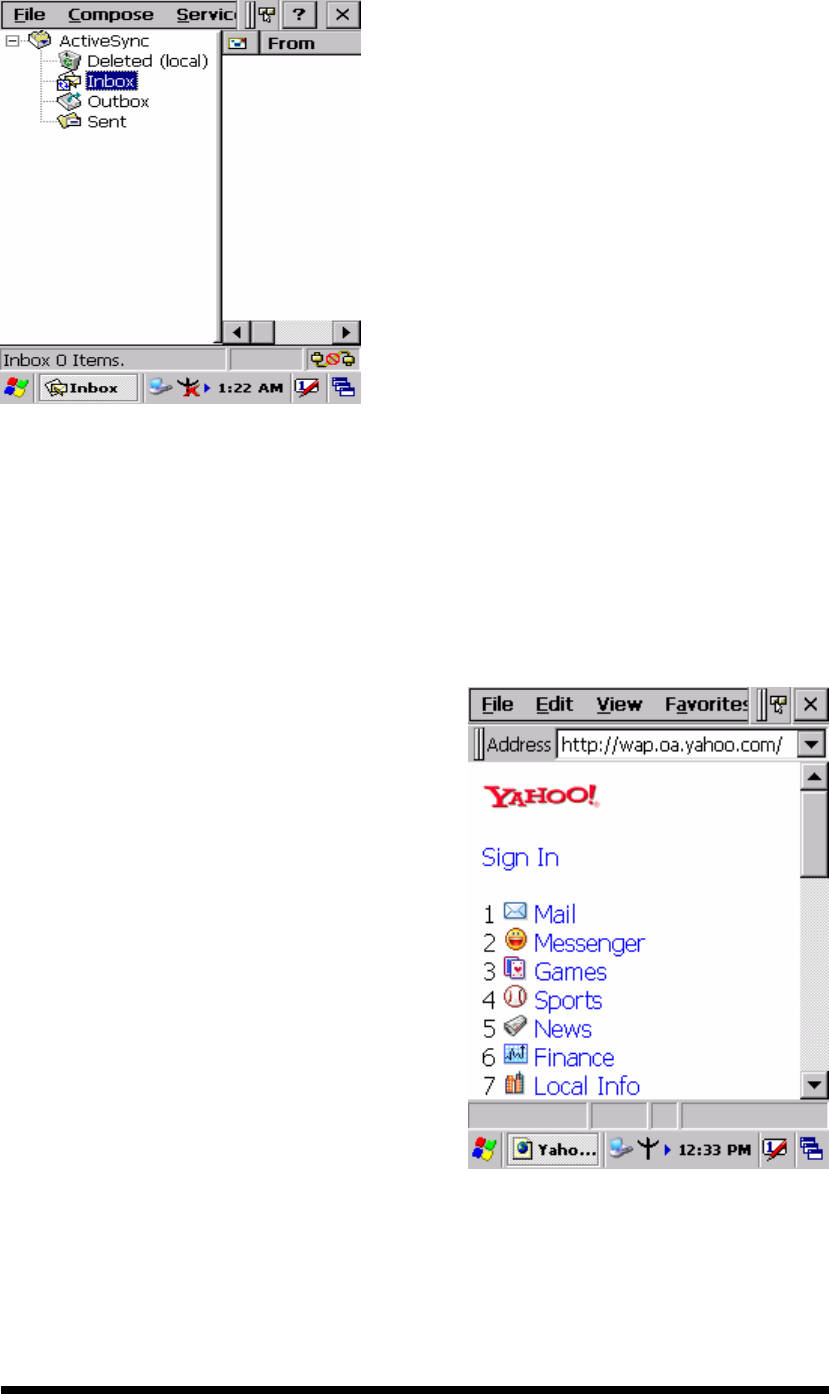
5-10
Figure 5-1 Inbox
5.2.3 Internet Explorer
With Internet Explorer, you can view Web or intranet Web pages on your device. You
will need to use a modem or WLAN to connect to an Internet server provider (ISP) or
network.
5.2.3.1 Connect to the Internet
Before you can view Web pages, you must
set up a remote connection to your ISP or
network.
5.2.3.2 Start Internet Explorer
Open Internet Explorer by selecting Start
> Programs > Internet Explorer.
To get default home page, navigate to the
desired default web page.
Select View > Internet Options from the
command bar.
Enter the desired URL in the Start page
field.
Press the OK button.
Figure 5-2 Internet Explorer
5.2.3.3 Navigation Control
Internet Explorer uses sliding menus for application and navigation control. Tap and
drag the sliding menus to the left or right to see the hidden menu items and toolbars.

5-11
To achieve more screen real estate in Internet Explorer, you can hide the Status bar
and View menu. From the top menubar, go to View > Hide Toolbars.
Once it is hidden, you must cold reset to access these features again. Refer to 2.7.2
“Cold Reset “for more information.
5.2.3.4 Set up a proxy server
Proxy servers are often used when connecting to the Internet through a local network,
such as a corporate network, for added security.
Select View > Internet Options > Connection Tab.
Select Access the Internet using a proxy server.
Enter the proxy server address and port. For more information, see your
administrator.
To bypass the proxy server for local address, such as corporate intranet pages,
select Bypass proxy for local address.
5.2.3.5 Enable Cookies
A cookie file contains information about your identity and preferences so that a
Web site can tailor information to your needs. The Web site sends the file and it
is stored on your mobile device.
Select View > Internet Options > Security Tab.
Select Allow cookies.
5.2.3.6 Search for an Internet Site
Select View > Go > Search to search the web.
5.2.3.7 Go to an Internet address
Select Address Bar, if necessary to display the Address bar
Enter the address
Press “ENTER” key.
5.2.3.8 View previously visited sites
Tap the Arrow button at the right site of Address Bar
Select the Web Address you want to view.
5.2.3.9 Add and view Favorites
Go to the page you want add
Select Favorites > Add To Favorites.
If necessary, locate the folder you want.
Confirm or change the name.

5-12
To view your favorite Web sites, select Favorites and the Web site you
want to view.
Note:
To organize your Favorites list, select Favorites > Organize Favorites.
5.2.3.10 Browse Web pages
To move to a page you have previously view, select View > Back
To move to the next page (provided you have viewed it previously), Select
View > Forward.
To return to your Home page, select View > Go > Home.
5.2.3.11 Refresh current page
Select View > Refresh.
5.2.3.12 Stop loading a page
Select View > Stop.
5.2.3.13 View current page
Select View > Internet Options
To view the protocol, page type, size, and address, selects the General tab.
To view security information about the page, select the Security tab.
5.2.3.14 View HTML source code
While viewing the page, select File > Save As and save the file as .txt file.
Open the file in a word processing program, such as WordPad.
5.2.3.15 Change home and search page settings
Open the page you want to use as your home or search page.
Select View > Go > Home or Search.
5.2.3.16 Save a copy of current page
You can save Web pages and view them later when you’re disconnected from the
Internet or Intranet without using cached memory.
Select File > Save As
Specify a folder location and give the file name.
5.2.3.17 Copy a Web page to a document
Select all or part of the Web page you want to copy.
Select Edit > Copy.
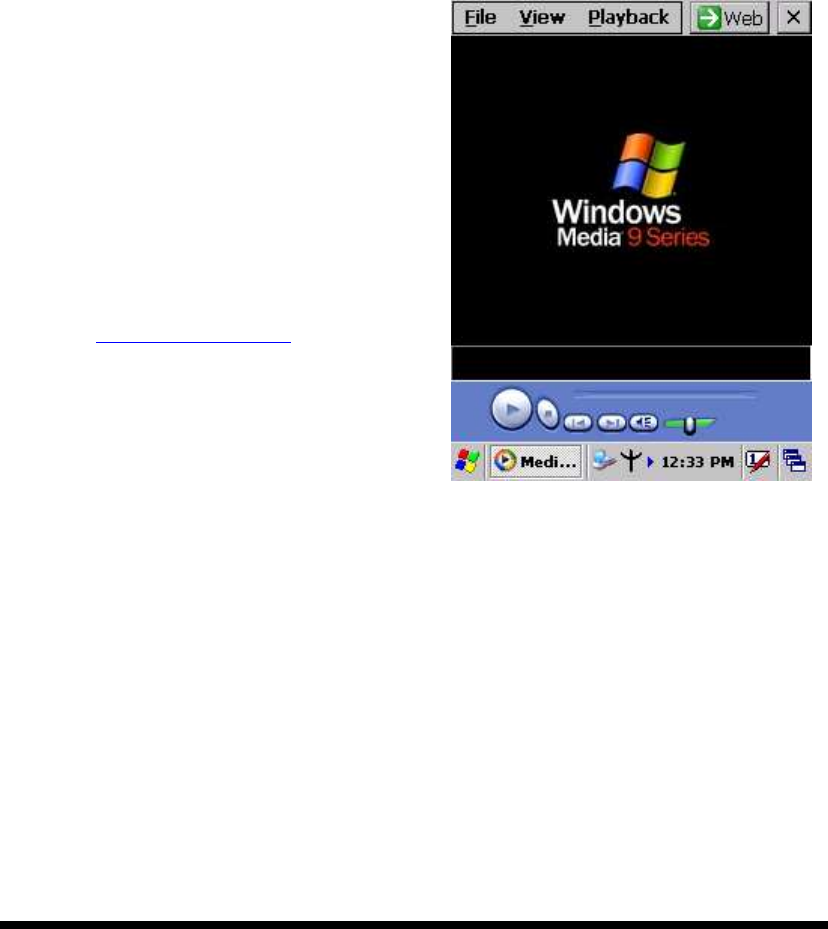
5-13
Go to the document where you want to place the information and select the
location.
Select Edit > Paste.
5.2.3.18 Select security Options
Select View > Internet Options > Security tab
Select the security protocols you want.
5.2.3.19 Change the font size
Select View > Text Size and select the desired size.
5.2.4 Media Player
The PDT comes with Media Player for
Windows CE.NET installed.
Open Media Player by selecting
Start > Programs > Media
Player from the desktop.
Select File > Open to open a new
media file.
Please refer to
www.microsoft.com for additional
information and help with your
Microsoft Windows Media Player.
Figure 5-3 Media Player
5.2.5 Messenger
The Windows CE Messenger client application in Windows CE.NET allows you
to communicate real-time using text-based messaging, VOIP, and more.
See who’s online. See when your colleagues are online. You can also post
your presence information to a list of watchers that you define.
Talk instead of type Stop typing Talk with a colleague anywhere in the
world using the microphone and speakers on your device. Windows
Messenger supports high-quality voice calling r Windows CE device.
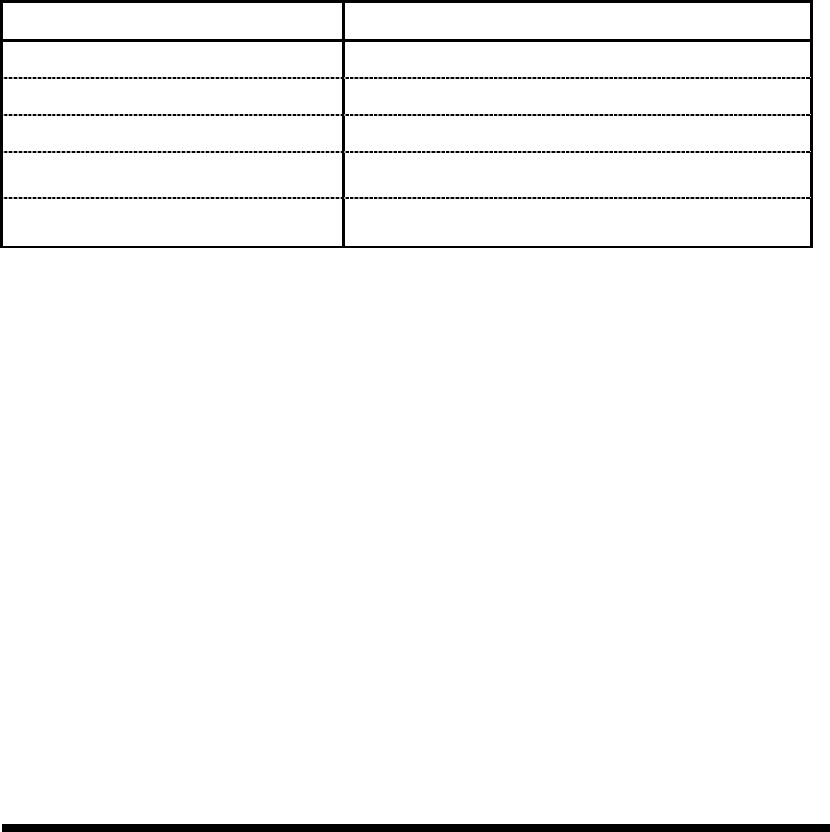
5-14
Communicate using Session Initiation Protocol (SIP) or Hotmail contacts
Windows Messenger supports. Communication with your colleagues in the
enterprise with a SIP based communications service. You can also talk to
your Hotmail contacts using the .NET Messenger.
5.2.6 Microsoft WordPad
You can create and edit documents and templates in WordPad, using buttons and
menu commands that are similar to those used in the desktop version of
Microsoft Word. You can work with files Normal or Outline view.
WordPad documents are usually saved as .pwd files, but you can also save
documents in other file formats, such as .rtf or .doc.
5.2.6.1 Selecting and Editing Text
Select text
To select Do this
Any amount of text Drag the stylus over the text.
A word Double-tap the word.
A single paragraph Triple-tap within the paragraph.
An entire document Select Edit > Select All
An picture Tap the picture
Find text
To search for text in one part of a document, select that part. Otherwise, the
whole document is searched.
Select Edit > Find
Enter the text you want to find. For a paragraph, enter ^p. For a tab stop,
enter ^t.
Select the search options you want.
To continue searching, select Edit > Find > Next.
Replace text
To replace text in one part of document, select that part. Otherwise, the
whole document is searched.
Select Edit > Replace.
Enter the text you want to find and the text you want to replace it with. For

5-15
a paragraph, enter ^p. For a tab stop, enter ^t.
Select the replacement options you want.
Select Find Next.
On the Find/Replace toolbar, select the appropriate button.
Move, copy, or delete text
Select the text you want to move, copy, or delete.
To move or delete text, select the Cut button. To copy the text, select the
Copy button.
To paste the information, move the insertion point to the desired location,
and select the Paste button.
Notes:
To undo an action, select Edit > Undo.
To restore the action, select Edit > Redo.
5.2.6.2 Formatting Text
Create bulleted and numbered lists
Select the Bullets or Numbering button.
Type the first item.
Press ENTER, type the next item, and repeat as needed.
Select the button again to end list formatting.
Note: To change the number style for the selected list, select Format > Paragraph,
In the Format list, select the style you want.
Set the default font
Select Format > Font.
Select the font you want.
Select Set As Default
To confirm that your changes will be applied to subsequent documents you
create, select Yes.
Note: To apply the default font and stylus to selected text, select Apply Default.
Select a different font
Select the text you want to change. To select all text, select Edit > Select All.
From the Font list, select the font you want.
From the Font Size list, select a size.
Note: To see more formatting options, select Format > Font.
Change font formatting

5-16
Select desired text.
Select the Bold, Italic, or Underline button.
To change the color, select Format > Font and select the color you want from
the Color list.
Adjust the paragraph alignment
Select the paragraph you want to align.
Select the Align Left, Center, or Align Right button.
Note: To see more formatting options, select Format > Paragraph.
Indent a paragraph
Select the paragraph you want to indent.
Select Format > paragraph.
Adjust the indentation settings as needed.
Set tabs
Select Format > Tabs.
Change the tab settings as needed.
5.2.6.3 Adjusting the Display
Wrap text in the window
Select View > Wrap to Window.
Display the document using the full screen
Select View > Full Screen.
To exit Full Screen view, select Restore.
To move the Restore button, drag the bar on the left side.
Display or hide scroll bars
Select View > Horizontal Scroll Bar or Vertical Scroll Bar.
Zoom in or out
Select View > Zoom, and select the desired percentage.
Note: For Custom, enter the exact percentage and select OK.
5.2.6.4 Working in Outline View
Switch between Normal and Outline views
Select View > Normal or Outline.

5-17
Assign and change outline levels
Select View > Outline.
Select the appropriate buttons on the toolbar.
5.2.6.5 Inserting Symbols
Place the insertion point where you want to insert the symbol.
Select Tools > Insert Symbols.
Select the symbol you want, and then select Insert.
Tips:
If you select a different font ( or subset of a font), a different set of Symbols will
be displayed.
5.2.6.6 Printing a Document
Select File > Print.
Select the printing options you want.
Tips:
Port list the available printer ports
If Network is selected from the Port list, enter the path to the network
printer to the Net Path box.
5.2.6.7 Setting a password for a Document
Select File > password.
Type and verify the password.
You must save the document (File > Save) to return the password.
5.2.6.8 Converting Documents
About document conversion
If an e-mail program is installed on your device and you receive an attached
Word document or template created in Word version 6.0 or later, WordPad will
convert the file on your device. To view the document, simply open the
attachment in your e-mail program or open the file in the WordPad.
During conversion, some formatting attributes may be changed or lost. To avoid
losing these attributes permanently, close the file after viewing it rather saving
the file on your device. If you save the file, save with a different file name.
For more information about conversion performed on your device, see the
following topics.

5-18
Changes caused by Word document conversion
Formatting
Borders and Shading
Borders and shading are not displayed in WordPad, but are restored when
converted back to a Word document. Shading is not restored when used in a
table, but simple borders are restored.
Character formatting
Bold, italic, strikethrough, superscript, subscript, and hidden text are
retained and displayed. Other effects are changed or removed.
Colors
Colors are retained and mapped to colors available on your device.
Fonts and font sizes
Fonts not supported by your mobile device are mapped to the closest font
available in WordPad.
Page Formatting
Headers, footers, footnotes, columns, pages setup information, and style
sheets are removed during conversion to WordPad. WordPad supports
built-in headings.
Paragraph formatting
Tabs, alignment, bullets, indentation, simple numbered lists, and paragraph
spacing are retailed and displayed in WordPad.
Pictures
Pictures are removed during conversion.
Table of Contents
Table of Contents text and some formatting are preserved. However, any text set
at right-aligned tab stops may wrap to the next line.
Index
Index text and some formatting are preserved.
Tables
Tables appear as tab-delimited text. Cells containing wrapped text, tabs, or
paragraph markers may be difficult to read. Simple tables are displayed
accurately and restored when you convert the WordPad file back to a WordPad
document.
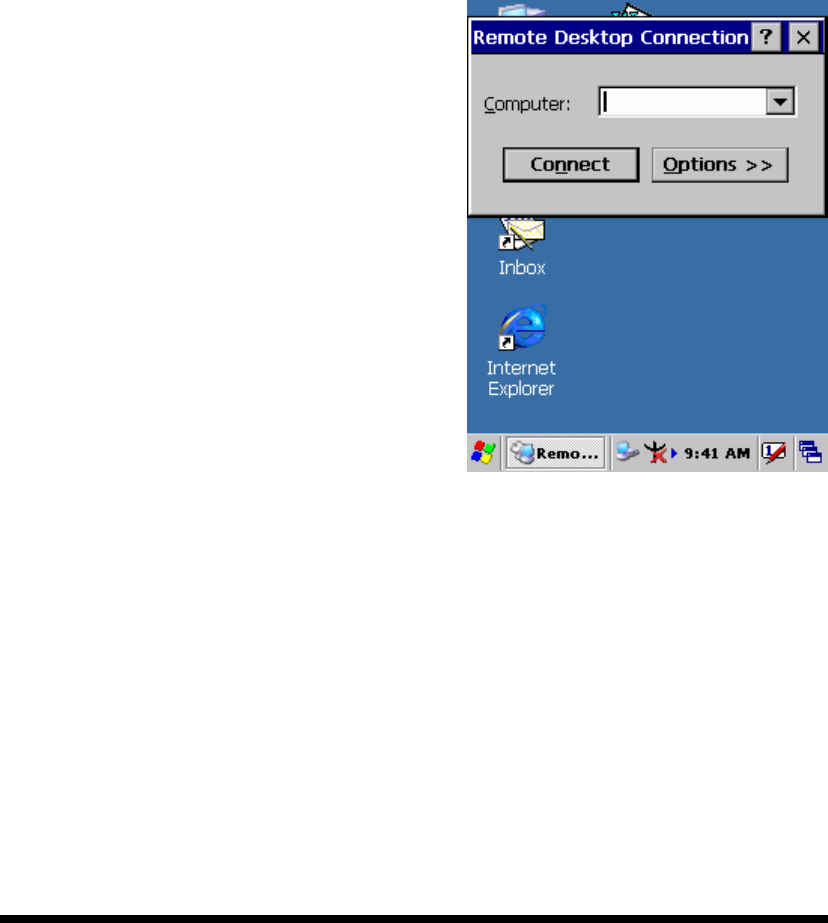
5-19
OLE Objects
OLE Objects are removed during conversion.
Revisions marks, annotations, and comments
Revision marks are visible but cannot be changed. Annotations and documents
are removed during conversion.
5.2.7 Remote Connection
Using Remote Desktop Connection, you can log on to Windows Terminal Server and
use all programs installed on this server. For example, instead of running Microsoft
Pocket Word, you can run the desktop version
of Microsoft Word.
5.2.7.1 Connecting to Terminal Server
Select Start > Programs > Remote
Connection, or run ‘CETSC’ from the
command prompt.
In the Server box, type or select a
Terminal Server name or TCP/IP address,
or select a server in the drop-down list.
Select Connect.
In the Remote Connection window, type
your user name, password, and domain(if
required), and then select OK.
Figure 5-4 Remote Connected
5.2.7.2 Disconnecting Without Ending a Session
In the Remote Connection window, select Start > Shutdown.
Select Disconnect > OK.
Note: If you previously disconnected from a Terminal Server without ending the
session, the Terminal Server will continue to execute any running processes and
Remote Connection can later reconnect to this same session(if your
administrator has configured Remote Connection to reconnect to disconnected
sessions).
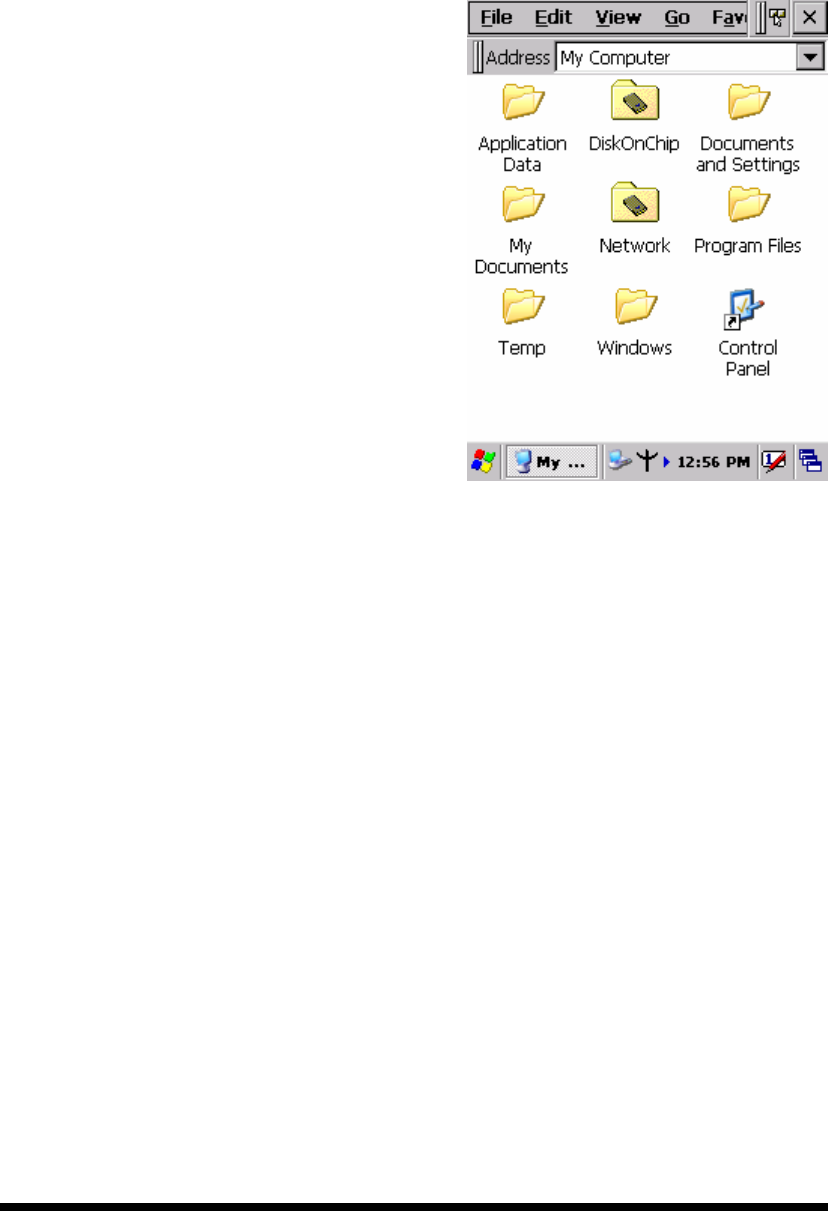
5-20
5.2.7.3 Disconnecting and Ending a Session
In the Remote Connection window, select Start > Shutdown.
Select Log Off > OK.
5.2.8 Windows Explorer
Windows Explorer works almost the same on
your PDT as it does on your PC. See the
topics below for information about the
difference in Windows Explorer on your
device.
5.2.8.1 Navigating in File View
Go forwards and Back
To go to the previous folder, select
Go > Back.
To go to the next folder (which you
have just viewed), select Go >
Forward.
Figure 5-5 Windows Explorer
Use the Go menu
To quickly access the My Documents folder, select Go > My Documents
To see all of the folders you have accessed, select Go > History.
Double-tap
a folder to return to it.
5.2.8.2 Viewing Files as Icons Lists
To view icons, select View > Large Icons or Small Icons.
To view a list, select View > Details.
5.2.8.3 Working with Files and Folders
Create a new folder
If necessary, open the folder where you want the new folder to reside.
Select File > New Folder.
Add a folder to your Favorites list
Open the folder
Select Favorites > Add to Favorites.
In the Name box, type the shortcut name.
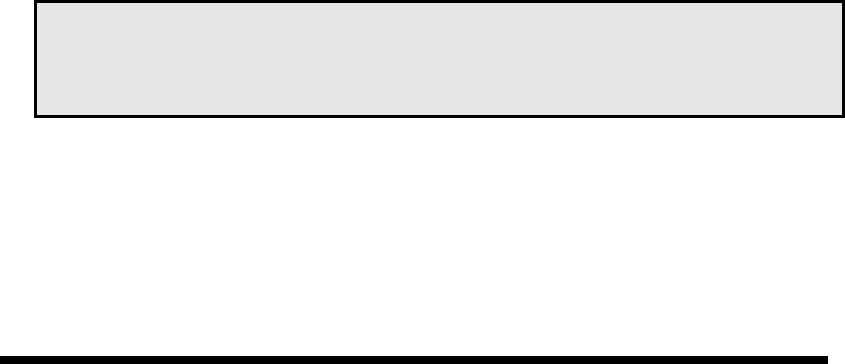
5-21
Tips:
To open a favorite file or folder, select Favorites and then select the folder.
To organize your favorites, select Favorites > Organize Favorites.
Transfer a file using infrared
To send a file, select it, line up the infrared ports, and select File > Send To
> Infrared Recipient.
To receive a file, line up the infrared ports, and select File > Receive.
5.2.8.4. Creating Desktop Shortcuts
Display the file or Web page for which you want to create a Shortcut.
Select File > Send to.
Select Desktop as Shortcut.
5.2.8.5 Switch to Internet
Type a URL in the Address bar.
5.3 DiskOnChip
The DiskOnChip let the application or a data file can be stored into the Flash
Memory.
Note: The DiskOnChip storage memory persists all reset (warm/cold reboot)
conditions and software/firmware updates.
We strongly recommends installing all applications, applets, programs, and
important data files to the DiskOnChip Flash location.
Caution:
If an application or a data file is only installed or saved in RAM, a hard
reset will result in the loss of that application or data file.
5.3.1 Saving to Flash
To save an application or data to the Flash Memory, from your current
application, select File > Save As > navigate to the DiskOnChip location and
save it.
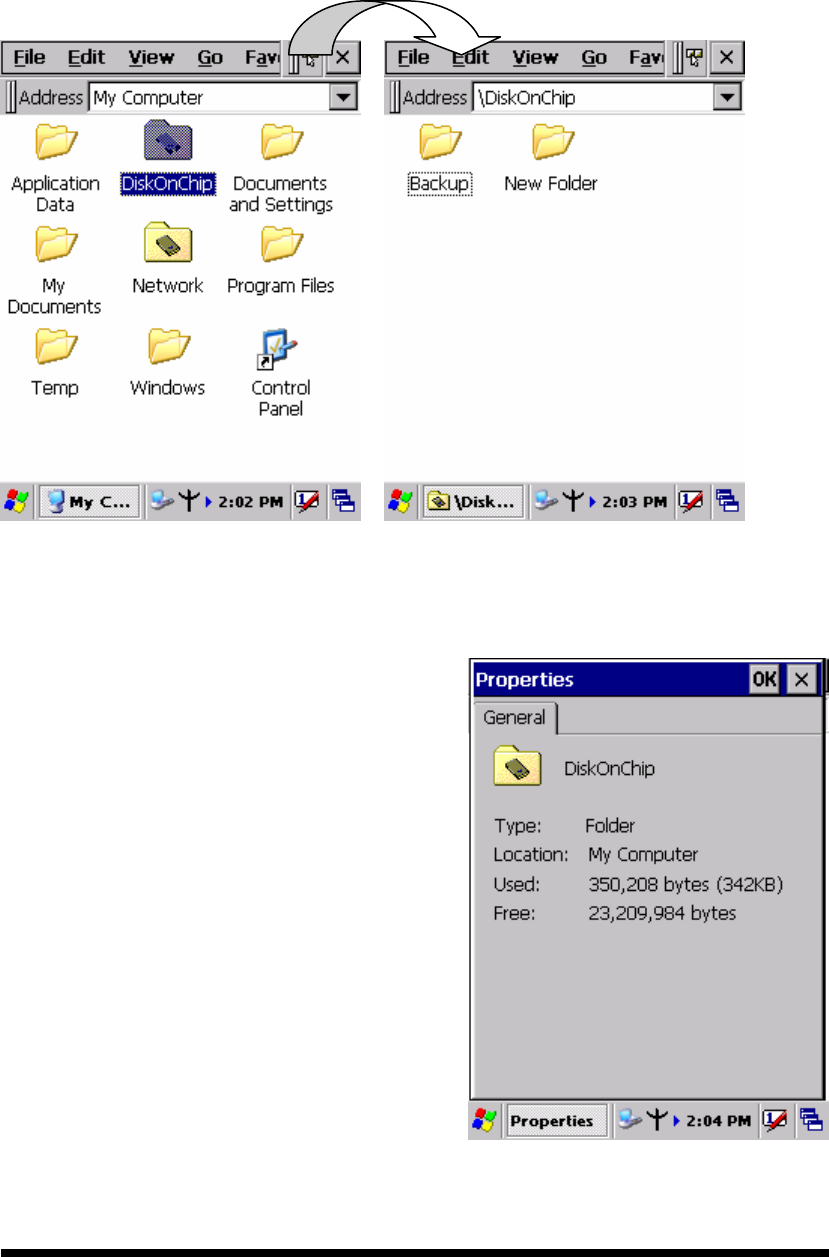
5-22
5.3.2 DiskOnChip Location
To access the contents of DiskOnChip storage:
Double-tap the My Computer icon on the desltop.
Double-tap the DiskOnChip icon to view DiskOnChip.
Figure 5-6 DiskOnChip
5.3.3 DiskOnChip Size
The size of the DiskOnChip will vary,
depending on the size of system
firmware.
Inside the DiskOnChip directory,
tap File > Properties.
The DiskOnChip Properties
dialog:
The number following Free is the
amount of memory currently available on
your device.
Figure 5-7 DiskOnChip Size
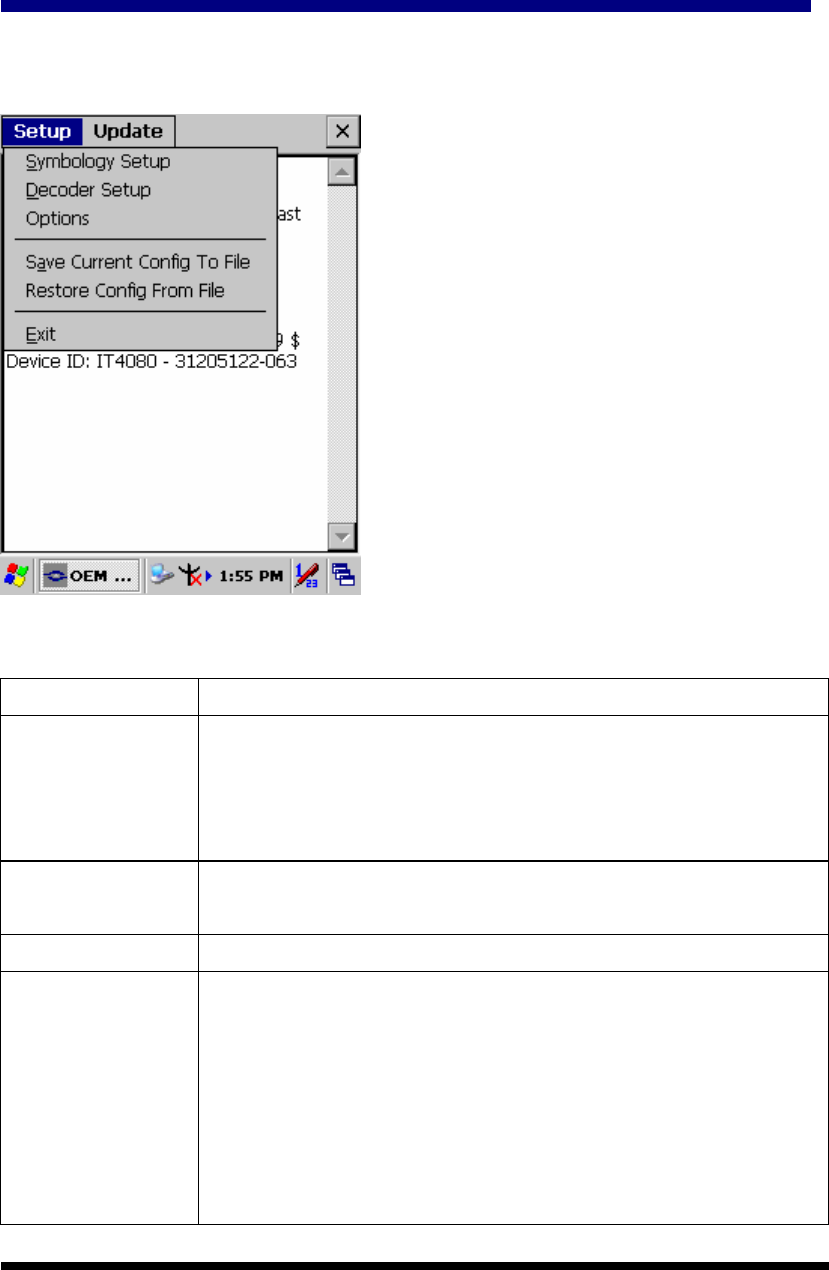
A-1
Appendix A 2D Barcode
Setting
A.1 Setup Tab
Function Explaining:
Item Function Explaining
Symbology
Setup
Selecting the Symbology Setup menu item causes the
symbology setup dialog to be displayed. This dialog consists
of a symbology drop down list, plus four buttons and a
message box.
Decoder Setup Selecting the decode menu item displays the decode options
dialog box.
Options Selecting the Options Menu item displays the Setup dialog box
Save Current
Config to File
The application has the ability to save the Config file. The
Config file that is saved when this item is selected depends on
the Config that is active. You will be presented with a "Rea ..."
dialog where you are asked to select the name of the file to
save. The default file extension matches the current active
Config. Saving a Config file this way is independent from the
Config Format option of the Imager menu. In this case, the
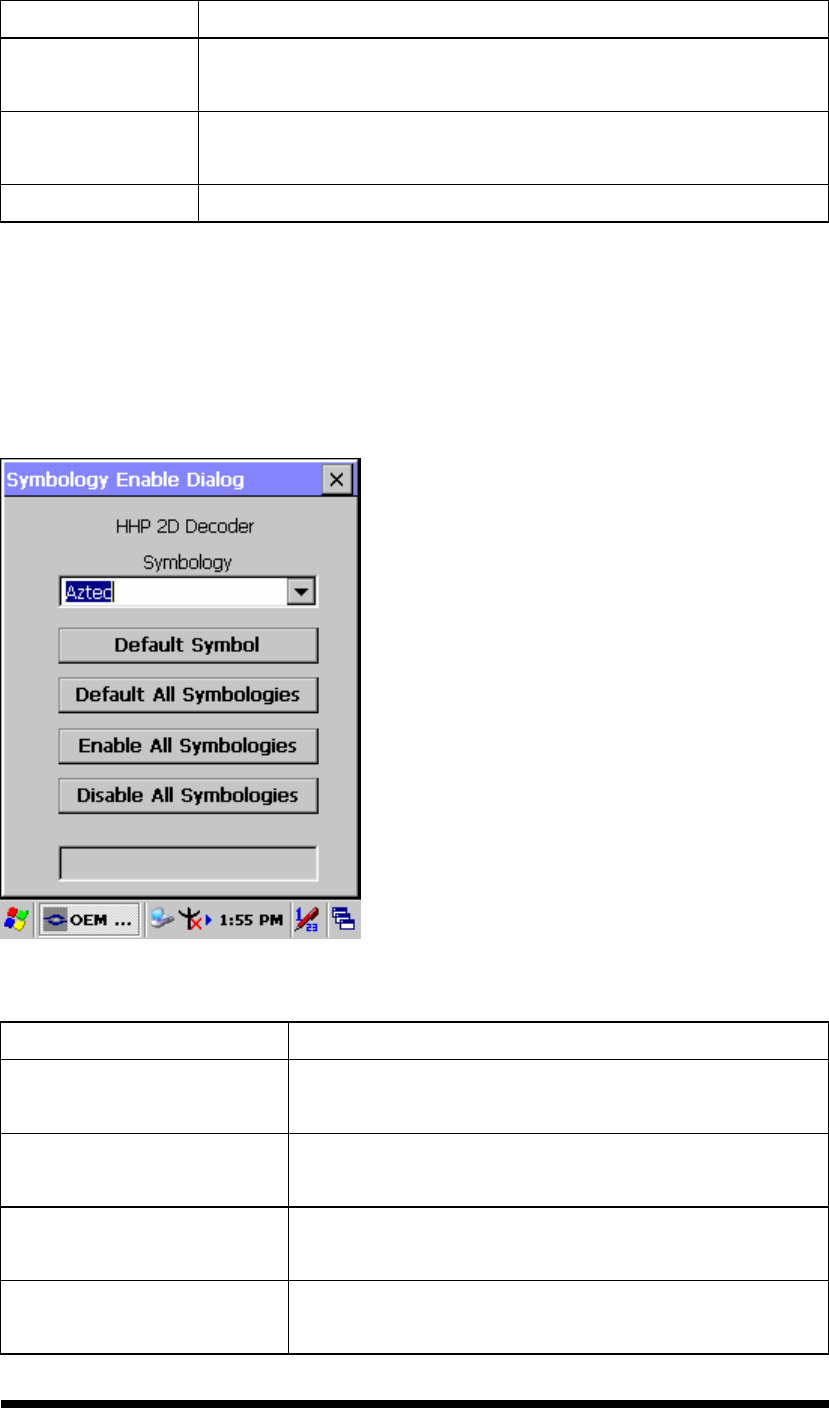
A-2
Item Function Explaining
Config file is saved as it appears on the screen instead of how
it was received.
Restore Config
From File
This selection restores the Config from any file. The Config
file is full size, uncompressed, and unprocessed.
Exit Selecting Exit shuts down the Application Program.
A.1.1 Symbology Setup
Selecting the Symbology Setup menu item causes the symbology setup dialog to be
displayed. This dialog consists of a symbology drop down list, plus four buttons and a
message box.
Function Explaining:
Item Function Explaining
Default Symbol Causes the current symbology shown in the drop
down list to be set to internal defaults.
Default All Symbologies Defaults all symbology options for all symbologies to
internal defaults.
Enable All Symbologies Enables all symbologies, but does not change other
symbol options.
Disable All Symbologies Disables all symbologies without affecting other
symbol options.
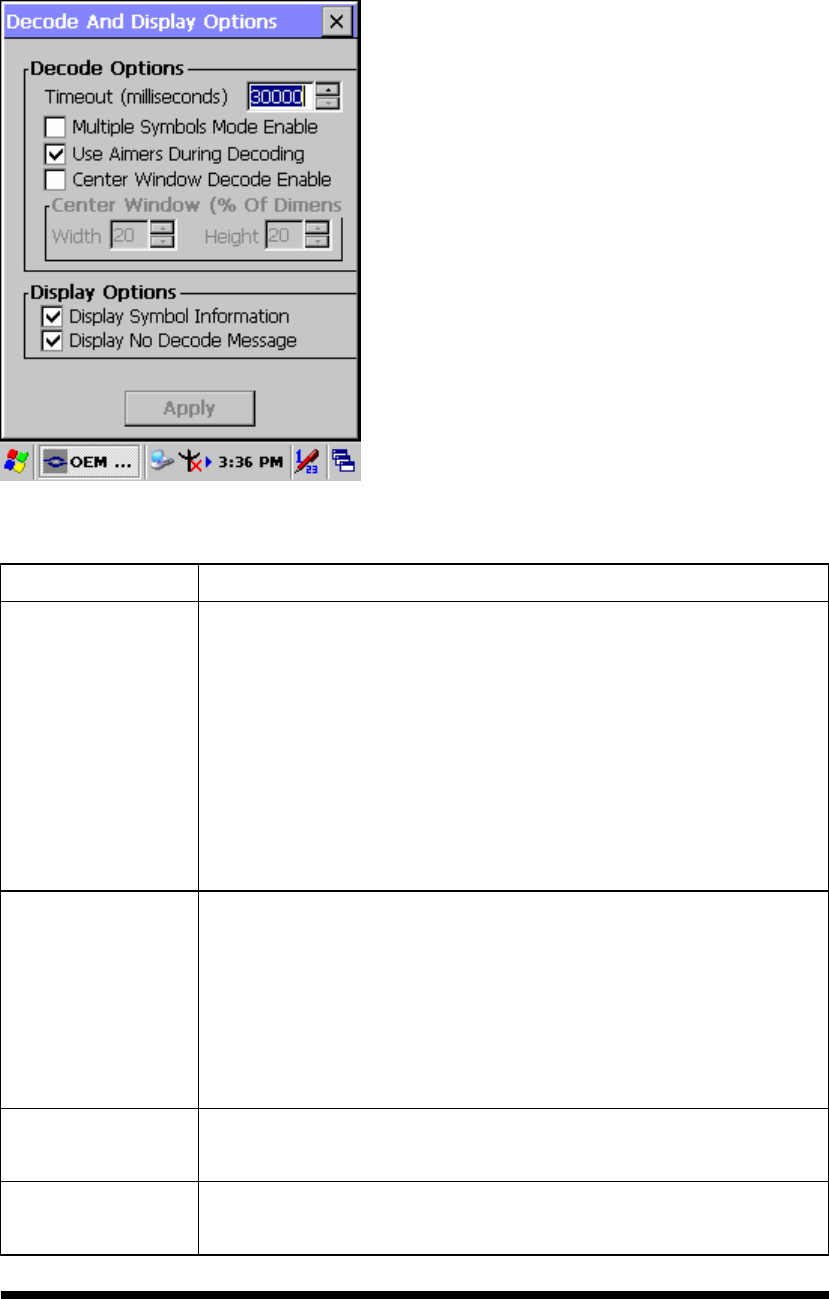
A-3
A.1.2 Decoder Setup
Function Explaining:
Item Function Explaining
No Read
Timeout
Maximum time (in milliseconds) that the imager will attempt
to decode before declaring a “No Decode” condition. If
attempting to decode using the trigger key, the imager quits
decode attempts even if the trigger key remains depressed.
You will not be able to start a new decode using the trigger
until after the trigger is released. The timeout also applies to
the decode operation of the imaging technology. The Timeout
range is 0 meaning no timeout (i.e., infinite) to 300,000.
Multiple
Symbols Mode
Enables/Disables multiple symbols decoding. Normally the
imager stops attempting to decode when a bar code symbol is
decoded. In multiple symbols mode, the imager will not stop
until the trigger is released or a “No Decode” timeout occurs.
The same bar code will not read again until current decoding
stops.
Aimers During
Capture
Enables/Disables aimers during decoding.
Center Window
Decode Enable
A decoded symbol is returned only if it intersects a rectangle
specified by the center window.
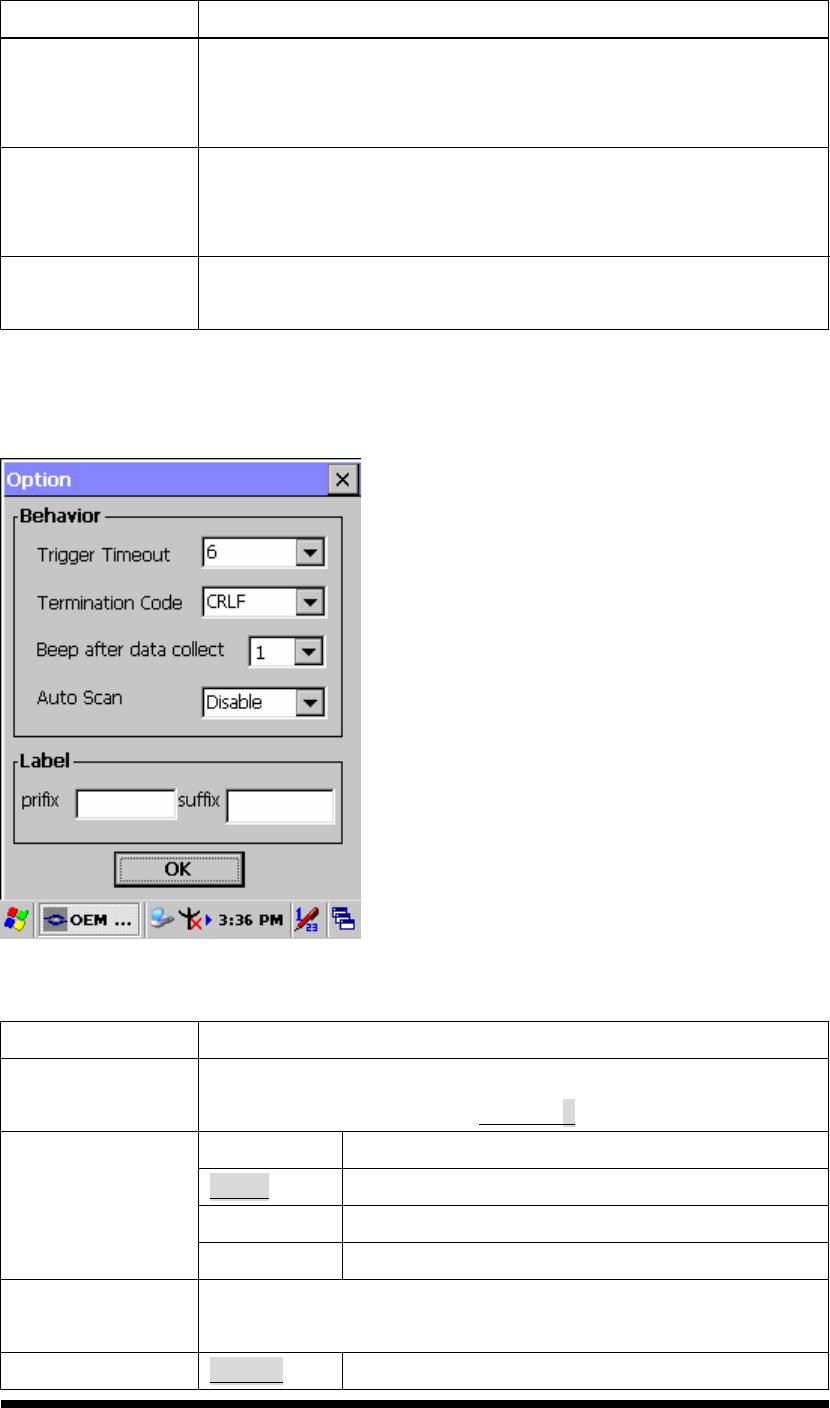
A-4
Item Function Explaining
Center Window Center Window indicates the percent-age of width and height
of the center decode rectangle, relative to the entire image. The
limits are 0-100%. The defaults are20x20 (128x96 pixels).
Display Symbol
Information
The Display Symbol Information option enables/disables
display of decoded symbol information, which includes the
AIM ID, SymID (Code ID), and symbol modifier.
Display No
Decode Message
Enables/Disables display “No Decode” message if no bar code
symbol is decoded by either a timeout or trigger release.
A.1.3 Options
Function Explaining:
Item Function Explaining
Trigger Timeout Select the scanning timeout duration (in seconds) from this
pull-down list. <3 ~ 10 sec, Default: 6>
None After showing barcode, do not action.
CRLF After showing the barcode, jump to next row.
Space After showing the barcode, jump one unit.
Termination
Code
Tab After showing the barcode, jump a section.
Beep after data
collect
Select the time of beep tone after data collect.
Auto Scan Disable Disable this functionality.
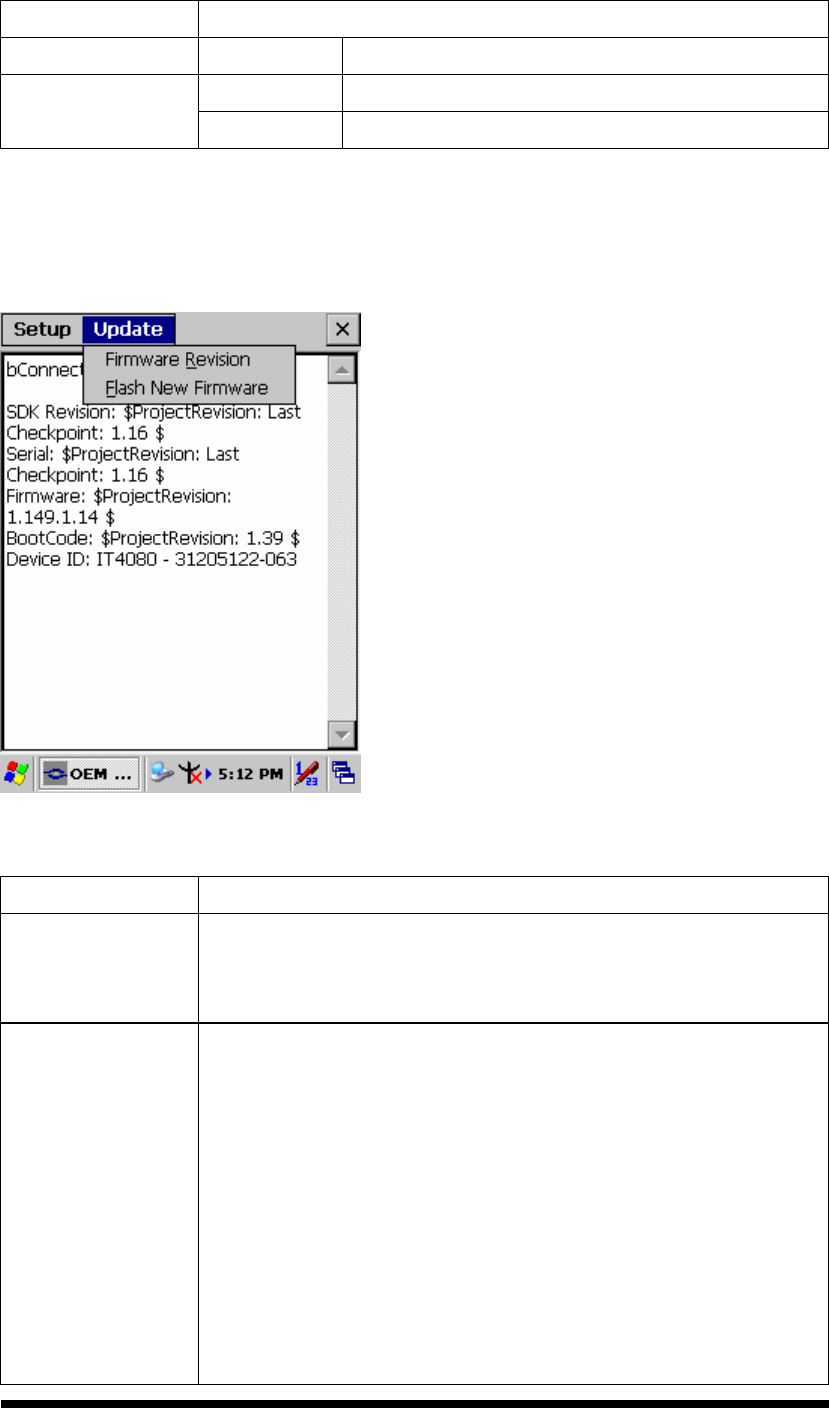
A-5
Item Function Explaining
1 ~5 sec Alternate second number of Continuous Scan.
Prefix Type the desired label prefix in this text box
Label
Suffix Type the desired label suffix in this text box
A.2. Update Tab
Function Explaining:
Item Function Explaining
Firmware
Revision
When this item is selected, the imager is queried for the
current firmware version information. The version information
is then displayed in the text window.
Flash New
Firmware
This item allows new engine firmware to be installed into the
imager. When Flash New Firmware is selected; you are
prompted to select the firmware file. The file, which must have
the extension ".bin", must reside on the PDT. The firmware
file can be copied to the PDT using Microsoft Explorer as long
as the PDT is linked to the PC via Microsoft's Active Sync.
The default search location is the My Documents folder. Once
you select a file, the file is transferred to the engine. The
engine then writes the new firmware into flash memory and
re-initializes. The flashing of the firmware and subsequent
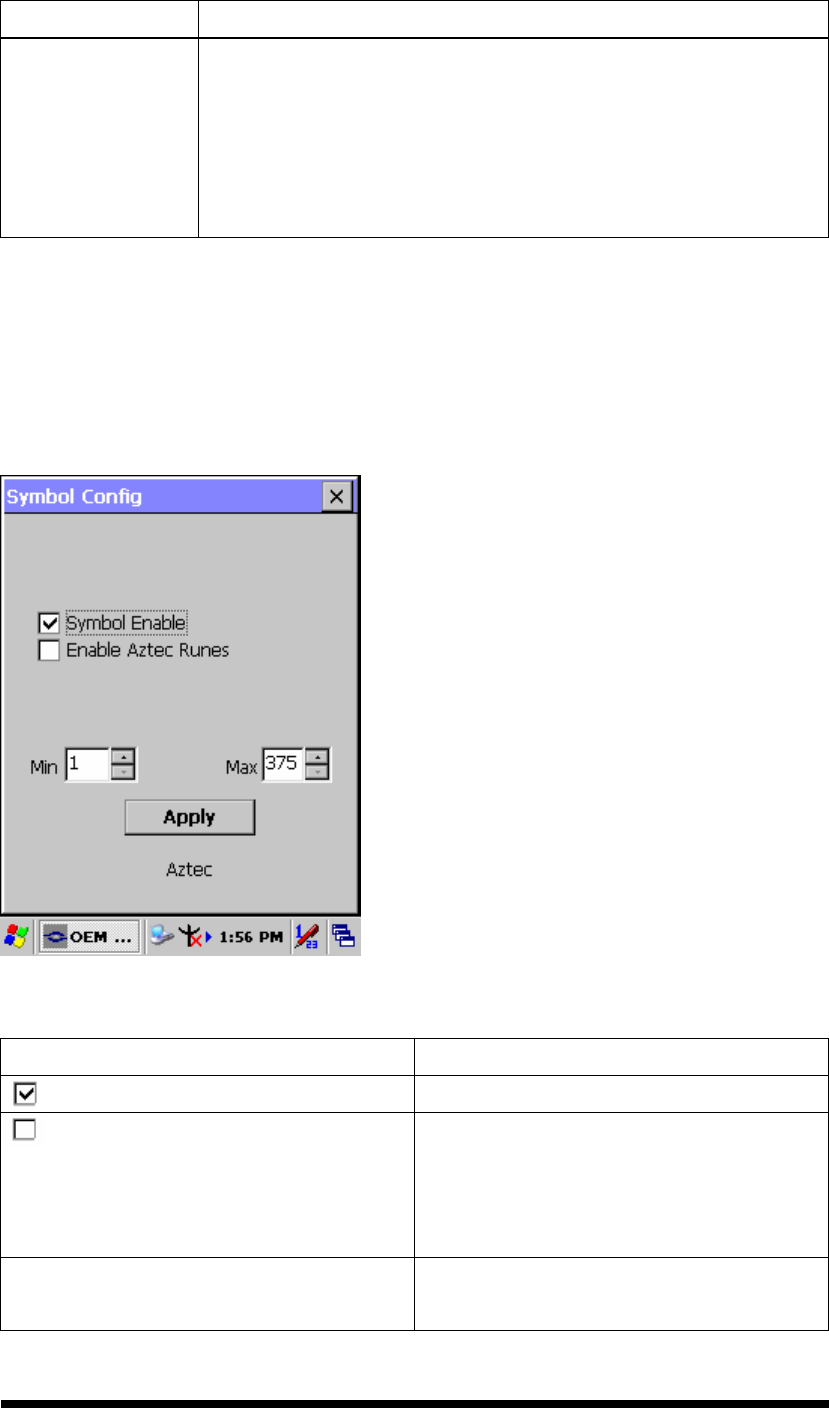
A-6
Item Function Explaining
restart takes approximately 30 seconds. The application insures
that the unit will not enter suspend mode during that time.
Note: It is very important that the device remains awake
during this time. Failure to do so can cause the scan engine to
become unusable.
A.3. Symbologies List
A.3.1 Aztec
Function Explaining:
Item Explaining
Symbol Enable Enable this barcode
Enable Aztec Runes If you are scanning Aztec Runes, which
are the smallest type of Aztec Code
symbol with the ability to encode a very
short license plate message.
Message Length The minimum and maximum length
ranges for the barcode are 1-3750.
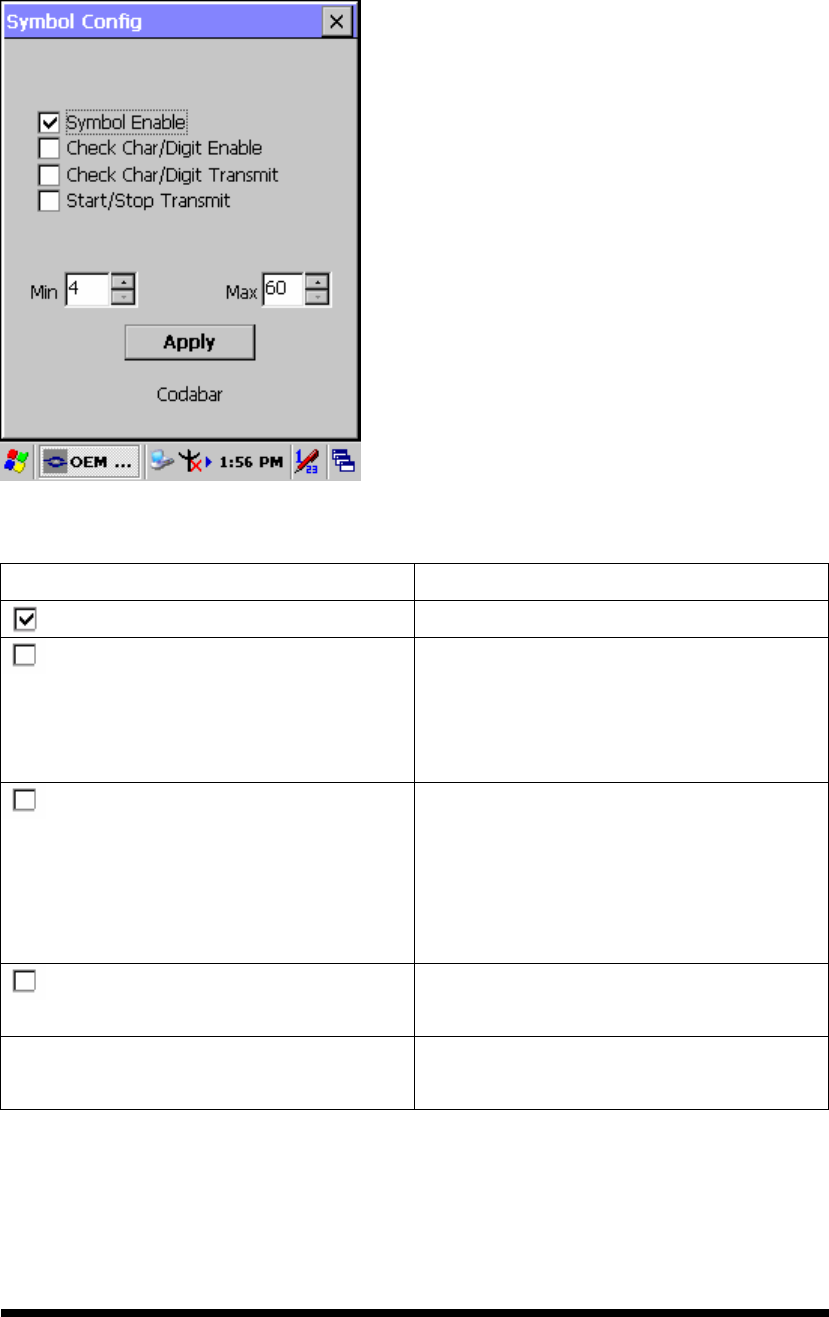
A-7
A.3.2 Codabar
Function Explaining:
Item Explaining
Symbol Enable Enable this barcode
Check Char/Digit Enable The scanner reads barcode data with a
check digit. If not checked, the bar code
will be read as though no check digit
was present.
Check Char/Digit Transmit The scanner will only read Codabar bar
codes printed with a check digit, and
will transmit this character at the end of
the scanned data. This setting is only
valid if check char/digit is enabled.
Start/Stop Transmit
Start/Stop characters identify the leading
and trailing ends of the barcode.
Message Length The minimum and maximum length
ranges for the barcode are 2-60.
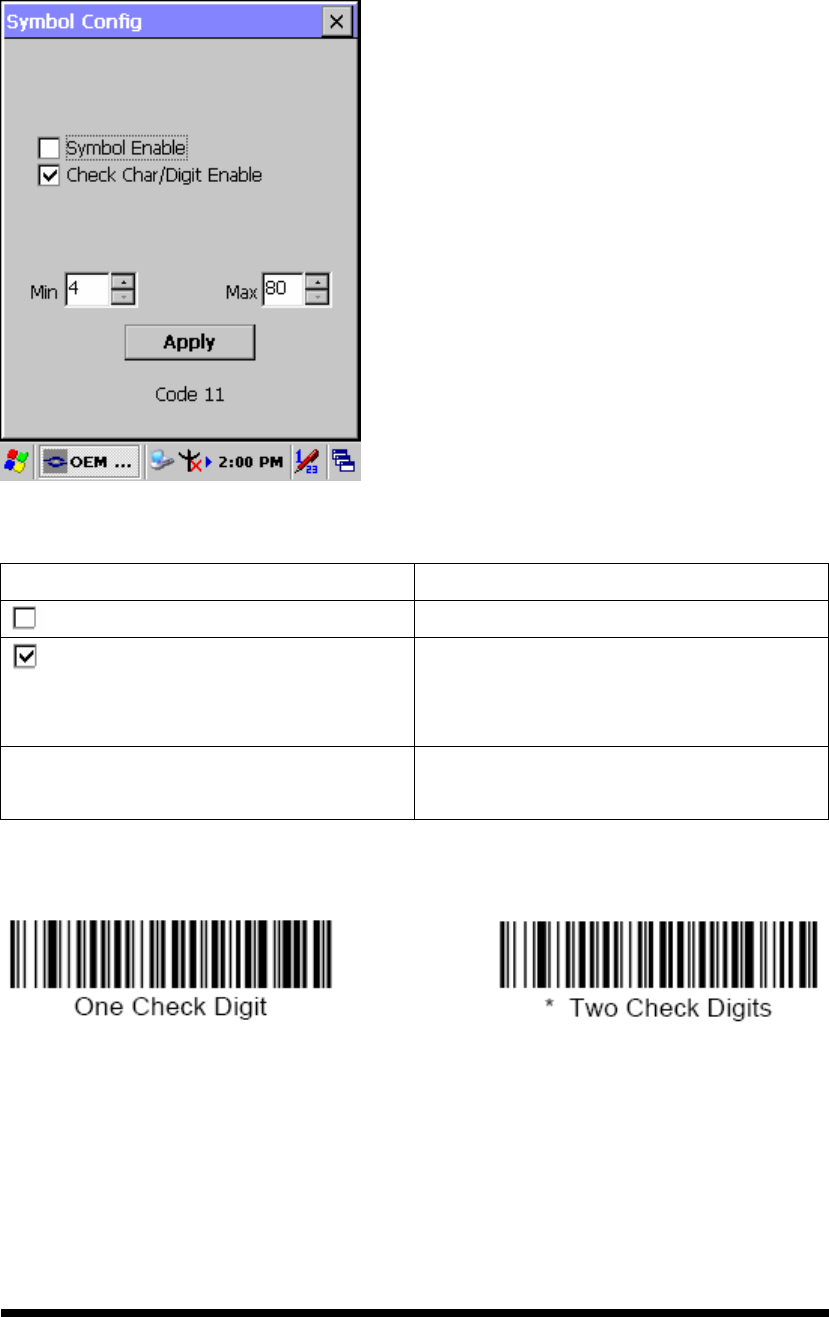
A-8
A.3.3 Code 11
Function Explaining:
Item Explaining
Symbol Enable Enable this barcode.
Check Char/Digit Enable This option sets whether 1 or 2 check
digits are required with Code 11
barcode.
Message Length The minimum and maximum length
ranges for the barcode are 1-80.
Check Digits Required
Default = Two Check Digits.
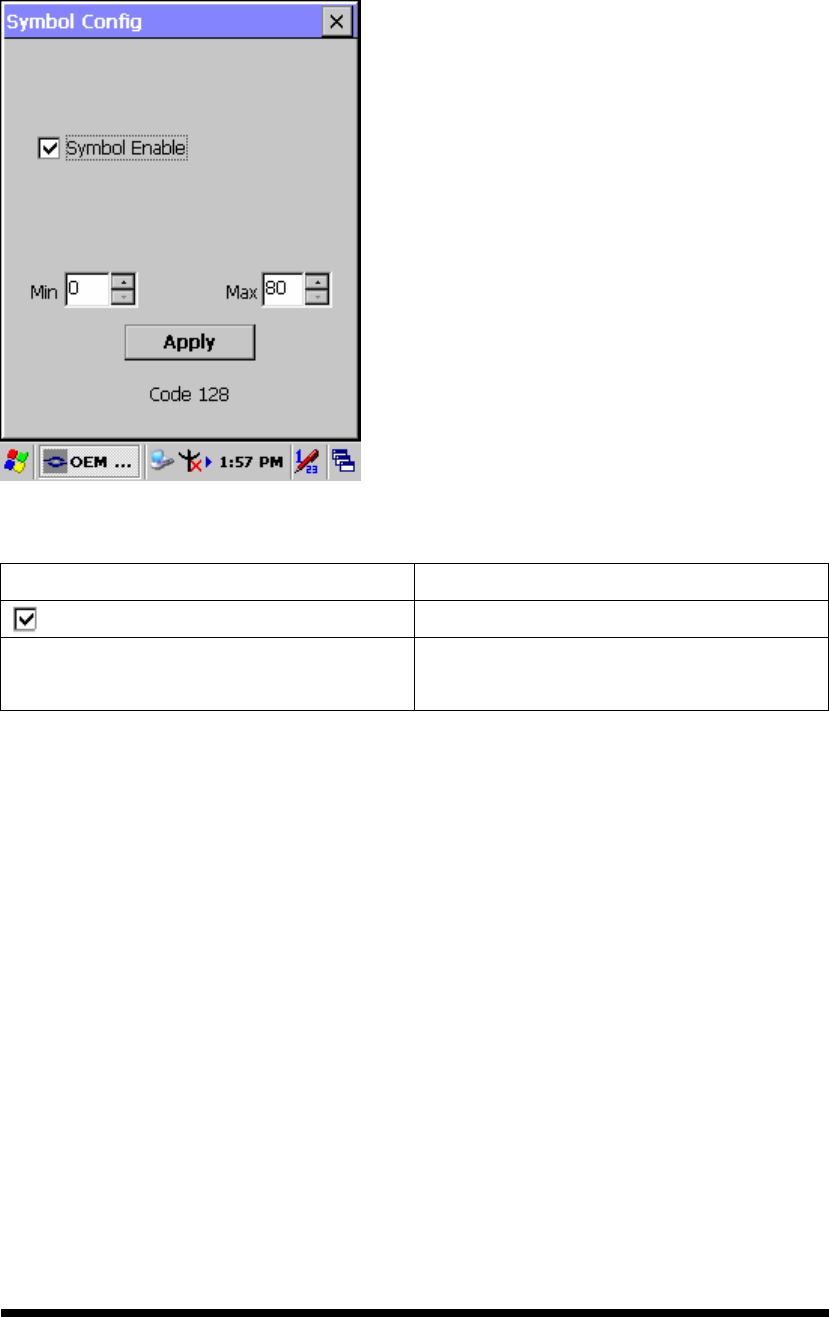
A-9
A.3.4 Code 128
Function Explaining:
Item Explaining
Symbol Enable Enable this barcode
Message Length The minimum and maximum length
ranges for the barcode are 0-80.
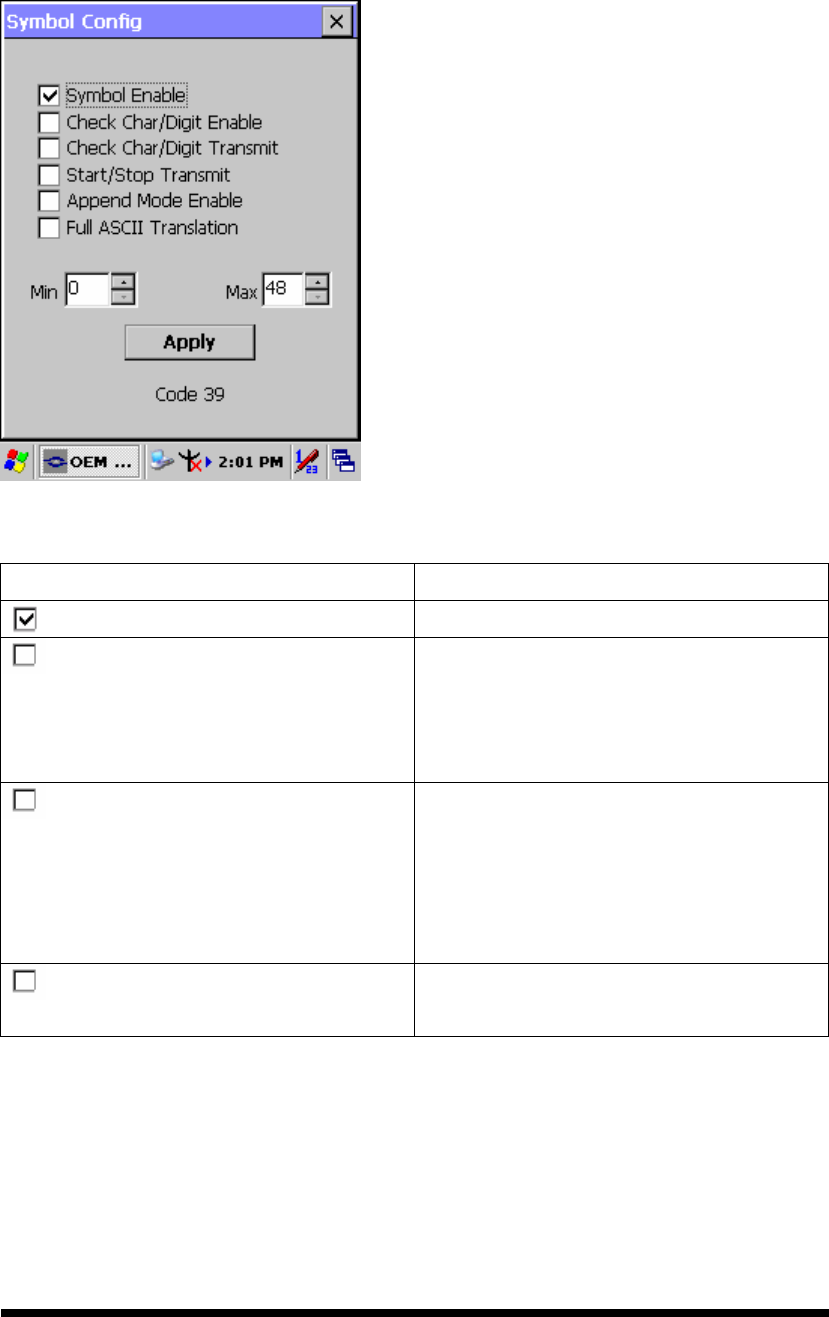
A-10
A.3.5 Code 39
Function Explaining:
Item Explaining
Symbol Enable Enable this barcode
Check Char/Digit Enable The scanner reads barcode data with a
check digit. If not checked, the barcode
will be read as though no check digit
was present.
Check Char/Digit Transmit The scanner will only read Code 39
barcode printed with a check digit, and
will transmit this character at the end of
the scanned data. This setting is only
valid if check char/digit is enabled.
Start/Stop Transmit
Start/Stop characters identify the leading
and trailing ends of the barcode.
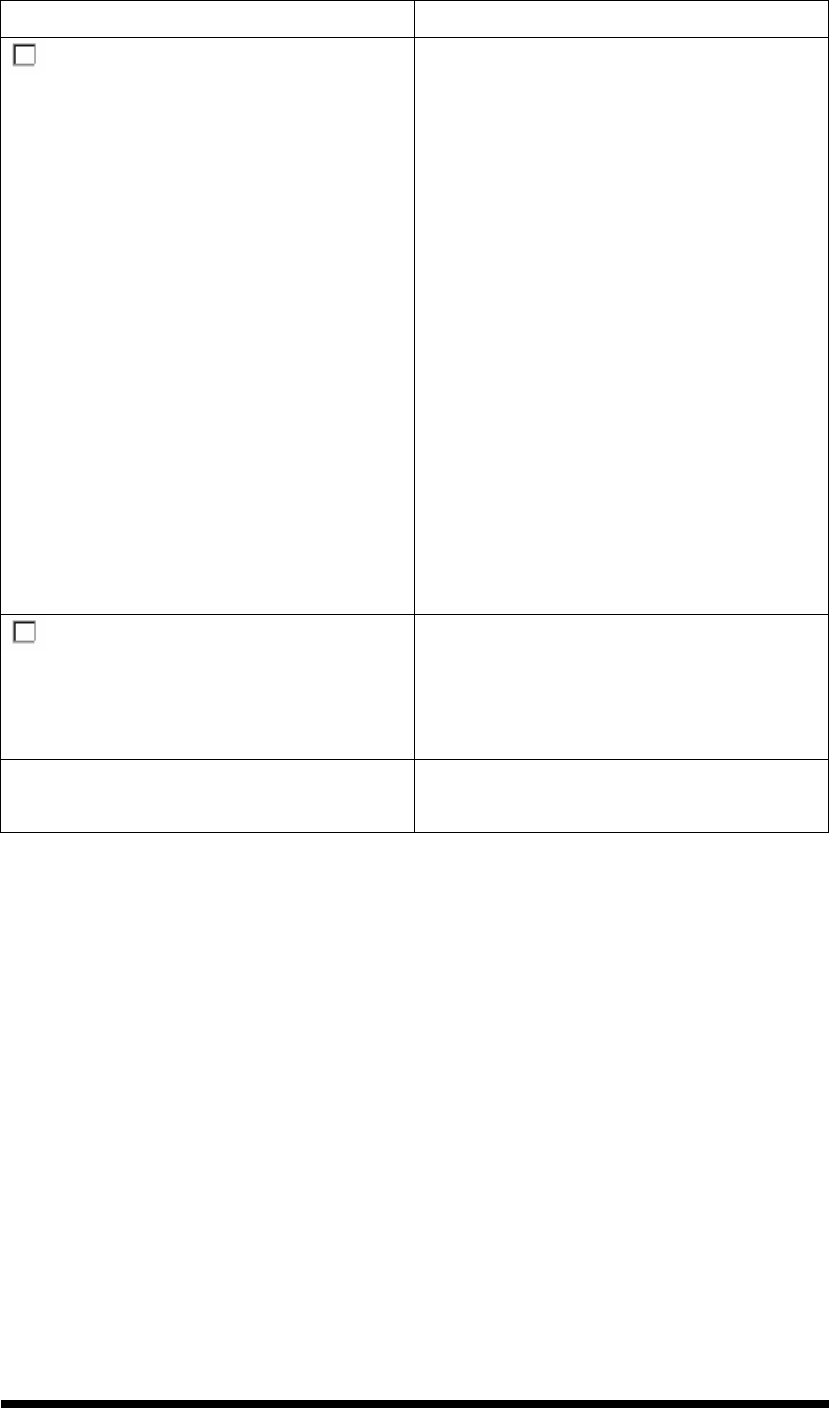
A-11
Item Explaining
Append Mode Enable If this box is checked, the scanner can
append the data from several Code 39
barcode together before transmitting
them to the host computer. When this
function is enabled, the scanner stores
those Code 39 barcode that start with a
space (excluding the start and stop
symbols), and doesn’t immediately
transmit the data. The scanner stores the
data in the order in which the barcode
are read, deleting the first space from
each. The scanner transmits the
appended data when it reads a Code 39
bar code that starts with a character
other than a space, or when it reads a
barcode that is not Code 39.
Full ASCII Translation If Full ASCII Code 39 decoding is
turned on, certain character pairs within
the barcode symbol will be interpreted
as a single character.
Message Length The minimum and maximum length
ranges for the barcode are 0-48.
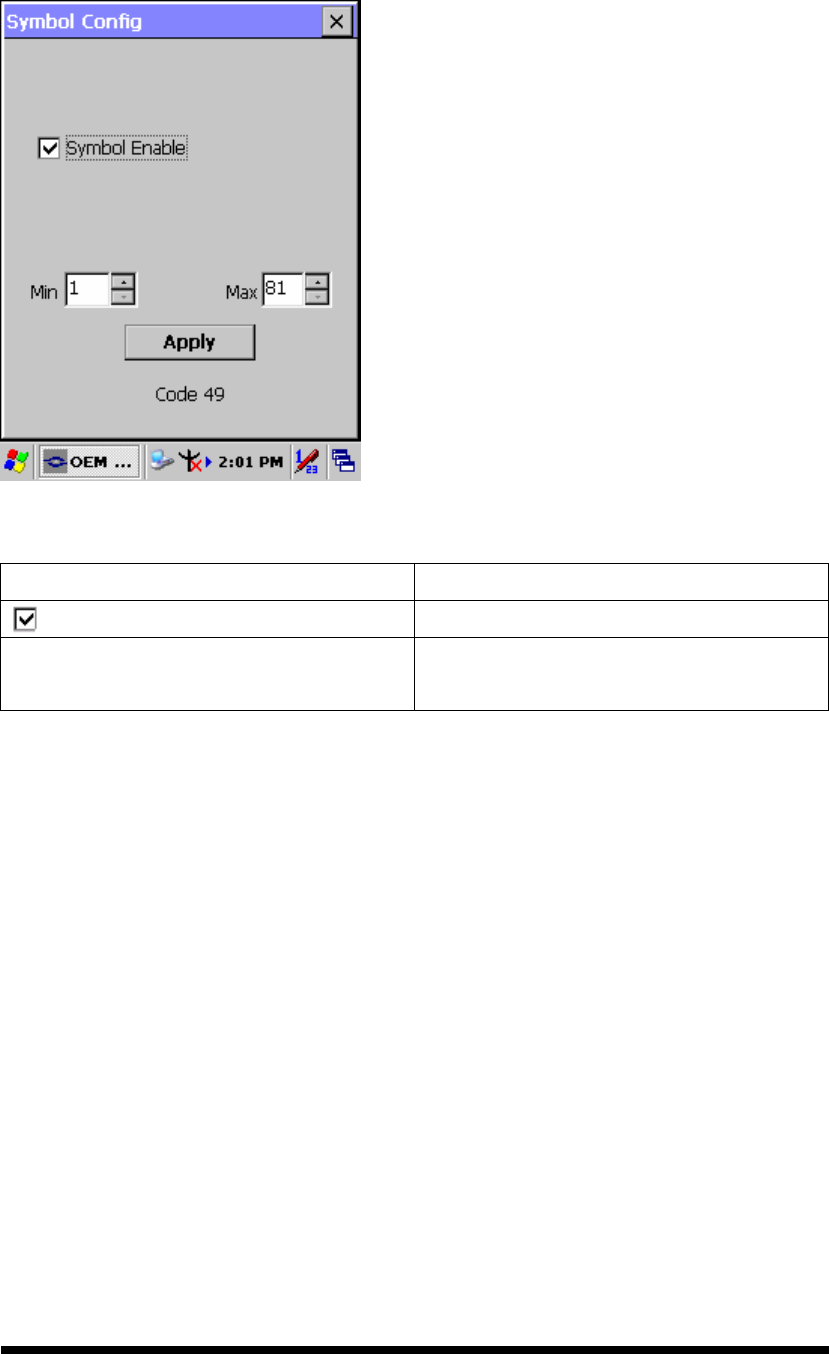
A-12
A.3.6 Code 49
Function Explaining:
Item Explaining
Symbol Enable Enable this barcode
Message Length The minimum and maximum length
ranges for the barcode are 1-81.
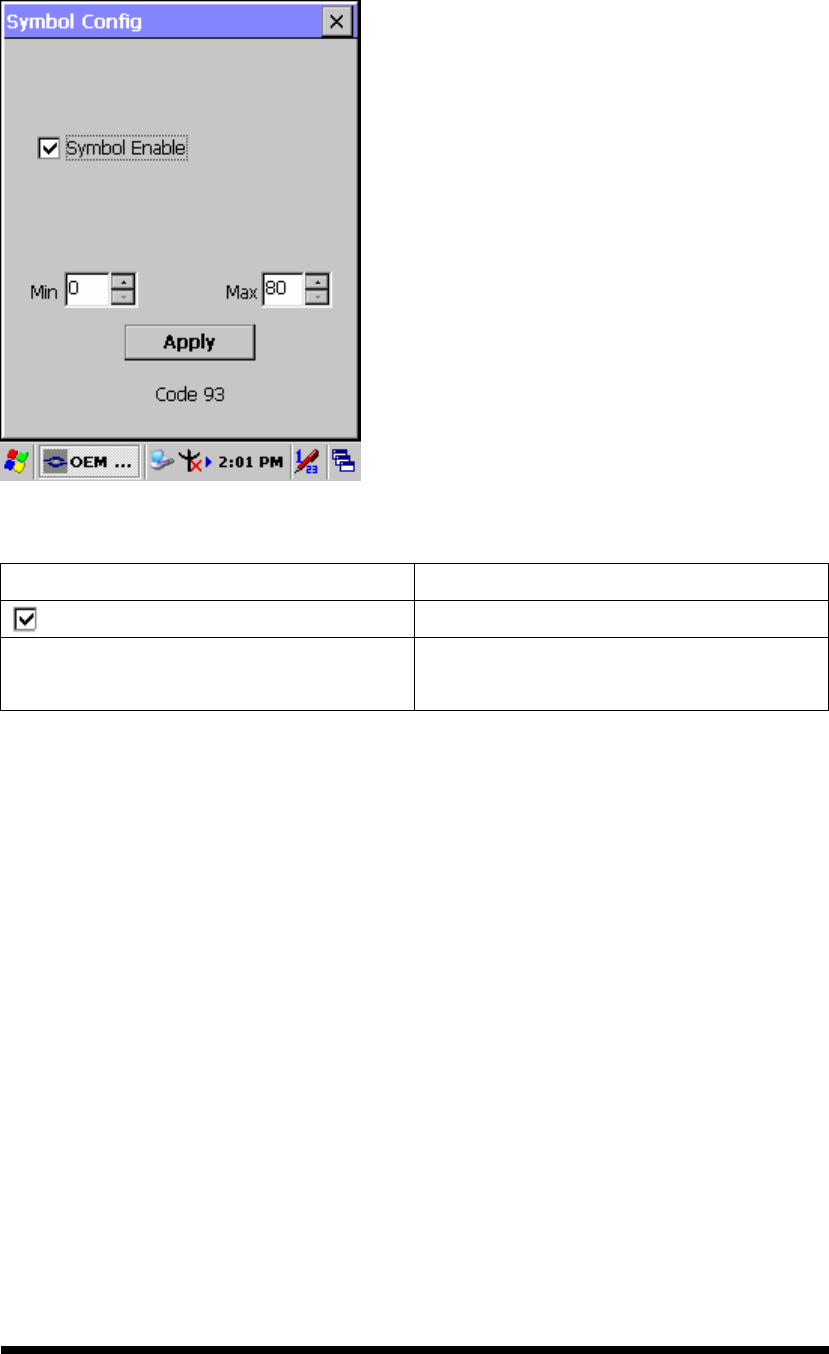
A-13
A.3.7 Code 93
Function Explaining:
Item Explaining
Symbol Enable Enable this barcode
Message Length The minimum and maximum length
ranges for the barcode are 0-80.
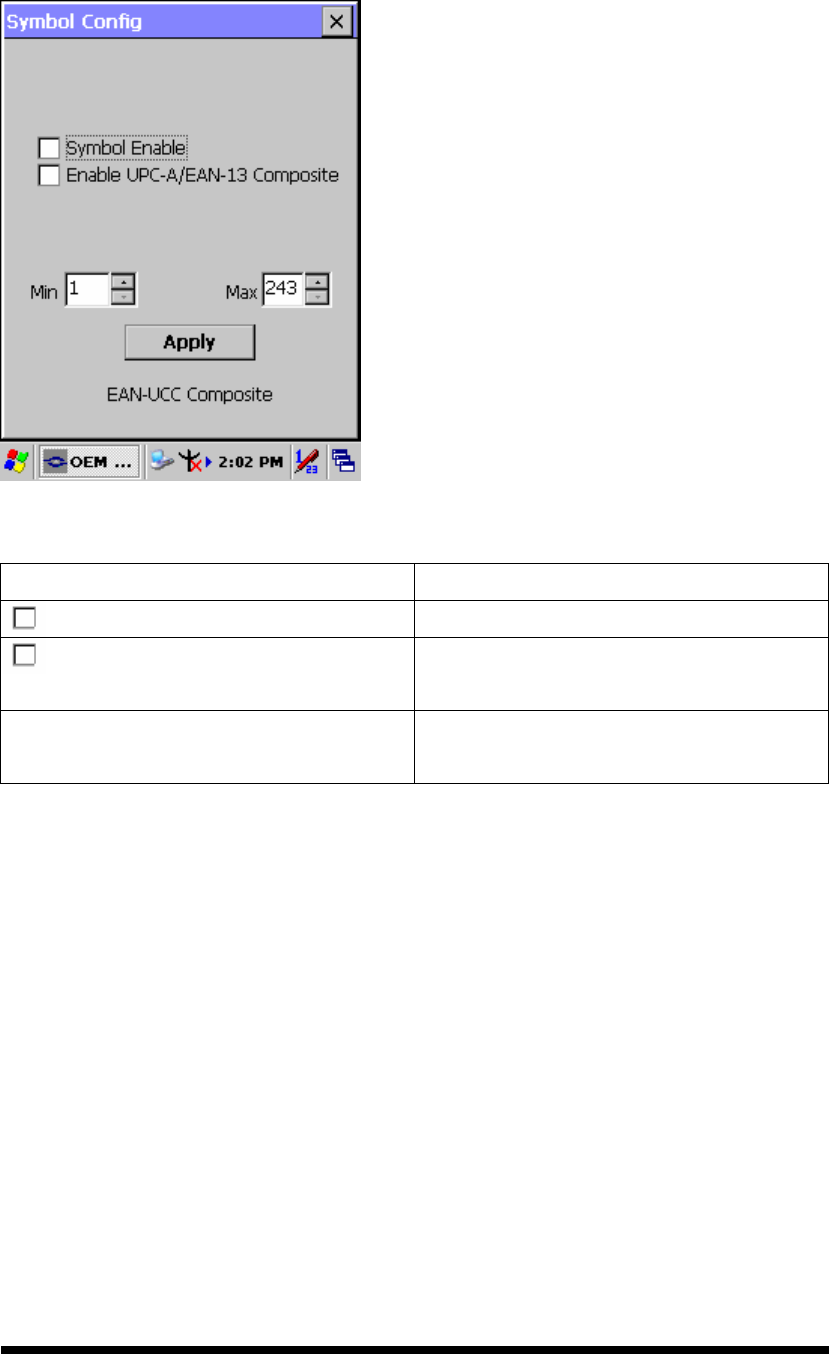
A-14
A.3.8 Composite Codes
Function Explaining:
Item Explaining
Symbol Enable Enable this barcode.
Enable UPC-A/EAN-13 Composite
Whether want to scanning
UPC-A/EAN-13 Composite codes.
Message Length The minimum and maximum length
ranges for the barcode are 1-2435.
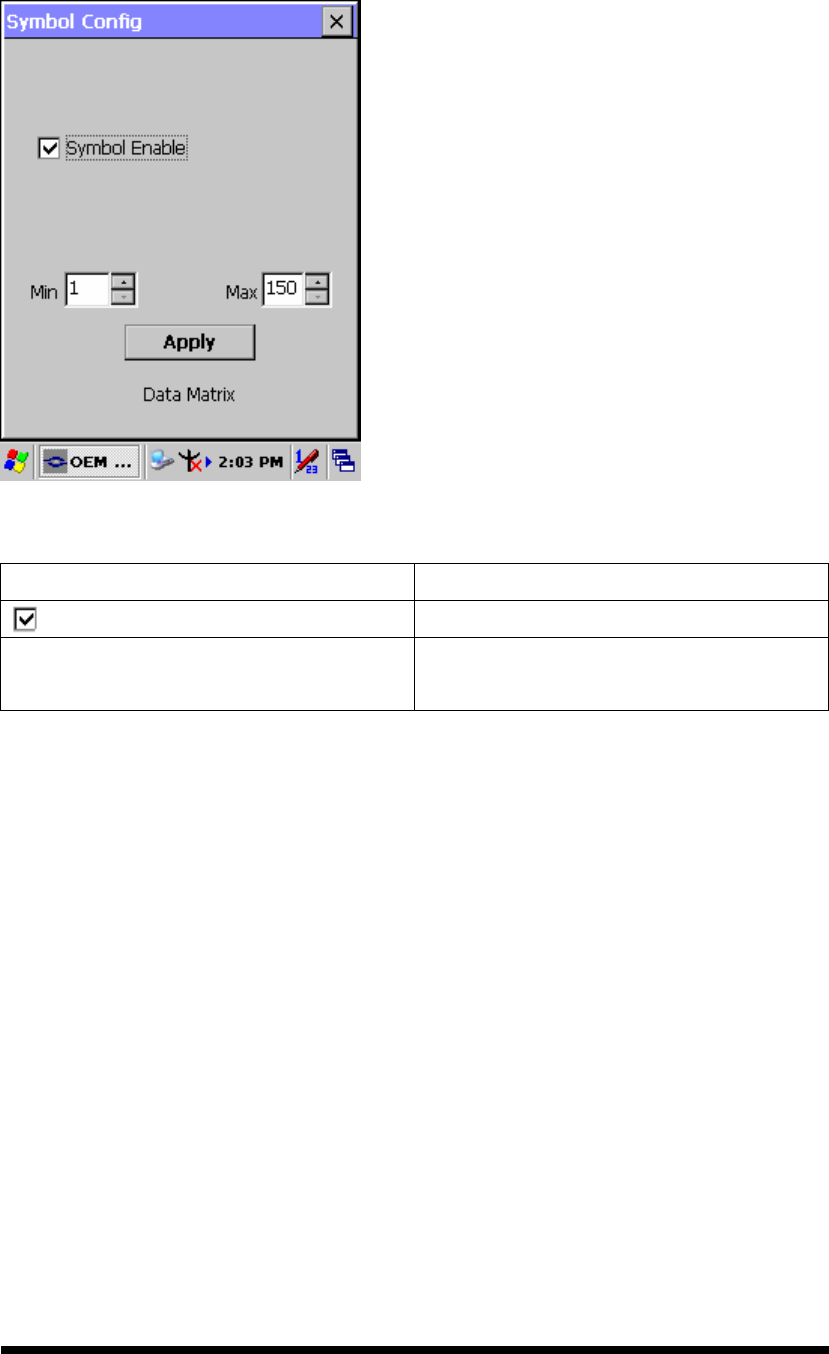
A-15
A.3.9 Data Matrix
Function Explaining:
Item Explaining
Symbol Enable Enable this barcode
Message Length The minimum and maximum length
ranges for the barcode are 1-1500.
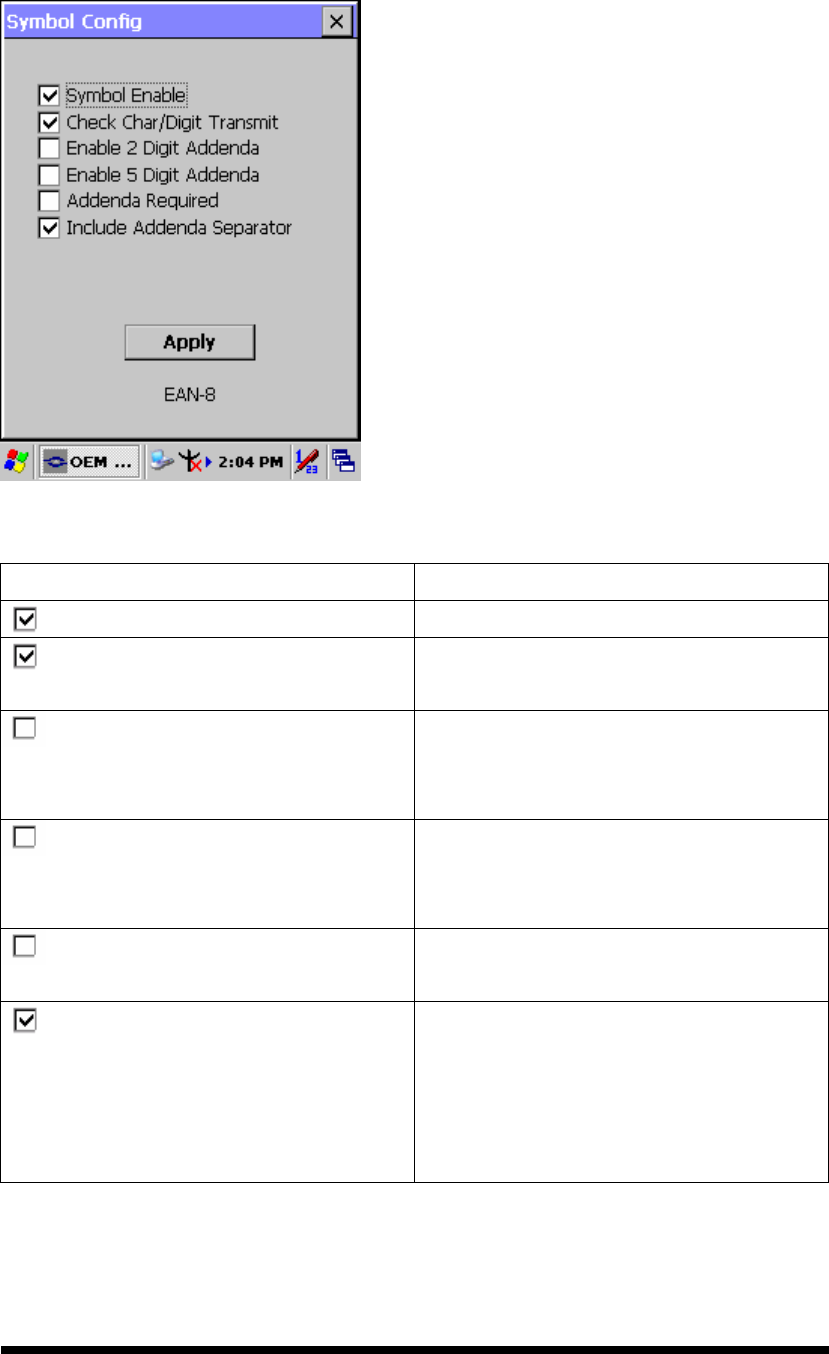
A-16
A.3.10 EAN-8
Function Explaining:
Item Explaining
Symbol Enable Enable this barcode
Check Char/Digit Transmit The output of the check digit at the end
of the scanned data.
Enable 2 Digit Addenda Option allows decoding and outputting
of a 2 digits addendum on the end of all
scanned EAN-8 data.
Enable 5 Digit Addenda Option allows decoding and outputting
of a 5 digits addendum on the end of all
scanned EAN-8 data.
Addenda Required Only reads EAN-8 barcodes that have
addenda.
Include Addenda Separator When this feature is selected, the data is
output with a space between the data
from the
main barcode and the data from
the addenda. When turned off, there is
no space.
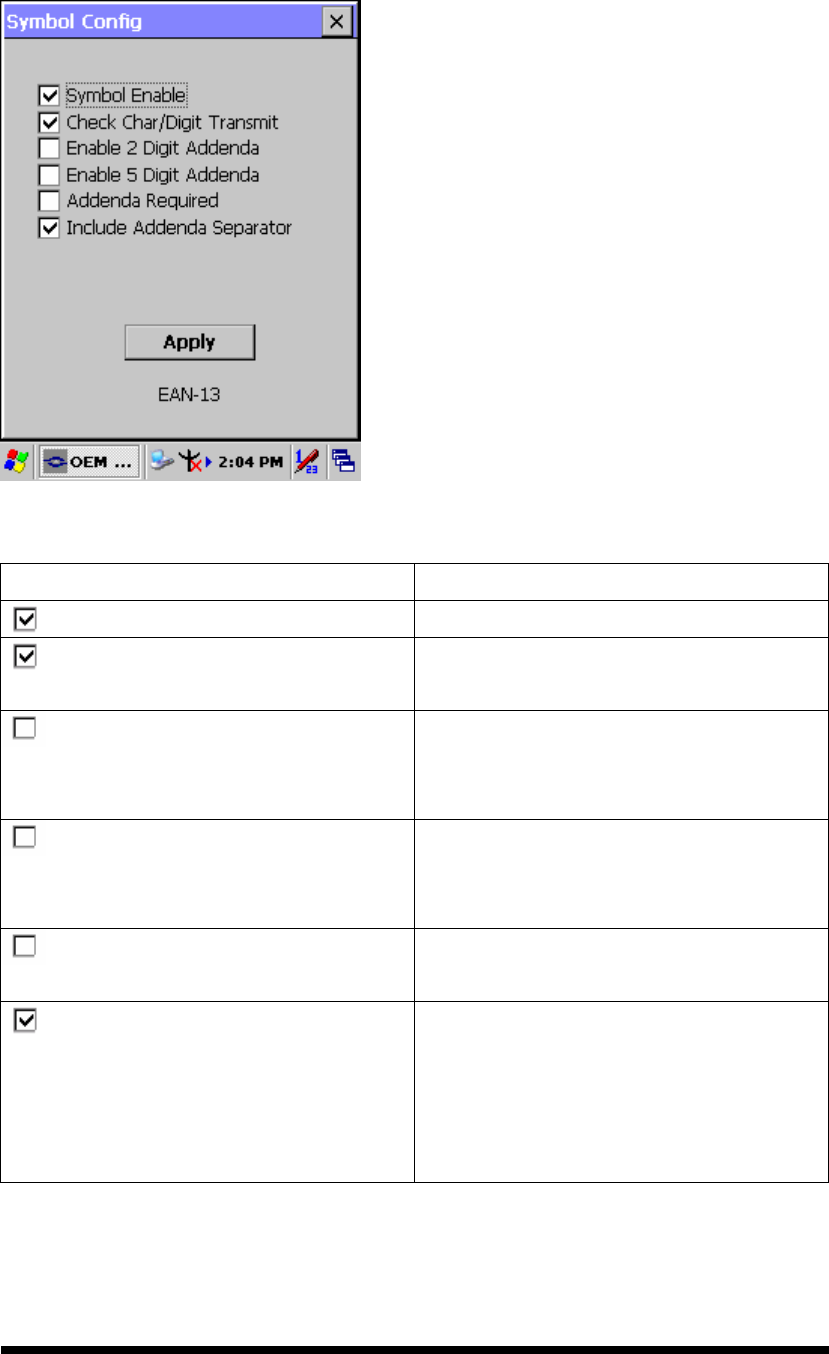
A-17
A.3.11 EAN-13
Function Explaining:
Item Explaining
Symbol Enable Enable this barcode
Check Char/Digit Transmit The output of the check digit at the end
of the scanned data.
Enable 2 Digit Addenda Option allows decoding and outputting
of a 2 digits addendum on the end of all
scanned EAN-13 data.
Enable 5 Digit Addenda Option allows decoding and outputting
of a 5 digits addendum on the end of all
scanned EAN-13 data.
Addenda Required Only reads EAN-13 barcodes that have
addenda.
Include Addenda Separator When this feature is selected, the data is
output with a space between the data
from the main barcode and the data from
the addenda. When turned off, there is
no space.
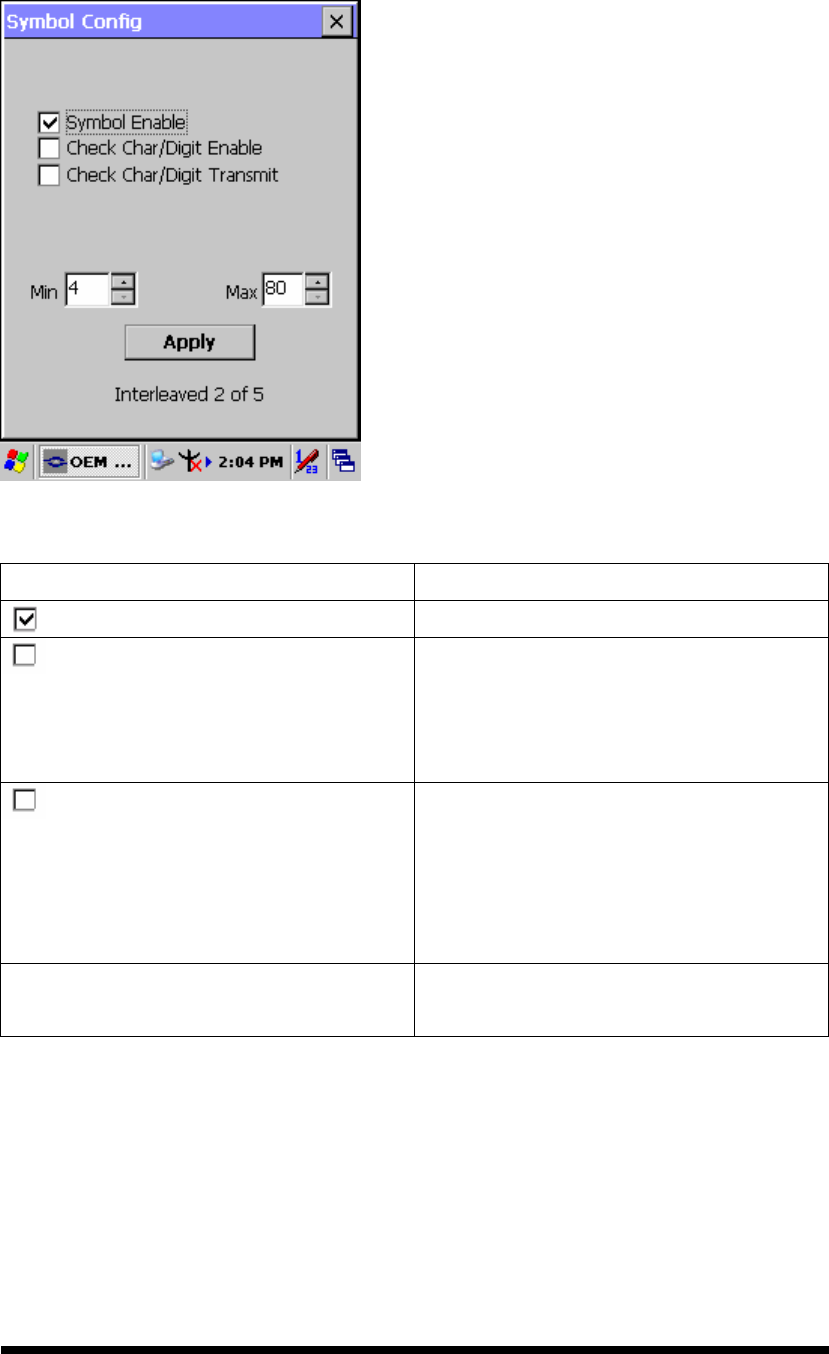
A-18
A.3.12 Interleaved 2 of 5
Function Explaining:
Item Explaining
Symbol Enable Enable this barcode
Check Char/Digit Enable The scanner reads barcode data with a
check digit. If not checked, the barcode
will be read as though no check digit
was present.
Check Char/Digit Transmit The scanner will only read Interleaved 2
of 5 barcodes printed with a check digit,
and will transmit this character at the
end of the scanned data. This setting is
only valid if check char/digit is enabled.
Message Length The minimum and maximum length
ranges for the barcode are 2-80.
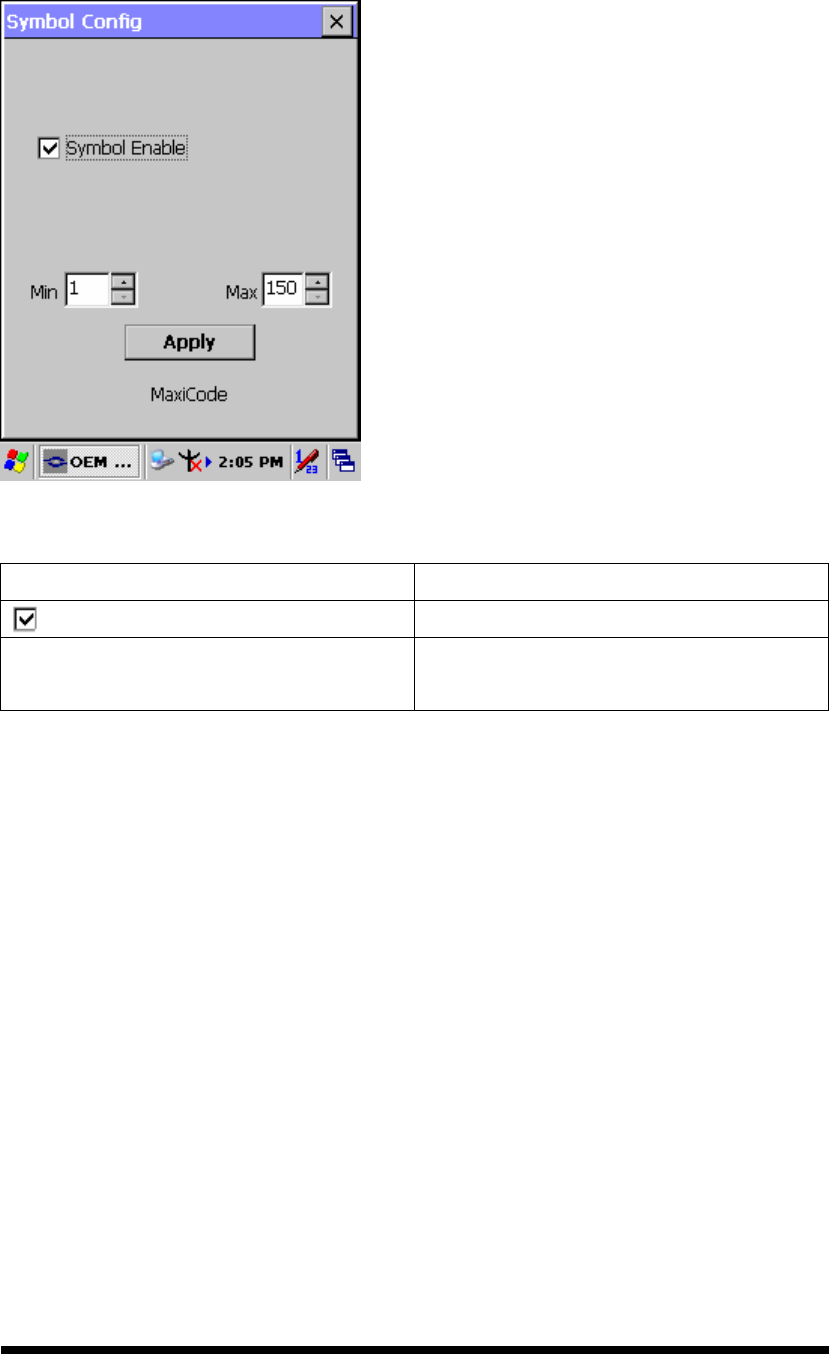
A-19
A.3.13 MaxiCode
Function Explaining:
Item Explaining
Symbol Enable Enable this barcode
Message Length The minimum and maximum length
ranges for the barcode are 1-150.
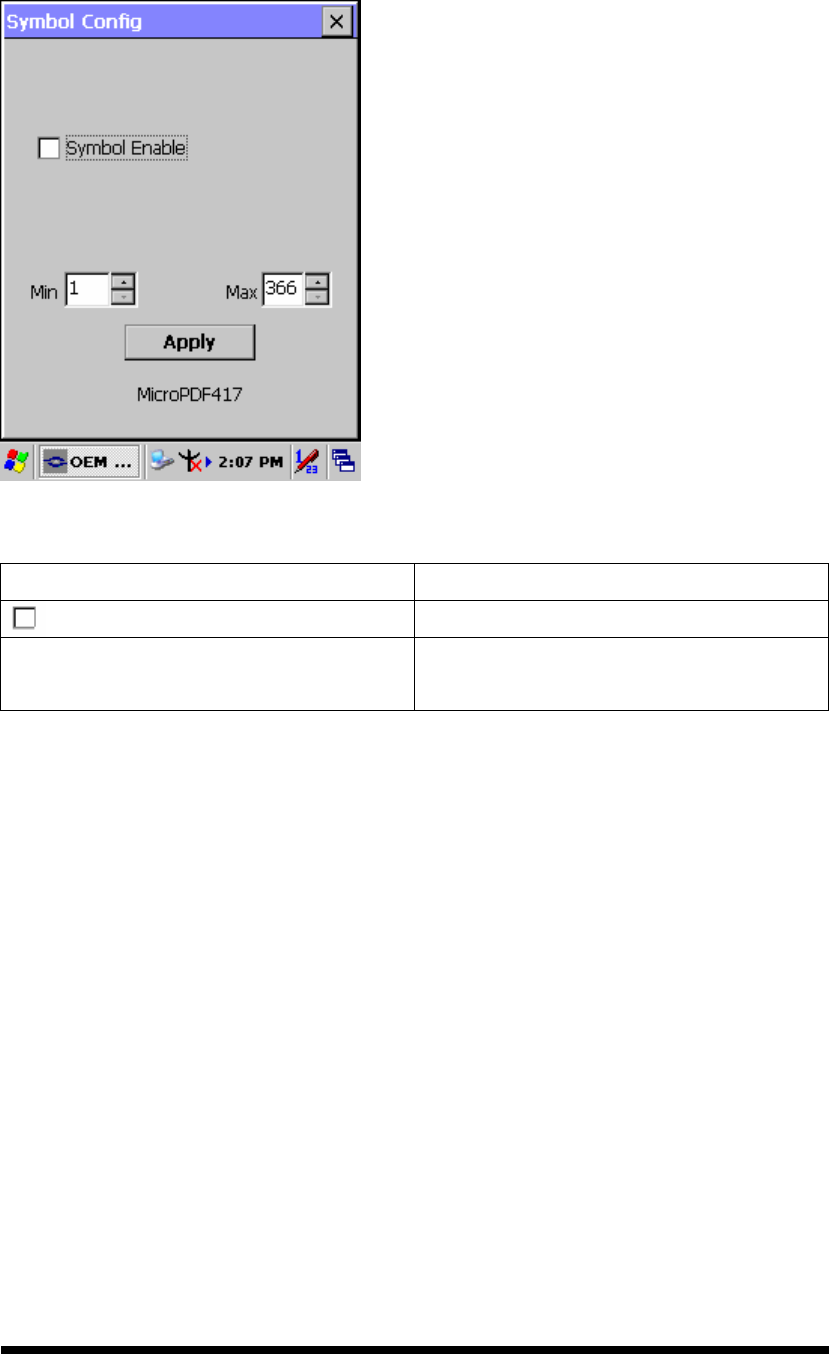
A-20
A.3.14 MicroPDF417
Function Explaining:
Item Explaining
Symbol Enable Enable this barcode
Message Length The minimum and maximum length
ranges for the barcode are 1-366.
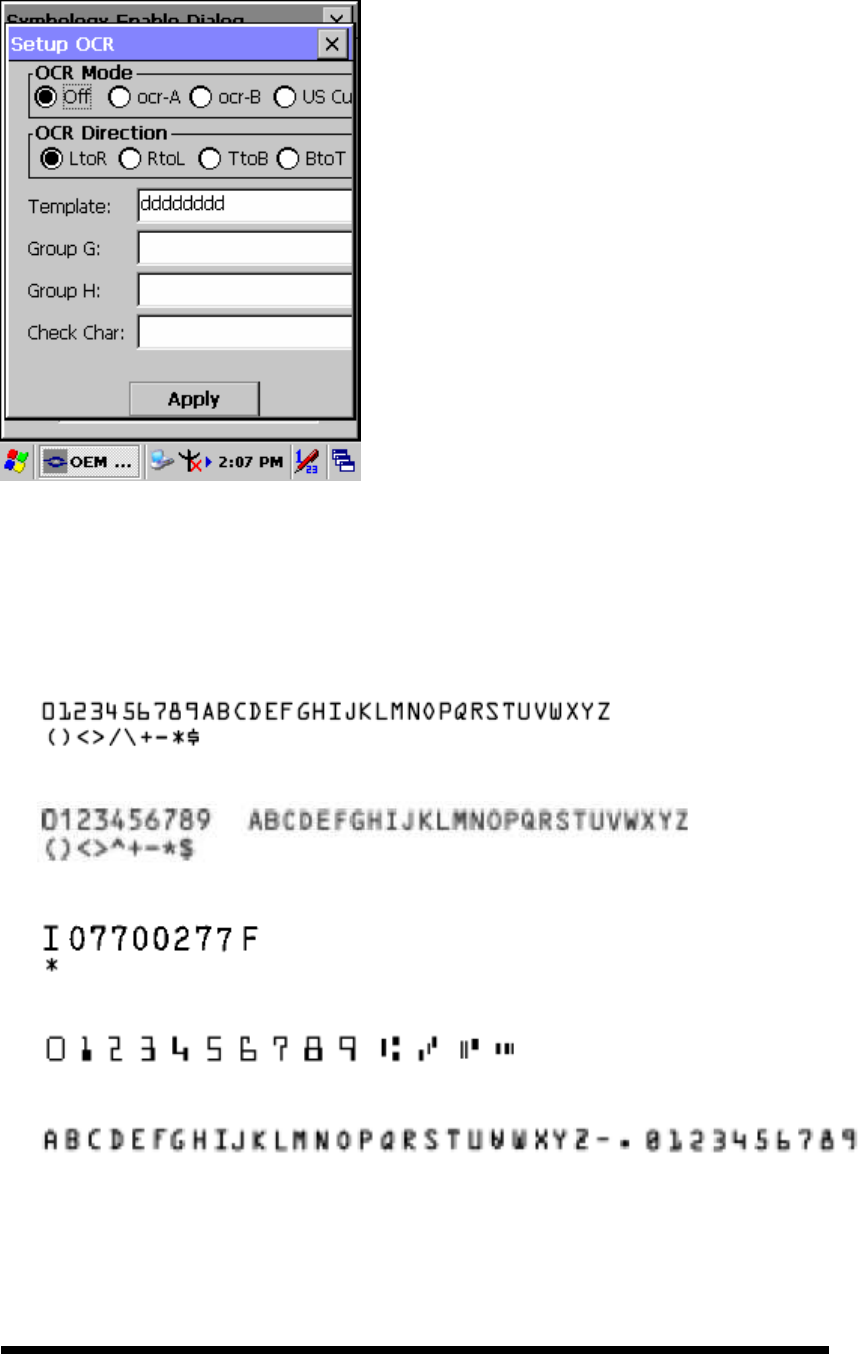
A-21
A.3.15 OCR-A, OCR-B, US Currency
Use this section to program the imager to read machine readable fonts used in optical
character recognition (OCR). The imager reads 6 to 60 point OCR typeface.
OCR Mode
OCR-A
OCR-B
U.S. Currency Serial Number (Money)
MICR E-13B
SEMI Font
You can either select an OCR default, or create your own custom template for the
type of OCR format you intend to read. See "OCR Templates" if you want to create a
custom “template” or character string that defines the length and content of OCR
strings that will be read with your imager.
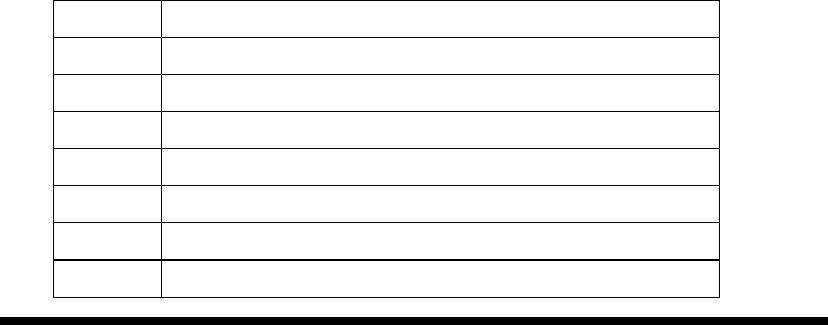
A-22
Note: Setting the template and check character options are essential for OCR
reading.
OCR Off turns off all OCR capability in the scanner, so the scanner will be able to
scan linear, stacked, matrix, and composite bar codes, but not OCR fonts. In addition,
any OCR templates you have created are erased. The 8 digit default templates are
reinstated for any future use of the OCR-A, OCR-B, or U.S. Currency fonts.
If you select OCR-A, OCR-B, or U.S. Currency you can scan characters in that font.
The default setting allows you to scan any 8 digit combination. If you have created an
OCR template, character combinations that fit the template can be scanned (see
Creating an OCR Template).
OCR Direction
The OCR Direction setting can be used to prevent misreads of character strings that
could be interpreted differently in different orientations when you know the
orientation of the characters that are being read in relation to the imager (e.g.,
80086996 could read as 80086996 or 96698008). Default = Left-to-Right (LtoR)
OCR Templates
You can create a custom “template”, or character string that defines the length and
content of OCR strings that will be read with your imager. There are several choices
when creating a custom template for your application. You can create a template for a
single format, you can string together several formats, and you can create a template
for a user-defined variable. These choices are described in detail below.
Creating an OCR Template
A single template allows you to program the imager to read any combination of
characters in the order you specify. Refer to examples that follow the Template
Characters table below.
Template Characters\
a represents any alphanumeric character (digit or letter)
c represents a check character position
d represents any digit
e represents any available OCR character
g represents character from user-defined variable “g”
h represents character from user-defined variable “h”
l represents any uppercase letter
t marks the start of a new template

A-23
r multi row indicator
All other characters represent themselves. Spaces can be used.
Note: In MICR E13 B templates, TOAD characters (capital letters
T, O, A, and D), represent Transit, On Us, Amount, and Dash.
Note: OCR templates default to eight digits, no check character.
To Add an OCR Template
1. Turn on the OCR font you want to read.
2. Begin building the template.
Scan the Enter OCR Template symbol.
3. Scan the characters for the string.
Use the Template Characters chart above to determine what characters you need to
create your format. Use the OCR Programming Chart (after the Sample Codes in
the back of this manual) to scan the characters for your template.
Example: You need to read any combination of eight digits. The template would
be:
To create this template, you would enable the OCR-A font. Scan the Enter OCR
Template symbol, and then scan the d from the OCR Programming Chart in the
back of this manual eight times. Scan Save OCR Template. This would let you
read any string of eight digits, for example:
Character Match Sequences
On the ASCII Conversion Chart (Code Page 1252), page A-4, find the Hex value
that represents the character(s) you want to match. Use the Programming Chart
(inside the back cover) to scan the numbers that represent these characters.
Example: You need to read three digits, three specific characters (ABC), three
digits. The template would be:
To create this template, you would enable the OCR-A font. Scan the Enter OCR
Template symbol. Scan the d from the OCR Programming Chart in the back of this
manual three times. Then scan 414243 from the inside back cover (the hex
characters for “A,” “B,” and “C”), and scan the d three more times. Scan Save
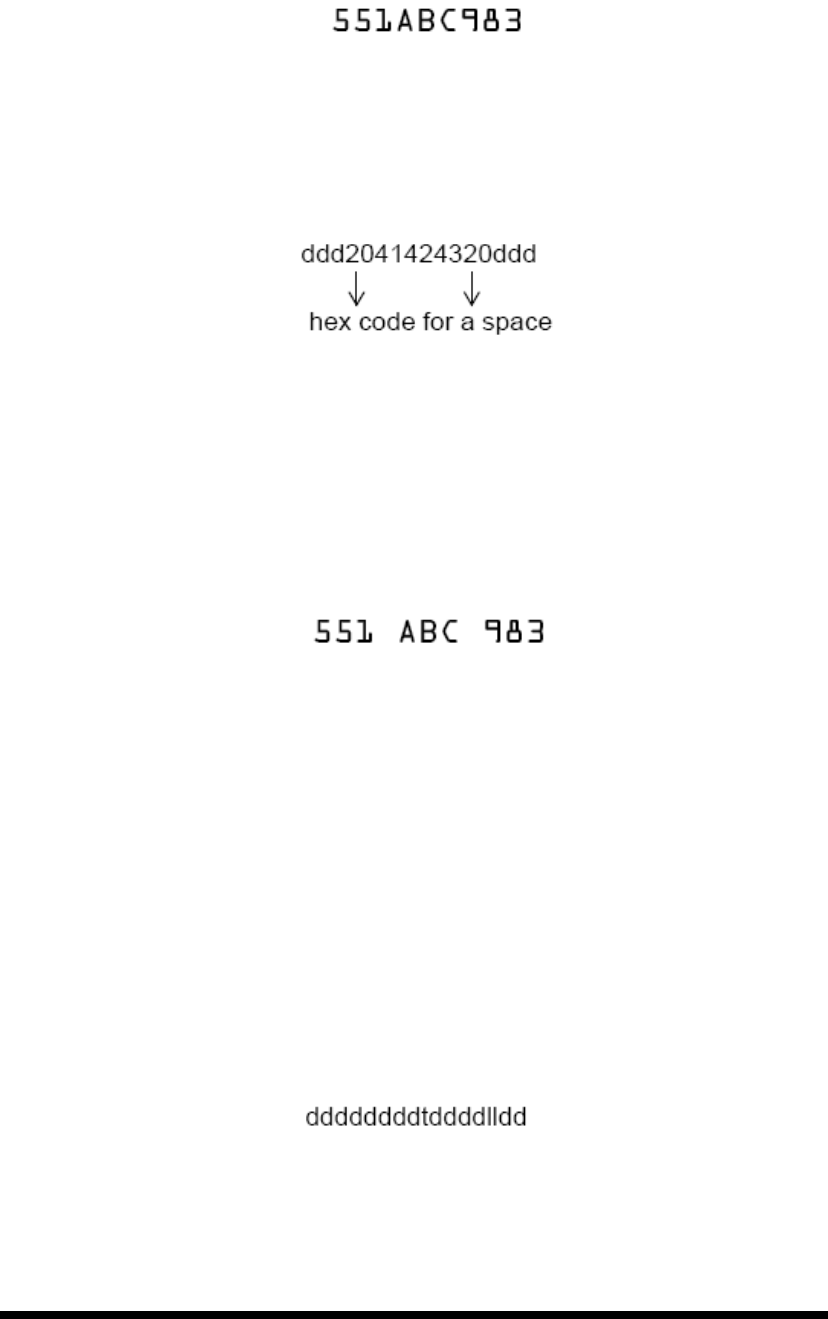
A-24
OCR Template. This would let you read any string of three digits, “ABC,” then
any string of three digits, for example:
Adding Spaces
You may also need to put spaces in your template.
Example: You need to read three digits, space, three specific characters (ABC),
space, three digits. The template would be:
To create this template, you would enable the OCR-A font. Scan the Enter OCR
Template symbol. Scan the d from the OCR Programming Chart in the back of this
manual three times, and then scan 2041424320 from the Programming Chart on the
inside back covers (the hex characters for “space,” “A,” “B,” “C,” “space”). Scan
the d three more times, and then scan Save OCR Template. This would let you
read any string of three digits, space, “ABC,” space, and then any string of three
digits. For example:
Note: If using Quick*View to program, use the space bar to designate a space and
not the hex value of 20.
4. Exit OCR Template Editor
Scan Save OCR Template to save your entries. Discard OCR Template exits
without saving any OCR Template changes.
Stringing Together Multiple Formats (Creating “Or” Statements)
You may want to program the imager to accept many OCR formats. To do this, you
would string together each format with a “t.” This tells the imager to read optical
characters that match any one of the formats in the template.
Example: You need to read any combination of eight digits, or a combination of four
digits, two uppercase letters, and two digits. The template would be:
To create this template, you would enable the OCR-A font. Scan the Enter OCR
Template symbol. Scan the d from the OCR Programming Chart in the back of this
manual eight times, then scan the t to create the “or” statement. Then you would scan
the characters for the second template. Scan d four times, scan l two times, then scan
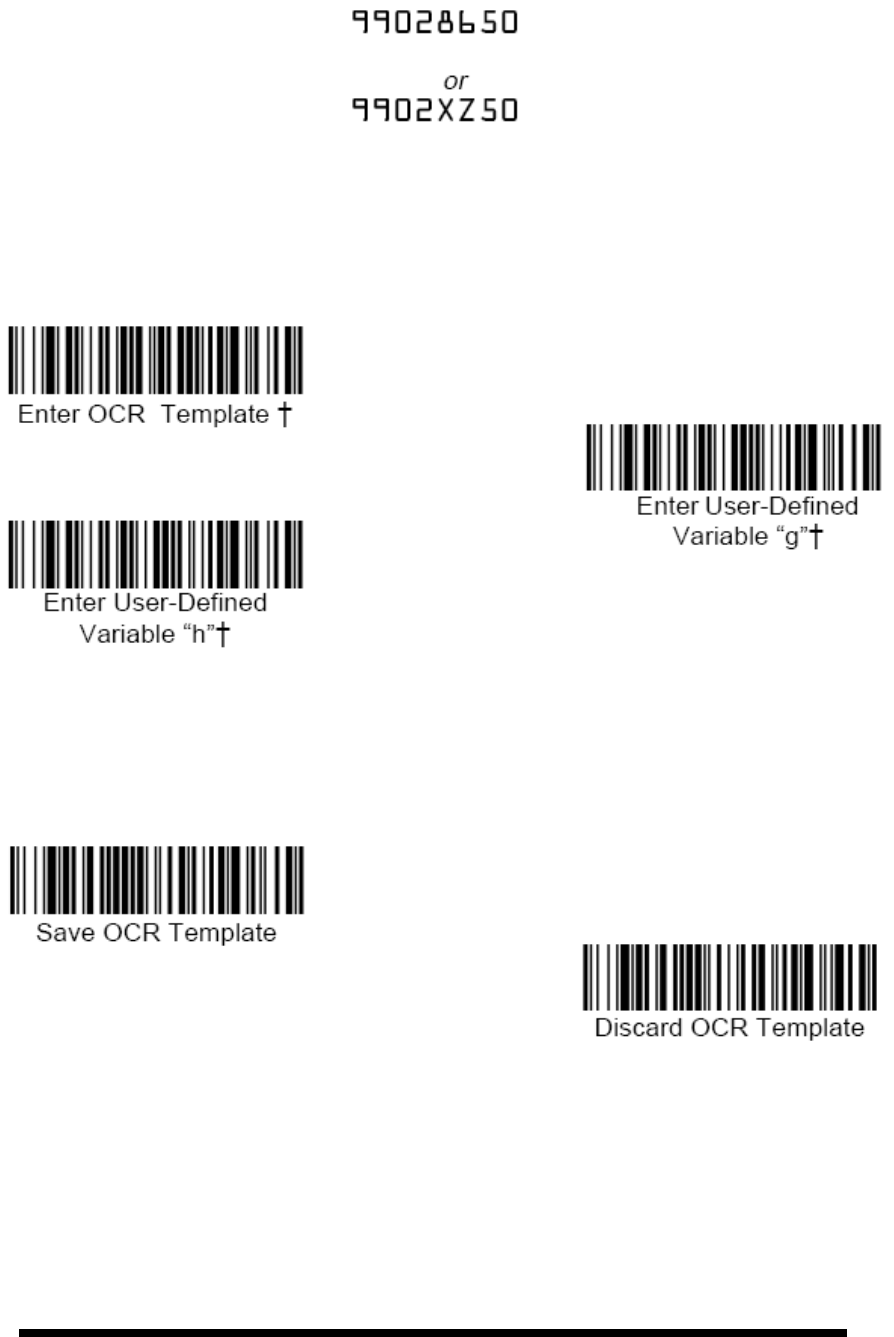
A-25
d two more times. Scan Save OCR Template. This would let you read either type of
format, for example:
You can string together as many templates as you need.
OCR Template Codes
Note: Reading more than three rows of OCR is not recommended. Contact the factory
if you have an application that requires reading four or more rows of OCR.
† One or more two-digit numbers and Save are required after reading this
programming symbol. Refer to the Programming Chart on the inside the back cover of
this manual.
Exit Selections
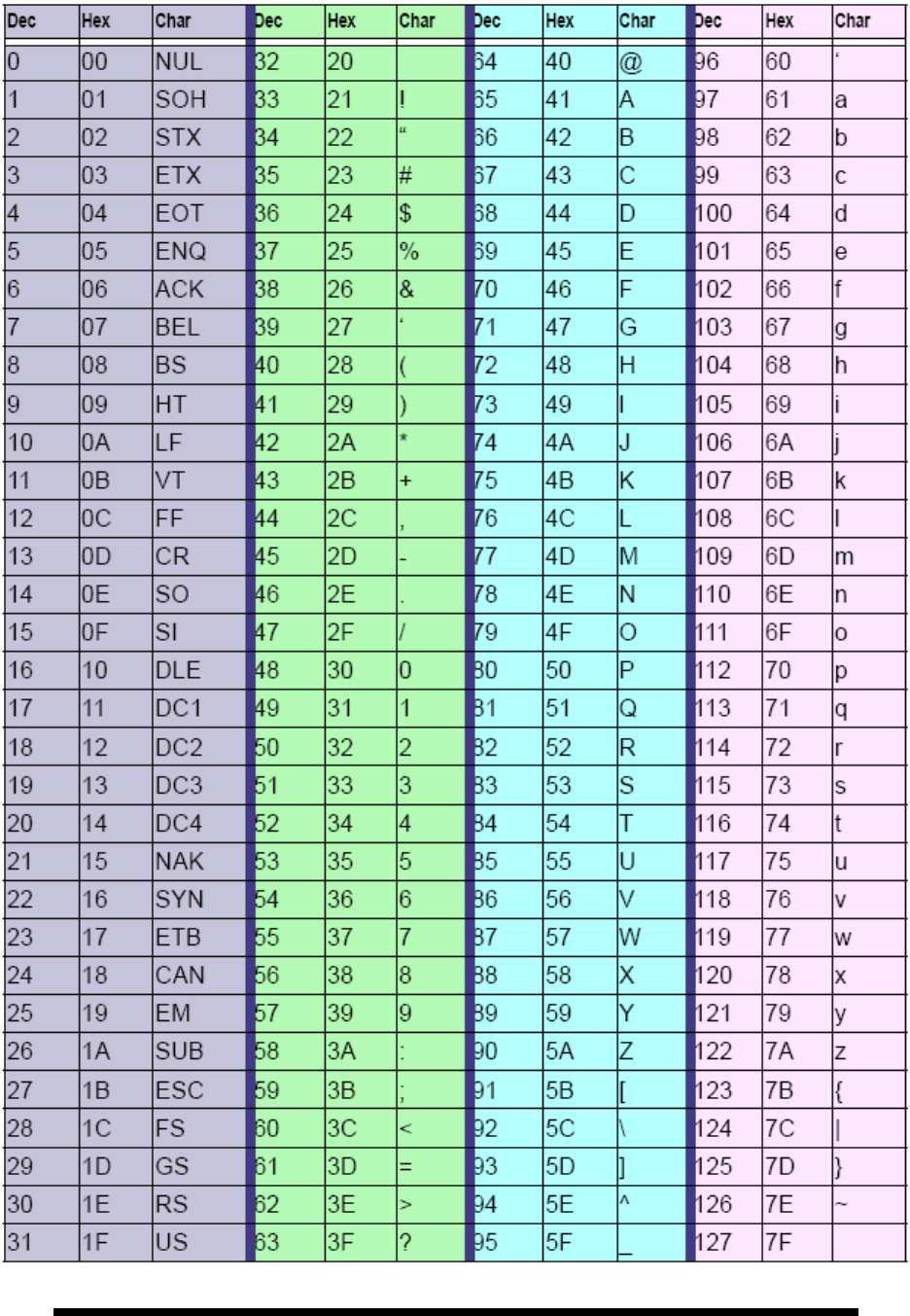
A-26
ASCII Conversion Chart (Code Page 1252)
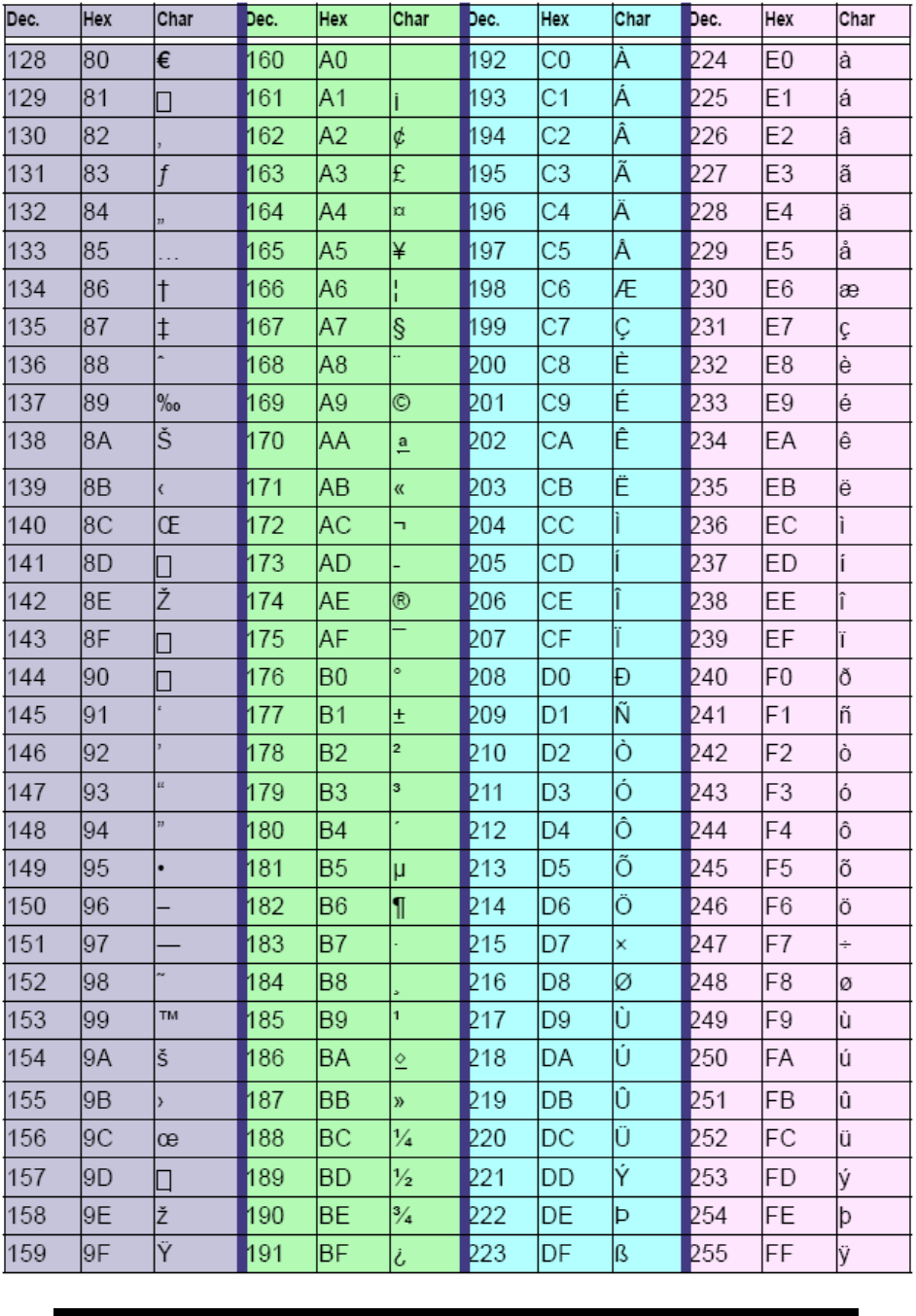
A-27
ASCII Conversion Chart (Code Page 1252)
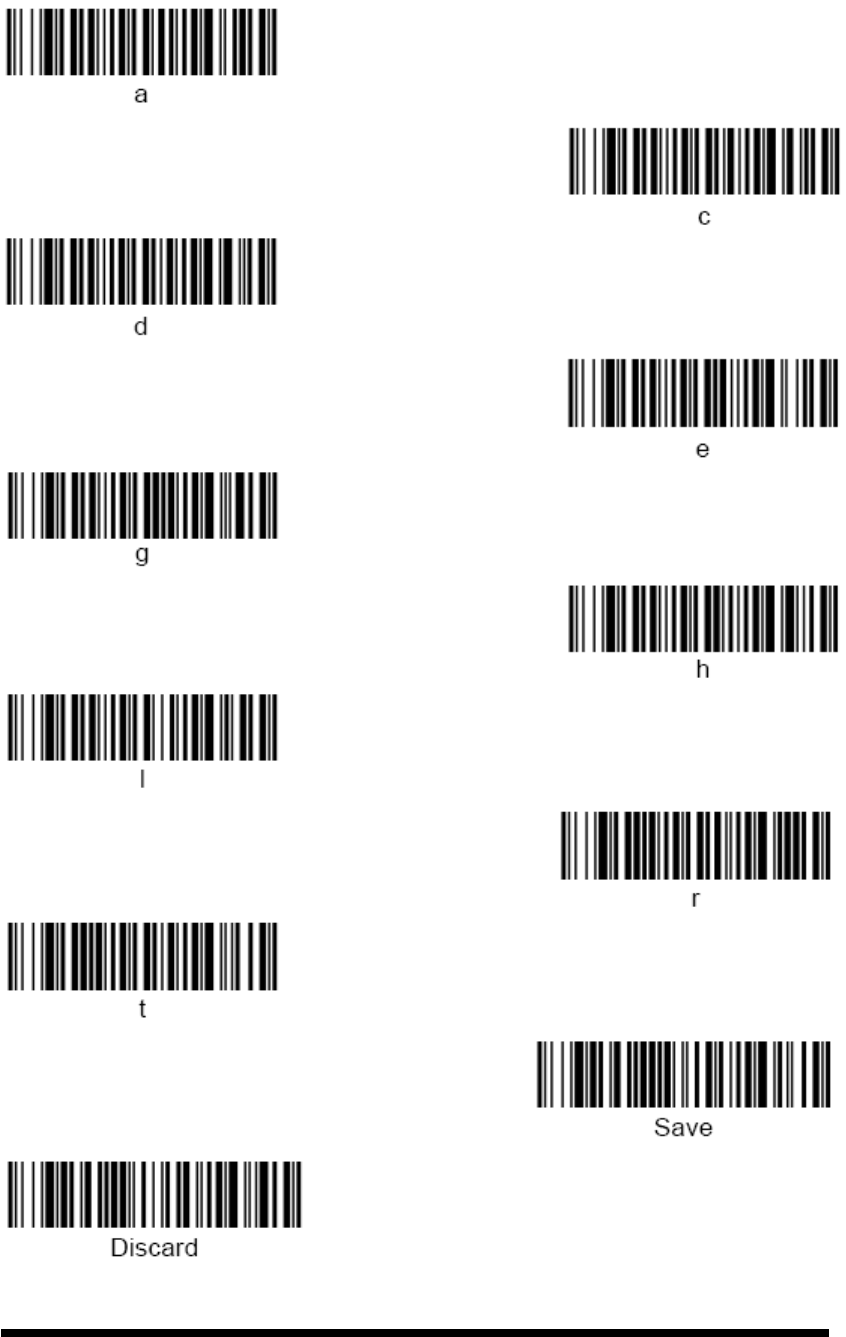
A-28
OCR Programming Chart
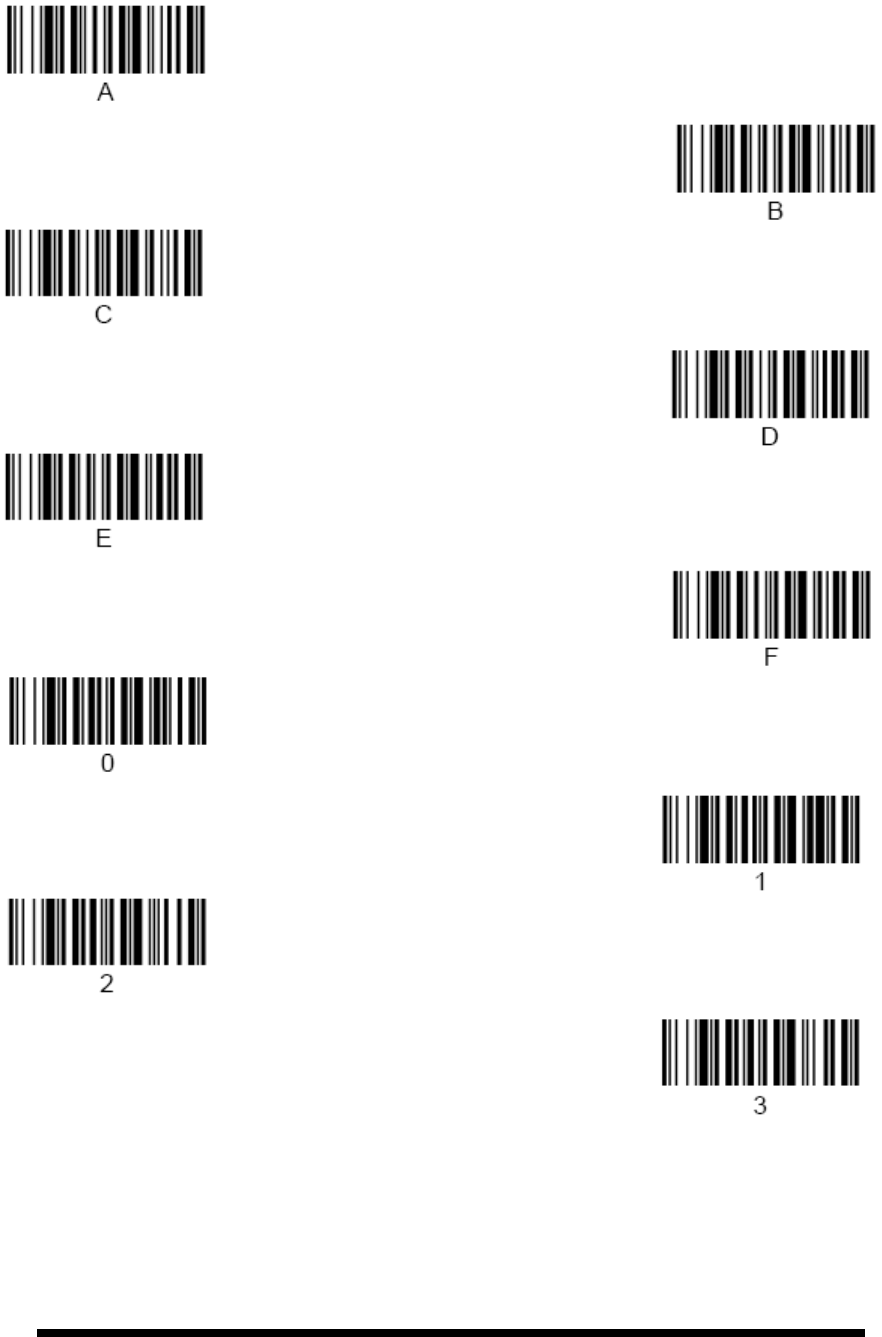
A-29
Programming Chart
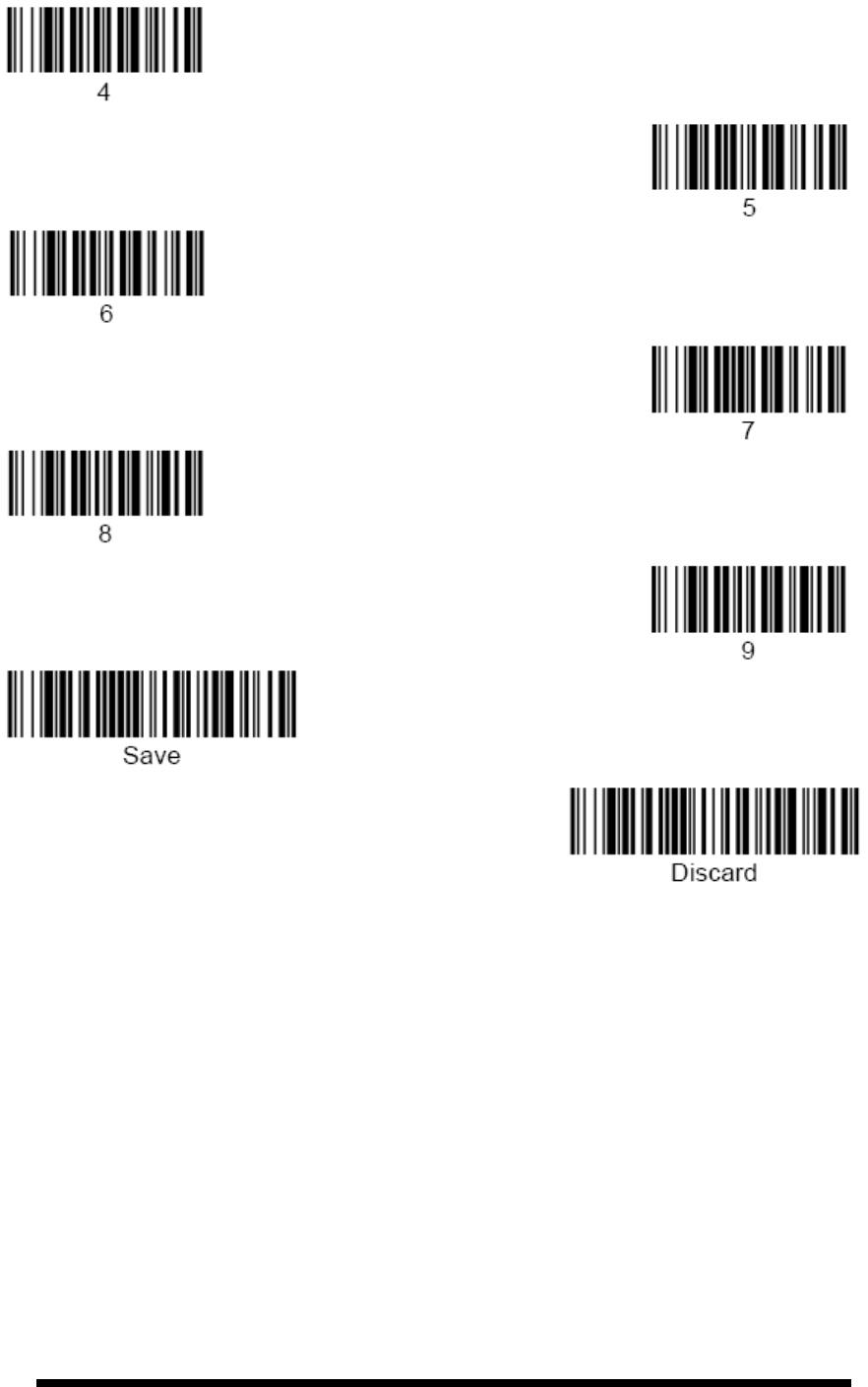
A-30
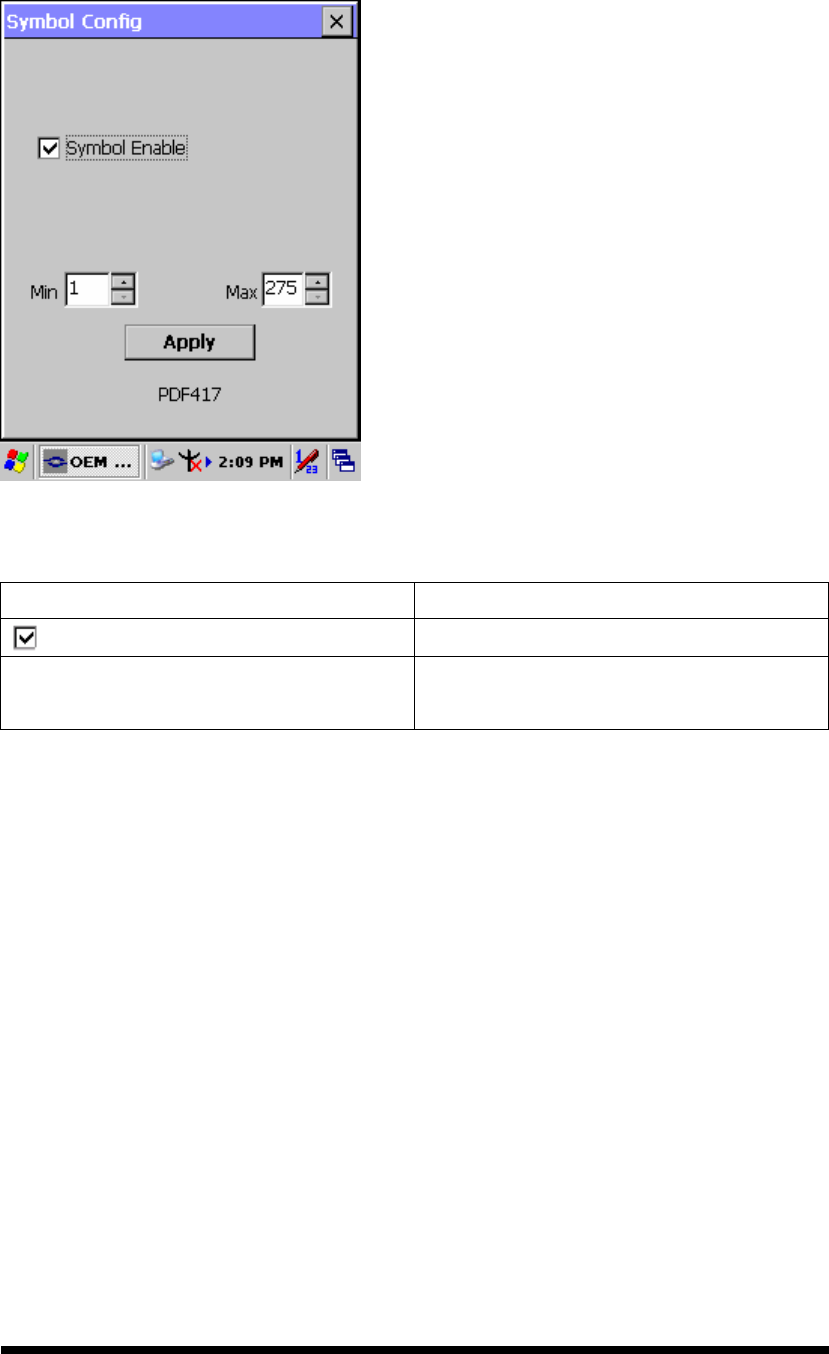
A-31
A.3.16 PDF417
Function Explaining:
Item Explaining
Symbol Enable Enable this barcode
Message Length The minimum and maximum length
ranges for the barcode are 1-2750.
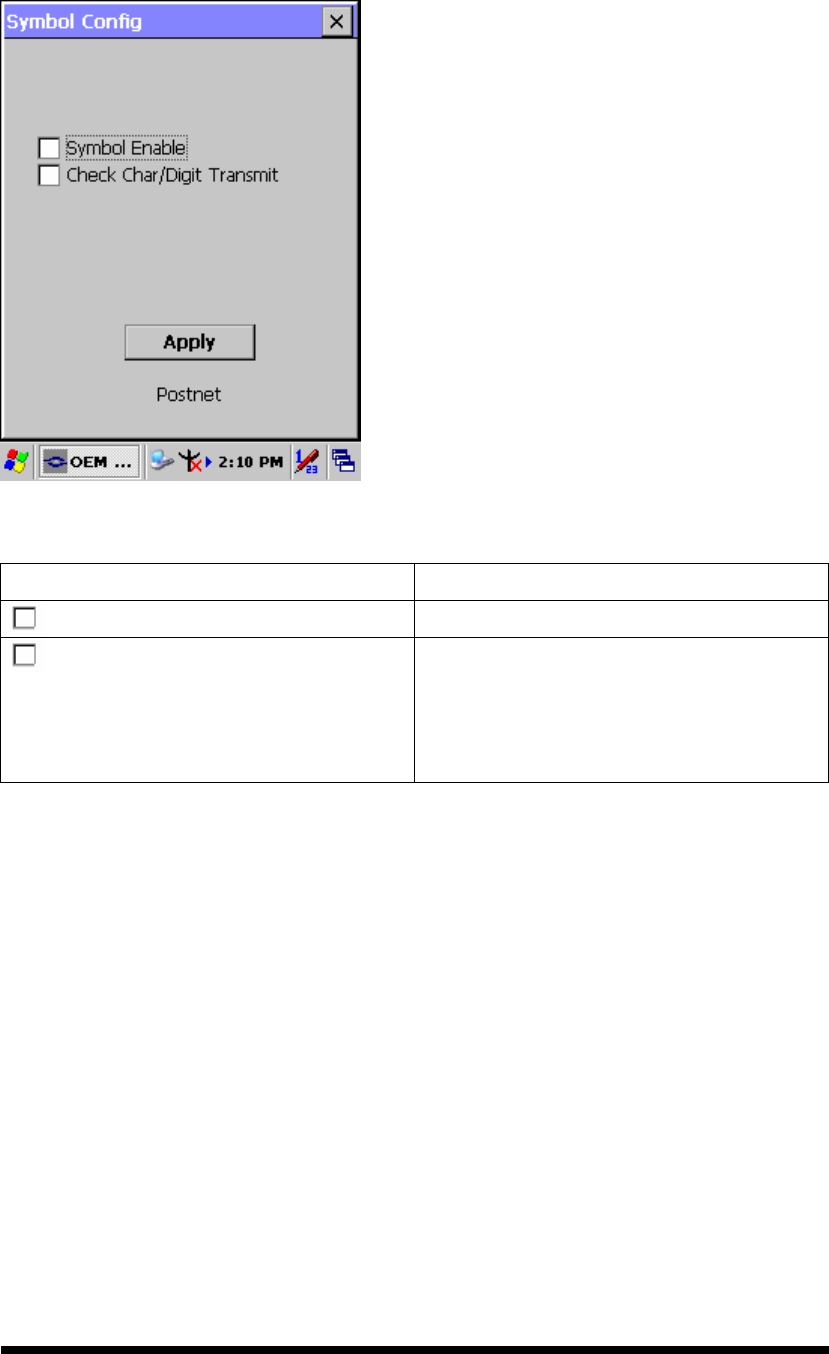
A-32
A.3.17 Postnet
Function Explaining:
Item Explaining
Symbol Enable Enable this barcode
Check Char/Digit Transmit The scanner will only read US Postnet
bar codes printed with a check character,
and will transmit this character at the
end of the scanned data.
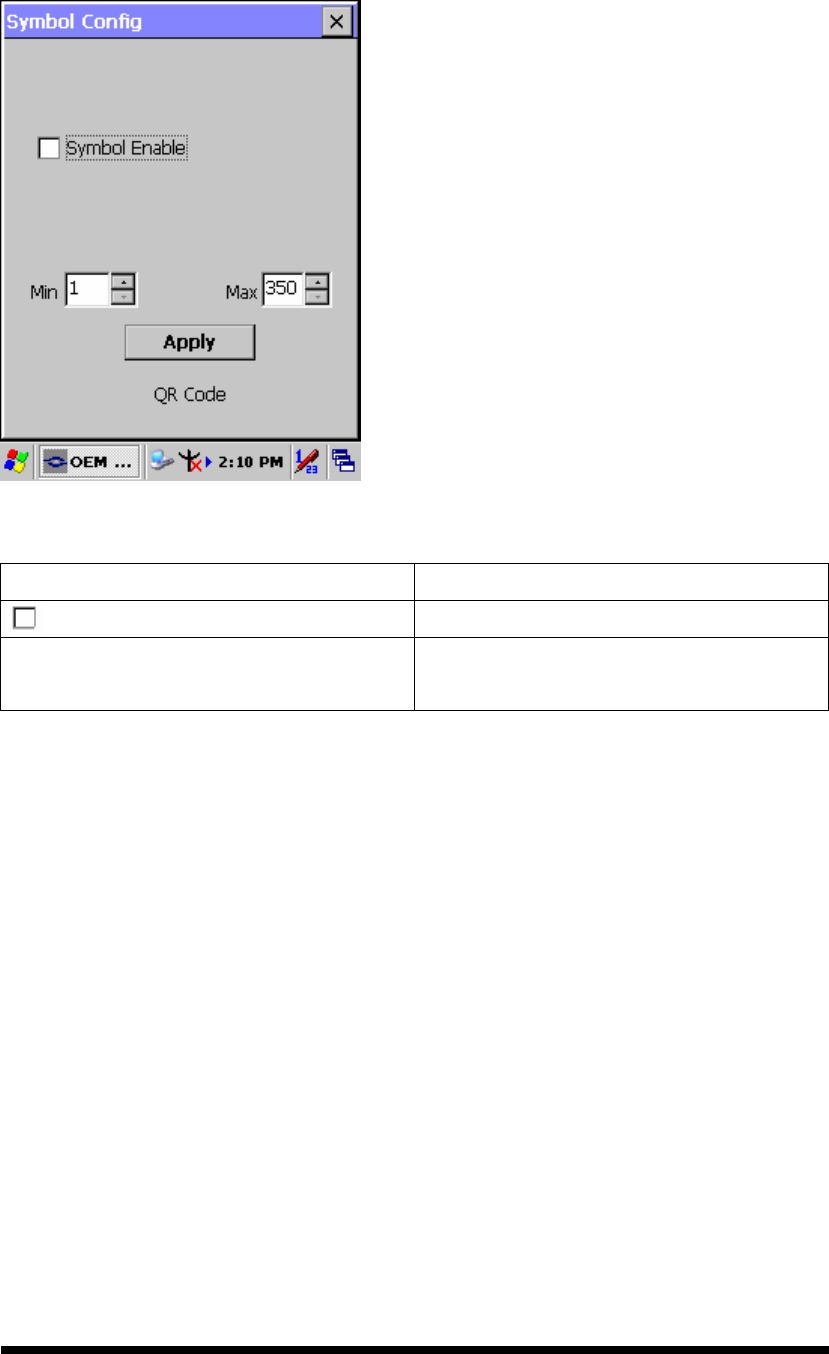
A-33
A.3.18 QR Code
Function Explaining:
Item Explaining
Symbol Enable Enable this barcode
Message Length The minimum and maximum length
ranges for the barcode are 1-3500.
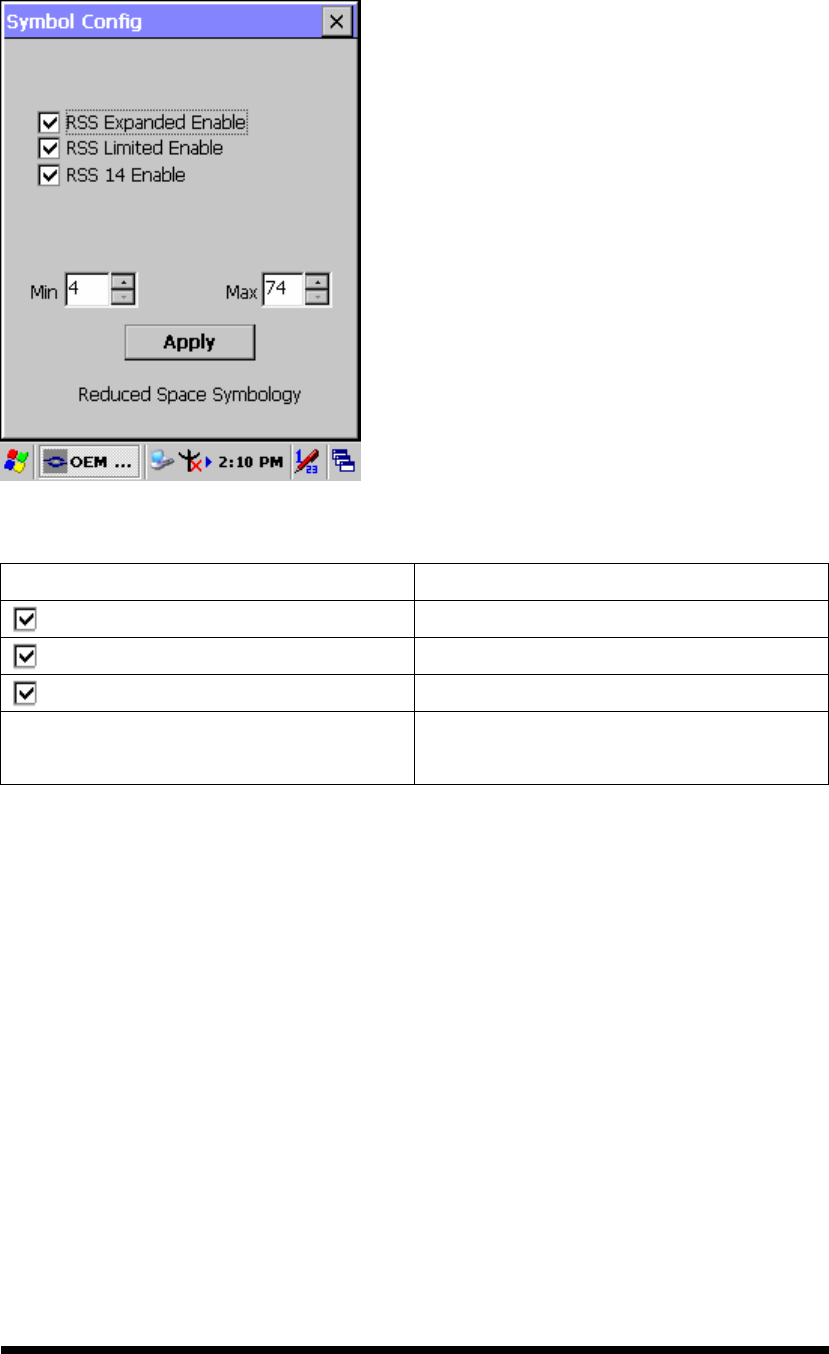
A-34
A.3.19 Reduced Space Symbology
Function Explaining:
Item Explaining
RSS Expanded Enable Enable RSS Expanded code
RSS Limited Enable Enable RSS Limited code
RSS 14 Enable Enable RSS 14 code
Message Length The minimum and maximum length
ranges for the barcode are 4-74.
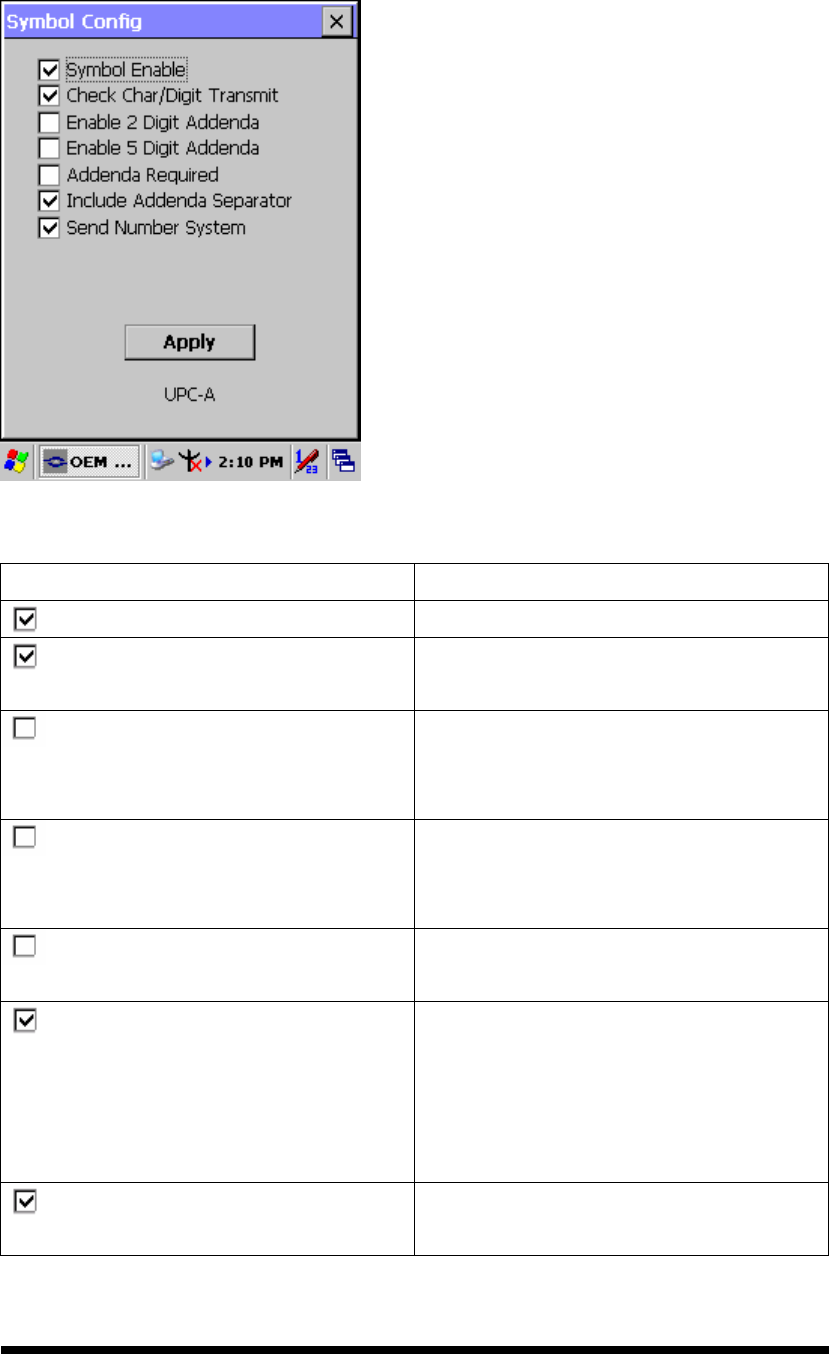
A-35
A.3.20 UPC-A
Function Explaining:
Item Explaining
Symbol Enable Enable this barcode
Check Char/Digit Transmit The output of the check digit at the end
of the scanned data.
Enable 2 Digit Addenda Option allows decoding and outputting
of a 2 digits addendum on the end of all
scanned UPC-A data.
Enable 5 Digit Addenda Option allows decoding and outputting
of a 5 digits addendum on the end of all
scanned UPC-A data.
Addenda Required Only reads UPC-A barcodes that have
addenda.
Include Addenda Separator When this feature is selected, the data is
output with a space between the data
from the main barcode and the data from
the addenda. When turned off, there is
no space.
Send Number System If you want the numeric system digit of
a UPC symbol transmitted.
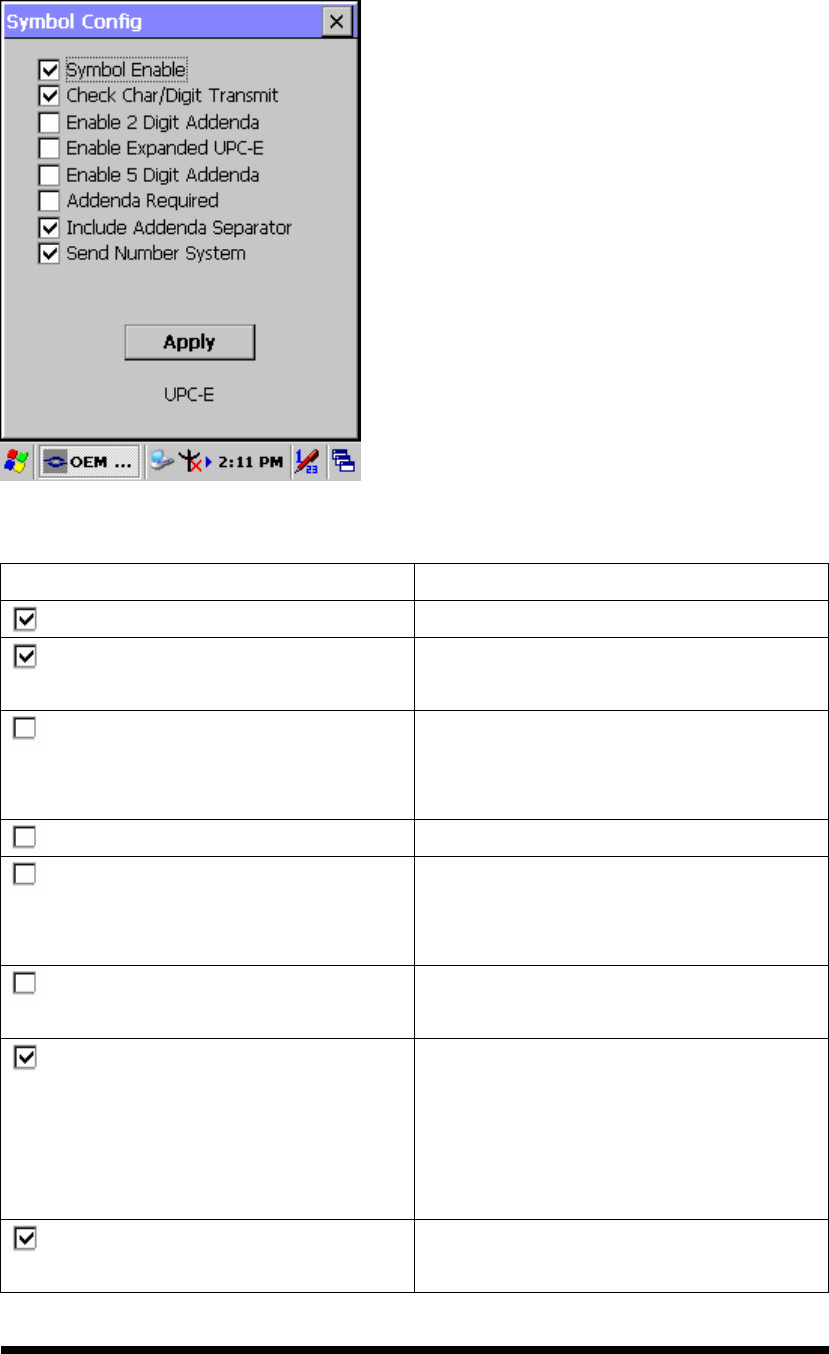
A-36
A.3.21 UPC-E
Function Explaining:
Item Explaining
Symbol Enable Enable this barcode
Check Char/Digit Transmit The output of the check digit at the end
of the scanned data.
Enable 2 Digit Addenda Option allows decoding and outputting
of a 2 digits addendum on the end of all
scanned UPC-E data.
Enable Expanded UPC-E Enable UPC-E Expanded code
Enable 5 Digit Addenda Option allows decoding and outputting
of a 5 digits addendum on the end of all
scanned UPC-E data.
Addenda Required Only reads UPC-E barcodes that have
addenda.
Include Addenda Separator When this feature is selected, the data is
output with a space between the data
from the main barcode and the data from
the addenda. When turned off, there is
no space.
Send Number System If you want the numeric system digit of
a UPC-E symbol transmitted.
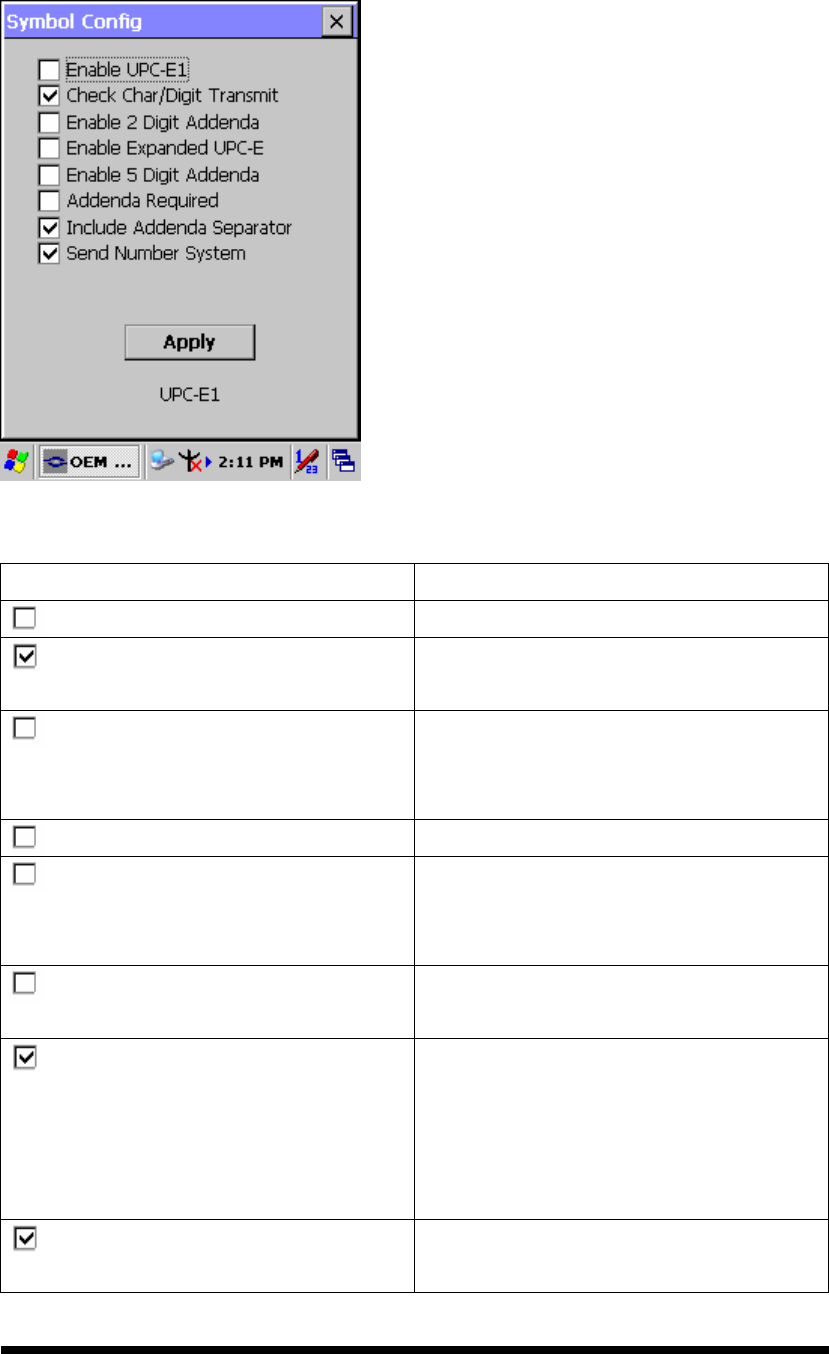
A-37
A.3.22 UPC-E1
Function Explaining:
Item Explaining
Symbol Enable Enable this barcode
Check Char/Digit Transmit The output of the check digit at the end
of the scanned data.
Enable 2 Digit Addenda Option allows decoding and outputting
of a 2 digits addendum on the end of all
scanned UPC-E1 data.
Enable Expanded UPC-E Enable UPC-E Expanded code
Enable 5 Digit Addenda Option allows decoding and outputting
of a 5 digits addendum on the end of all
scanned UPC-E1 data.
Addenda Required Only reads UPC-E1 barcodes that have
addenda.
Include Addenda Separator When this feature is selected, the data is
output with a space between the data
from the mai
n barcode and the data from
the addenda. When turned off, there is
no space.
Send Number System If you want the numeric system digit of
a UPC-E1 symbol transmitted.
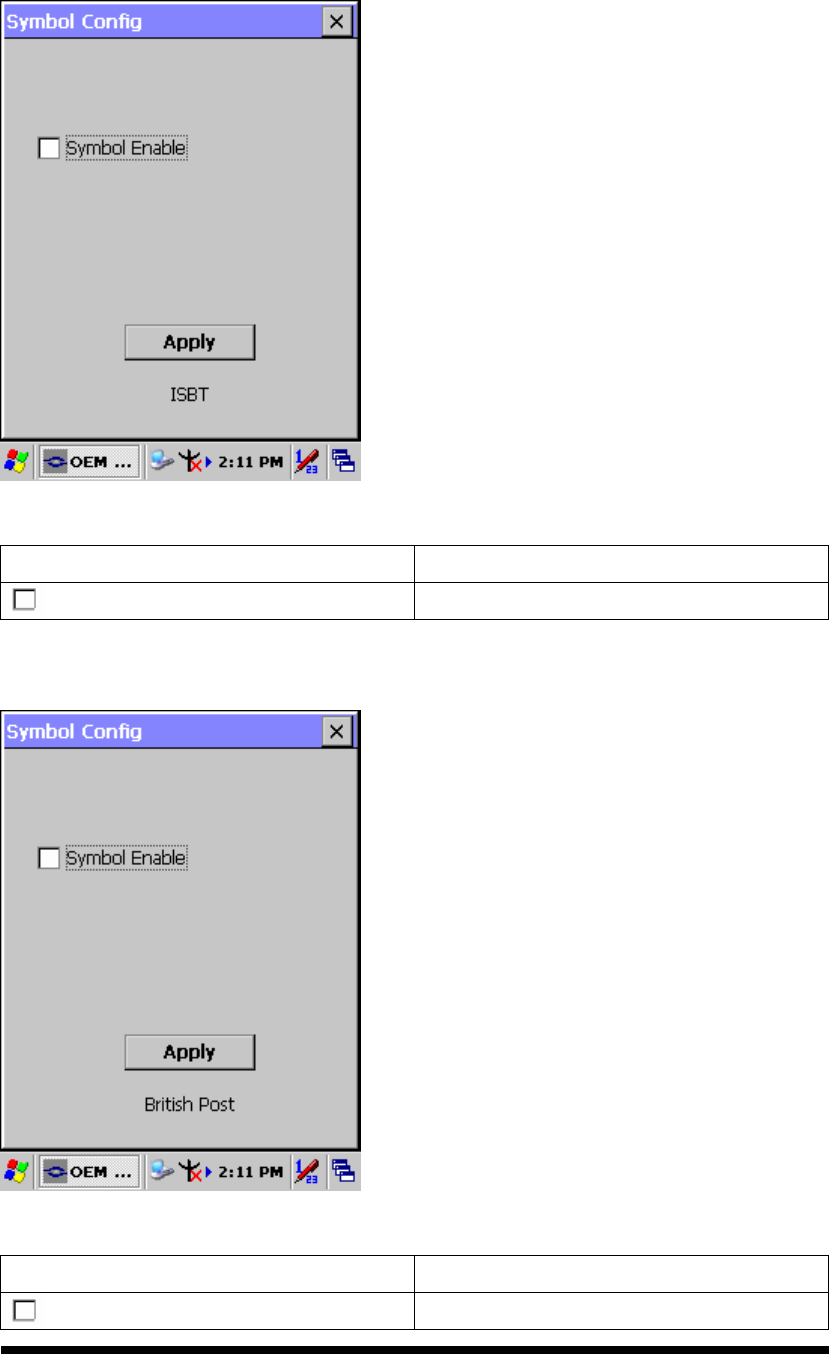
A-38
A.3.23 ISBT
Function Explaining:
Item Explaining
Symbol Enable Enable this barcode
A.3.24 British Post
Function Explaining:
Item Explaining
Symbol Enable Enable this barcode
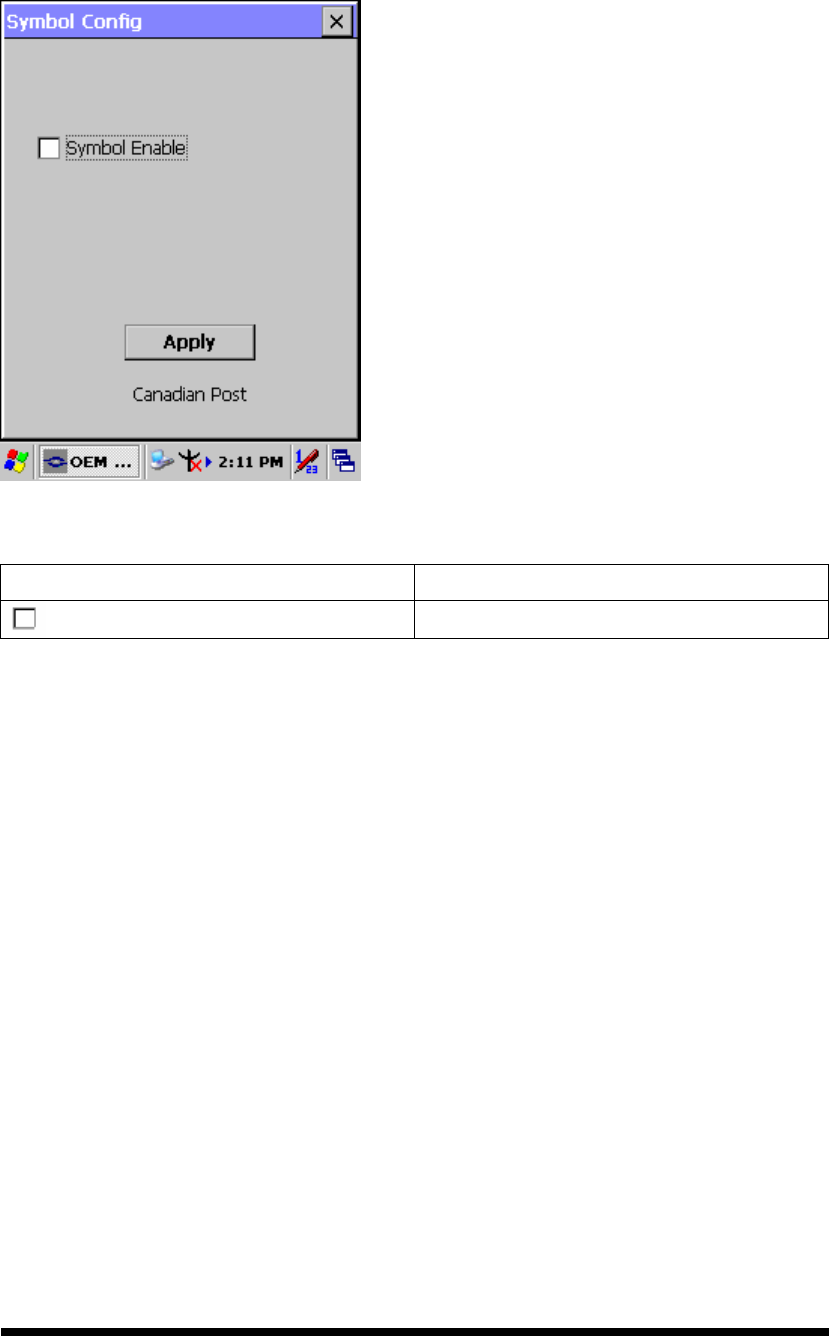
A-39
A.3.25 Canadian Post
Function Explaining:
Item Explaining
Symbol Enable Enable this barcode
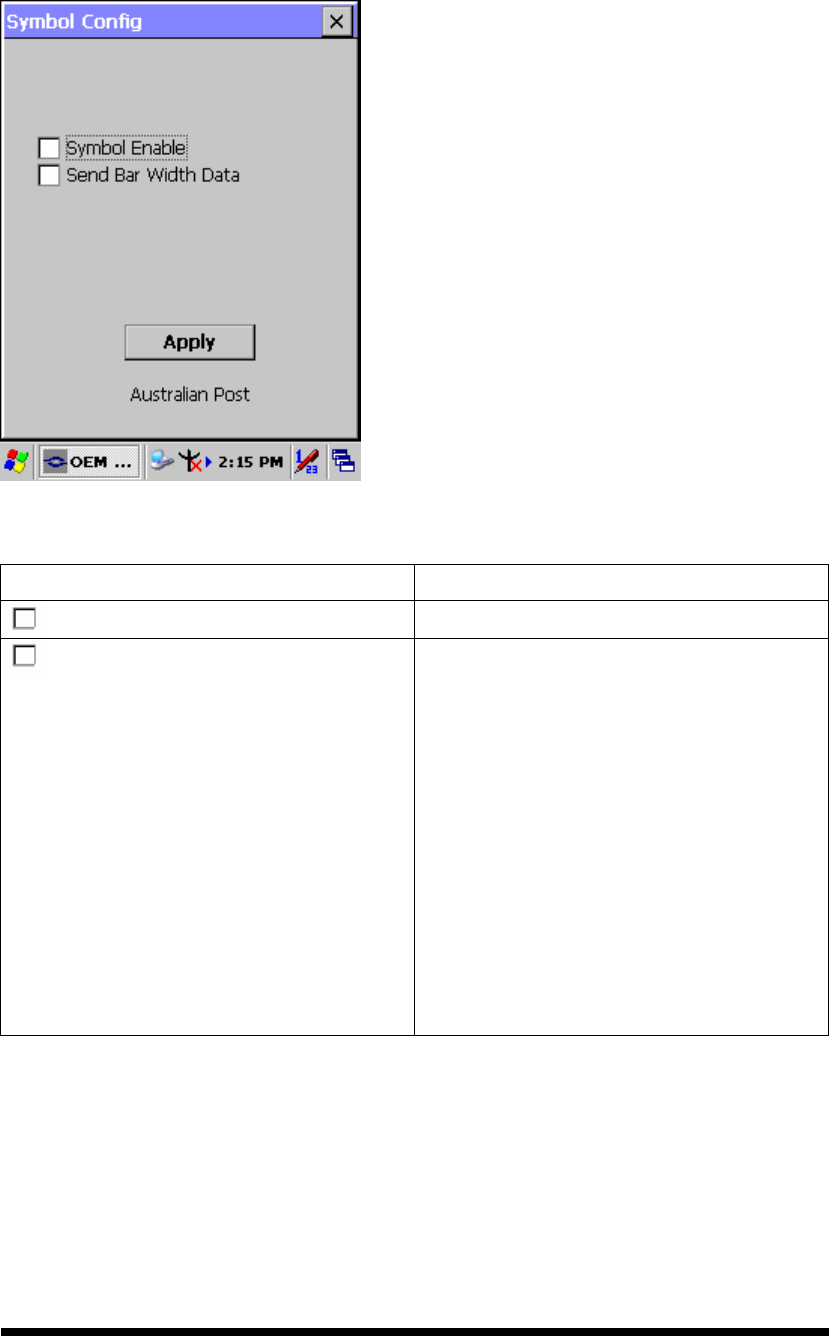
A-40
A.3.26 Australian Post
Function Explaining:
Item Explaining
Symbol Enable Enable this barcode
Send Bar Width Data Australian Post is a 4-state symbology
that was designed with a non-defined
user area. The user can define how that
area field is interpreted. Most systems
have dedicated decoders that don’t know
how to decode a symbology that is not
defined. If you select the Send Bar
Width Data, the bar levels will be
outputted (0-3 for the four states) so that
the receiving device can then decode
appropriately.
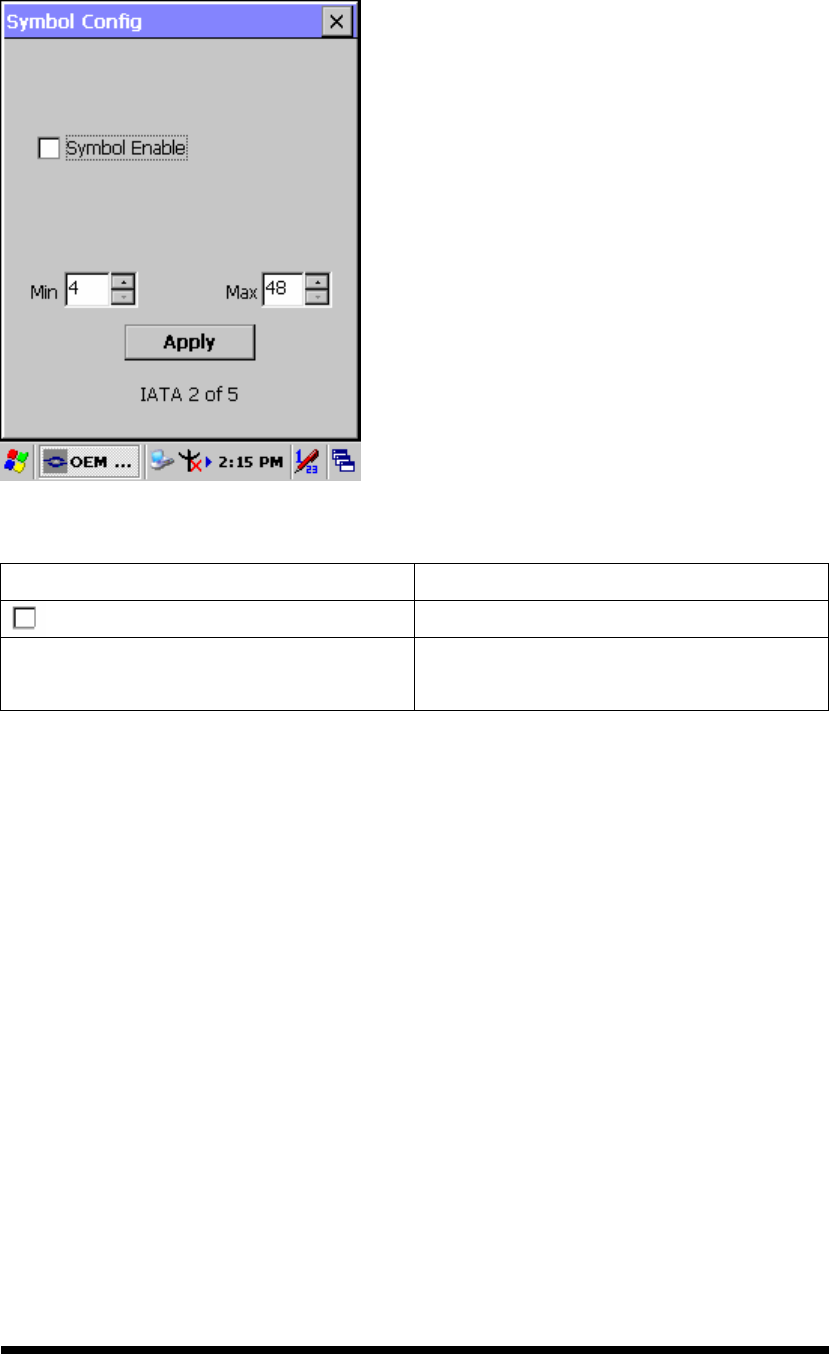
A-41
A.3.27 IATA 2 of 5
Function Explaining:
Item Explaining
Symbol Enable Enable this barcode
Message Length The minimum and maximum length
ranges for the barcode are 1-48.
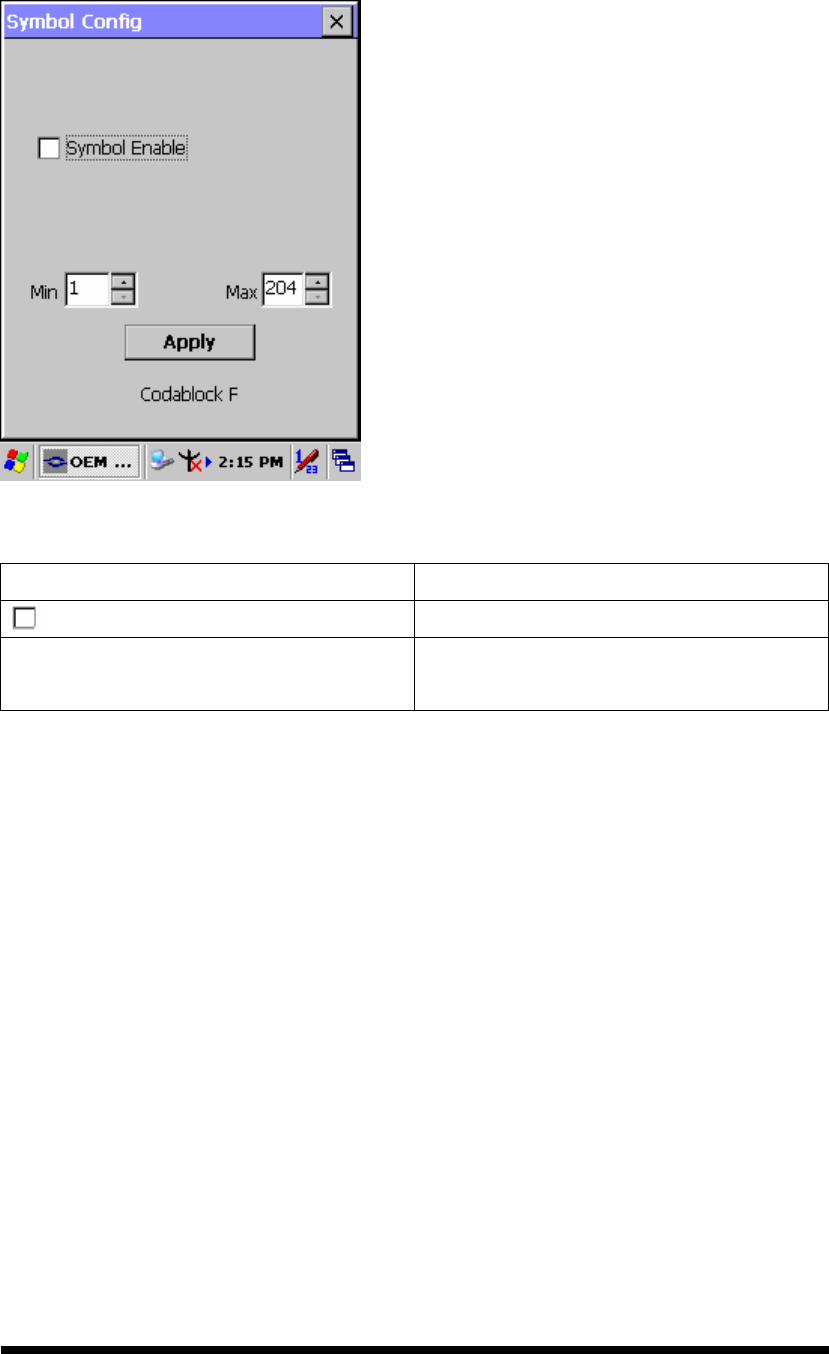
A-42
A.3.28 Codablock F
Function Explaining:
Item Explaining
Symbol Enable Enable this barcode
Message Length The minimum and maximum length
ranges for the barcode are 1-2048.
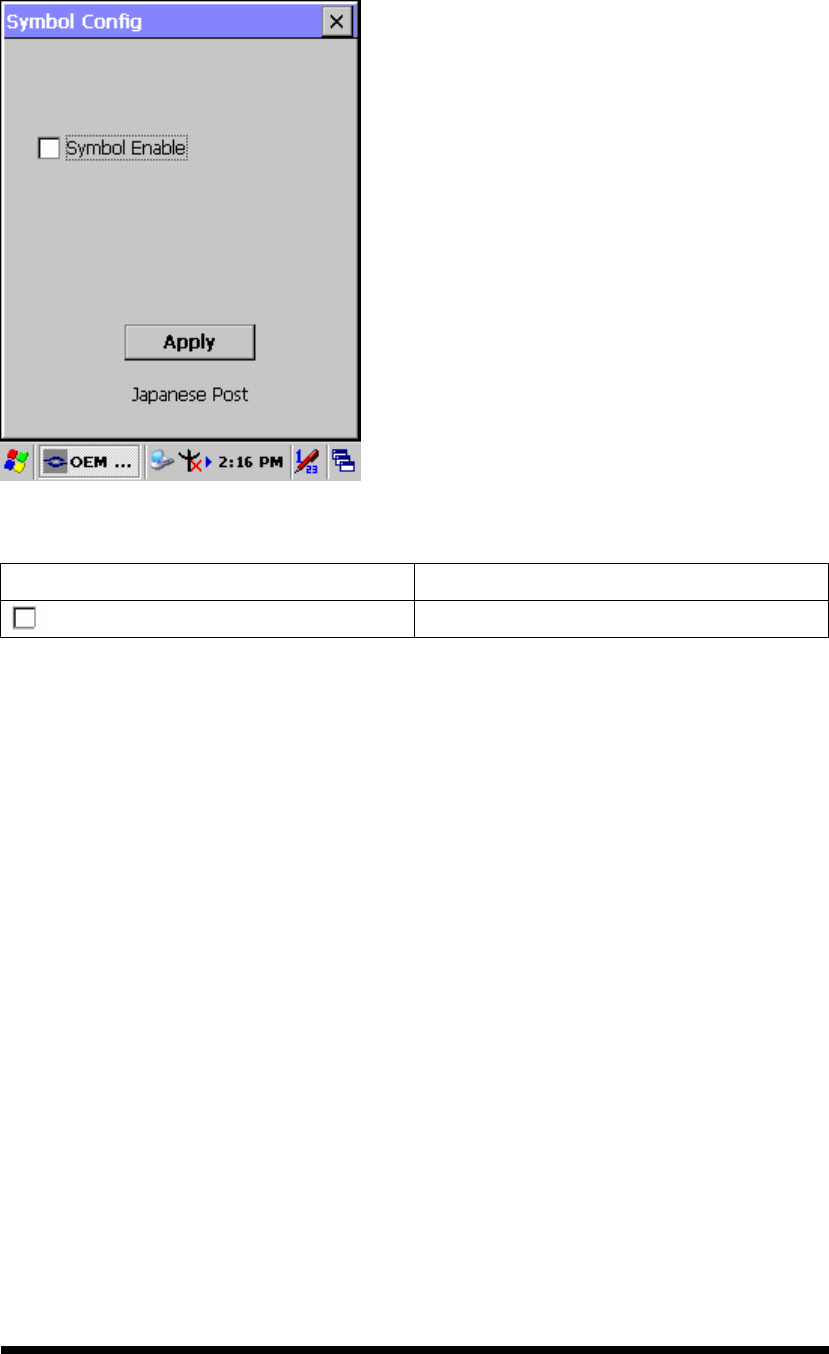
A-43
A.3.29 Japanese Post
Function Explaining:
Item Explaining
Symbol Enable Enable this barcode
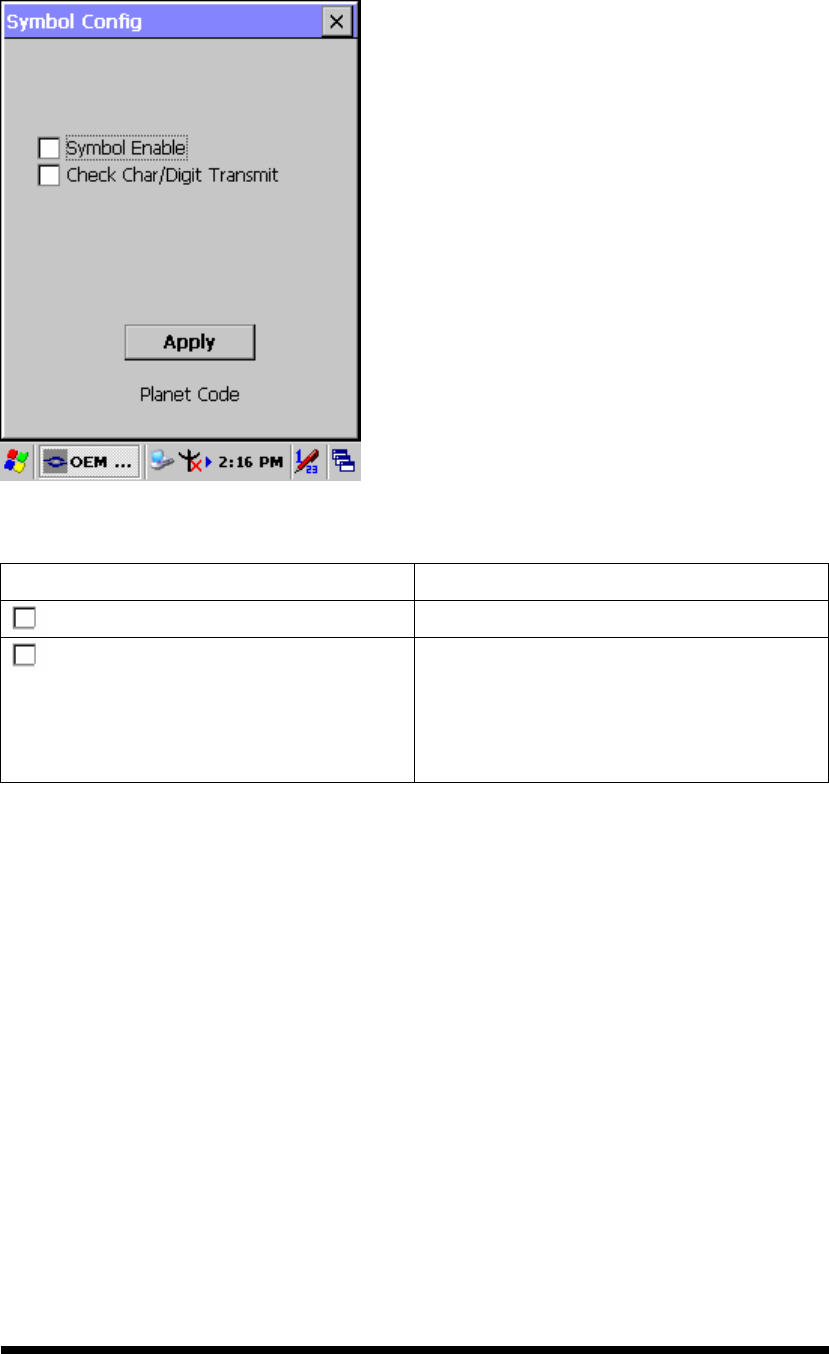
A-44
A.3.30 Planet Code
Function Explaining:
Item Explaining
Symbol Enable Enable this barcode
Check Char/Digit Transmit The scanner will only read Planet
barcodes printed with a check character,
and will transmit this character at the
end of the scanned data.
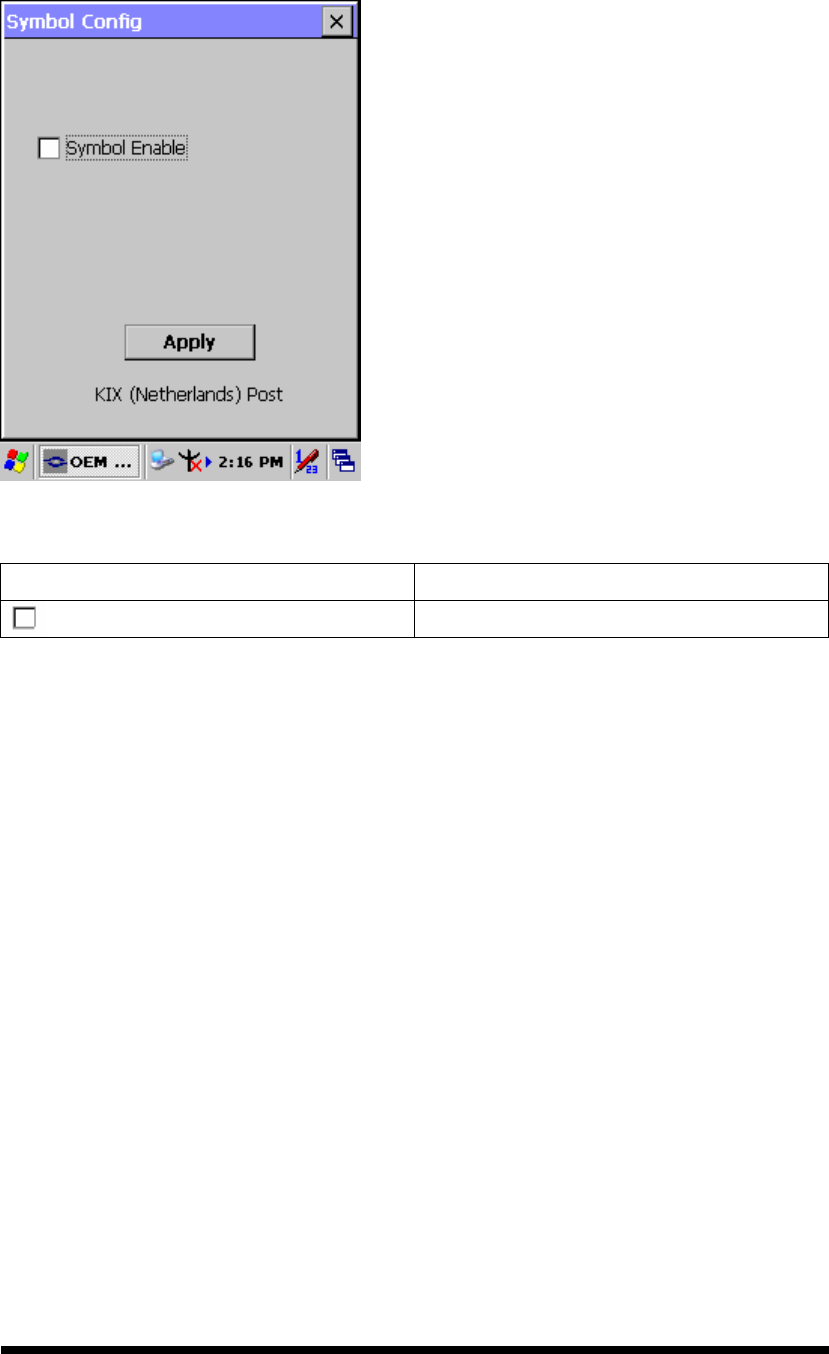
A-45
A.3.31 KIX (Netherlands) Post
Function Explaining:
Item Explaining
Symbol Enable Enable this barcode
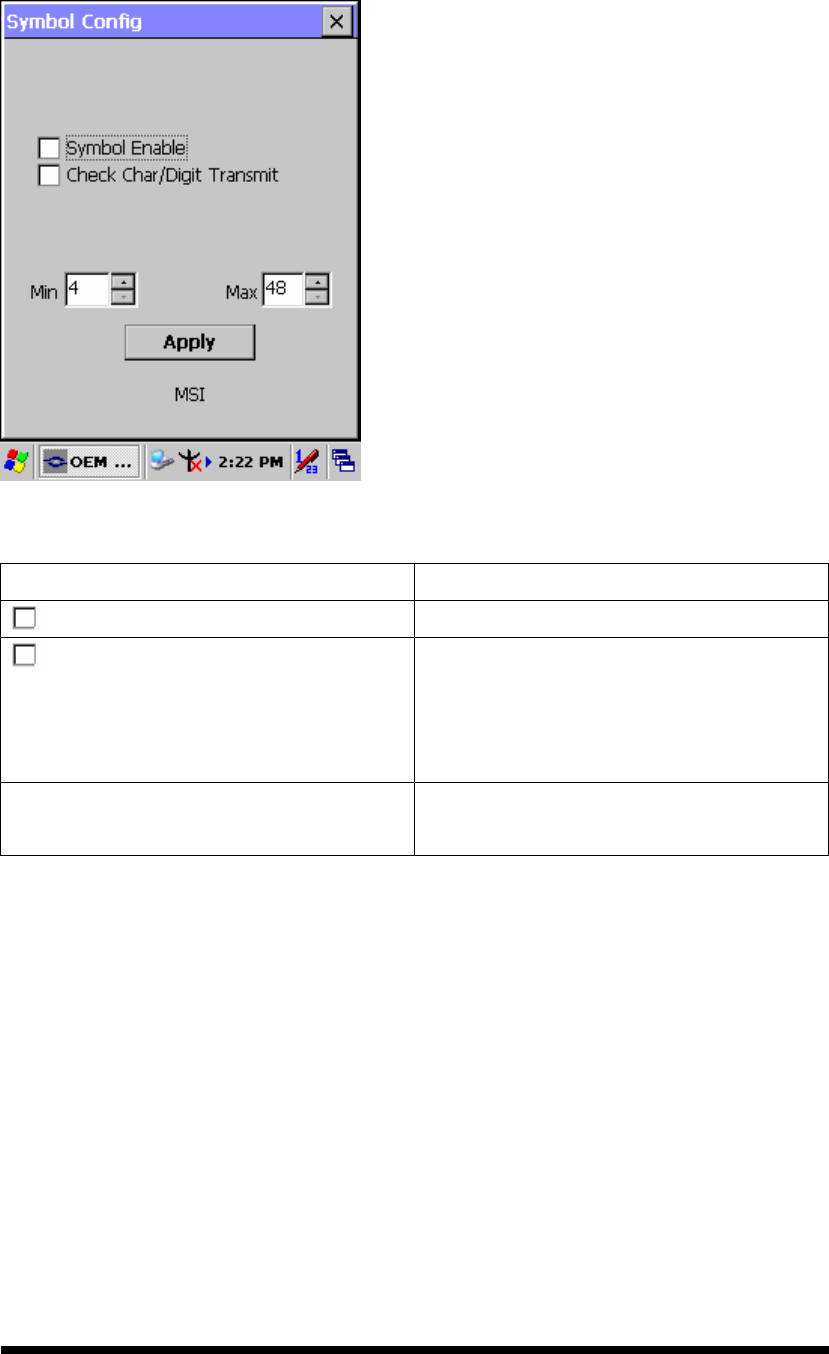
A-46
A.3.32 MSI
Function Explaining:
Item Explaining
Symbol Enable Enable this barcode
Check Char/Digit Transmit The scanner will only read MSI
barcodes printed with a check character,
and will transmit this character at the
end of the scanned data.
Message Length The minimum and maximum length
ranges for the barcode are 4-48.
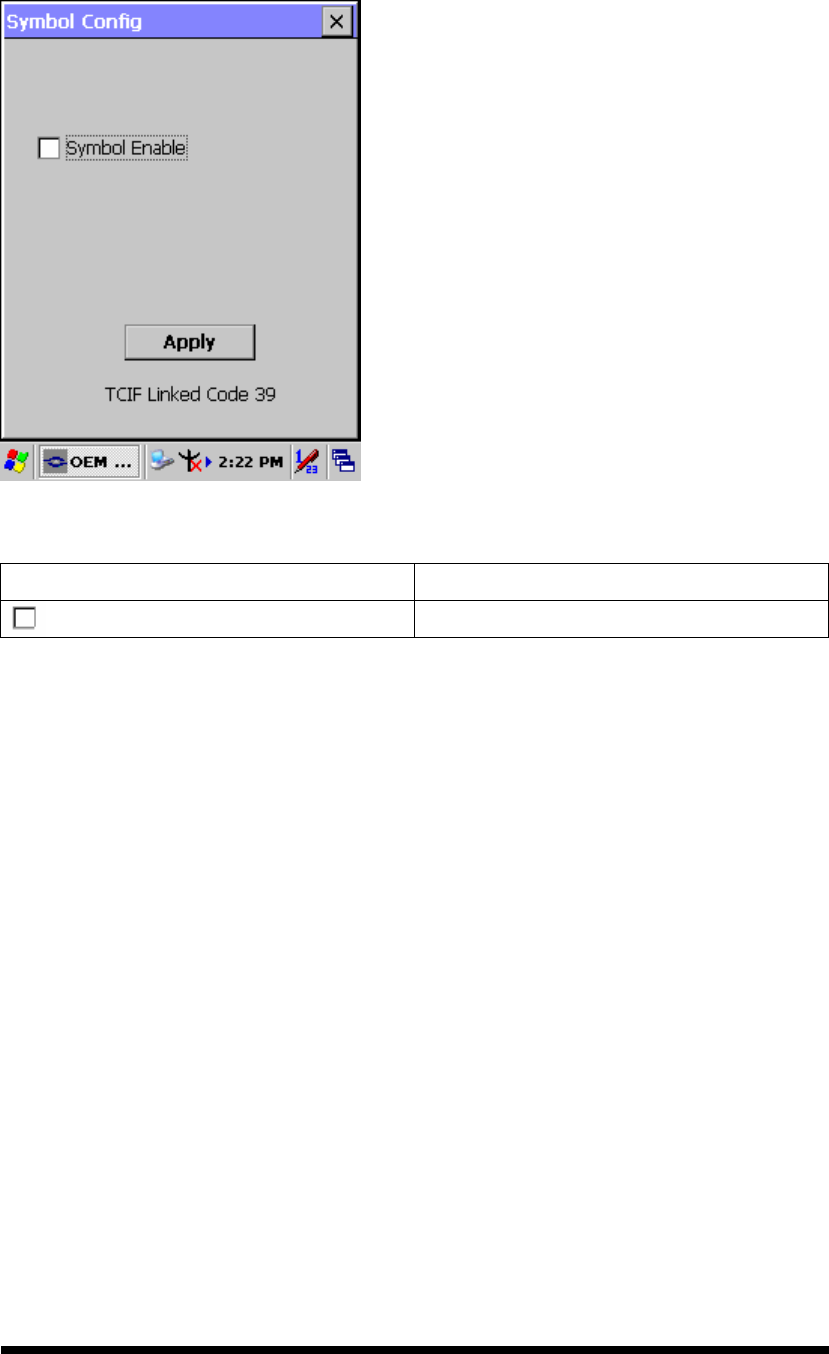
A-47
A.3.33 TCIF Linked Code 39
Function Explaining:
Item Explaining
Symbol Enable Enable this barcode
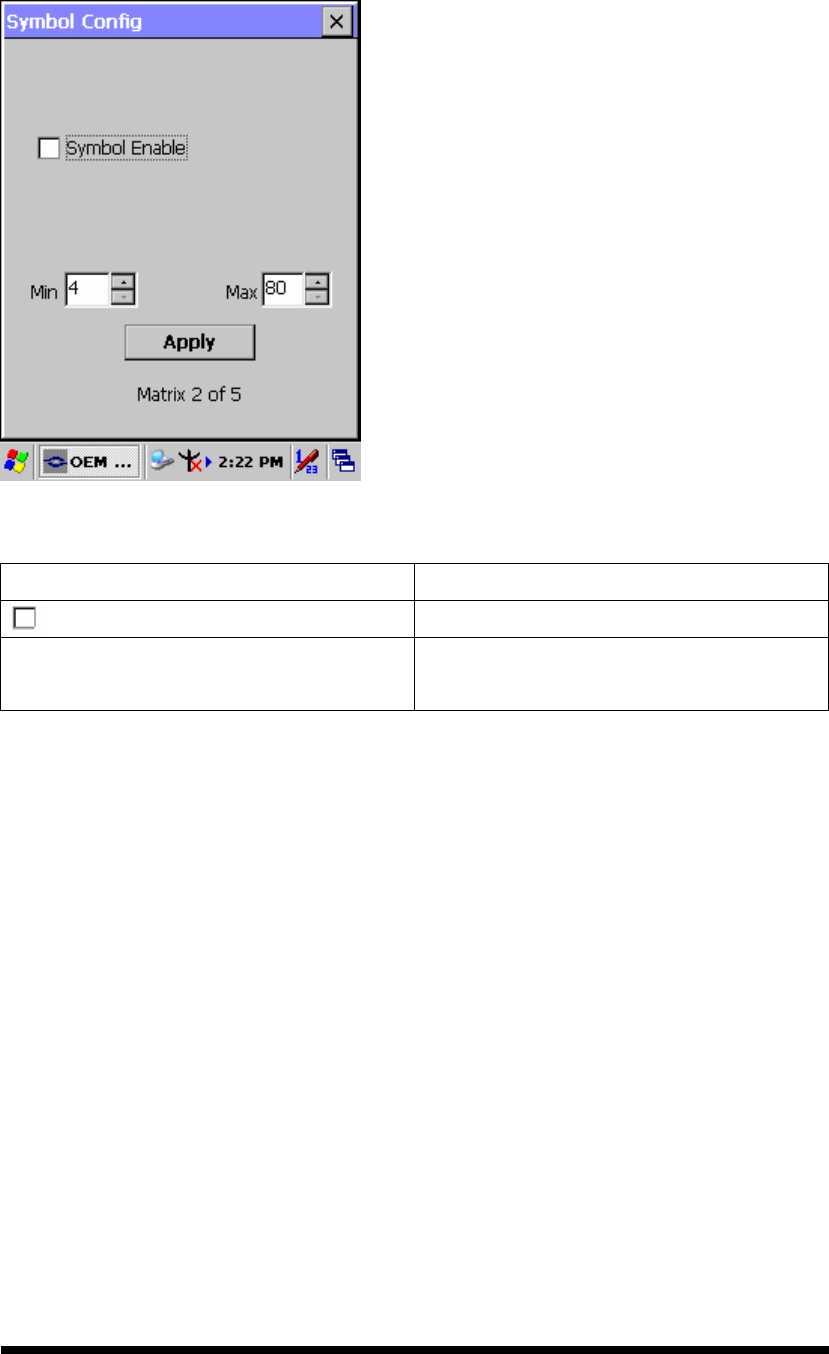
A-48
A.3.34 Mayrix 2 of 5
Function Explaining:
Item Explaining
Symbol Enable Enable this barcode
Message Length The minimum and maximum length
ranges for the barcode are 1-80.
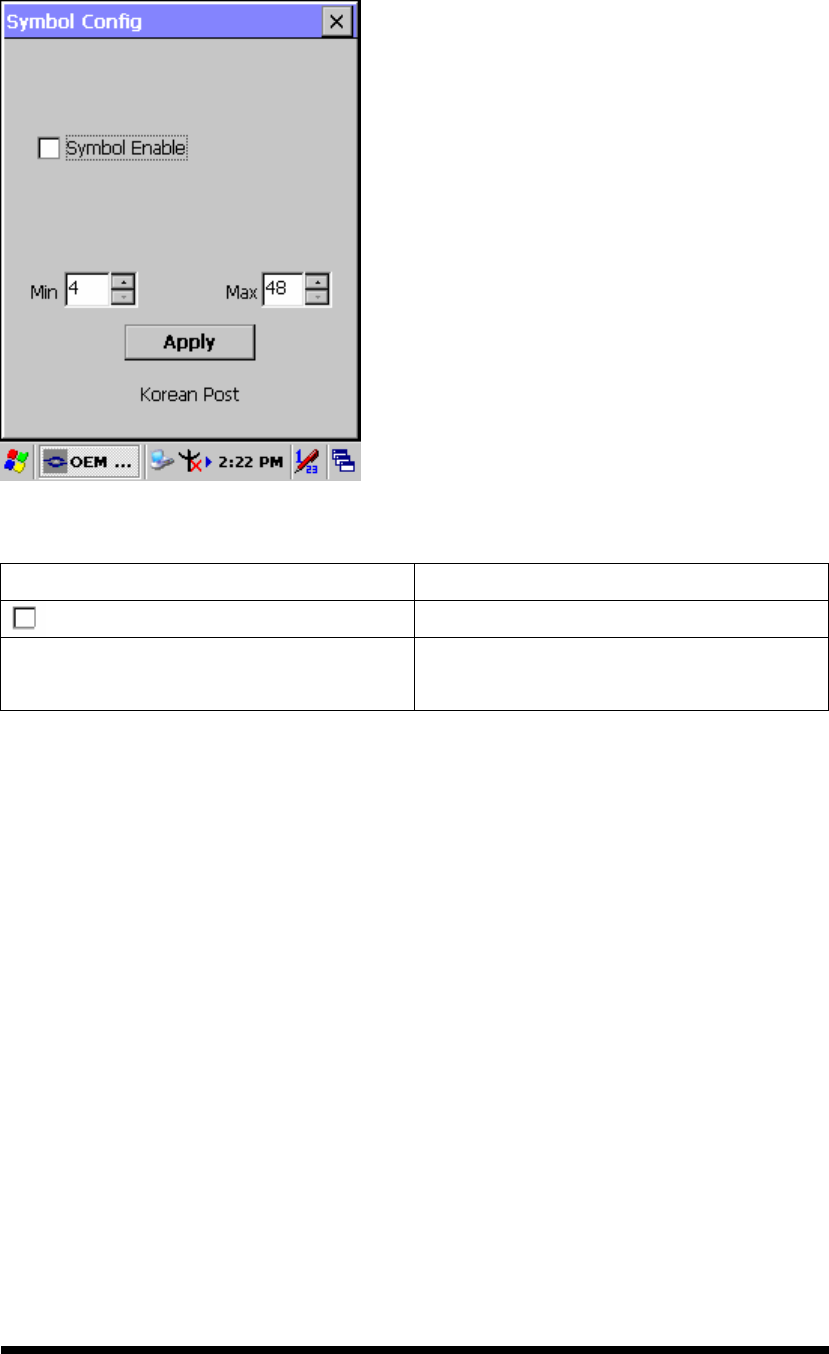
A-49
A.3.35 Korean Post
Function Explaining:
Item Explaining
Symbol Enable Enable this barcode
Message Length The minimum and maximum length
ranges for the barcode are 2-80.

B-1
Appendix B Phone Tools
(GSM/GPRS)
B.1 Using the Phone Features
Use the PDT to make and receive telephone calls and send and receive SMS (Short
Message Service) messages.
Your mobile phone service provider may provide other useful services such as voice
mail.
The phone can also be used to connect to an Internet Service Provider (ISP) or work
network so you can browse the Web and read e-mail. You can connect to the Internet
or work network over GPRS (General Packet Radio Service), or you can use GSM
(Global System for Mobile Communications) for dial-up access.
B.1.1 SIM Card
A SIM (Subscriber Identity Module) card is required to operate the phone features on
your PDT. The SIM card is a plastic card embedded with a computer chip that stores
and transacts data. After the SIM card is activated by your mobile phone service
provider, the computer chip will contain information about your phone number,
service, registration information, and contacts, as well as memory to store speed dial
numbers and text or SMS messages that you receive.
With the exception of emergency calls, the SIM card must be inserted into the SIM
slot under the battery on the back of the PDT in order for voice/data calls to work.
To dial an emergency number, from the Phone keypad, tap the emergency number
appropriate for your region, and then tap Talk or Send.
Note: See your local telephone directory for emergency numbers used in your area.
B.1.2 Inserting a SIM Card
Note: If the battery is already installed, you must remove it before inserting the SIM
card.
To insert the SIM card into the PDT:
1. Remove the 4 screws from the GSM End Cap with a screw driver, Torx type and
size 8 (T8). And then remove the GSM End Cap.
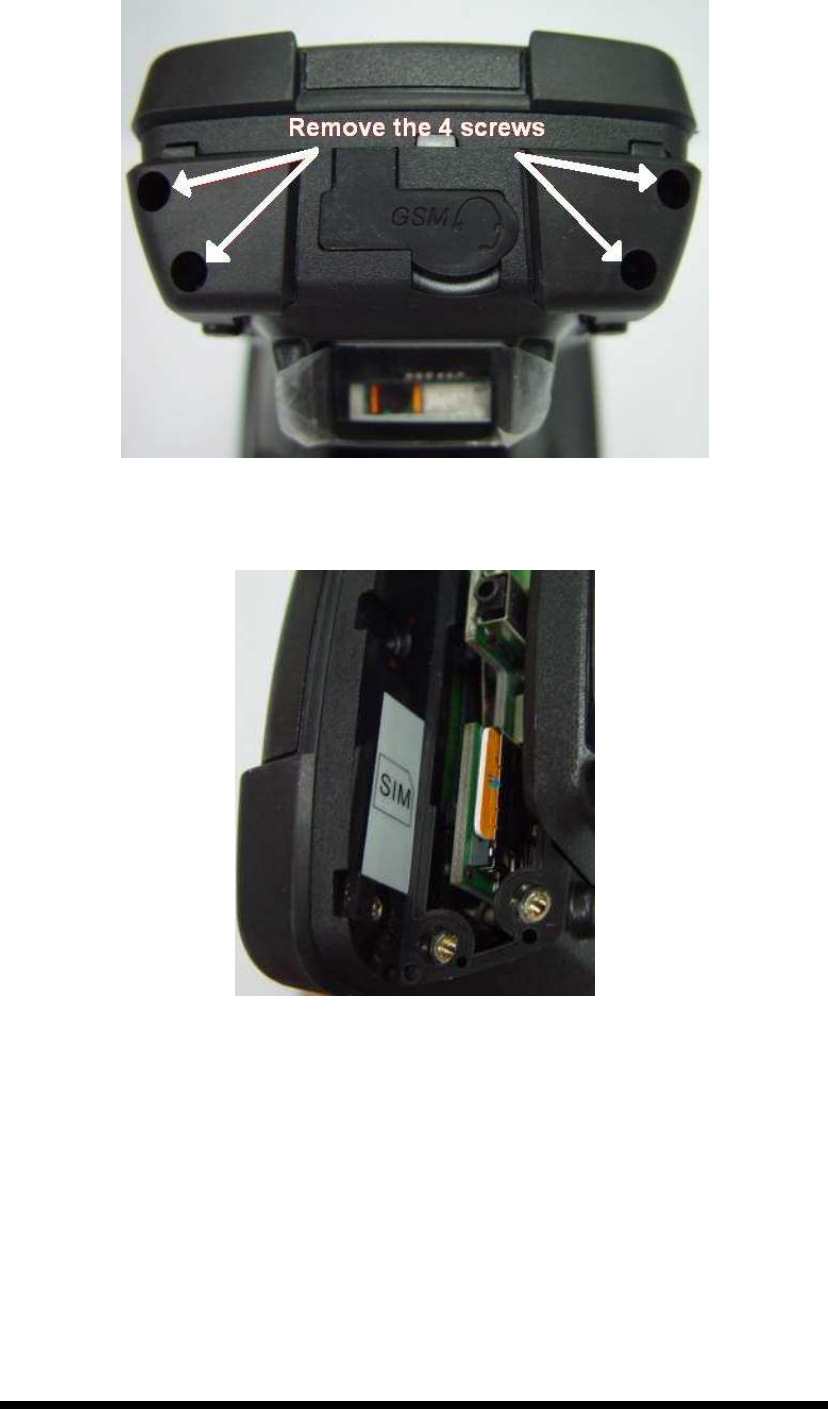
B-2
2. Insert the SIM card (with the gold side facing the inside of the slot) into the SIM
slot.
3. Using 4 ~ 4.5 kgf-cm torque to fix the screws for GSM End Cap.
Note: Repeat the same steps to remove the SIM card from the SIM tray.
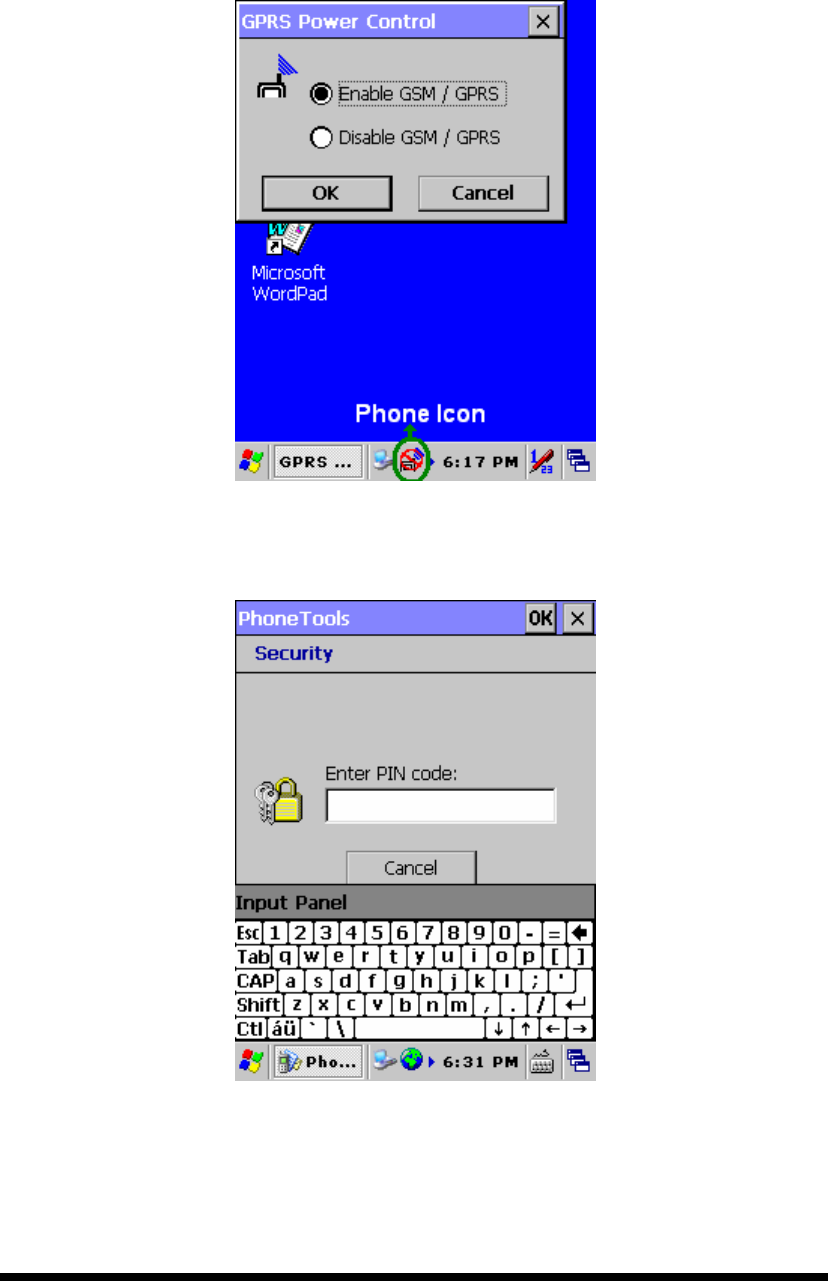
B-3
B.1.3 Start Before:
1. You need to tap the phone icon in the system tray twice.
2. It opens a GPRS power control window.
3. You need to select Enable GSM/GPRS and tap the OK button.
4. Thereafter you might need to input a PIN code and tap the OK button if you have
setting the PIN code.
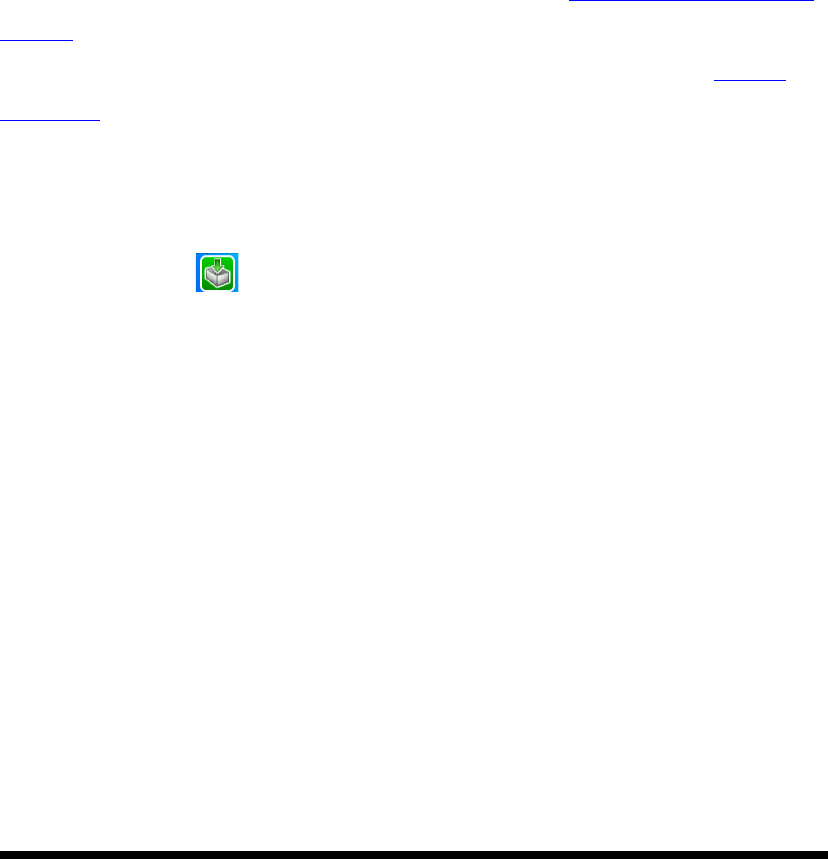
B-4
B.2 Interface layout
Depending on options available and the capabilities of your PDT, the main interface
enables you to:
- Look up all your messages using the Inbox, Outbox and Sent icons.
- Create and send SMS messages.
- Make a phone call using the Dialer, which also enables you to access SMS
functions.
- Manage several Phonebooks.
- Navigate the Internet.
Notes:
When you start the application for the first time, the communication settings
configuration screen is displayed automatically. You will not be able to access the
main interface until these settings have been specified. See selecting communication
settings.
Actions, such as sending SMS, can be directly driven from the system. See System
extensions.
B.2.1 Looking up messages
Inbox
Clicking the Inbox icon displays a list of all messages received at the center of
the screen. Unread messages on this list appear in bold. The content of the selected
message is displayed in the lower frame.
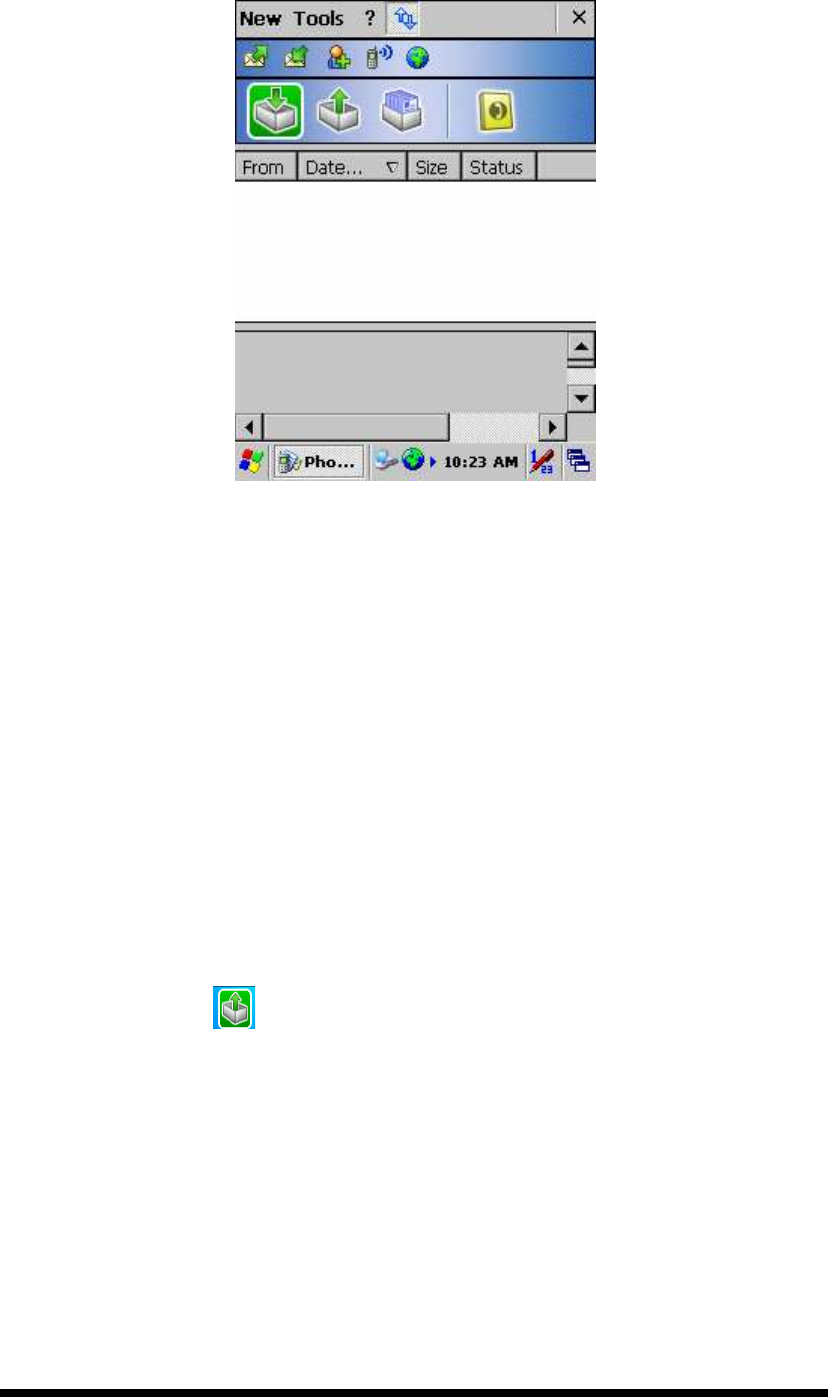
B-5
Depending on the type of message, in order to send, see properties, move, resend,
display, annotate or delete a message on the list:
1. Select the message and hold the selection with the stylus for a few seconds until
a context menu is displayed.
2. Select the desired option.
3. Depending on the option selected, follow the usual procedure or click Cancel or
the OK icon, located in the top right-hand corner of the screen, to return to the
main interface.
To collect your messages, click on the Tools menu, then select Retrieve SMS from
the list that shows up. Messages received are placed in the Inbox automatically.
Outbox
Clicking the Outbox icon displays a list of all messages sent at the center of the
screen. The message content is displayed in the lower frame. This is a listing of
messages waiting to be sent or sent from the application as well as those downloaded
from your mobile phone.
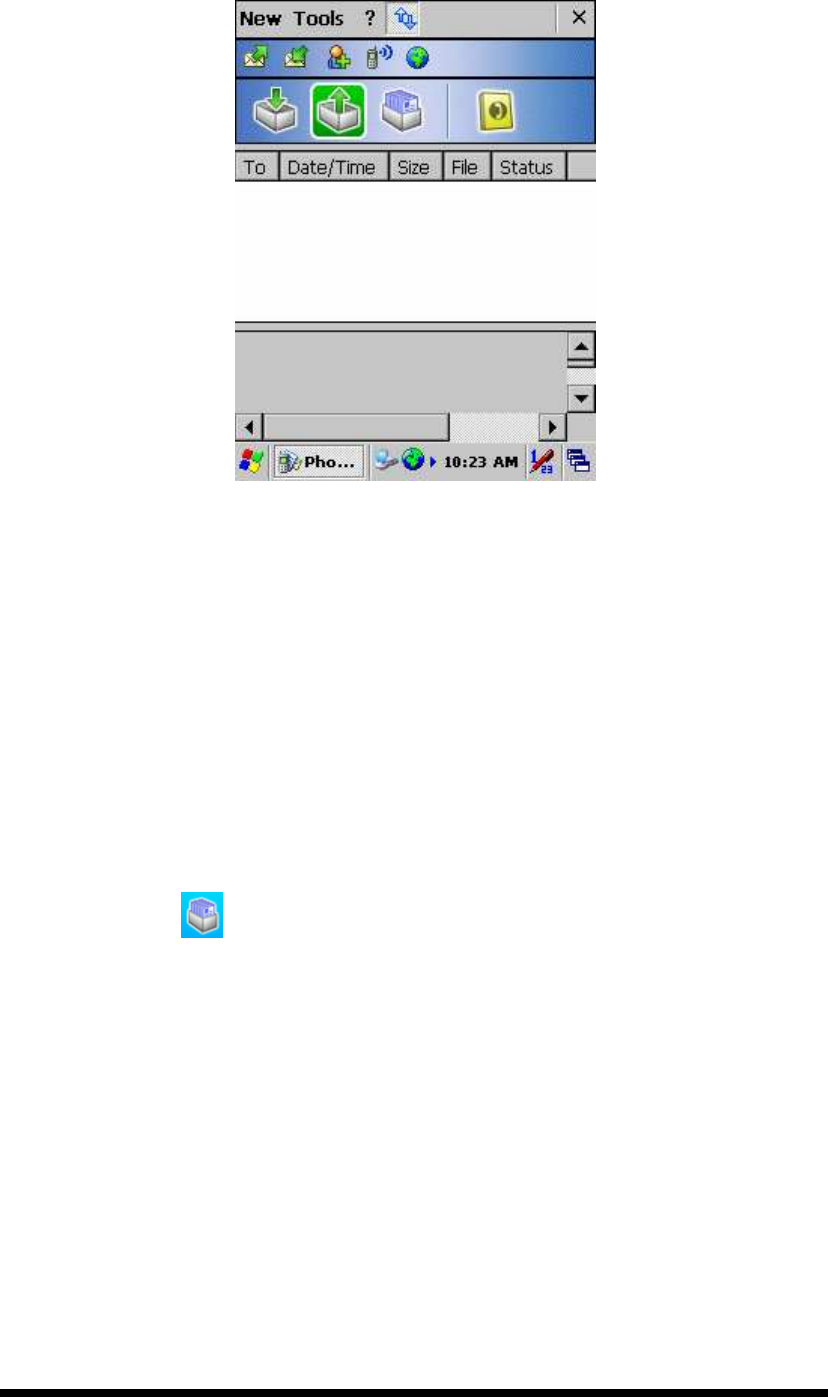
B-6
Depending on the type of message, in order to send, see properties, move, resend,
display, annotate or delete a message on the list:
1. Select the message and hold the selection with the stylus for a few seconds until
a context menu is displayed.
2. Select the desired option.
3. Depending on the option selected, follow the usual procedure or click Cancel or
the OK icon, located in the top right-hand corner of the screen, to return to the
main interface.
Sent box
Clicking the Sent icon will display the list of messages sent from the outbox.
The content of the selected message is displayed in the frame.
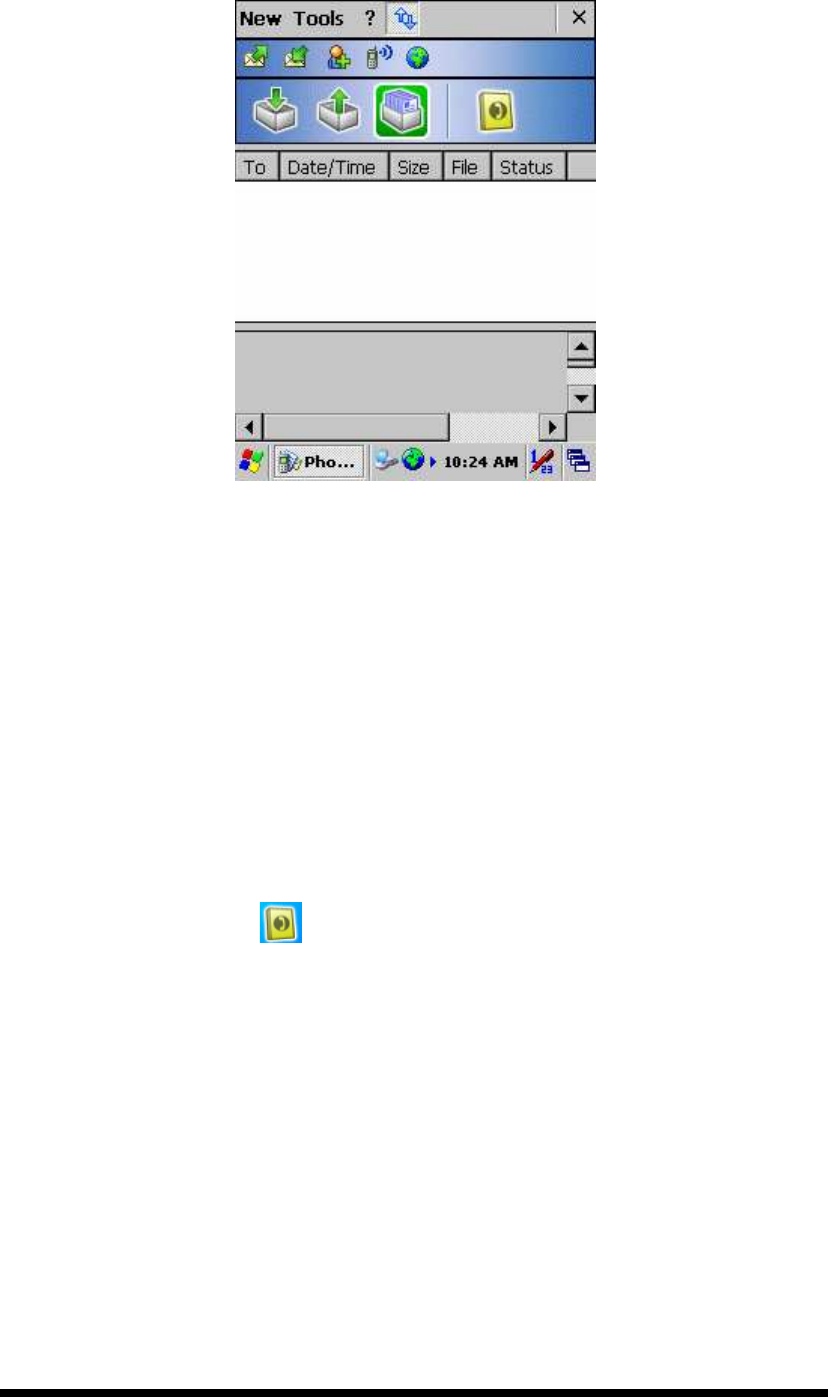
B-7
To send, see properties, transfer, and display, annotate or delete a message from the
list:
1. Select the message and hold the selection with the stylus for a few seconds until
a context menu is displayed.
2. Select the desired option.
3. Depending on the option selected, follow the usual procedure or click Cancel or
the OK icon, located in the top right-hand corner of the screen, to return to the
main interface.
Phonebooks Folder
Clicking the Phonebooks icon displays a drop-down list containing the
phonebooks you have created or imported. Select the one you wish to look up or edit
from the list.
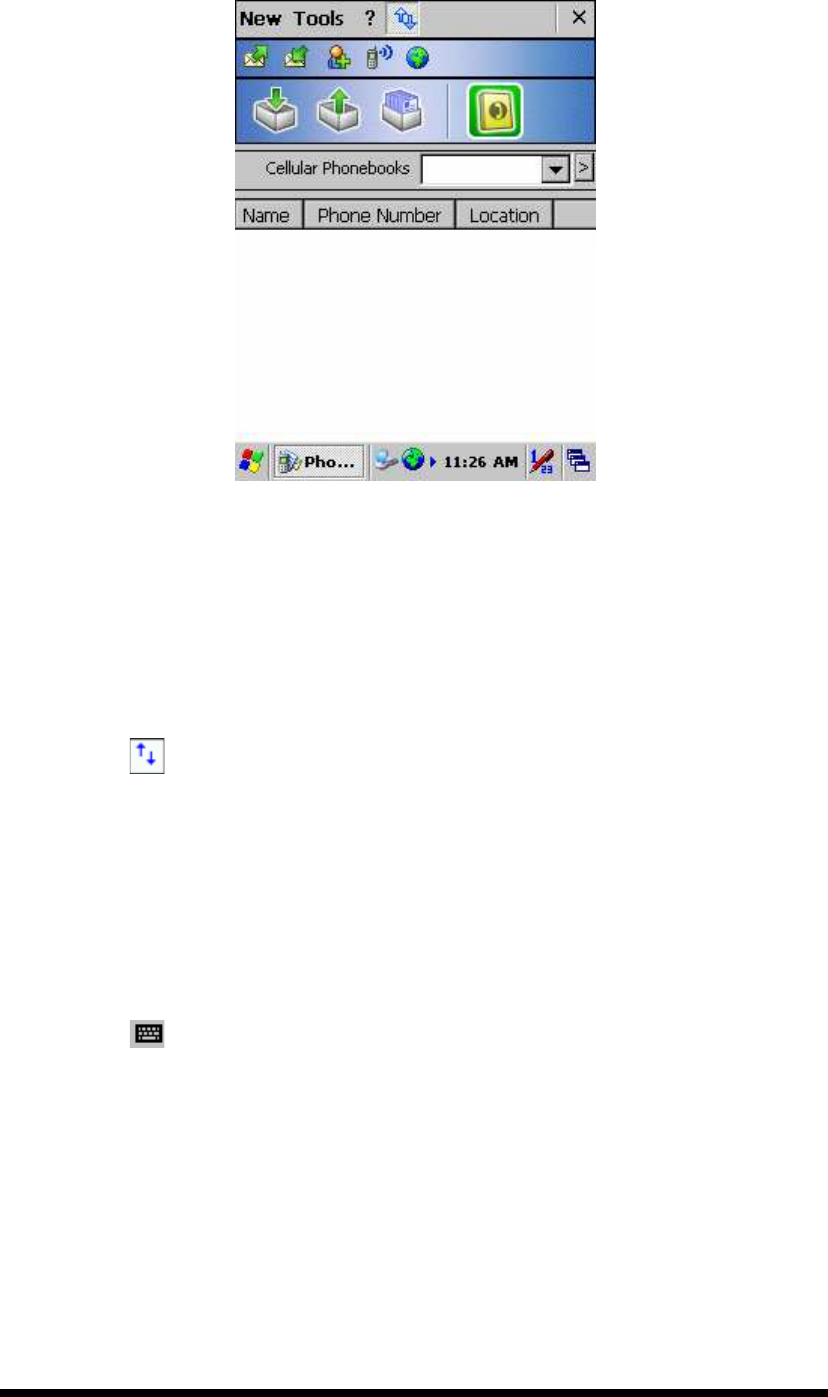
B-8
If the drop-down list is empty and you would like to import contacts from your mobile
phone, select the Tools > Retrieve phonebook menu.
B.2.2 Icons and menus
Display icons
Clicking the icon located at the bottom of the screen and which symbolizes two
arrows on a blank page, displays the fast access icons for available functions (which
are as follows, from left to right: send and receive SMS messages, add a new contact
in your Phonebook, Dialer, Internet connection).
Click this icon again to hide them.
Display numeric keypad
Clicking the icon located in the bottom right-hand corner of the screen and
which symbolizes a keypad displays the keypad. Click this icon again to hide the
keypad.
Drop-down menus
The New and Tools drop-down menus have several functions, depending on the
context and options available:

B-9
New menu
Click on the New menu at the bottom of the screen, then select:
- SMS: To create and send an SMS message.
- Phonebook: To create a phonebook.
- Phonebook Contact: To add a contact to your phonebook.
Tools menu
Click on the Tools menu at the bottom of the screen, then select:
- Retrieve SMS: The application collects the SMS messages and places them
in the Inbox.
- Retrieve phonebook: To download a phonebook: the one in your mobile
phone or the one in your SIM card, or both.
- Check cellular status....
- Settings...: To configure the application's communication settings. See
selecting communication settings.
- Dialer: To make a call directly from the application.
- Internet connection: To access the Internet.
- Logs: To access the different logs: Data counters, Data sessions log, SMS
counters, Calls missed, Calls received, Outgoing calls, Voice
counters.
- About...: To access information about the application.
- Close: To close the application.
B.3 Selecting communication settings
Before using the communication features, make sure that the communication port and
the equipment you are using are correctly declared.
General Setup Menu
Click the Tools > Settings to access the General Setup menu, which have different
functions available depending on the type of your equipment. Select:
- Communications device: to configure your equipment and type of connection
used.
- Network operator: to define your operator settings.
- Internet connection: to create, modify or delete internet connections.
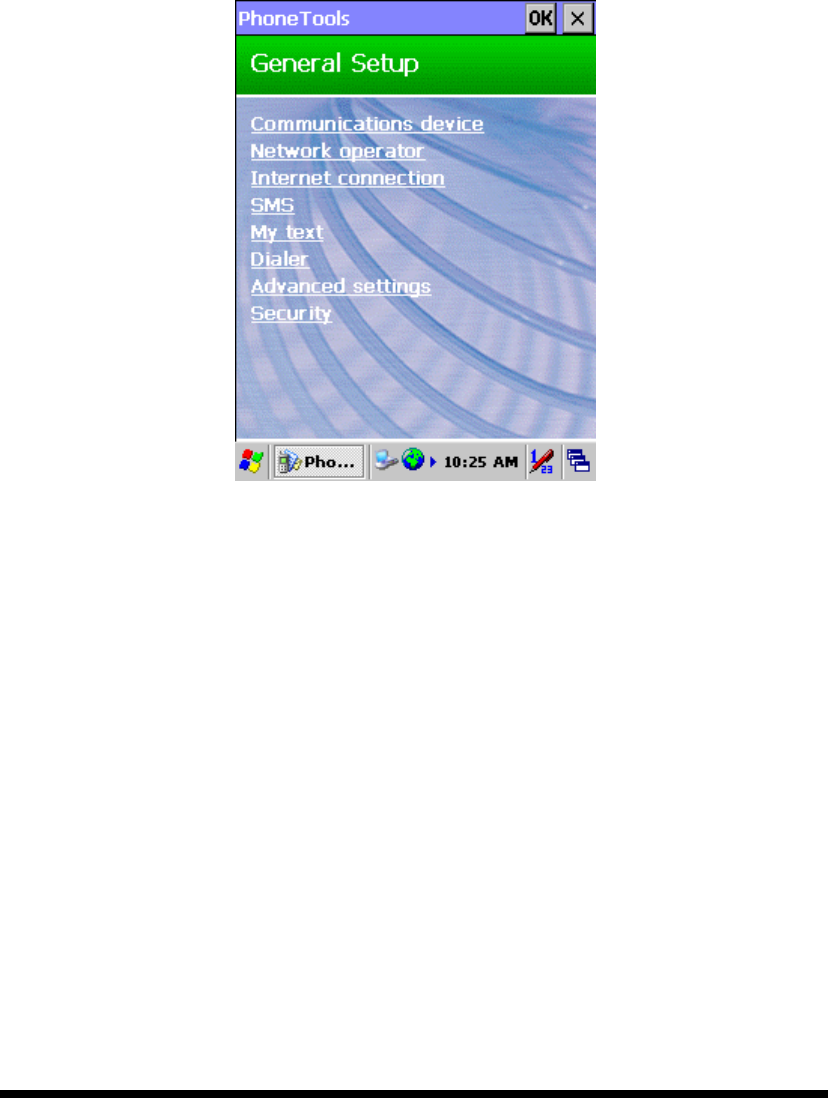
B-10
- SMS: to configure the SMS transmission and reception options.
- My text: to record words or sentences you frequently use so they can quickly
be added to a SMS message.
- Dialer: to define the dialer settings.
- Advanced settings: to configure Log events and the 'Close' option in the Tools
menu.
- Security: to modify the PIN code of your SIM card.
First launch
1. At the first launch, the communication settings configuration screen is displayed.
Click Yes and follow the different step to specify the communication settings.
2. Depending on the type of connection, your mobile phone and your operator will
automatically be detected. (If not, follow the instructions detailed in the next
section.)
Click the OK icon located at the top right-hand corner of the screen to save the
settings.
3. A confirmation pop-up is displayed. Click Yes to save the defined settings.
Communications device tab
1. Select Tools > Settings > Communications device.
2. Select the Manufacturer and the Model of your equipment (modem or
telephone).
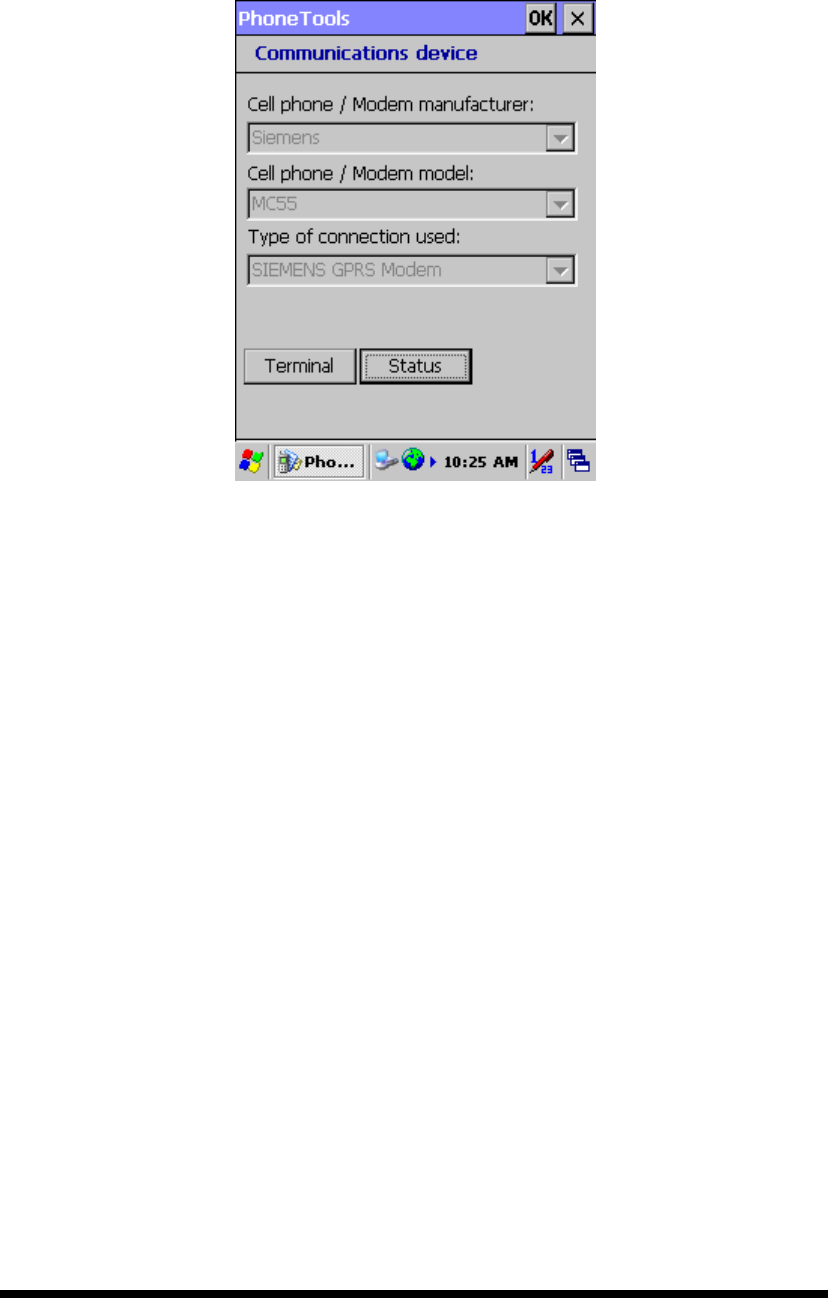
B-11
3. Select Connection type being used.
4. Click the OK icon located at the top right-hand corner of the screen to confirm.
The Terminal button enables you to dialog directly with the modem via AT
commands (like with Microsoft Hyper Terminal).
The Status button returns information on your equipment.
B.3.1 System Extensions
PhoneTools system extensions are specific extensions for the Contacts application
and the Today screen. Actions can be driven from the system and the PhoneTools
Inbox status is available from the Today screen of your PDT.
Today screen extension
From the Today screen of your PDT, click:
● The PhoneTools Inbox status to directly launch PhoneTools. The application
opens displaying the Inbox.
● The New > SMS menu to create a SMS.
Contacts menu extension
From your Contacts screen (Start > Contacts), select a contact from the list. You can
either hold the click until a context menu is displayed or click the Tools menu, and
then select:

B-12
● Call: to make a phone call to the selected contact.
● Copy to the SIM: to copy the properties of the selected contact into your SIM
phonebook.
● Send SMS: to send a SMS to the selected contact.
B.4 Dialer
The Dialer module simulates the operation of a mobile phone in your personal
assistant. It enables you to:
● make calls in various ways:
- by directly selecting an entry in the Contacts folder of your digital assistant.
- by selecting from a Fast calls list you will have pre-programmed.
- by entering a number directly using the keyboard.
- by redialing one of the last 10 numbers dialed.
- using the missed calls log if the caller has not withheld his/her number.
● receive calls showing, where possible, the last and first names of your caller and
playing a tune identifying the Contacts category to which your caller belongs.
● reject incoming calls.
● save outgoing, incoming as well as missed calls in call logs.
● send digits with the call to enable navigation across most voice servers.
● save the number of your message system for fast calls.
● check microphone and speaker volume for certain equipment.
● send and receive SMS messages.
● send and receive faxes.
● access the Internet using a single button.
● directly read signal strength and battery level of your mobile in cases involving
external equipment or of your assistant in cases involving an internal card.
● request dialer to be called automatically on starting up the application.
Warning!
Certain dialer functionalities can be disabled due to incompatibility with the
communications equipment.
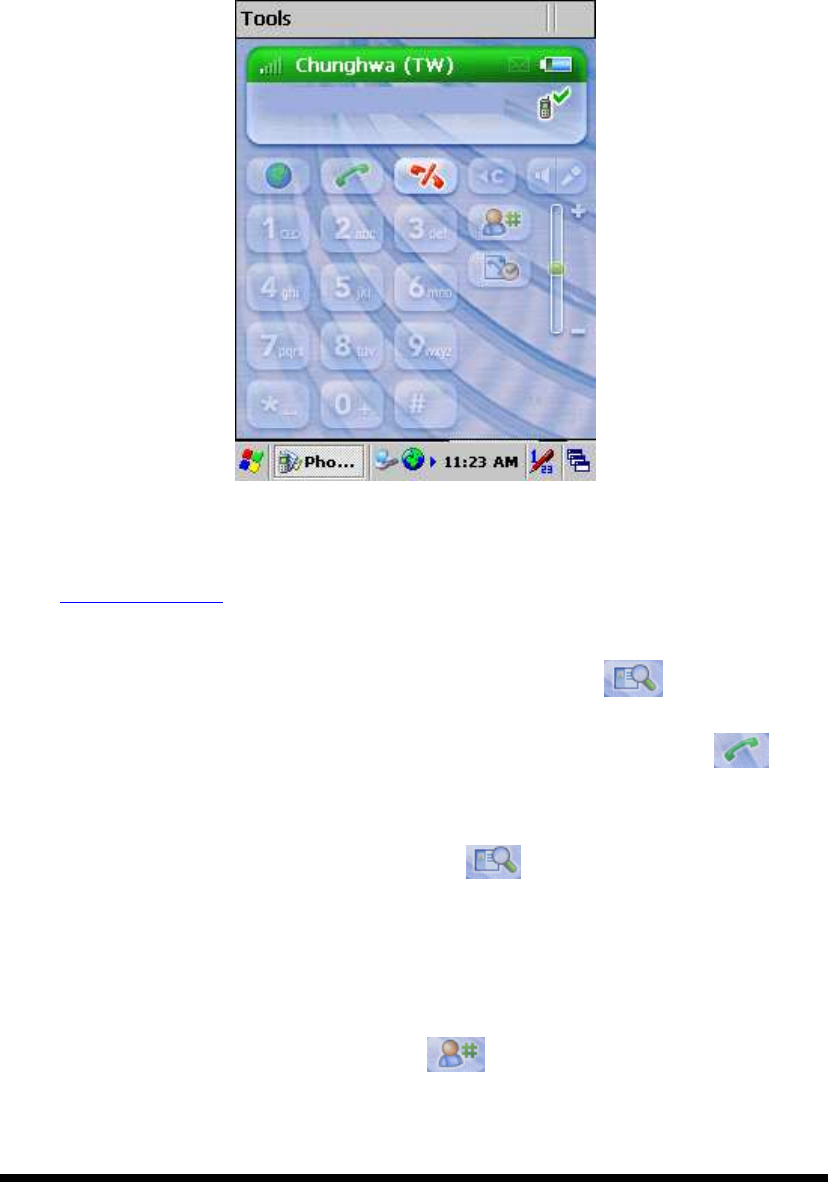
B-13
B.4.1 Accessing the dialer
● Starting from the main interface, select the Tools menu then the Dialer option.
The dialer initializes your communications equipment then displays signal
strength and battery level, as well as the name of your service provider. The
keyboard will be enabled once the initialization stage is complete.
B.4.2 Making a voice call
1. Access the dialer and use one of the following methods:
● Direct entry, dial the number using the keys on the numeric keypad. To
delete or correct the last digit displayed, click on the icon showing
an arrow pointing to the left and a C. To make the call, click the icon
showing a green receiver.
● From Phonebook, click the Contacts icon to retrieve the number
you are calling. If more than one number is assigned to the person being
called, a new window will open enabling you to select the number to be
called. Click OK next to make the call.
● Fast call, click the icon with the # symbol. The list of the fast call
contacts you pre-defined is displayed. Click the one you want to call.
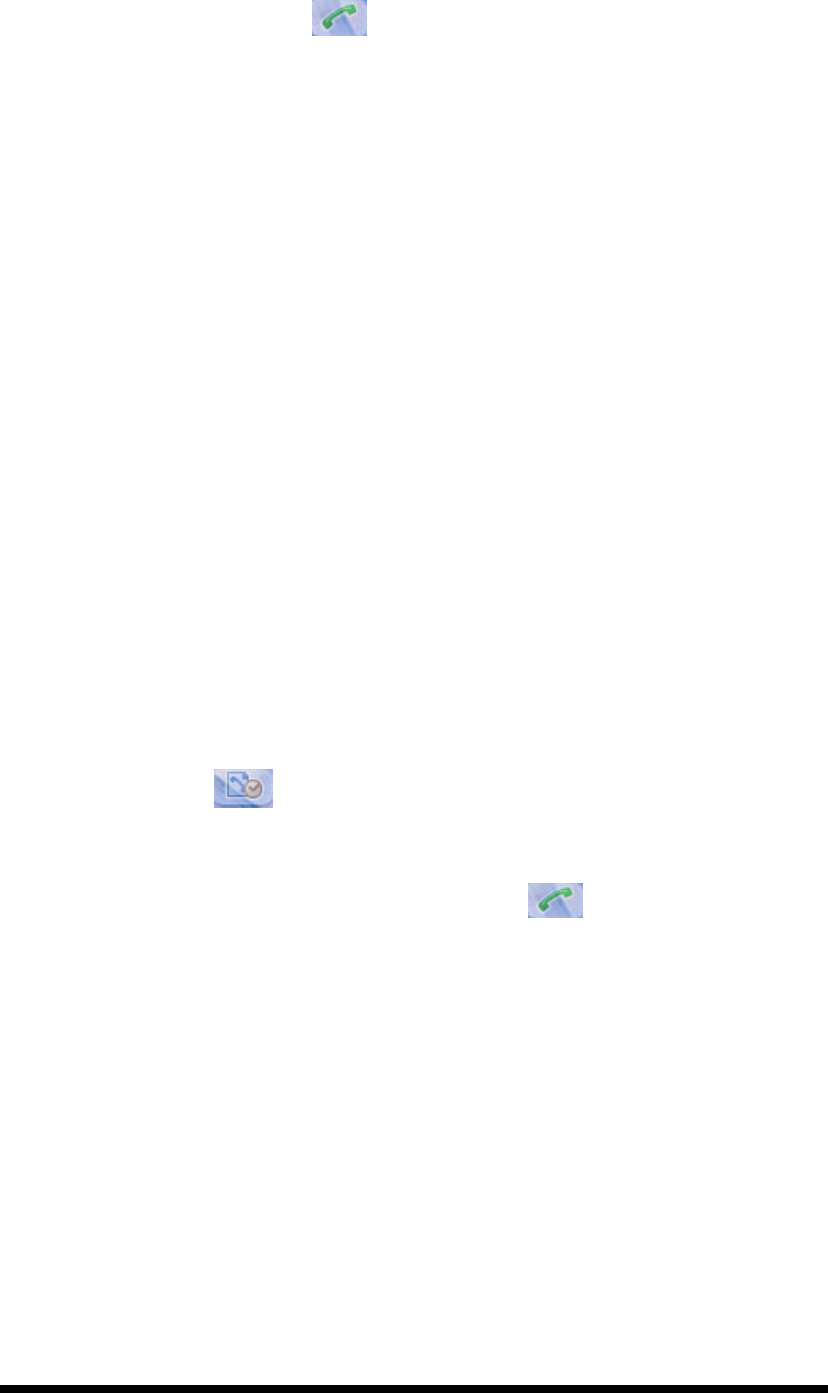
B-14
● Again, click the green button without entering any number. A listing
of the last numbers dialed appears. Select the number you wish to call, then
click the Call button.
2. The number and name of the person being called (if not withheld) is displayed
in the top frame during the call.
3. To end the call, click on the icon showing a red receiver. Call duration will then
be displayed and an entry in the Dialer log created.
Notes:
- It is just as easy to connect to your voicemail by pressing and holding the "1" key. If
you have not specified this number yet, the dialer will suggest configuring it.
- You can also make a voice call directly from the Contacts application of your PDT.
To do so, select the person you wish to call in the Contacts screen list, then click the
Tools > Call menu.
Missed calls
If one or more callers have attempted to contact you in your absence, the dialer will
inform you with an on-screen message. If your callers have not withheld their
numbers, you can see who called and you can call them back using the following
procedure:
1. Click the Logs button which will open a tabbed box, the first of which
is for missed calls.
2. Select the caller to be called then press the Call button.
Fast calls list
In the Dialer window, click the icon with the # symbol. The list of main contacts is
displayed.
Select a fast call contact you want to define, modify or call and hold the selection with
the stylus until a context menu is displayed. Then, click one of the following options:
● Edit to create or modify the properties of the fast call contact. Then, click OK.
● Delete to delete the fast call contact from the list.
● Extract from Contacts to retrieve the properties of the contact from your
Contacts
● Dial to call the selected contact.
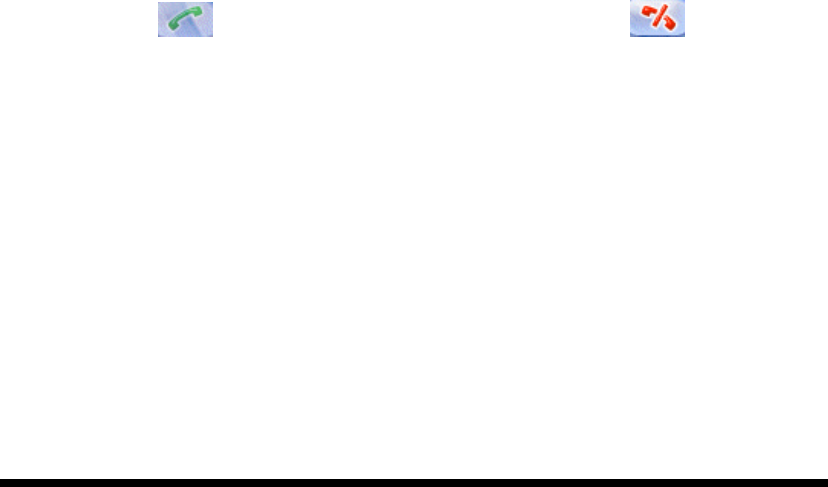
B-15
B.4.3 Receiving a call
Ringer
The dialer issues a ringing sound to alert you to a caller trying to reach you. The tune
played at this time can depend on how the caller is recorded in your Contacts folder.
You can in fact specify contacts in your folder (Work, Friends, Family, etc.) and list
your callers in one of them. Refer to the user manual for your digital assistant for
further information on this subject.
The application may be configured to play different tunes depending on the category
of the caller.
If this is the case, the application searches in the Contacts folder for an entry
associated with the number, it then determines its category and, having done so, plays
the tune you have configured for it.
Warning!
This will only work if the caller does not withhold his or her number.
Information
If the caller's number has not been withheld and if the caller is listed in Contacts, the
dialer will display his or her name. If he or she is not listed, only the number will be
displayed. If the caller's number has been withheld, the dialer will then display
Number Withheld.
Accepting / Rejecting a call
Click the green button to accept the call and click the red button to
reject it.
Receiving SMS messages
SMS messages are downloaded automatically as soon as your communications
equipment informs the application that messages have been received. If the message
received has high priority, its content is displayed automatically; otherwise you have
to operate the Envelope button to read it.
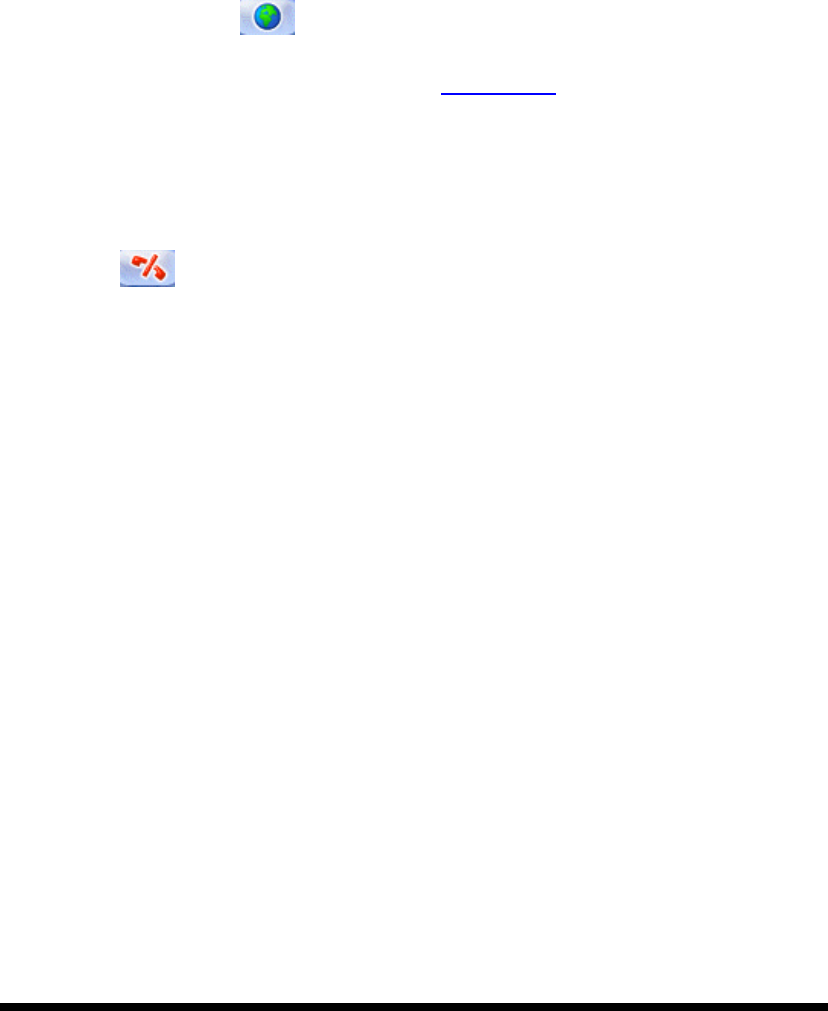
B-16
B.4.4 Logs
The application records dates, durations and caller identifiers as the dialer is used,
dividing them into three categories: missed calls, received calls and outgoing calls.
You can look up details of these lists by pressing the Logs button. This will take you
to a tabbed box listing the calls logged by category and, under the Voice counters tab,
the various cumulative totals recorded, with a facility for resetting the counters.
B.5 Internet connection
The Internet connection button enables connections to be made to Internet and
to start up applications associated with it (see connections).
Warning!
On most equipment, the fact of connecting to the Internet prevents the dialer from
being used.
Use the red button to disconnect the Internet access session.
B.5.1 Configuration
Accessing configuration
● Before configuring the application's dialer function, select the communications
equipment and the mobile telephony service provider using the Settings
command on the Tools menu. Next, access dialer configuration by clicking the
Dialer command in the General Setup window.
Configuring the answering machine
● You can add the number of your answering machine in the Operator settings
selection dialogue box (Tools > Settings menu). It will be dialed automatically
if you leave the stylus resting on the "1" key of the dialer.
Configuring a ringer
1. Starting from the main interface, select the Tools > Settings menu.
2. Click on the Dialer link. You can specify the various tunes to be played
according to the categories to which the callers belong in the window displayed.

B-17
3. Select the type of call to which a ringer is to be assigned in the first drop-down
menu in the Events field: Incoming call, or Receive an SMS.
4. If you have selected Incoming call, a second drop-down list will be displayed
listing the various categories specified in Contacts. Select the category to
which you would like to associate a tune.
5. Select the ringer in the Associated sound drop-down menu.
6. Use the Play and Stop buttons to test the selected ringer. Once you are satisfied
with a ringer, click OK to confirm.
7. Repeat these steps for each type of call to which you would like to assign a
ringer.
Calling the dialer automatically on application start-up.
1. Starting from the main interface, select the Tools > Settings menu.
2. Click the Dialer link.
3. Check the On when loaded box in the window that shows up.
B.6 SMS
What is the 'Short Message Service' (SMS)?
The Short Message Service enables you to send messages in text format (160
characters maximum) over a mobile phone network. This service requires a specific
subscription.
Short messages are first sent to the SMS Center, which is part of the mobile phone
network, which then forward them to the recipients.
Received messages are stored in the memory. You cannot receive any more new
messages once this memory is full. For this reason, ensure you delete them regularly
or configure the application so it transfers them to your assistant.
Configuring
Configuring the service center
1. Starting from the main interface, select Tools > Settings and click the Network
Operator link.
2. Select your country and mobile telephony operator. The number of the default
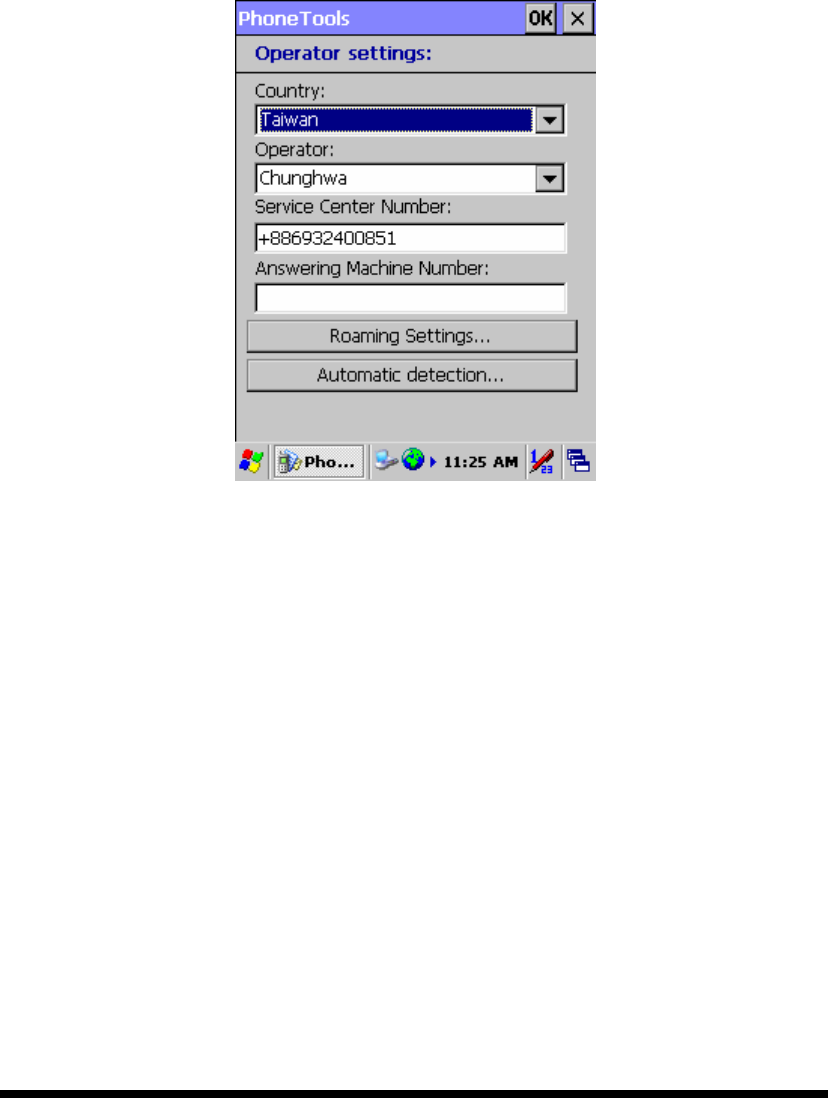
B-18
Service Center is displayed. If it is not the number sent by your network
operator, you can change it manually.
3. You can also use the Automatic detection button for the application to
interrogate your equipment and configure these settings.
4. Enter the number for the answering machine suggested by your network
operator. It will be used by the dialer.
5. Click OK to confirm.
Configuring SMS messages
1. Starting from the main interface, select Tools > Settings and click the SMS link.
Sending:
Validity period: if your message cannot be delivered immediately, the service
center can record it and resend it later. This list specifies for how long your
message will be repeated.
Message type: to be used in very specific cases, this option configures the
message format in line with the service center and the recipient.
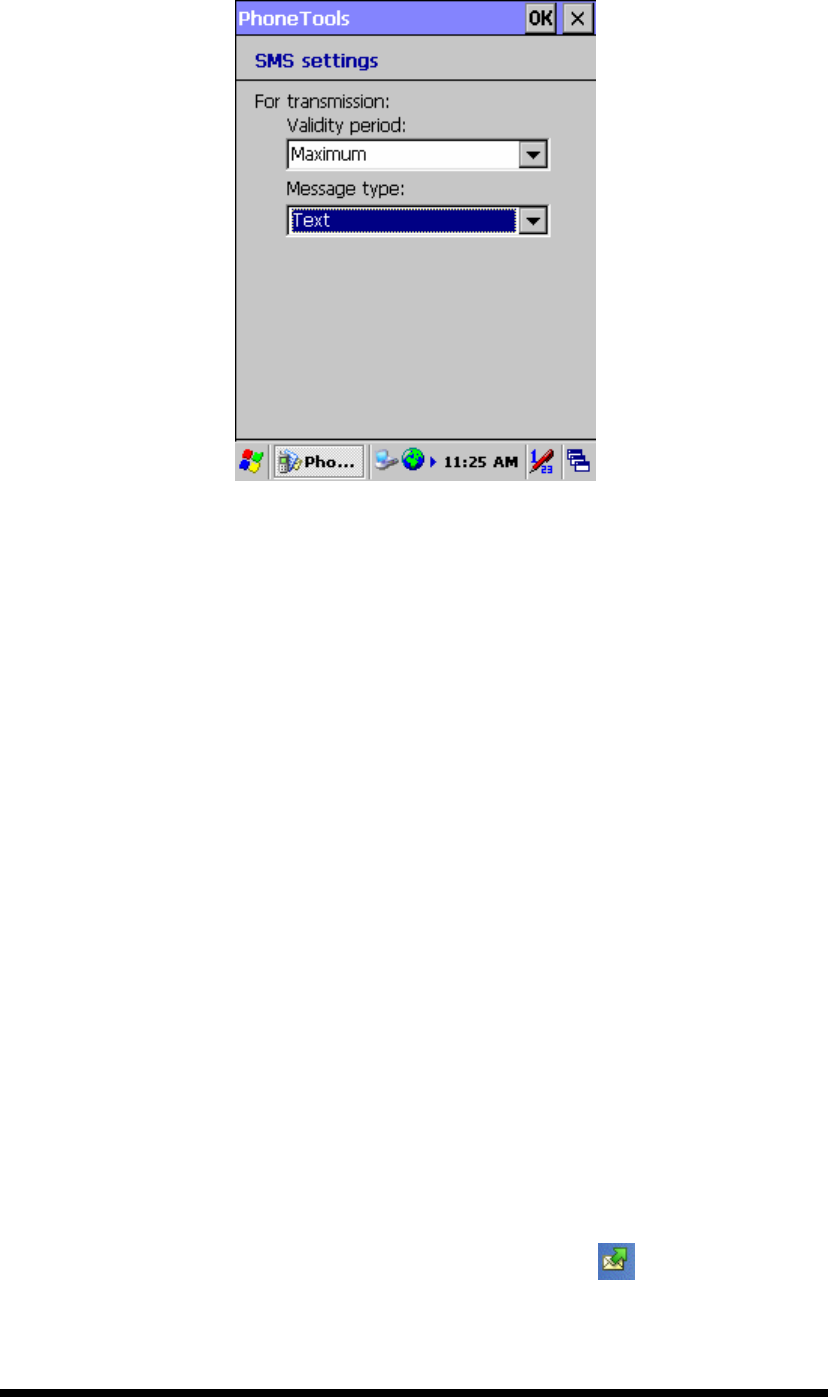
B-19
Receiving:
Transferring SMS messages received: they may be either copied or moved from
the communications equipment to the digital assistant. If you opt for the "copy"
mode (option unchecked), messages received will accumulate in the
communications equipment until it fills up and you risk losing messages to come.
In this case you can always delete them from the application's inbox.
2. Click OK to confirm.
Configuring templates
If you frequently use the same words or sentences in your messages, you can record
them in a list so they can be quickly added to your message. To do this:
1. Starting from the main interface, select Tools > Settings and click the My text
link.
2. Select an entry to be edited from the upper list and click the Edit button (arrow
pointing downwards) for the entry to be copied to the editing area.
3. Once your sequence has been entered, click the Change button (arrow pointing
upwards) to record it.
Sending an SMS message
1. Starting from the main interface, select New > SMS
or click
.
2. Enter the recipients' numbers using one of the following methods:
● Direct entry: if you have a single recipient, enter the number directly then click

B-20
the Next button. If you have more than one recipient, enter their numbers then
press the Add button (arrow pointing downwards) to add them to the list.
● From Phonebook: if your message recipients are recorded in the Contacts folder
of your assistant, click the Contacts button and select your recipients and their
numbers. Click OK next to add them to the Recipient list.
3. Enter the text of the message in the frame displayed. A character and SMS counter
displays the relevant sizes as entry proceeds. A typical message contains up to 160
characters but the application can send content longer than this by linking more
than one message together. You can insert pre-recorded passages of text in your
message using the My text menu.
4. The default setting is for transmission requests not to be carried out immediately.
This enables you to prepare your message off-line and to send it later on (to do this,
select it in the Outbox, and select Tools > Send). Check the desired options:
● Send now: to send your message immediately.
● High priority: to display the content of your message directly on the recipient's
mobile phone screen.
● Request return receipt: to receive a return receipt.
● UCS2 format: to ensure compatibility with non-European language PDTs.
5. Click OK.
Note:
You can also send SMS from outside the application, such as follow:
● From the Contacts folder of your PDT assistant, select the contact to whom you
want to send the SMS. You can either hold the click until a context menu is
displayed and select the Send SMS option, or click the Tools > Send SMS menu.
● From the Today screen of your PDT assistant, click the New > SMS menu.
Downloading received SMS messages
Select Tools > Retrieve SMS. If you have received SMS messages on your mobile
phone, they will be automatically copied or transferred to the Inbox. Unread
messages appear in bold. A single click on a message is enough to read it.
Viewing an SMS message
1. Select the SMS message you wish to view.
2. Select the Tools > View menu or hold the click until a context menu is displayed
and select the View option on it. The content of the SMS message, as well as the

B-21
sender, date and time of sending are displayed. If the inbox contains a number of
messages, it is possible to go directly from one to the next from the same dialog
box.
3. Click OK to return to the main screen.
Note:
Unread messages appear in bold. Click a message to read it.
Replying to an SMS message
1. In the Inbox, select the message you want to answer.
2. Hold the selection until a context menu is displayed in which to select the Reply
option, otherwise select Tools > Reply. The SMS transmission screen is displayed.
The Phone Number and, if applicable, Name and Company fields are already
filled in.
3. Click Next.
4. Enter the message text.
5. The default setting is for transmission requests not to be carried out immediately.
This enables you to prepare your message off-line and to send it later on (to do this,
select it in the Outbox, and select Tools > Send). Check the desired options
referring to the following heading: SMS Transmission options
6. Click OK.
Resending an SMS message
1. In the Sent folder, select the SMS message you want to send again.
2. Select Tools > Resend and refer to the steps listed under the Sending an SMS
message heading.
SMS transmission options on composing them.
- Send now: check this box for the transmission request to be executed as soon as you
click Send. Otherwise, the transmission request will be left pending in the Outbox
of the main interface. To send your message, you need to select it, then select Tools
> Send.
- High priority: check this box to display the content of your message directly on the
recipient's mobile phone screen.
- Request return receipt: to receive a return receipt.
- UCS2 format: check this box to ensure compatibility with non-European language
PDTs.
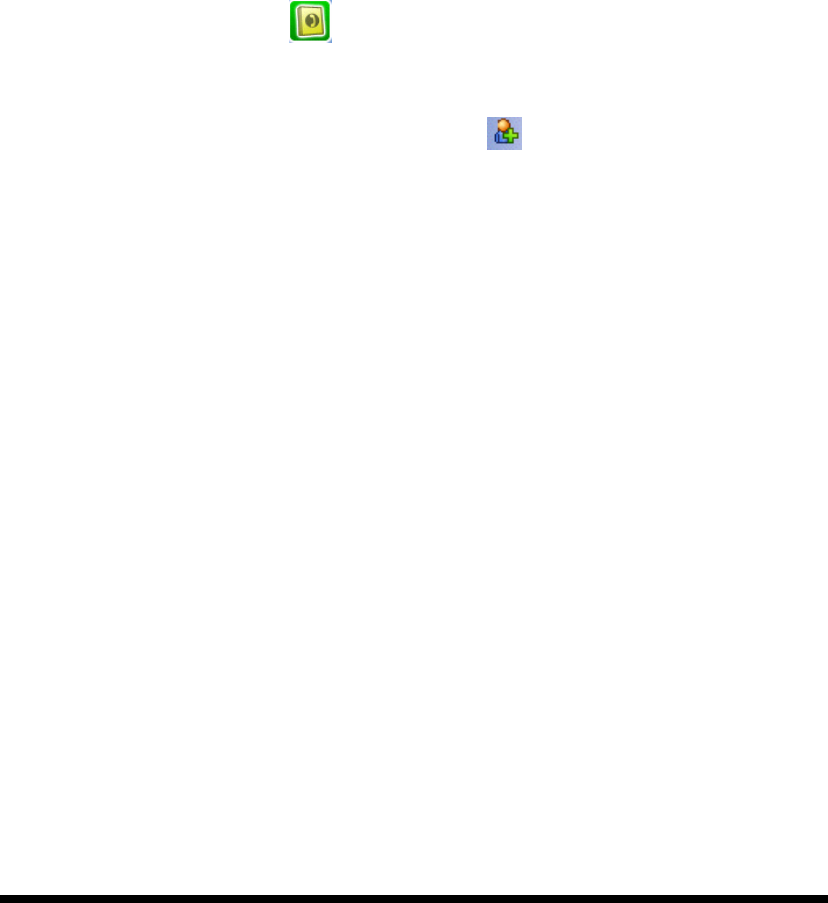
B-22
B.6 Phonebook management
PhoneTools enables you to create phonebooks, import contacts recorded in your
mobile phone (memory + SIM card) and thus bring your various phonebooks into
line.
Creating a phonebook
1. Select New>Phonebook.
2. Enter the phonebook name.
3. Click OK.
Adding a contact
1. Click the Phonebooks icon then select from the drop-down list the
phonebook to which you wish to add a contact.
2. Select New > Phonebook Contact or click . The Cell phonebook entry
window is displayed.
3. Enter the contact's Name and Number. The entry will have an automatic Entry
position in the phone book if you do not specify this field.
4. Click the Contacts icon to import contacts you created in the PDT Contacts
application into the current PhoneTools phonebook. The PDT Contacts list is
displayed. Select the contact you want to import. Then click OK. The properties
of this contact are automatically filled.
5. Click OK.
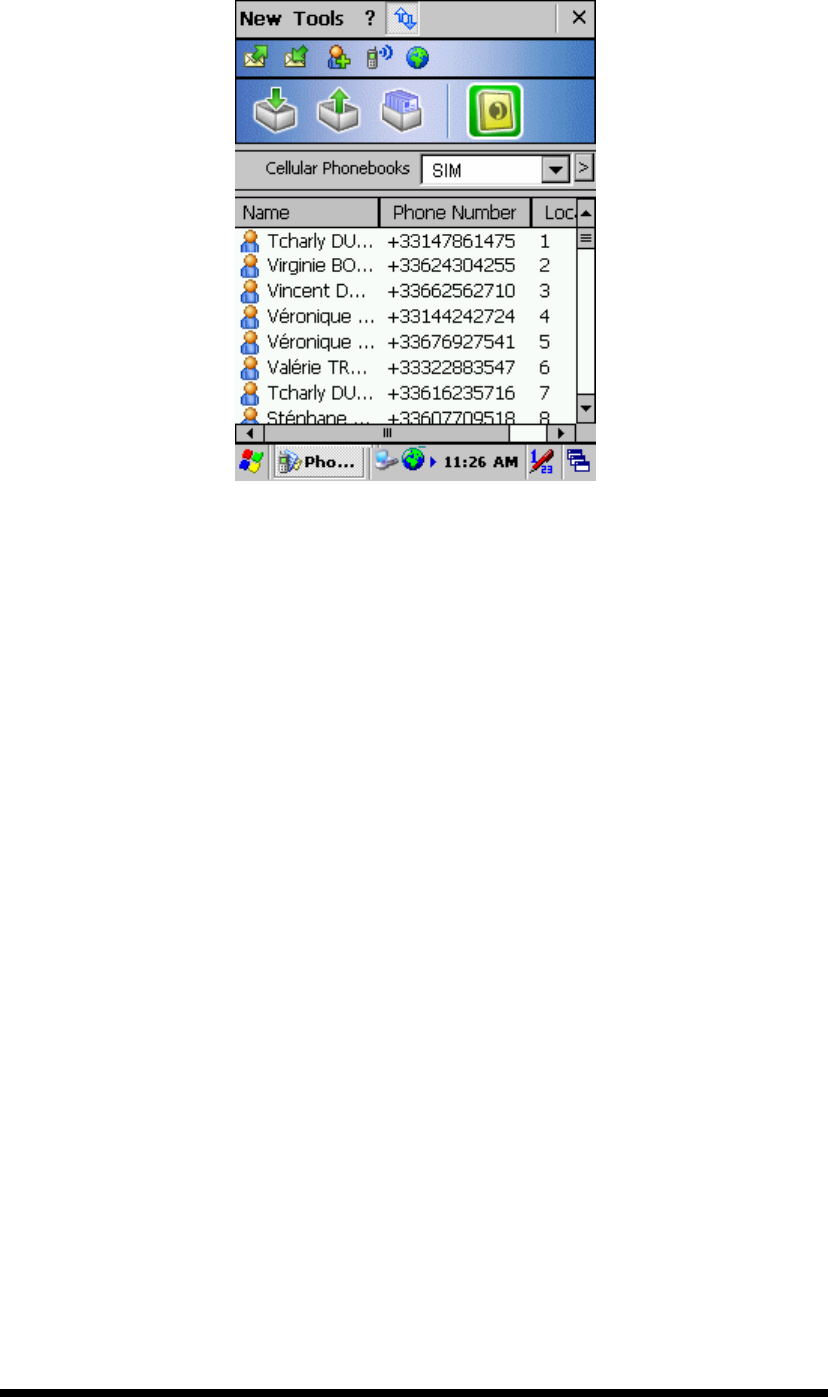
B-23
Managing the phonebooks
1. Click the Phonebooks icon then select the Phonebook management button (>
sign) next to the phonebook drop-down list. The Phonebook management
window opens displaying the list of all your phonebooks.
2. Click one of the following buttons, depending on what you wish to do :
● Create : to create a phonebook.
● Delete : to delete the selected phonebook. The confirmation pop-up is
displayed. Click Yes.
● Rename : to rename the selected phonebook. Enter the changes in the Enter
Phonebook name field. Then click OK.
3. Click OK to get back to the Phonebook window.
Changing a contact
1. Click the Phonebooks icon then select the phonebook to be changed from the
drop-down list displayed.
2. Select the contact you wish to change.
3. Select Tools > Modify.
4. Enter your changes in the Name, Phone Number and Entry position fields.
5. Click OK.
Downloading your mobile phonebook
1. Select the Phonebooks folder by clicking on the Phonebooks icon.

B-24
2. Select Tools>Retrieve phonebook.
3. When prompted by the program, select the memory where the phonebook you want
to download is stored.
4. Click OK. Your phonebook is downloaded.
Transferring a phonebook to your mobile phone
1. In the Phonebooks folder (click the Phonebooks icon), select the phonebook to be
transferred.
2. Select Tools>Transfer to cellular.
3. When prompted by the application, select the memory to which the phonebook is to
be transferred.
4. Click OK. Your phonebook is transferred.
B.7 Internet connections
Configuring Network operator
The application assists the user when configuring internet access. Since this
configuration relates to the network operator, you must set it before anything else.
Configuring the network operator
1. Starting from the main interface, select Tools > Settings and click the Network
operator link.
2. Select your country and mobile telephony operator.
The Automatic detection button suggests searching your network operator
automatically and configuring the application.
The Roaming Settings button allows you to detect and select a wireless operator
when you are abroad and outside the reach of your Home Network.
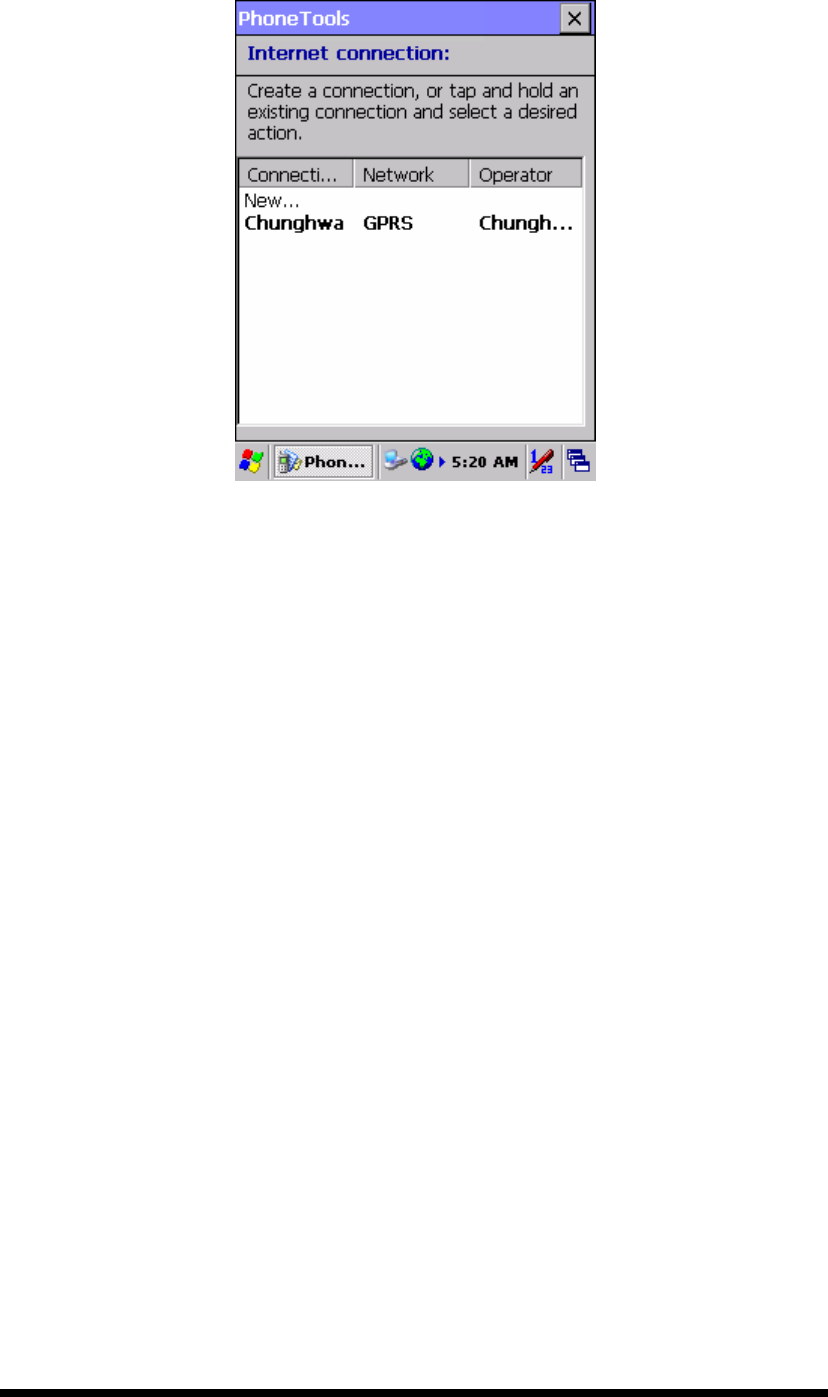
B-25
Creating and changing access configurations
Accessing the connections list
1. Starting from the main interface, select Tools > Settings.
2. Click the Internet connection link. The dialog box displays a list of network
access configurations handled by the application. From this list you will be able
to create, change and delete your configurations.
Creating an access configuration
1. Access the connections list.
2. Select the New option from the list. The first box appears, enabling the name to
be assigned to your configuration to be entered.
3. Click the Next button. The application will then list software that can be run
while this connection is live. This choice is optional.
4. Click the Next button. If your network operator handles different types of
network (UMTS, GPRS, GSM, etc.), the application will prompt you to select
the one to be used.
Warning!
Using "high speed" networks such as GPRS or UMTS is subject to subscription
options.
5. Select a Context ID. Certain telephone devices offer connection profiles

B-26
containig all parameters for use over "high speed" networks, such as GPRS. In
order to avoid overwriting a pre-programmed configuration on your mobile,
select a free storage profile using its context ID.
6. If your network operator is recognized by the application, the Use standard
settings box is checked by default. Uncheck it if you want to specify the settings
manually and click Next :
- Specify the APN or number, Name and Password settings as required. Click
Next and repeat for subsequent screens for IP address, DNS and QOS.
7. Click Next. The following dialog box enables a backup configuration to be
created for your high-speed connection to be applied if it is unsuccessful. If you
request a backup configuration to be created, the application will display the
entry screens shown previously for "standard" connection.
Changing an access configuration
1. Access the connections list.
2. Click the connection to be changed or display the context menu by holding the
stylus on the connection to be changed and select the Modify option.
3. Follow the Creating access configurations steps.
Deleting
1. Access the connections list.
2. Display the context menu by holding the stylus on the connection to be changed
and select the Delete option.
Connecting
You can set up or access the connection from the main interface, from the Tools >
Internet connection menu or by clicking on .
● You will be shown a list if more than one access is configured.
● If no access has been configured, the application will prompt you to access the
Setup program to create one.